TRENDNET TEW676APBO HIGH POWER WIRELESS OUTDOOR ACCESS POINT User Manual
TRENDNET, Inc. HIGH POWER WIRELESS OUTDOOR ACCESS POINT
TRENDNET >
Contents
- 1. Users Manual 1
- 2. Users Manual 2
Users Manual 1
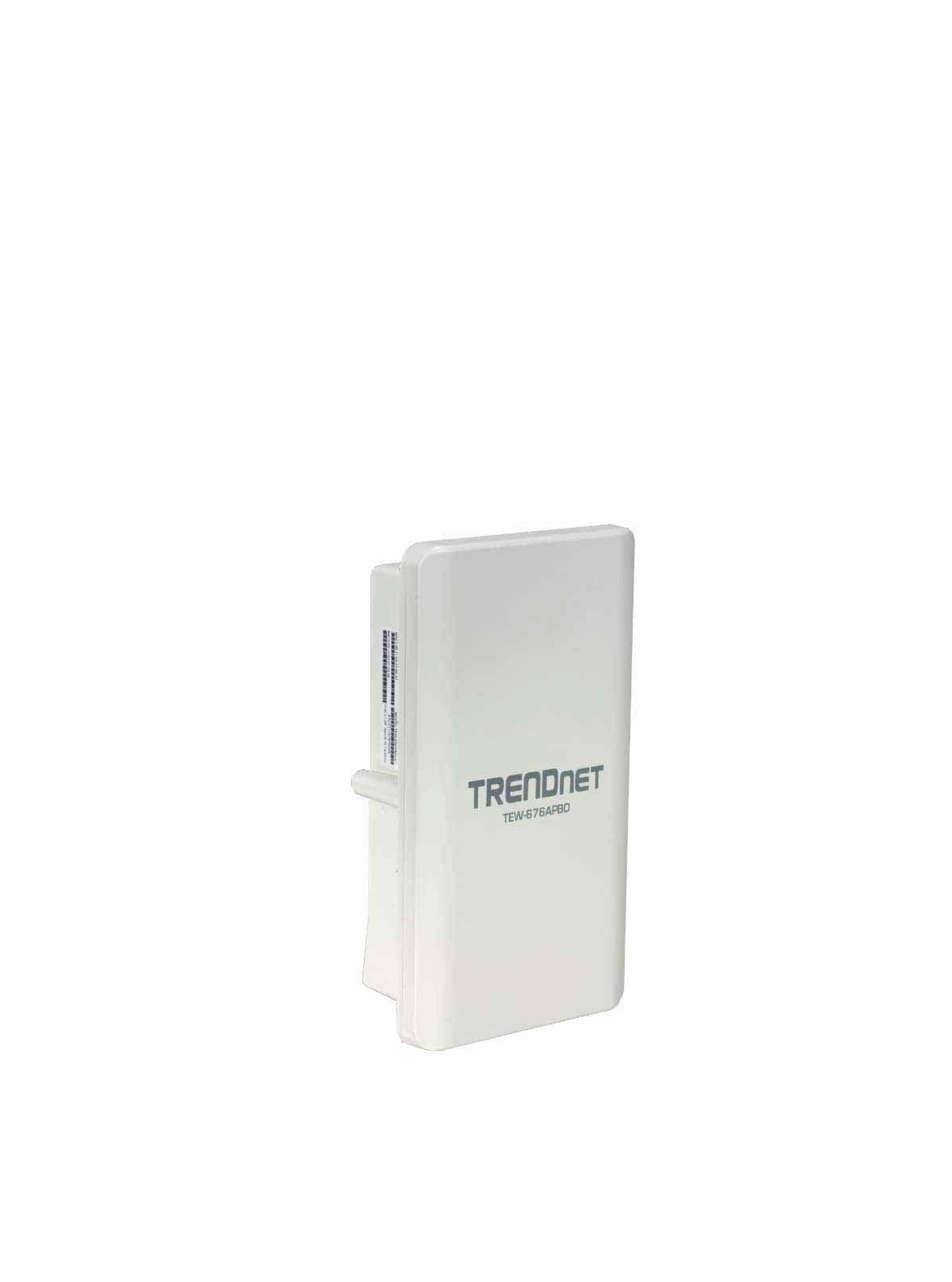
TEW-676APBO
14dBi High Power Wireless Outdoor PoE Access Point
High Power Wireless Outdoor Access Point

Table of Contents
INTRODUCTION ................................................................................................................................................................................ 1
FEATURES ................................................................................................................................................................................................ 1
PACKAGE CONTENTS .................................................................................................................................................................................. 2
PANEL FUNCTION DESCRIPTIONS .................................................................................................................................................................. 2
SYSTEM CONCEPT ...................................................................................................................................................................................... 3
APPLICATIONS........................................................................................................................................................................................... 4
PRODUCT BENEFIT ..................................................................................................................................................................................... 8
INSTALLATION CONSIDERATIONS ................................................................................................................................................................... 8
WEB MANAGEMENT INTERFACE INSTRUCTIONS .............................................................................................................................................. 9
AP MODE CONFIGURATION ............................................................................................................................................................ 10
EXTERNAL NETWORK CONNECTION............................................................................................................................................................. 10
NETWORK REQUIREMENT ......................................................................................................................................................................... 10
Configure LAN IP ............................................................................................................................................................................ 11
WIRELESS LAN NETWORK ........................................................................................................................................................................ 13
Wireless General Setup .................................................................................................................................................................. 13
Wireless Advanced Setup ............................................................................................................................................................... 15
Create Virtual AP (VAP) ................................................................................................................................................................. 21
Wireless MAC Filter Setup ............................................................................................................................................................. 26
Wireless Network Expansion ......................................................................................................................................................... 26
SYSTEM MANAGEMENT ............................................................................................................................................................................ 28
Configure Management ................................................................................................................................................................ 28
Configure System Time .................................................................................................................................................................. 31
Configure SNMP Setup .................................................................................................................................................................. 32
Backup / Restore and Reset to Factory .......................................................................................................................................... 34
Firmware Upgrade ......................................................................................................................................................................... 35
Network Utility .............................................................................................................................................................................. 36
Reboot ........................................................................................................................................................................................... 37
SYSTEM STATU S....................................................................................................................................................................................... 38
System Overview ............................................................................................................................................................................ 38
Associated Clients Status ............................................................................................................................................................... 40
Show WDS Link Status ................................................................................................................................................................... 41
Extra Information .......................................................................................................................................................................... 42
Event Log ....................................................................................................................................................................................... 44
WDS MODE CONFIGURATION ......................................................................................................................................................... 44
EXTERNAL NETWORK CONNECTION............................................................................................................................................................. 45
Network Requirement ................................................................................................................................................................... 45
Configure LAN IP ............................................................................................................................................................................ 46
WIRELESS NETWORK EXPANSION ............................................................................................................................................................... 47
General Setup ................................................................................................................................................................................ 47
Wireless Advanced Setup ............................................................................................................................................................... 49
WDS Setup ..................................................................................................................................................................................... 55
SYSTEM MANAGEMENT ............................................................................................................................................................................ 56
Configure Management ................................................................................................................................................................ 56
Configure System Time .................................................................................................................................................................. 59
Configure SNMP Setup .................................................................................................................................................................. 60
Backup / Restore and Reset to Factory .......................................................................................................................................... 62
Firmware Upgrade ......................................................................................................................................................................... 63
Network Utility .............................................................................................................................................................................. 64
Reboot ........................................................................................................................................................................................... 65
SYSTEM STATU S....................................................................................................................................................................................... 66
System Overview ............................................................................................................................................................................ 66
WDS List ......................................................................................................................................................................................... 68
Extra Information .......................................................................................................................................................................... 69
Event Log ....................................................................................................................................................................................... 71
CPE MODE CONFIGURATION .......................................................................................................................................................... 71

EXTERNAL NETWORK CONNECTION............................................................................................................................................................. 72
Network Requirement ................................................................................................................................................................... 72
Configure WAN Setup .................................................................................................................................................................... 73
Configure DDNS Setup ................................................................................................................................................................... 76
Configure LAN Setup ...................................................................................................................................................................... 77
ACCESS POINT ASSOCIATION ...................................................................................................................................................................... 78
Configure Wireless General Setting ............................................................................................................................................... 78
Configure Wireless Advanced Setting ............................................................................................................................................ 80
Site Survey ..................................................................................................................................................................................... 81
Create Wireless Profile .................................................................................................................................................................. 82
SYSTEM MANAGEMENT ............................................................................................................................................................................ 84
Configure Management ................................................................................................................................................................ 84
Configure System Time .................................................................................................................................................................. 87
Configure UPnP .............................................................................................................................................................................. 88
Configure SNMP Setup .................................................................................................................................................................. 89
Backup / Restore and Reset to Factory .......................................................................................................................................... 91
Firmware Upgrade ......................................................................................................................................................................... 92
Network Utility .............................................................................................................................................................................. 93
Reboot ........................................................................................................................................................................................... 94
ACCESS CONTROL LIST .............................................................................................................................................................................. 95
IP Filter Setup ................................................................................................................................................................................ 95
MAC Filter Setup ............................................................................................................................................................................ 97
Parental Control Setup ................................................................................................................................................................... 98
QoS Setup .................................................................................................................................................................................... 100
RESOURCE SHARING .............................................................................................................................................................................. 103
DMZ ............................................................................................................................................................................................. 103
Virtual Server (Port Forwarding) ................................................................................................................................................. 104
SYSTEM STATU S..................................................................................................................................................................................... 106
Overview ...................................................................................................................................................................................... 106
Station Statistics .......................................................................................................................................................................... 109
Extra Info ..................................................................................................................................................................................... 111
QoS Plot ....................................................................................................................................................................................... 113
Event Log ..................................................................................................................................................................................... 114
CPE + AP MODE CONFIGURATION ................................................................................................................................................ 114
EXTERNAL NETWORK CONNECTION........................................................................................................................................................... 115
Network Requirement ................................................................................................................................................................. 115
Configure WAN Setup .................................................................................................................................................................. 116
Configure DDNS Setup ................................................................................................................................................................. 119
Configure LAN Setup .................................................................................................................................................................... 120
ACCESS POINT ASSOCIATION .................................................................................................................................................................... 121
Configure Wireless General Setting ............................................................................................................................................. 121
Wireless Advanced Setup ............................................................................................................................................................. 123
Site Survey ................................................................................................................................................................................... 129
Create Wireless Profile ................................................................................................................................................................ 130
WIRELESS LAN NETWORK CREATION ........................................................................................................................................................ 132
Repeater AP Setup ....................................................................................................................................................................... 132
Wireless MAC Filter Setup ........................................................................................................................................................... 136
SYSTEM MANAGEMENT .......................................................................................................................................................................... 137
Configure Management .............................................................................................................................................................. 137
Configure System Time ................................................................................................................................................................ 140
Configure UPnP ............................................................................................................................................................................ 141
Configure SNMP Setup ................................................................................................................................................................ 142
Backup / Restore and Reset to Factory ........................................................................................................................................ 144
Firmware Upgrade ....................................................................................................................................................................... 145
Network Utility ............................................................................................................................................................................ 146
Reboot ......................................................................................................................................................................................... 147
ACCESS CONTROL LIST ............................................................................................................................................................................ 148
IP Filter Setup .............................................................................................................................................................................. 148
MAC Filter Setup .......................................................................................................................................................................... 150
Parental Control Setup ................................................................................................................................................................. 151
QoS Setup .................................................................................................................................................................................... 153
RESOURCE SHARING .............................................................................................................................................................................. 156
DMZ ............................................................................................................................................................................................. 156

Virtual Server (Port Forwarding) ................................................................................................................................................. 157
SYSTEM STATU S..................................................................................................................................................................................... 159
Overview ...................................................................................................................................................................................... 159
Associated Clients Status ............................................................................................................................................................. 162
Remote AP ................................................................................................................................................................................... 163
Extra Info ..................................................................................................................................................................................... 164
QoS Plot ....................................................................................................................................................................................... 166
Event Log ..................................................................................................................................................................................... 167
CLIENT BRIDGE + UNIVERSAL REPEATER CONFIGURATION ............................................................................................................ 167
EXTERNAL NETWORK CONNECTION........................................................................................................................................................... 168
Network Requirement ................................................................................................................................................................. 168
Configure LAN IP .......................................................................................................................................................................... 169
ACCESS POINT ASSOCIATION .................................................................................................................................................................... 171
Configure Wireless General Setting ............................................................................................................................................. 171
Wireless Advanced Setup ............................................................................................................................................................. 173
Site Survey ................................................................................................................................................................................... 179
Create Wireless Profile ................................................................................................................................................................ 180
WIRELESS LAN NETWORK CREATION ........................................................................................................................................................ 182
Repeater AP Setup ....................................................................................................................................................................... 182
Wireless MAC Filter Setup ........................................................................................................................................................... 186
SYSTEM MANAGEMENT .......................................................................................................................................................................... 187
Configure Management .............................................................................................................................................................. 187
Configure System Time ................................................................................................................................................................ 190
Configure SNMP Setup ................................................................................................................................................................ 191
Backup / Restore and Reset to Factory ........................................................................................................................................ 193
Firmware Upgrade ....................................................................................................................................................................... 194
Network Utility ............................................................................................................................................................................ 195
Reboot ......................................................................................................................................................................................... 196
SYSTEM STATU S..................................................................................................................................................................................... 197
System Overview .......................................................................................................................................................................... 197
Associated Clients Status ............................................................................................................................................................. 200
Remote AP ................................................................................................................................................................................... 201
Extra Information ........................................................................................................................................................................ 202
Event Log ..................................................................................................................................................................................... 204
ROUTER AP MODE CONFIGURATION ............................................................................................................................................ 204
EXTERNAL NETWORK CONNECTION........................................................................................................................................................... 205
Network Requirement ................................................................................................................................................................. 205
Configure WAN Setup .................................................................................................................................................................. 206
Configure DDNS Setup ................................................................................................................................................................. 209
Configure LAN Setup .................................................................................................................................................................... 210
WIRELESS LAN NETWORK CREATION ........................................................................................................................................................ 211
Wireless General Setup ................................................................................................................................................................ 211
Wireless Advanced Setup ............................................................................................................................................................. 213
Create Virtual AP (VAP) ............................................................................................................................................................... 219
Wireless MAC Filter Setup ........................................................................................................................................................... 224
WIRELESS NETWORK EXPANSION ............................................................................................................................................................. 225
SYSTEM MANAGEMENT .......................................................................................................................................................................... 226
Configure Management .............................................................................................................................................................. 226
Configure System Time ................................................................................................................................................................ 229
Configure UPnP ............................................................................................................................................................................ 230
Configure SNMP Setup ................................................................................................................................................................ 231
Backup / Restore and Reset to Factory ........................................................................................................................................ 233
Firmware Upgrade ....................................................................................................................................................................... 234
Network Utility ............................................................................................................................................................................ 235
Reboot ......................................................................................................................................................................................... 236
ACCESS CONTROL LIST ............................................................................................................................................................................ 236
IP Filter Setup .............................................................................................................................................................................. 236
MAC Filter Setup .......................................................................................................................................................................... 238
Parental Control Setup ................................................................................................................................................................. 239
QoS Setup .................................................................................................................................................................................... 241
RESOURCE SHARING .............................................................................................................................................................................. 244
DMZ ............................................................................................................................................................................................. 244

Virtual Server (Port Forwarding) ................................................................................................................................................. 245
SYSTEM STATU S..................................................................................................................................................................................... 246
Overview ...................................................................................................................................................................................... 246
Associated Clients ........................................................................................................................................................................ 249
Show WDS Link ............................................................................................................................................................................ 250
Extra Info ..................................................................................................................................................................................... 251
QoS Plot ....................................................................................................................................................................................... 253
Event Log ..................................................................................................................................................................................... 253
APPEND IX ..................................................................................................................................................................................... 254
WINDOWS TCP/IP SETTINGS .................................................................................................................................................................. 254
WEB GUI VALID CHARACTERS ................................................................................................................................................................ 256
MCS DATA RATE ................................................................................................................................................................................... 259
SYSTEM MANAGER PRIVILEGES ................................................................................................................................................................ 259
ENABLING UPNP IN WINDOWS XP ........................................................................................................................................................... 261
SPECIFICATION ...................................................................................................................................................................................... 263
LIMITED WARRANTY .............................................................................................................................................................................. 264
.

FCC Regulatory Information
This equipment has been tested and found to comply with the limits for a class B digital
device,pursuant to part 15 of the FCC Rules. These limits are designed to provide reasonable
protection against harmful interference in a residential installation. This equipment generates, uses
and can radiate radio frequency energy and, if not installed and used in accordance with the
instructions, may cause harmful interference to radio communications. However, there is no
guarantee that interference will not occur in a particular installation. If this equipment does cause
harmful interference to radio or television reception,which can be determined by turning the
equipment off and on, the user is encouraged to try to correct the interference by one or more of the
following measures:
---Reorient or relocate the receiving antenna.
---Increase the separation between the equipment and receiver.
---Connect the equipment into an outlet on a circuit different from that to which the receiver is
connected.
---Consult the dealer or an experienced radio/TV technician for help.
This device is restricted to INDOOR USE due to its operation in the 5.15 to 5.25GHz frequency range.
According to FCC 15.407(e), requires this product to be used indoors for the frequency range 5.15 to
5.25GHz to reduce the potential for harmful interference to co-channel of the Mobile Satellite
Systems. High power radars are allocated as primary user of the 5.25 to 5.35GHz and 5.65 to
5.85GHz bands. These radar stations can cause interference with and / or damage this device You
are cautioned that changes or modifications not expressly approved by the party responsible for
compliance could void your authority to operate the equipment. This device complies with part 15 of
the FCC rules. Operation is subject to the following two conditions
(1) This device may not cause harmful interference and
(2) This device must accept any interference received, including interference that may cause
undesired operation
FCC RF radiation exposure statement:
1.this transmitter must not be co-located or operating in conjunction with any other antenna or
transmitter .
2.this equipment complies with FCC RF radiation exposure limits ser forth for an uncontrolled
environment. This equipment should be installed and operated with a minimum distance of 20
centimeters between the radiator and your body .

㻝
Introduction
The 14dBi High Power Wireless N Outdoor PoE Access Point, model TEW-676APBO, provides high speed
point-to-point building connectivity. It supports a variety of installation scenarios with Access Point, Router
Access Point, Wireless Distribution System (WDS), Customer Premises Equipment (CPE), and Repeater
modes.
An IP-66/67 weather rating and rugged aluminum housing ensures the highest level of protection against
extreme weather. An outdoor mounting kit is included and weatherproof LED indicators expedite product
installation and troubleshooting.
No need to install this access point near a power source—PoE technology transmits both power and data
over an Ethernet cable. Support for the latest wireless security protocols ensures the highest level of network
protection. Install this access point with TRENDnet’s Outdoor Lightning Arrestor Kit, model TEW-ASAL1, to
protect your entire network from catastrophic lightning strikes.
Features
xPoE compliant device
x1 x 10/100Mbps PoE Auto-MDIX LAN port
x1 x reset button
xLED indicators: Power, WLAN, LAN, Internal high powered 14dBi patch antenna (polarization: V30q, H30q)
xCompliant with 802.11n/a technology (5 GHz spectrum) with data rates up to 300Mbps
xRugged IP66/67 rated weather proof aluminum housing
xSupports Router Access Point (AP), Access Point (AP), Wireless Distribution System (WDS), Customer
Premises Equipment (CPE), Client Bridge + Repeater, and CPE + AP modes
xMultiple SSID or Virtual Access Points with Layer 2 VLAN client isolation
xAccess restriction with Internet Access Control, MAC, and IP filtering
xUniversal Plug and Play (UPnP) for auto discovery and support for device configuration of Internet
applications
xComplete wireless security with WPA/WPA2-RADIUS, WPA /WPA2-PSK, and WEP
xMultiple pass-through sessions for popular VPN applications (IPSec, L2TP, and PPTP)
xQuality of Service technology: IEEE 802.11p COS, IEEE 802.11q Tag VLAN priority control and Wi-Fi
Multimedia (WMM)
xSupports IEEE 802.11f IAPP (Inter Access Point Protocol), IEEE 802.11h (Transmission Power Control)
and IEEE 802.11d (Multi-country roaming)
xEasy setup via Web browser using the latest versions of Internet Explorer, FireFox, and Safari
xSupports SNMP (v2c and v3), Telnet, SSH, and HTTP/HTTPS management
xSurface mounting hardware
xElectrical ground cable
x3-year limited warranty
12dBi
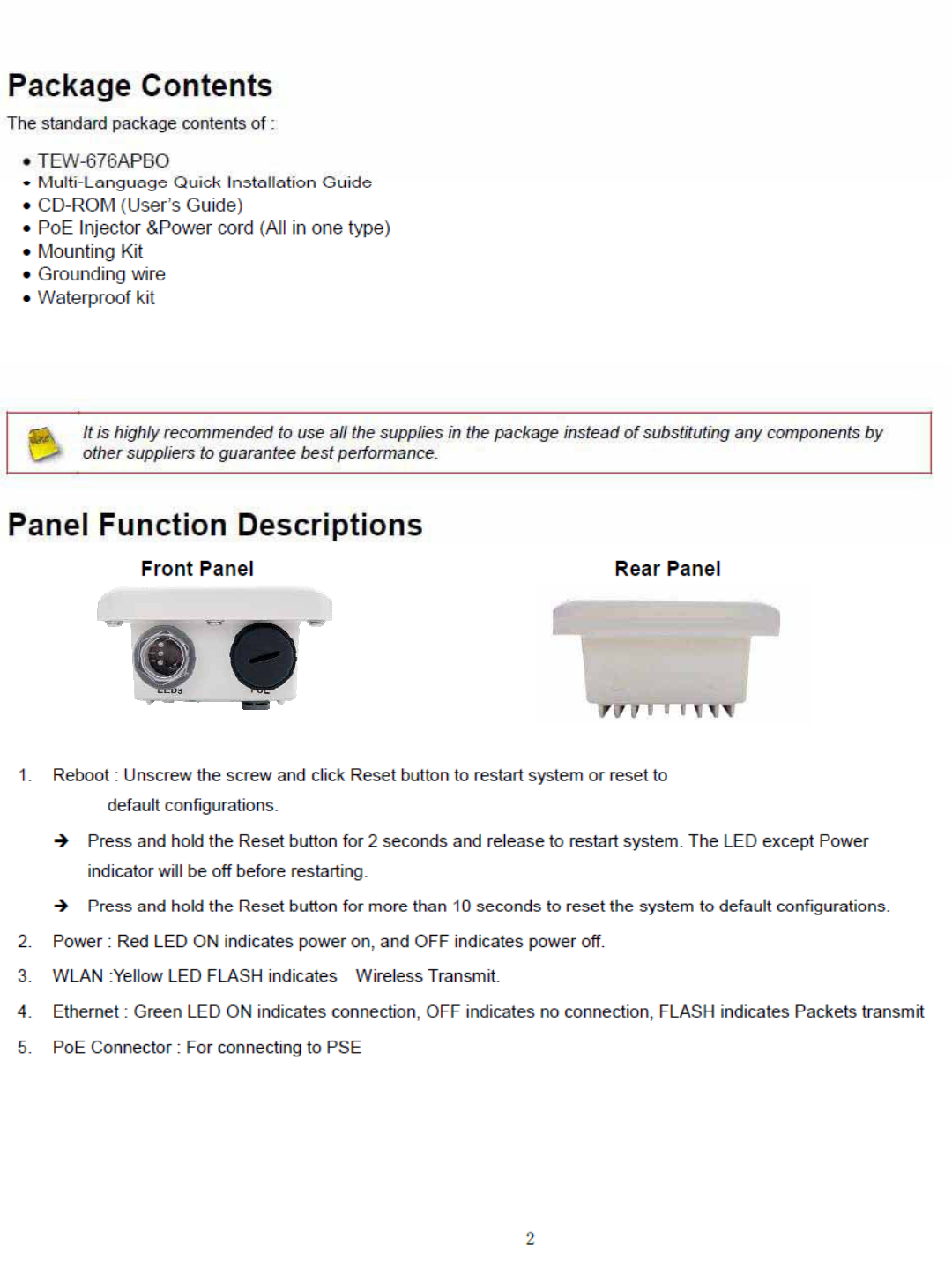
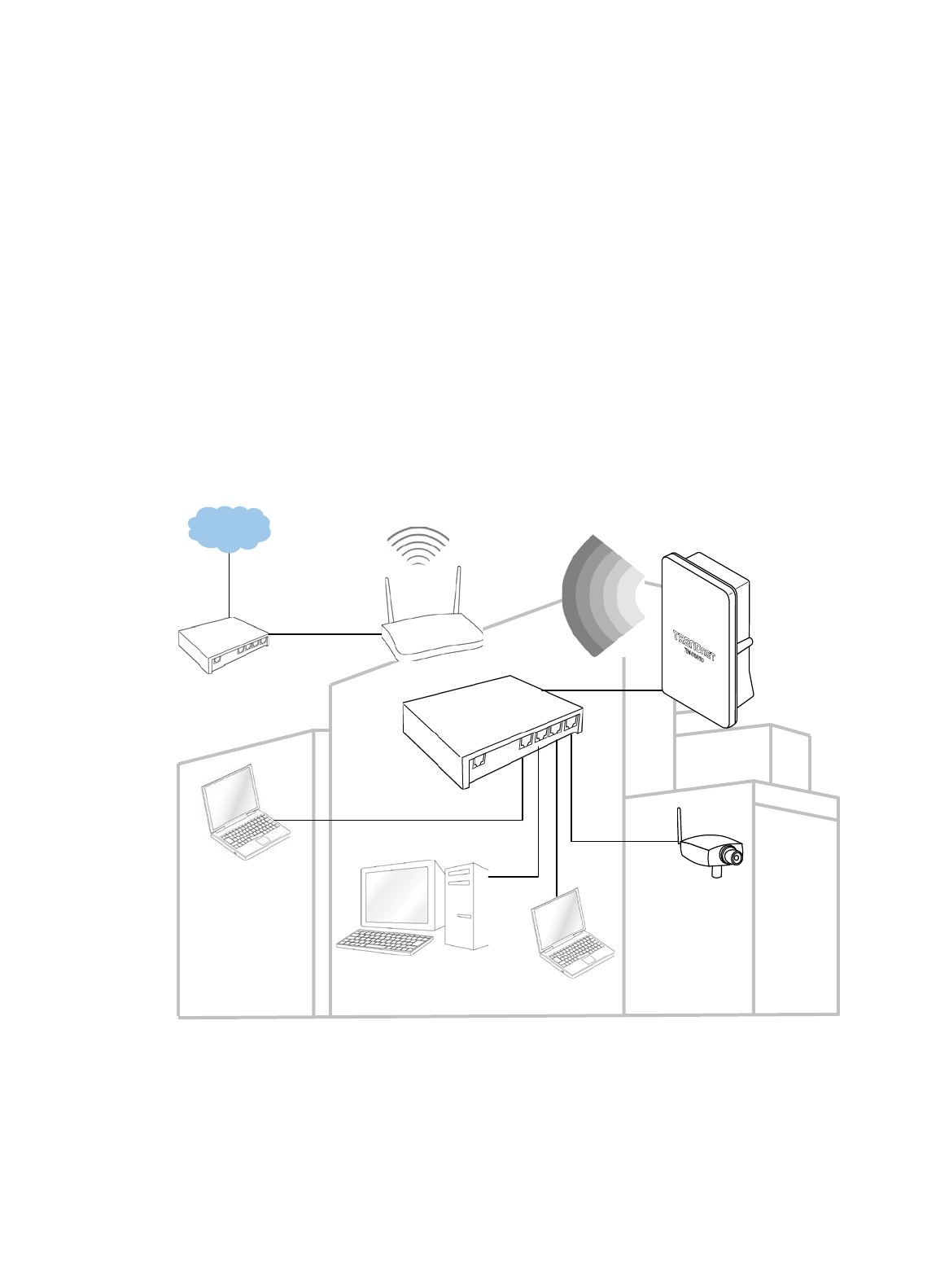
㻟
System Concept
The TEW-676APBO is not only designed and used as atraditional outdoor AP, but also with rich features tailored for
WISP applications. The two-level management capability and access control ease WISP and owners to maintain and
manage wireless network in a more controllable fashion. Main applications are listed as follows with illustration:
Wireless CPE for Multi Dwelling Unit/Multi Tenant Unit(MDU/MTU) complexes including apartments, dormitories, and
office complexes.
Outdoor Access Point for school campuses, enterprise campuses, or manufacture plants.
Indoor Access Point for hotels, factories, or warehouses where industrial grade devices are preferred.
Public hotspot operation for café, parks, convention centers, shopping malls, or airports.
Wireless coverage for indoor and outdoor grounds in private resorts, home yards, or gulf course communities.
WAN
PoE
LAN
WISP
AP
DMZ
Online Game
Internet
Router
N
oteboo
k
Surveillance
TEW-676APBO
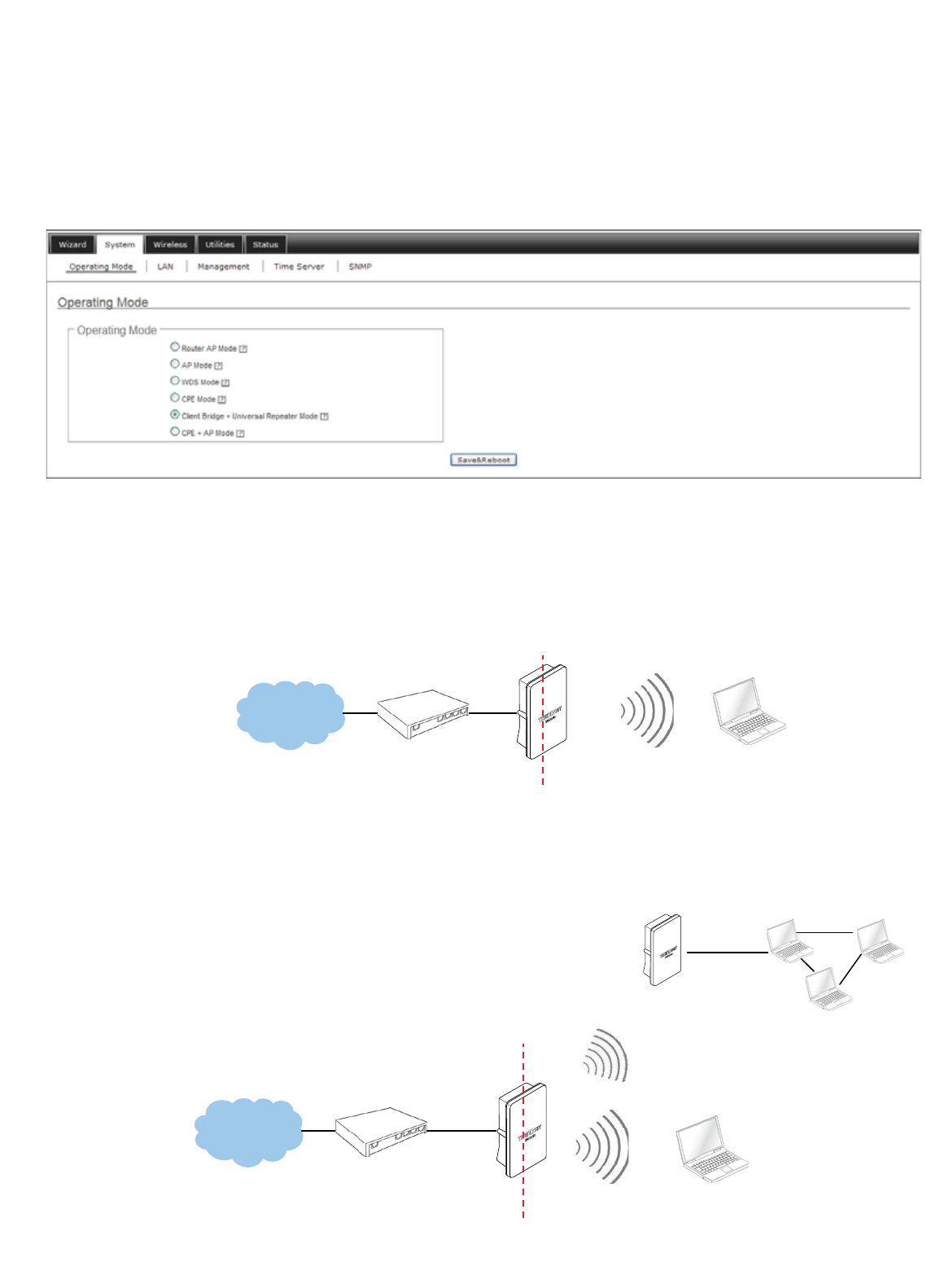
㻠
Applications
TEW-676APBO is multiple mode system which can be configured either as a wireless gateway or an access point as
desired. It also can be used as a WDS link for Ethernet network expansion. This section depicts different applications on
Router AP Mode,AP Mode,WDS Mode,CPE Mode,Client Bridge + Universal Repeater Mode and CPE + AP Mode.
Configuration on Router AP Mode (Gateway + Access Point + WDS)
ÎExample 1 : Router AP without WDS
9It can be deployed as a gateway with wireless Access Point
ÎExample 2 : Router AP with WDS
9It can be deployed as a gateway with wireless Access Point and provides WDS link for network extension.
192.168.2.x
Internet
192.168.2.10
SSID: Main
_
AP
WAN
192.168.1.254
WLAN
192.168.2.254
NAT
TEW-676APBO
Internet
192.168.2.10
WDS
Remote Bass Station
WAN
192.168.1.254
WLAN
192.168.2.254
SSID: Main
_
AP
NAT
TEW-676APBO
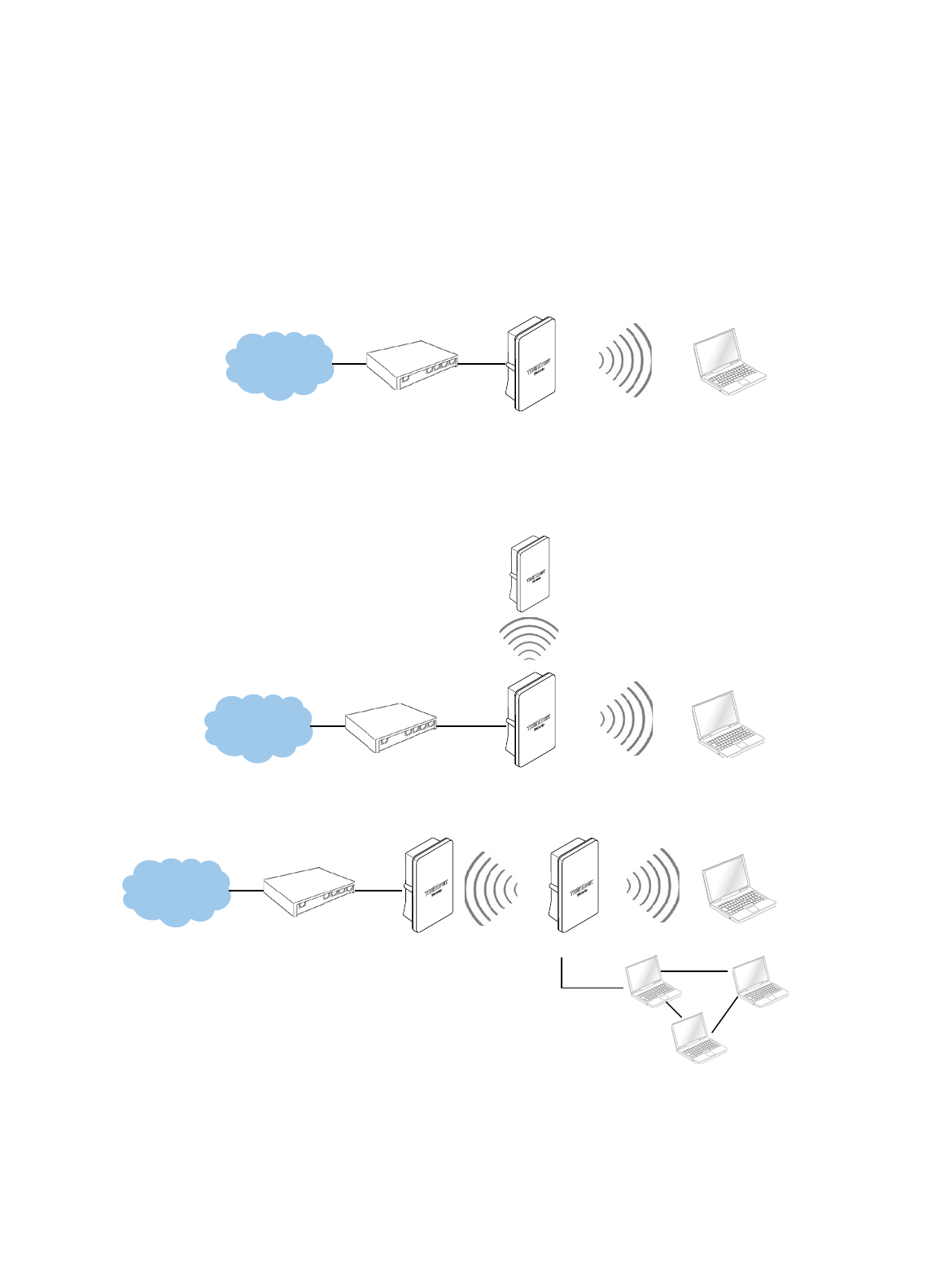
㻡
Configuration in AP Mode (including Access Point + WDS)
An access point can be either a main, relay or remote base station. A main base station is typically connected to a
wired network via the Ethernet port. A relay base station relays data between main base stations and relay stations or
remote base stations with clients. A remote base station is the end point to accept connections from wireless clients
and pass data upwards to a network wirelessly.
ÎExample 1 : Access Point without WDS
9It can be deployed as a tradition fixed wireless Access Point
ÎExample 2 : Access Point with WDS
9It can be deployed as a tradition fixed wireless Access Point and provides WDS link to expand network
Configuration in WDS Mode (Pure WDS)
An access point can be either a main, relay or remote base station. A main base station is typically connected to a
wired network via the Ethernet port. A relay base station relays data between main base stations and relay stations or
remote base stations with clients. A remote base station is the end point to accept connections from wireless clients
and pass data upwards to a network wirelessly. In this mode, it can support single or multiple WDS links and no
wireless clients canassociate with it.
Internet
192.168.2.10
192.168.2.254
SSID: Main
_
AP
TEW-676APBO
Internet
192.168.2.10
192.168.2.254
WDS
Remote Bass Station
192.168.2.250
SSID: Main
_
AP
TEW-676APBO
192.168.2.10
Internet
Main Base Station
192.168.2.250
WDS
192.168.2.x
192.168.2.254
SSID: Main
_
AP
TEW-676APBO
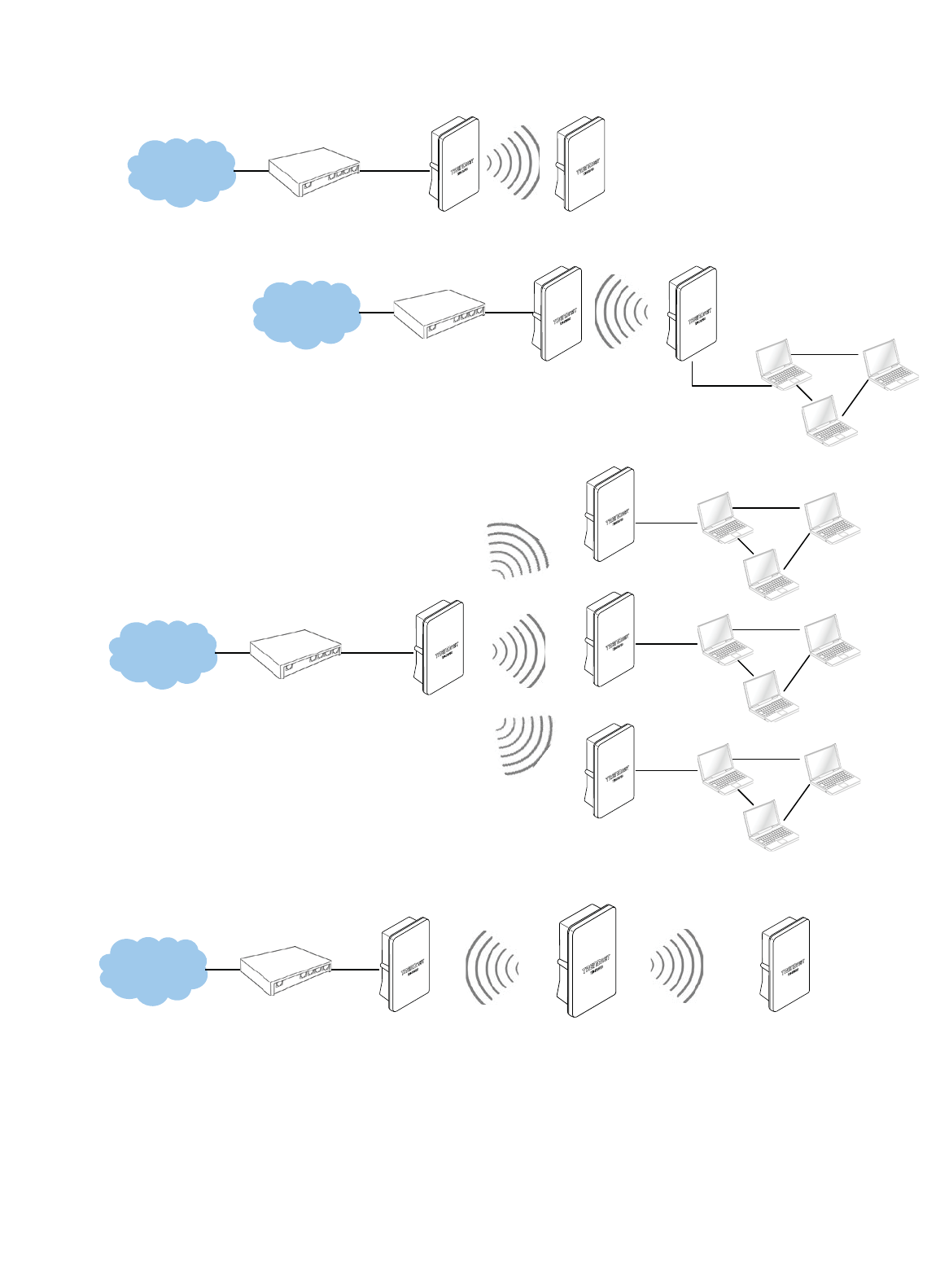
㻢
ÎExample 1 : Point-to-Point
ÎExample 2 : Point-to-Multi-Point
ÎExample 3 : Multi-Point Repeating bridge
Configuration in CPE Mode
It can be used as an Outdoor Customer Premises Equipment (CPE) to receive wireless signal over last mile
application, helping WISPs deliver wireless broadband Internet service to residents and business customers. In the
CPE mode, TEW-676APBO is a gateway enabled with NAT and DHCP Server functions. The wired clients connected
to TEW-676APBO are in different subnet from those connected to Main Base Station, and, in CPE mode, it does not
accept wireless association from wireless clients.
Internet
192.168.2.254
WDS
Remote Bass Station
192.168.2.250
Internet
Main Base Station
192.168.2.250
WDS
192.168.2.x
192.168.2.254
TEW-676APBO TEW-676APBO
Internet
Main Base Station
192.168.2.250
WDS
192.168.2.254
WDS
Remote Base Station
192.168.2.253
TEW-676APBO
TEW-676APBO
Internet
192.168.2.254
Remote Base Station
192.168.2.252
192.168.2.x
WDS
WDS
WDS
Remote Base Station
192.168.2.251
Remote Base Station
192168 2250
192.168.2.x
192.168.2.x
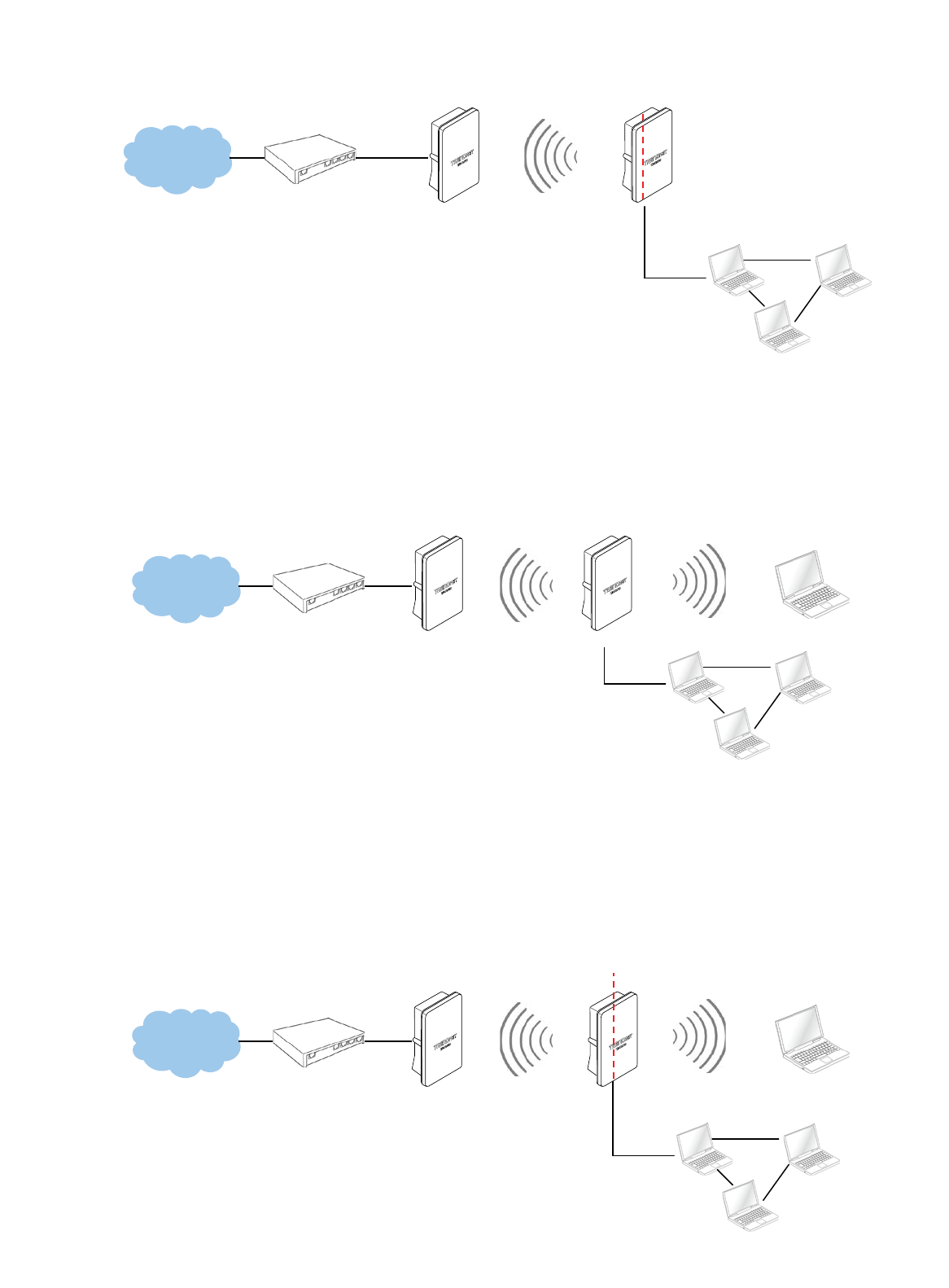
㻣
Configuration in Client Bridge + Universal Repeater Mode
It can be used as an Client Bridge + Universal Repeater to receive wireless signal over last mile applications, helping
WISPs deliver wireless broadband Internet service to new residential and business customers. In this mode, TEW-
676APBO is enabled with DHCP Server functions. The wired clients of WCB1200H2PX are in the same subnet from
Main Base Station and it accepts wireless connections from client devices.
Configuration on CPE + AP Mode (Router Client + Access Point)
It can be used as an Outdoor Customer Premised Equipment(CPE) to receive wireless signal over the last mile,
helping WISPs deliver wireless broadband Internet service to new residential and business customers. In this mode,
theTEW-676APBO is a gateway with NAT and DHCP Server functions. The wireless and wired clients of TEW-
676APBO are on the different subnet from Main Base Station and it accepts wireless connections from client
devices.
192.168.2.10
192.168.2.x
Internet
Main Base Station
192.168.2.250
192.168.2.x
SSID: Main
_
AP SSID: Re
p
eater
_
Main
_
AP
WIFI WAN
192.168.1.254
LAN
192.168.2.254
NAT
TEW-676APBO
Internet
Main Base Station
192.168.2.250
192.168.2.x
192.168.2.254
SSID: Main
_
AP SSID: Re
p
eater
_
Main
_
AP
TEW-676APBO
SSID: Main
_
AP
Internet
WIFI WAN
192.168.1.254
Main Base Station
192.168.1.150 LAN
192.168.2.254
NAT
TEW-676APBO

㻤
Product Benefit
The 14dBi High Power Wireless N Outdoor PoE Access Point is the point of connection to Wireless Outdoor Network for
service provider deploying last mile services to business or residential broadband subscribers.. Network administrators
can create multiple subscriber service tier using per-subscriber rate limiting features, and manage centrally.
WCB1200H2PX outdoor bridge utilizes a 200mW output Tx Power to connect to the WiFi mesh or WDS infrastructure and
provides the subscriber with an Ethernet connection for a local access.
The 14dBi High Power Wireless N Outdoor PoE Access Point can be used for nine different purposes in six different
modes, the Router AP mode , AP mode, the WDS mode, the CPE mode, Client Bridge + Universal Repeater mode and
CPE + AP mode,
Installation Considerations
There are a number of factors that can impact the range of wireless devices.
1. Adjust your wireless devices so that the signal is traveling in a straight path, rather than at an angle. The more
material the signal has to pass through the more signal you will lose.
2. Keep the number of obstructions to a minimum. Each obstruction can reduce the range of a wireless device.
Position the wireless devices in a manner that will minimize the amount of obstructions between them.
3. Building materials can have a large impact on your wireless signal. In an indoor environment, try to position the
wireless devices so that the signal passes through less dense material such as dry wall. Dense materials like metal,
solid wood, glass or even furniture may block or degrade the signal.
4. Antenna orientation can also have a large impact on your wireless signal. Use the wireless adapter’s site survey tool
to determine the best antenna orientation for your wireless devices.
5. Interference from devices that produce RF (radio frequency) noise can also impact your signal. Position your wireless
devices away from anything that generates RF noise, such as microwaves, radios and baby monitors.
6. Any device operating on the 2.4GHz frequency will cause interference. Devices such as 2.4GHz cordless phones or
other wireless remotes operating on the 2.4GHz frequency can potentially drop the wireless signal. Although the
phone may not be in use, the base can still transmit wireless signal. Move the phone’s base station as far away as
possible from your wireless devices.
If you are still experiencing low or no signal consider repositioning the wireless devices or installing additional access
points. The use of higher gain antennas may also provide the necessary coverage depending on the environment.

㻥
Web Management Interface Instructions
TEW-676APBO supports web-based configuration. Upon the completion of hardware installation, WCB1200H2PX can be
configured through a PC/NB by using its web browser such as Internet Explorer version 6.0.
Default IP Address : 192.168.2.254
Default IP Netmask : 255.255.255.0
Default User Name and Password :
The default user name and password for both root manager account and admin manager account are as follows :
Mode Router AP CPE AP WDS UR + CB CPE + AP
Management Account Root
Account
Root
Account
Admin
Account
Root
Account
Root
Account
Root
Account
Root
Account
Admin
Account
User Nameroot root admin root root root root admin
Password default default admin default default default default admin
Step
IP Segment Set-up for Administrator's PC/NB
Set the IP segment of the administrator's computer to be in the same range as TEW-676APBO for accessing the
system. Do not duplicate the IP Address used here with IP Address of TEW-676APBO or any other device within the
network
Example of Segment :
The valid range is 1 ~ 254 and 192.168.2.254 shall be avoided because it is already assigned to TEW-676APBO .
192.168.2.10 is used in the example below.
IP Address : 192.168.2.10
IP Netmask : 255.255.255.0
Launch Web Browser
Launch web browser to access the web management interface of system by entering the default IP Address,
http://192.168.2.254, in the URL field, and then press Enter.
System Login
The system manager Login Page then appears.
Enter “root” as User nameand “root” as Password, and then click OK to login to the system; the root manager
account is used as an example here.
Login Success
System Overview page will appear after successful login.
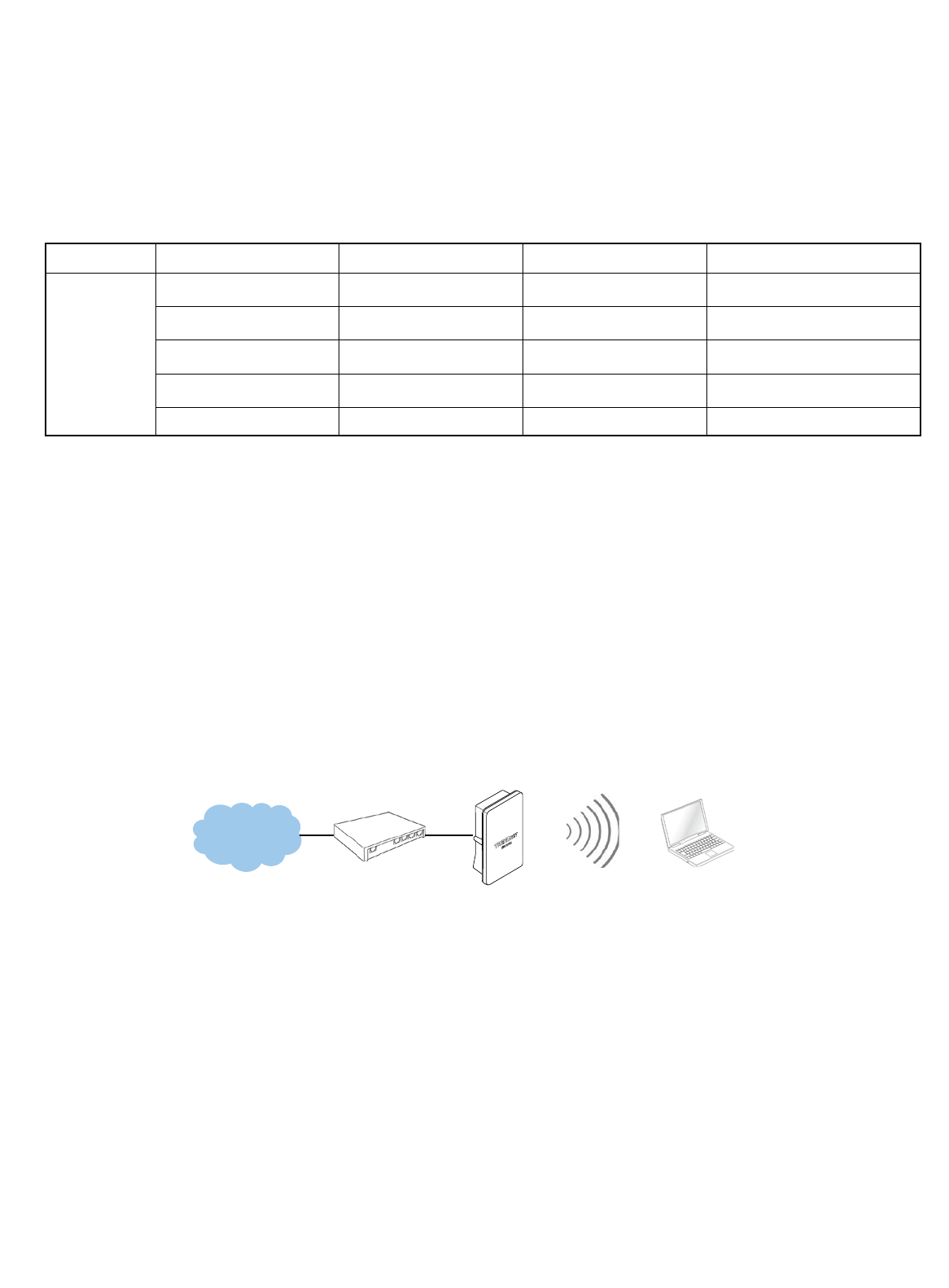
㻝㻜
AP Mode Configuration
When AP mode is chosen, the system can be configured as an Access Point. This section provides detailed explanation
for users to configure in the AP mode with help of illustrations. In the AP mode, functions listed in the table below are also
available from the Web-based GUI interface.
Option SystemWireless Utilities Status
Functions
Operating Mode General Setup Profiles SettingsSystem Overview
LAN Advanced Setup Firmware Upgrade Clients
Management Virtual AP Network Utility WDS Status
Time Server WDS Setup Reboot Extra Info
SNMP Event Log
Table 3-1: AP Mode Functions
External Network Connection
Network Requirement
Normally, TEW-676APBO connects to a wired LAN and provides a wireless connection point to associate with wireless
client as shown in Figure 3-1. Then, Wireless clients could access to LAN or Internet by associating themselves with
TEW-676APBO set in AP mode.
Figure 3-1 Access Point on a Wired LAN Configuration
Internet
192.168.2.10
192.168.2.254
SSID: Main
_
AP
TEW-676APBO
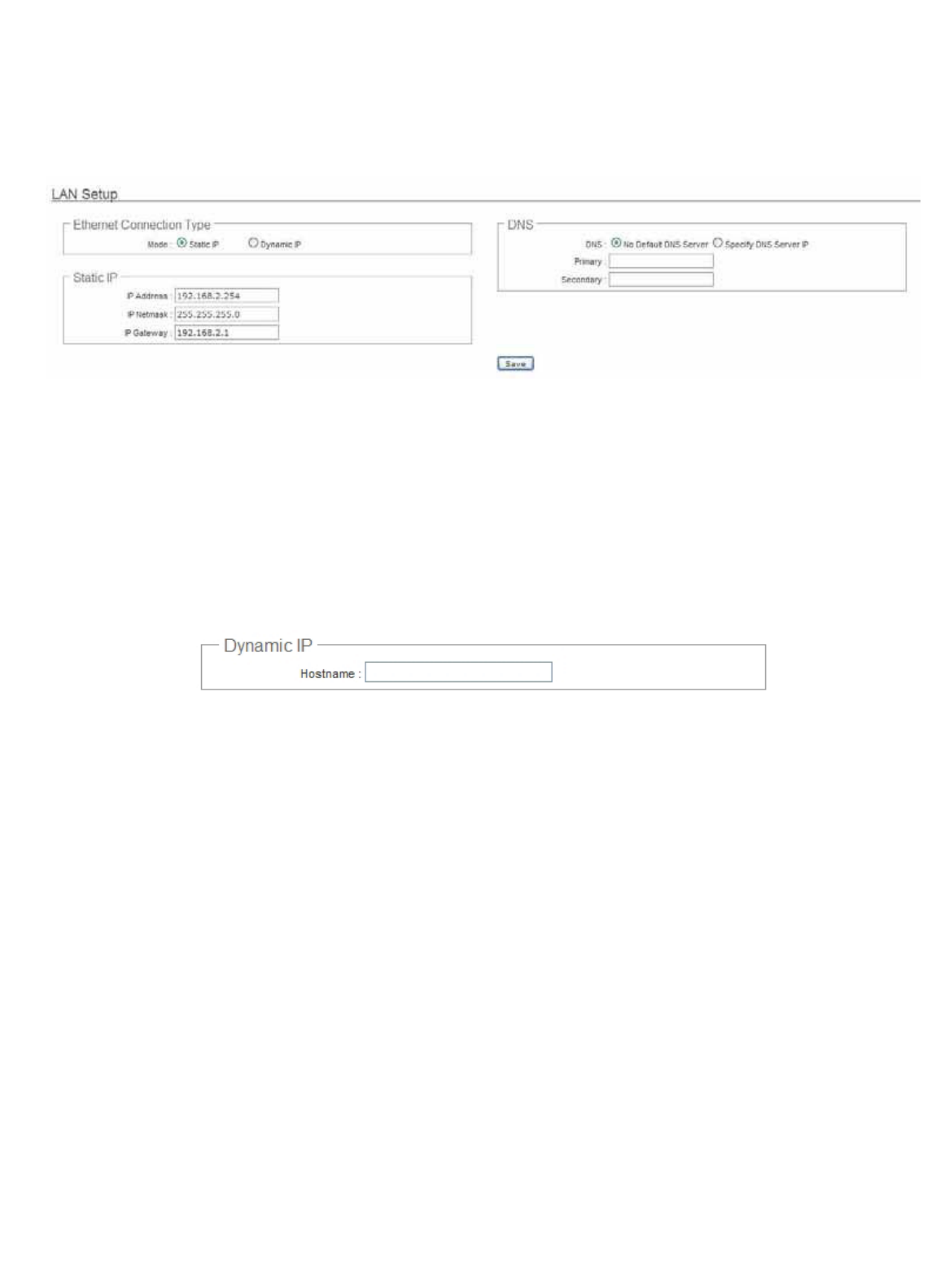
㻝㻝
Configure LAN IP
Here are the instructions to setup the local IP Address and Netmask.
Please click on System -> LAN and follow the below setting.
Mode : Check either “Static IP” or “Dynamic IP” button as desired to set up the system IP of LAN port .
ÎStatic IP : The administrator can manually setup the LAN IP address when static IP is available/ preferred.
9IP Address : The IP address of the LAN port; default IP address is 192.168.2.254
9IP Netmask : The Subnet mask of the LAN port; default Netmask is 255.255.255.0
9IP Gateway : The default gateway of the LAN port; default Gateway is 192.168.2.1
ÎDynamic IP : This configuration type is applicable when the TEW-676APBO is connected to a network with the
presence of a DHCP server; all related IP information will be provided by the DHCP server automatically.
9Hostname : The Hostname of the LAN port
DNS : Check either “No Default DNS Server” or “Specify DNS Server IP” button as desired to set up the system
DNS.
ÎPrimary : The IP address of the primary DNS server.
ÎSecondary : The IP address of the secondary DNS server.
802.1d Spanning Tree
The spanning tree network protocol provides a loop free topology for a bridged LAN between LAN interface and 4
WDS interfaces from wds0 to wds3. The Spanning Tree Protocol, which is also referred to as STP, is defined in the
IEEE Standard 802.1d. The Spanning tree always enabled on TEW-676APBO. Below Figures depict a loop for a
bridged LAN between LAN and WDS link
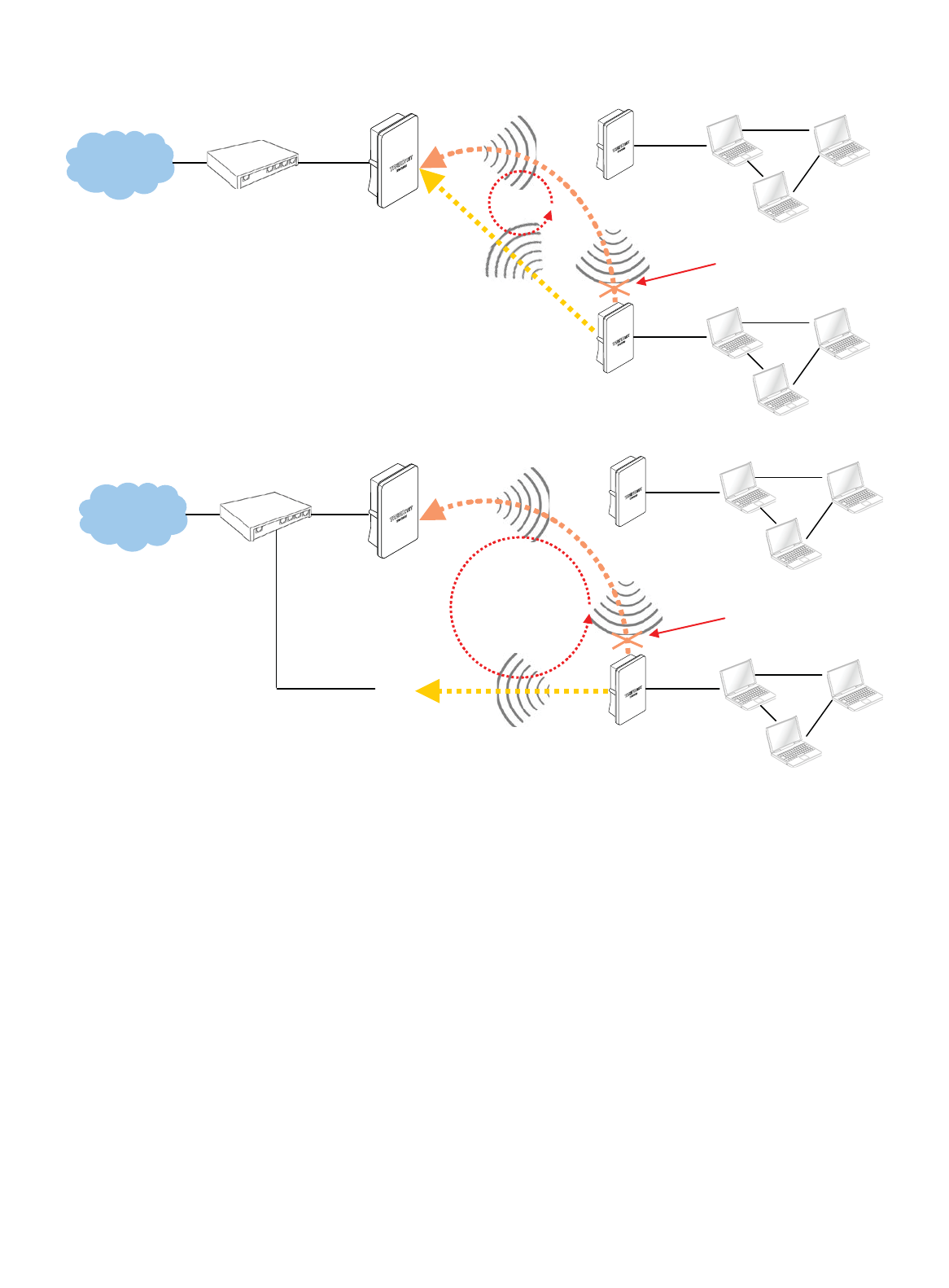
㻝㻞
Click Save button to save your changes. Click Reboot button to activate your changes
Internet
192.168.2.254
WDS
Remote Base Station
192.168.2.251
192.168.2.x
192.168.2.x
WDS
Ńlocked by
Spanning Tree Protocol
WDS
Remote Base Station
192.168.2.250
LOOP
Base Station
192.168.2.253
TEW-676APBO
192.168.2.x
Internet
192.168.2.254
WDS
Remote Base Station
192.168.2.251
192.168.2.x
WDS
Ńlocked by
Spanning Tree Protocol
WDS
Remote Base Station
192.168.2.250
LOOP
TEW-676APBO
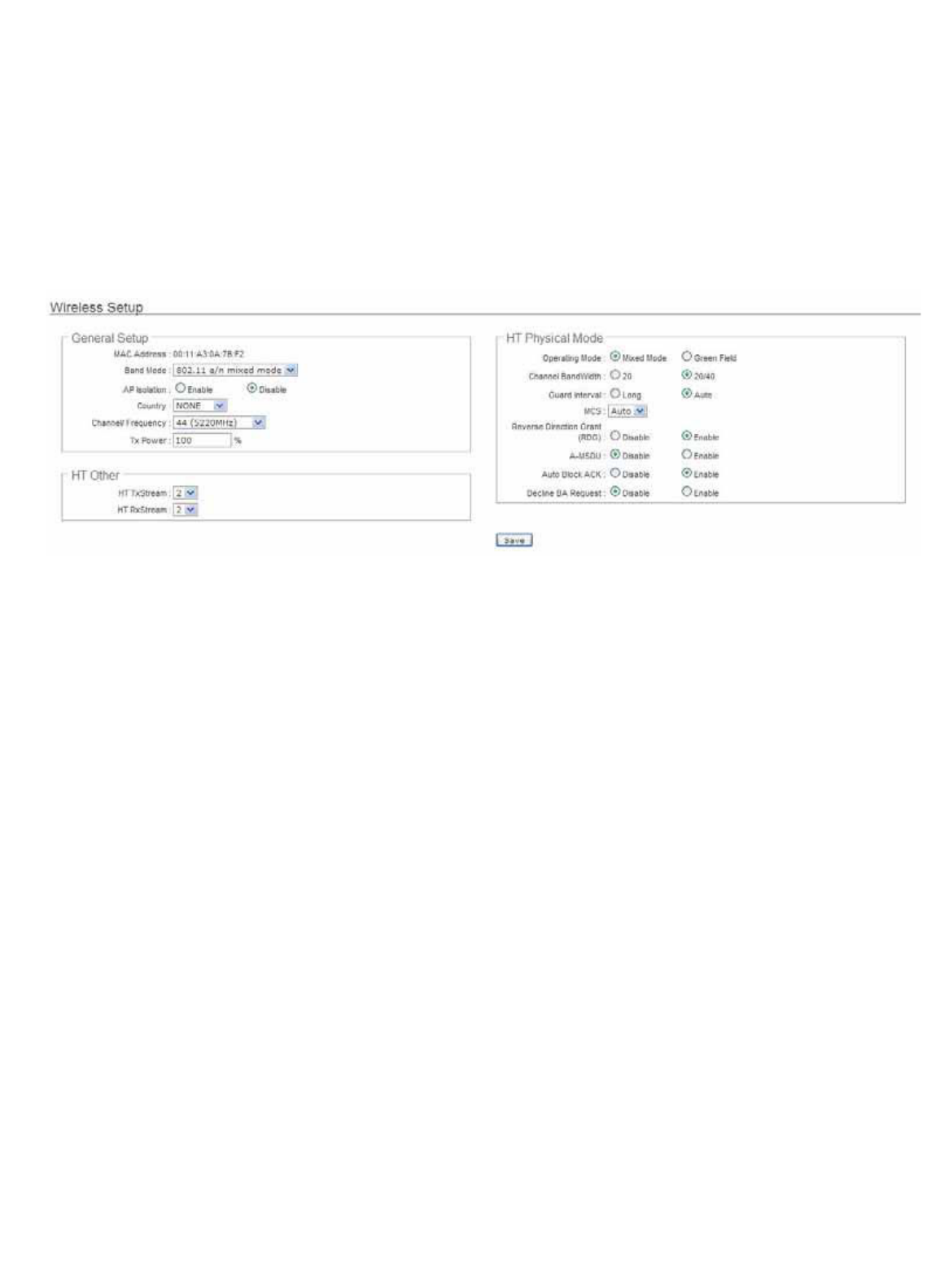
㻝㻟
Wireless LAN Network
The network manager can configure related wireless settings, General Settings, Advanced Settings, Virtual AP(VAP)
Setting, Security Settings and MAC Filter Settings.
Wireless General Setup
The administrator can change the data transmission, channel and output power settings for the system. Please click on
Wireless -> General Setup and follow the below setting.
MAC Address : The MAC address of the Wireless interface is displayed here.
Band Mode : Select an appropriate wireless band; bands available are 801.11aor 802.11a/n mixed mode.
AP Isolation : Select Enable, all clients will be isolated from each VAP, that means different VAP's clients can not
reach to each other.
Transmit Rate Control : Select the desired rate from the drop-down list; the options are auto or ranging from 6to
54Mbps only for 802.11amode.
Country : Select the desired country code from the drop-down list; the options are US,ETSI,JP and NONE.
Channel/Frequency : The channel range will be changed by selecting different country code. Below depicts the
channel range for different Country. When “Band Mode” selected in “802.11a/n”, the Channel 140 and 165 does not
shown-up on list.
Country Channel
US36, 40, 44, 48, 52, 56, 60, 64, 149, 153, 157, 161, 165
ETSI 36, 40, 44, 48, 52, 56, 60, 64, 100, 104, 108, 112, 116, 120, 124, 128, 132, 136, 140
JP 36, 40, 44, 48
NONE 36, 40, 44, 48, 52, 56, 60, 64, 100, 104, 108, 112, 116, 120, 124, 128, 132, 136, 140, 149, 153, 157, 161, 165
Tx Power : You can adjust the output power of the system to get the appropriate coverage for your wireless network.
Specify digit numbers between 1to 100 (the unit is %) for your environment. If you are not sure which setting to
choose, then keep the default setting, 100%.
When Band Mode select in 802.11a only mode, the HT(High Throughput) settings should be hidden immediately.

㻝㻠
HT TxStream/RxStream : By default, it's 2.
Operating Mode : By default, it's Mixed Mode.
ÎMixed Mode : In this mode packets are transmitted with a preamble compatible with the legacy 802.11a/g, the
rest of the packet has a new format. In this mode the receiver shall be able to decode both the Mixed Mode
packets and legacy packets.
ÎGreen Field : In this mode high throughput packets are transmitted without a legacy compatible part.
Channel Bandwidth : The "20/40” MHz option is usually best. The other option is available for special
circumstances.
Guard Interval : Using “Auto” option can increase throughput. However, it can also increase error rate in some
installations, due to increased sensitivity to radio-frequency reflections. Select the option that works best for your
installation.
MCS : This parameter represents transmission rate. By default (Auto) the fastest possible transmission rate will be
selected. You have the option of selecting the speed if necessary. (Refer to Appendix C. MCS Data Rate)
Reverse Direction Grant(RDG) : Disable or enable reserve direction grant. Default is enabled.
A-MSDU : Aggregated Mac Service Data Unit. Select Enable to allow aggregation for multiple MSDUs in one MPDU
Default is disabled.
Auto Block ACK : Disable or enable auto block ACK. Default is enabled.
Decline BA Request : Disable or enable decline BA request. Default is disabled.
Change these settings as described here and click Save button to save your changes. Click Reboot button to activate
your changes. The items in this page are for AP's RF general settings and will be applied to all VAPs and WDS Links.
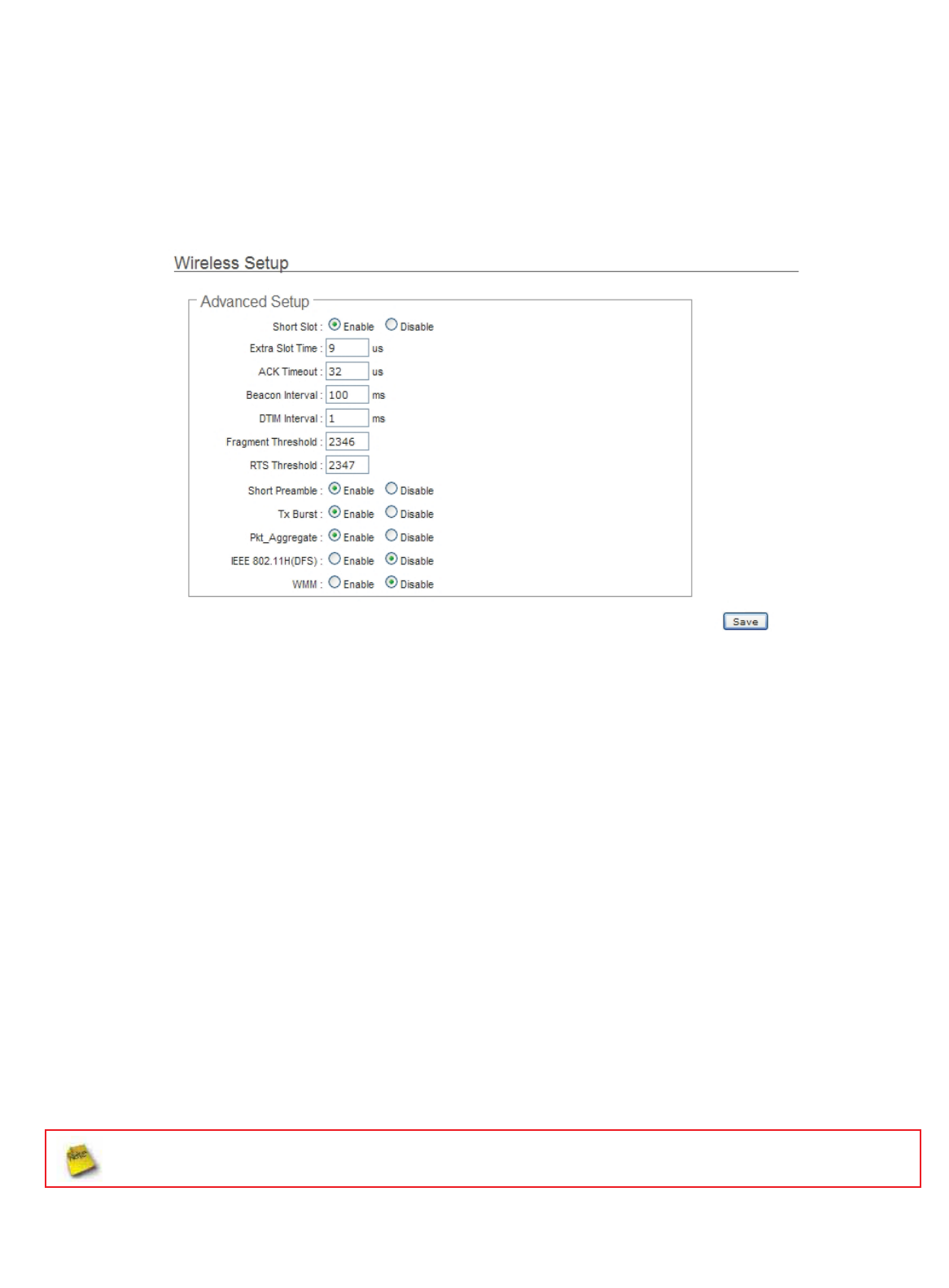
㻝㻡
Wireless Advanced Setup
To achieve optimal wireless performance, it is necessary to tweak advance setting per requirements properly, not
necessary higher the better or lower.
The administrator can change the RTS threshold and fragmentation threshold settings for the system. Please click on
Wireless -> Advanced Setup and follow the below setting.
Short Slot : By default, it’s “Enable”for educing the slot time from the standard 20 microseconds to the 9
microsecond short slot time
Slot time is the amount of time a device waits after a collision before retransmitting a packet. Reducing the slot time
decreases the overall back-off, which increases throughput. Back-off, which is a multiple of the slot time, is the
random length of time a station waits before sending a packet on the LAN. For a sender and receiver own right of the
channel the shorter slot time help manage shorter wait time to re-transmit from collision because of hidden wireless
clients or other causes. When collision sources can be removed sooner and other senders attempting to send are
listening the channel(CSMA/CA) the owner of the channel should continue ownership and finish their transmission
and release the channel. Then, following ownership of the channel will be sooner for the new pair due to shorter slot
time. However, when long duration of existing collision sources and shorter slot time exist the owners might
experience subsequent collisions. When adjustment to longer slot time can’t improve performance then RTS/CTS
could supplement and help improve performance.
Extra Slot Time : Slot time is in the range of 1~255 and set in unit of microsecond. The default value is 9
microsecond.
When you enable Short Slot and set Extra Slot time to “10”, the actual Slot Time=9+10 us.
When you disable Short Slot and set Extra Slot time to “10”, the actual Slot Time=20+10 us.

㻝㻢
ACK Timeout : ACK timeout is in the range of 1~255 and set in unit of microsecond. The default value is 32
microsecond.
All data transmission in 802.11b/g request an “Acknowledgement” (ACK) send by receiving radio. The transmitter will
resend the original packet if correspondent ACK failed to arrive within specific time interval, also refer to as “ACK
Timeout”.
ACK Timeout is adjustable due to the fact that distance between two radio links may vary in different deployment.
ACK Timeout makes significant influence in performance of longdistance radio link. If ACK Timeout is set too short,
transmitter will start to “Resend” packet before ACK is received, and throughputs become low due to excessively high
re-transmission.
ACK Timeout is best determined by distance between the radios, datarate of average environment. The Timeout
value is calculated based on round-trip time of packet with a little tolerance, So, if experiencing re-transmissions or
poor performance the ACK Timeout could be made longer to accommodate.
Slot Time and ACK Timeout settings are for long distance links. It is important to tweak settings to achieve the
optimal result based on requirement.
Beacon Interval : Beacon Interval is in the range of 20~1024 and set in unit of millisecond. The default value is 100
msec.
Access Point (AP) in IEEE 802.11 will send out a special approximated 50-byte frame, called “Beacon”. Beacon is
broadcast to all the stations, provides the basic information of AP such as SSID, channel, encryption keys, signal
strength, time stamp, support data rate.
All the radio stations received beacon recognizes the existence of such AP, and may proceed next actions if the
information from AP matches the requirement. Beacon is sent on a periodic basis, the time interval can be adjusted.
By increasing the beacon interval, you can reduce the number of beacons and associated overhead, but that will
likely delay the association and roaming process because stations scanning for available access points may miss the
beacons. You can decrease the beacon interval, which increases the rate of beacons. This will make the association
and roaming process very responsive; however, the network will incur additional overhead and throughput will go
down.
DTIM Interval : The DTIM interval is in the range of 1~255. The default is 1.
DTIM is defined as Delivery Traffic Indication Message. It is used to notify the wireless stations, which support power
saving mode, when to wake up to receive multicast frame. DTIM is necessary and critical in wireless environment as
a mechanismto fulfill power-saving synchronization.
A DTIM interval is a count of the number of beacon frames that must occur before the access point sends the
buffered multicast frames. For instance, if DTIM Interval is set to 3, then the Wi-Fi clients will expect to receive a
multicast frame after receiving three Beacon frame. The higher DTIM interval will help power saving and possibly
decrease wireless throughput in multicast applications.

㻝㻣
Fragment Threshold : The Fragment Threshold is in the range of 256~2346 byte. The default is 2346 byte.
Each Wi-Fi packet can be divided into smaller packets, marked with a sequential fragment number and re-assemble
in the receiving ends. The purpose is to make a short frame, instead of long frame, transmitting by radio in a heavy
noisy environment. Because of sending smaller frames, corruptions are much less likely to occur. The pros is
obvious, the cons is the overhead for transmission. So, in a clean environment, higher fragment threshold can be an
option to increase throughput.
Fragmentation will be triggered by setting the Fragment Threshold, usually in Byte-length. Only when the frame size
is over the Threshold, fragmentation will take place automatically.
RTS Threshold : TRTS Threshold is in the range of 1~2347 byte. The default is 2347 byte.
The main purpose of enabling RTS by changing RTS threshold is to reduce possible collisions due to hidden wireless
clients. RTS in AP will be enabled automatically if the packet size is larger than the Threshold value. By default, RTS
is disabled in a normal environment supports non-jumbo frames.
Short Preamble : By default, it’s “Enable”. To Disable is to use Long 128-bit Preamble Synchronization field.
The preamble is used to signal "here is a train of data coming" to the receiver. The short preamble provides 72-bit
Synchronization field to improve WLAN transmission efficiency with less overhead.
Tx Burst : By default, it’s “Enable”. To Disable is to deactivate Tx Burst.
With TX burst enabled, AP will send many packets in a burst, without collision detection and RTS/CTS for each packet. TX
Burst have better throughput but cause interference with other APs in channel.
Pkt_Aggregate : By default, it's “Enable”
Increase efficiency by aggregating multiple packets of application data into a single transmission frame. In this way,
802.11n networks can send multiple data packets with the fixed overhead cost of just a single frame.
IEEE802.11H (DFS) : By default, it's “Disable”. To Enable is to use IEEE802.11H(DFS)
With DFS(Dynamic Frequency Selection) enabled, radio is operating on one of the following channels, the wireless
device uses DFS to monitor the operating frequency and switch to another frequency or reduce power as necessary:
DFS Channels 52, 56, 60, 64, 100, 104, 108, 112, 116, 120, 124, 128, 136, 140
The maximum legal transmit power is greater for some 5 GHz channels than for others. When the wireless device
randomly selects a 5 GHz channel on which power is restricted, the wireless device automatically reduces transmit
power to comply with power limits for that channel in that regulatory domain.
The Channel 52-140 is DFS channel. If tuen on IEEE802.11H, AP Will have 60 sec to do
channel available check, and will not send beacon and can not be connect. When
WCB1200H2PX detect radar(5GHz) signal, the AP will switch channel and stop beacon
trasmit between 15 sec.
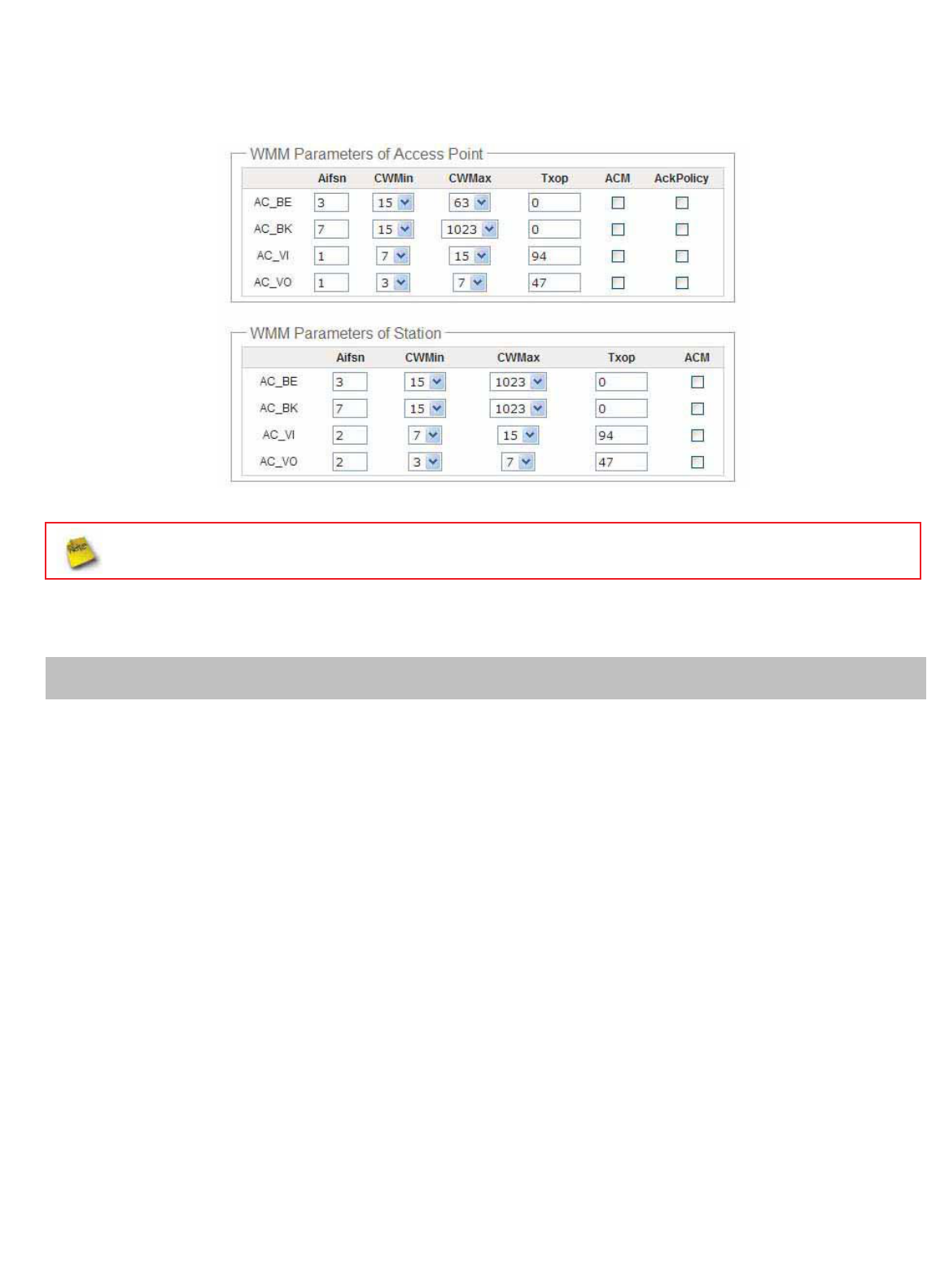
㻝㻤
WMM : By default, it's “Disable”. To Enable is to use WMM and the WMM parameters should appears.
When you enable WMM, the “Tx Burst” will be Disabled automatically by system.
ÎWMM Parameters of Access Point : This affects traffic flowing from the access point to the client station
Queue Data Transmitted
AP to Clients Priority Description
AC_BK Background. LowHigh throughput. Bulk data that requires maximum throughput and is not time-
sensitive is sent to this queue (FTP data, for example).
AC_BE Best Effort MediumMedium throughput and delay. Most traditional IP data is sent to this queue
AC_VIVideo High Minimum delay. Time-sensitive video data is automatically sent to this queue
AC_VOVoice HighTime-sensitive data like VoIP and streaming media are automatically sent to this
queue
Configuring QoS options consists of setting parameters on existing queues for different types of wireless traffic.
You can configure different minimum and maximum wait times for the transmission of packets in each queue
based on the requirements of the media being sent. Queues automatically provide minimum transmission delay
for Voice, Video, multimedia, and mission critical applications, and rely on best-effort parameters for traditional IP
data.
As an Example, time-sensitive Voice & Video, and multimedia are given effectively higher priority for transmission
(lower wait times for channel access), while other applications and traditional IP data which are less time-
sensitive but often more data-intensive are expected to tolerate longer wait times.

㻝㻥
9Aifsn : The Arbitration Inter-Frame Spacing Number specifies a wait time (in milliseconds) for data frames
9CWmin : Minimum Contention Window. This parameter is input to the algorithm that determines the initial
random back-off wait time ("window") for retry of a transmission. The value specified here in the Minimum
Contention Window is the upper limit (in milliseconds) of arange from which the initial random back-off wait
time is determined.
9CWmax: Maximum Contention Window. The value specified here in the Maximum Contention Window is
the upper limit (in milliseconds) for the doubling of the random back-off value. This doubling continues until
either the data frame is sent or the Maximum Contention Window size is reached. Once the Maximum
Contention Window size is reached, retries will continue until a maximum number of retries allowed is
reached. Valid values for the "cwmax" are 1, 3, 7, 15, 31, 63, 127, 255, 511, or 1024. The value for "cwmax"
must be higher than the value for "cwmin".
9Txop : Transmission Opportunity is an interval of time when a WME AP has the right to initiate
transmissions onto the wireless medium (WM). This value specifies (in milliseconds) the Transmission
Opportunity (TXOP) for AP; that is, the interval of time when the WMM AP has the right to initiate
transmissions on the wireless network.
9ACM : Admission Control Mandatory, ACM only takes effect on AC_VI and AC_VO. When you do not click
Checkbox, it means that the ACM is controlled by the connecting AP. If you click Checkbox, it means that the
Client is in charge.
9AckPolicy : Acknowledgment Policy, WMM defines two ACK policies: Normal ACK and No ACK.Click
“Checkbox” indicates “No ACK”
When the no acknowledgment (No ACK) policy is used, the recipient does not acknowledge received
packets during wireless packet exchange. This policy is suitable in the environment where communication
quality is fine and interference is weak. While the No ACK policy helps improve transmission efficiency, it
can cause increased packet loss when communication quality deteriorates. This is because when this policy
is used, a sender does not retransmit packets that have not been received by the recipient.
When the Normal ACK policy is used, the recipient acknowledges each received unicast packet.
ÎWMM Parameters of Station : This affects traffic flowing from the client station to the access point.
Queue Data Transmitted
Clients to AP Priority Description
AC_BK Background. LowHigh throughput. Bulk data that requires maximum throughput and is not time-
sensitive is sent to this queue (FTP data, for example).
AC_BE Best Effort MediumMedium throughput and delay. Most traditional IP data is sent to this queue
AC_VIVideo High Minimum delay. Time-sensitive video data is automatically sent to this queue
AC_VOVoice HighTime-sensitive data like VoIP and streaming media are automatically sent to this
queue
9Aifsn : The Arbitration Inter-Frame Spacing Number specifies a wait time (in milliseconds) for data frames
9CWmin : Minimum Contention Window. This parameter is input to the algorithm that determines the initial
random backoff wait time ("window") for retry of a transmission. The value specified here in the Minimum
Contention Window is the upper limit (in milliseconds) of a range from which the initial random backoff wait
time is determined.

㻞㻜
9CWmax: Maximum Contention Window. The value specified here in the Maximum Contention Window is
the upper limit (in milliseconds) for the doubling of the random backoff value. This doubling continues until
either the data frame is sent or the Maximum Contention Window size is reached. Once the Maximum
Contention Window size is reached, retries will continue until a maximum number of retries allowed is
reached. Valid values for the "cwmax" are 1, 3, 7, 15, 31, 63, 127, 255, 511, or 1024. The value for "cwmax"
must be higher than the value for "cwmin".
9Txop : Transmission Opportunity is an interval of time when a WME AP has the right to initiate
transmissions onto the wireless medium (WM). This value specifies (in milliseconds) the Transmission
Opportunity (Txop) for AP; that is, the interval of time when the WMM AP has the right to initiate
transmissions on the wireless network.
9ACM : Admission Control Mandatory, ACM only takes effect on AC_VI and AC_VO. When you do not click
Checkbox, it means that the ACM is controlled by the connecting AP. If you click Checkbox, it means that the
Client is in charge.
Click Save button to save your changes. Click Reboot button to activate your changes. The items in this page are for
AP's RF advanced settings and will be applied to all VAPs and WDS Links.
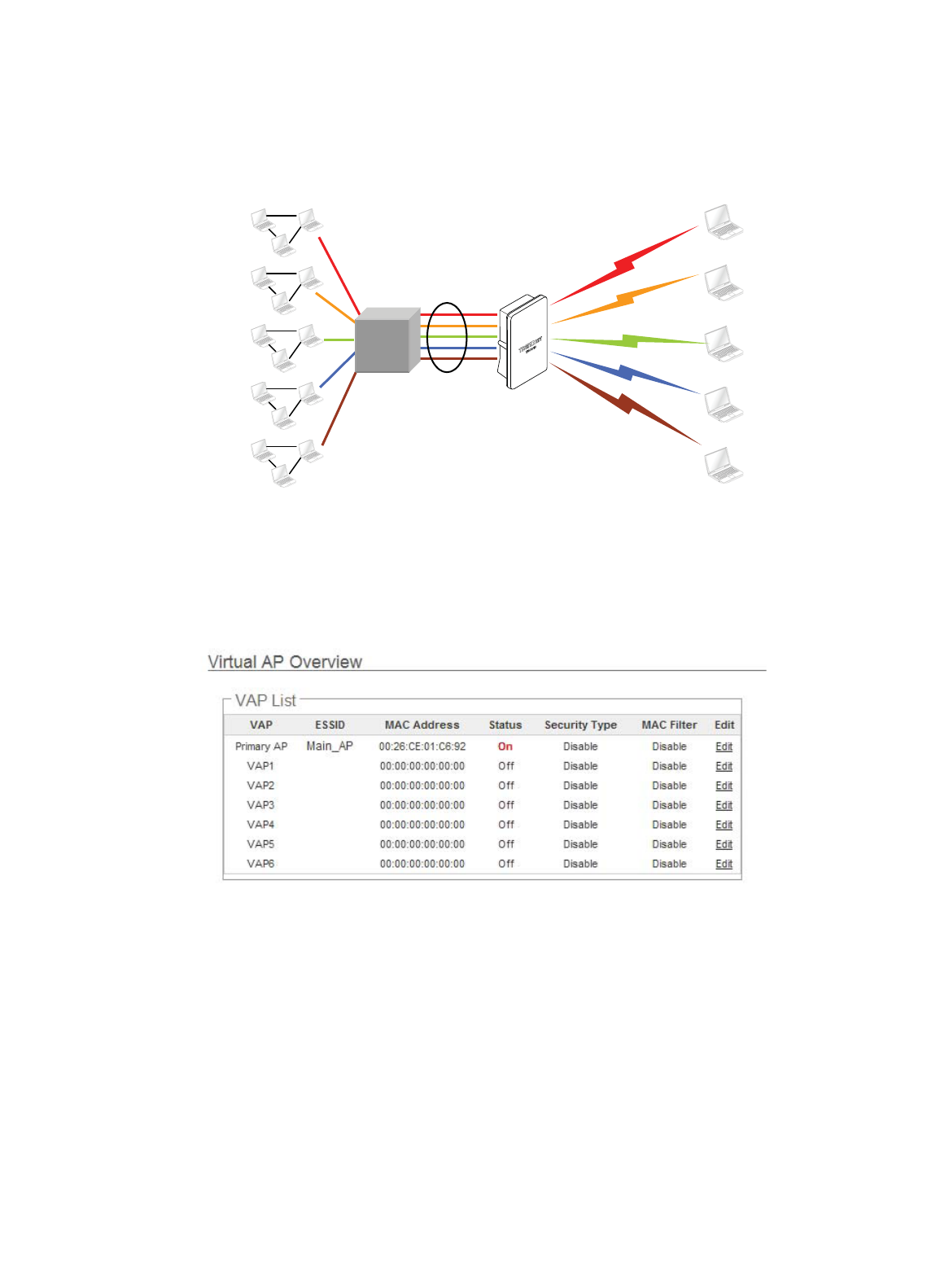
㻞㻝
Create Virtual AP (VAP)
The TEW-676APBO support broadcasting multiple SSIDs, allowing the creation of Virtual Access Points, partitioning a
single physical access point into 7logical access points, each of which can have a different set of security, VLAN Tag(ID)
and network settings. Figure 3-2 shows multiple SSIDs with different security type and VLAN settings.
Figure 3-2 Multiple SSIDs with different Security Type and VLAN Tag
Virtual AP Overview
The administrator can view all of the Virtual AP's settings via this page.
Please click on Wireless -> Virtual AP Setup and the Virtual AP Overview Page appears.
VAP : Indicate the system's Virtual AP.
ESSID : Indicate the ESSID of the respective Virtual AP
MAC Address : The MAC address of the VAP Interface is displayed here. When you enable AP and reboot system,
the MAC address will display here.
Status : Indicate the Status of the respective Virtual AP. The Primary AP always on.
Security Type : Indicate an used security type of the respective Virtual AP.
MAC Filter : Indicate an used MAC filter of the respective Virtual AP.
Edit : Click Edit button to configure Virtual AP's settings, including security type and MAC Filter.
SSID “Market”
192.168.2.254
VLAN #5
802.1Q Trunk
VLAN #4
VLAN #3
VLAN #2
VLAN #1
SSID “Accounting”
SSID “Guest”
SSID “Engineer”
SSID “Sales”
Sales Network Resource
Engineer Network Resource
Market Network Resource
Guest NetworkġResource
Accounting NetworkġResource
WPA2-PSK/AES
WPA2-PSK/TKIP
WPA-PSK/AES
WPA-PSK/TKIP
WEP
TEW-676APBO
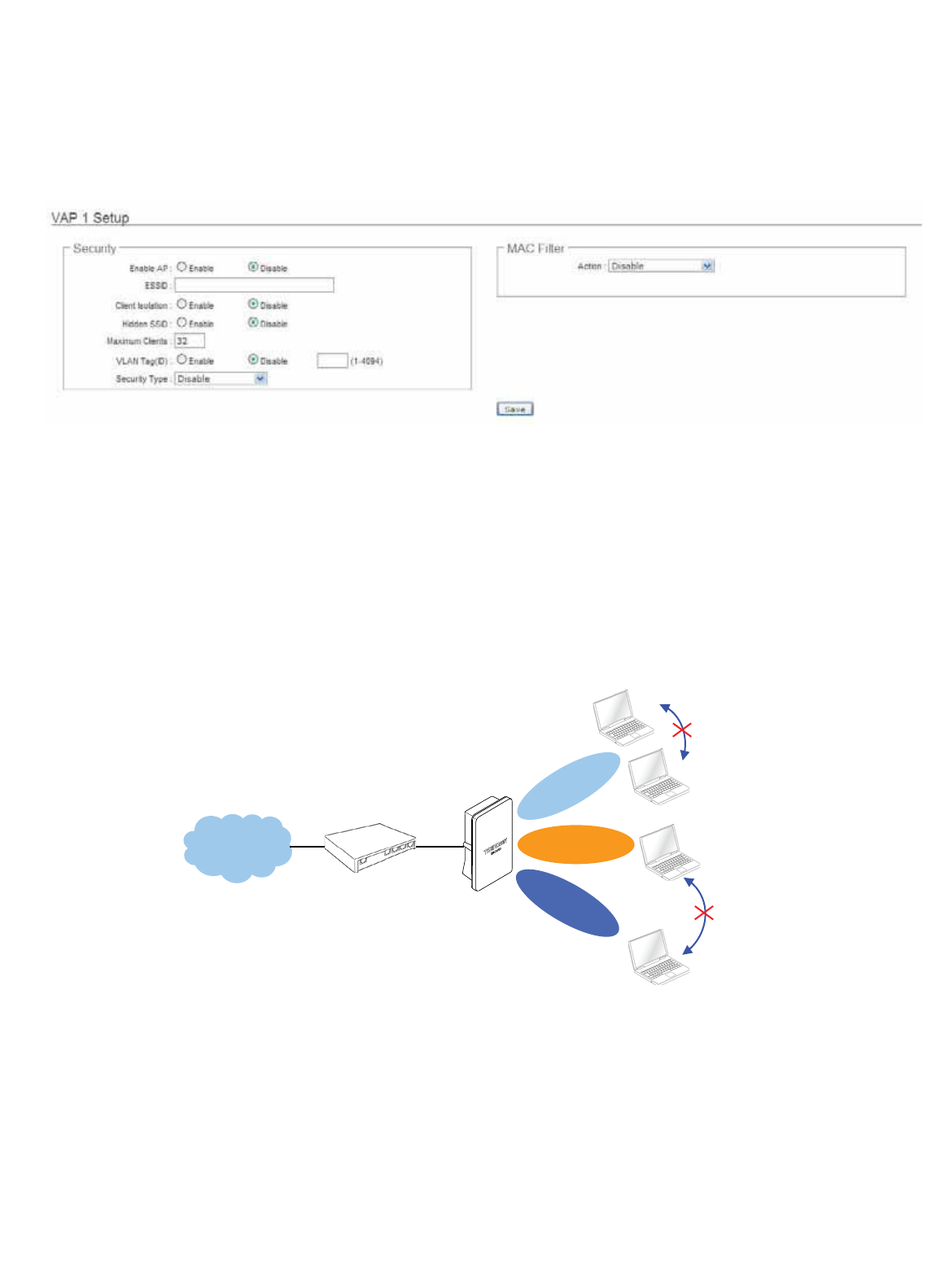
㻞㻞
Virtual AP Setup
For each Virtual AP, administrators can configure SSID, VLAN tag(ID), SSID broadcasting, Maximum number of client
associations, security type settings.
Click Edit button on the Edit column, and then a Virtual AP setup page appears.
Enable AP : By default, it’s “Disable” for VAP1 ~ VAP6. The Primary AP always enabled.
Select “Enable” to activate VAP or click “Disable” to deactivate this function
ESSID : Extended Service Set ID, When clients are browsing for available wireless networks, this is the SSID that
will appear in the list. ESSID will determine the service type available to AP's clients associated with the specified
VAP.
Client Isolation : Select Enable, all clients will be isolated from each other, that means all clients can not reach to
other clients. Below Figures depict Client Isolation and AP Isolation
Hidden SSID : By default, it’s “Disable”.
Enable this option to stop the SSID broadcast in your network. When disabled, people could easily obtain the SSID
information with the site survey software and get access to the network if security is not turned on. When enabled,
network security is enhanced. It’s suggested to enable it after AP security settings are archived and setting of AP
clients could make to associate to it.
Maximum Clients : The default value is 32. You can enter the number of wireless clients that can associate to a
particular SSID. When the number of client is set to 5, only 5 clients at most are allowed to connect to this VAP.
Internet
192.168.2.254
VAP1
VAP0
VAP2
Cllent Isolation
AP Isolation
TEW-676APBO
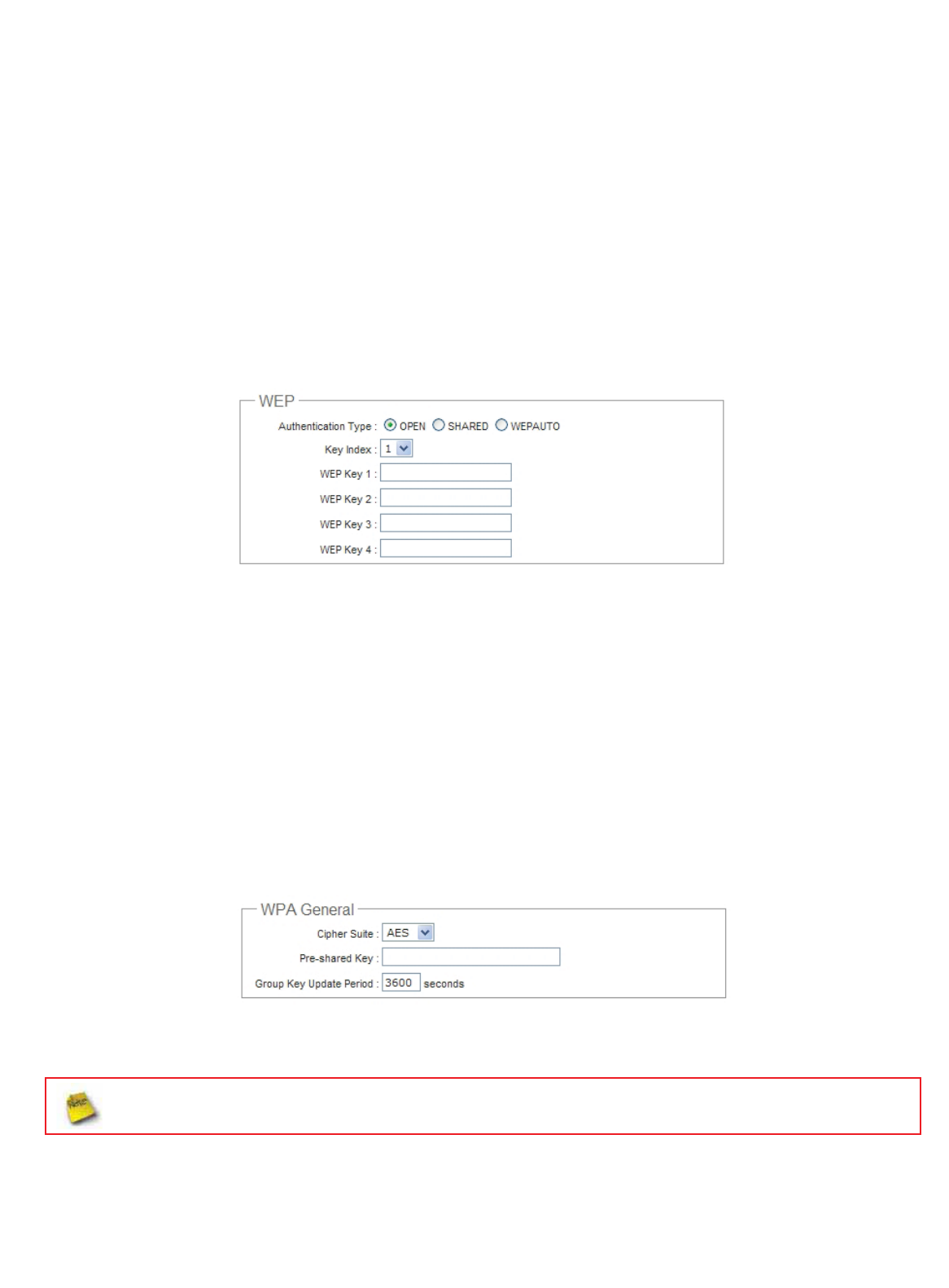
㻞㻟
VLAN Tag(ID) : By default, it’s selected “Disable”.
This system supports tagged Virtual LAN(VLAN). A valid number of 1to 4094 can be entered after it’s enabled. If
your network utilize VLANs you could tie a VLAN Tag to a specific SSID, and packets from/to wireless clients
belonging to that SSID will be tagged with that VLAN Tag. This enables security of wireless applications by applying
VLAN Tag.
Security Type : Select the desired security type from the drop-down list; the options are Disable,WEP,WPA-PSK,
WPA2-PSK,WPA-Enterprise,WPA2-Enterprise and WEP 802.1X.
ÎDisable : Data are unencrypted during transmission when this option is selected.
ÎWEP : Wired Equivalent Privacy(WEP) is a data encryption mechanism based on a 64-bit or 128-bit shared key.
Authentication Method : Enable the desire option among OPEN,SHARED or WEPAUTO.
ÎKey Index : Key index is used to designate the WEP key during data transmission. 4 different WEP keys can
be entered at the same time, but only one is chosen.
ÎWEP Key # : Enter HEX or ASCII format WEP key value; the system supports up to 4 sets of WEP keys.
Key Length Hex ASCII
64-bit 10 characters 5 characters
128-bit 26 characters 13 characters
ÎWPA-PSK (or WPA2-PSK) : WPA (or WPA2) Algorithms, allows the system accessing the network by using the
WPA-PSK protected access.
9Cipher Suite : By default, it is AES. Select either AES or TKIP cipher suites
9Pre-shared Key : Enter the pre-shared key; the format shall go with the selected key type.
Pre-shared key can be entered with either a 256-bit secret in 64 HEX digits format, or 8 to 63 ASCII characters.
9Group Key Update Period : By default, it is 3600 seconds. This time interval for rekeying GTK,
broadcast/multicast encryption keys, in seconds. Entering the time-length is required.
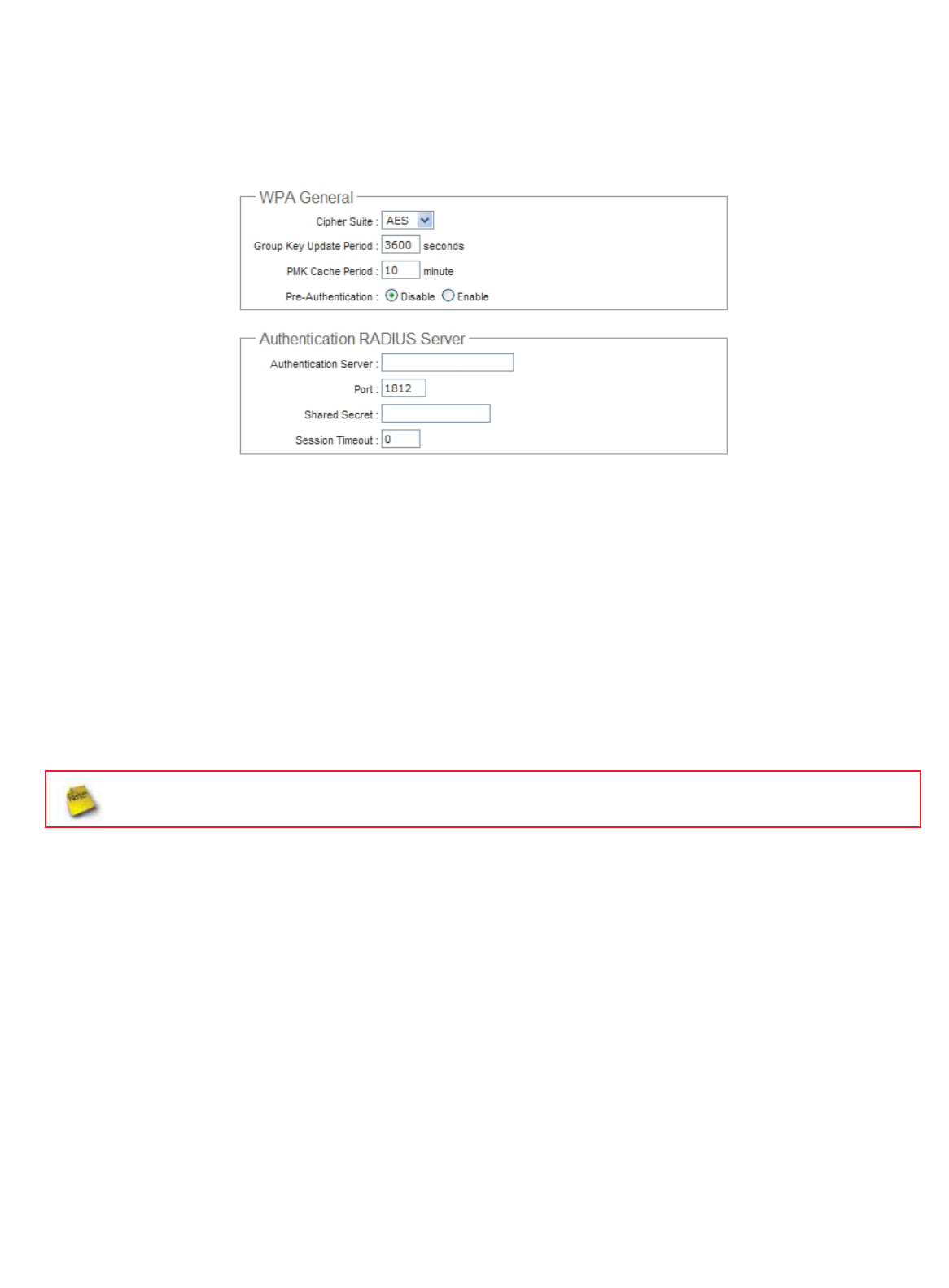
㻞㻠
ÎWPA-Enterprise (or WPA2-Enterprise): The RADIUS authentication and encryption will be both enabled if this
is selected.
9WPA General Settings :
xCipher Suite : By default, it is AES. Select either AES or TKIP cipher suites
xGroup Key Update Period : By default, it’s 3600 seconds. This time interval for rekeying GTK,
broadcast/multicast encryption keys, in seconds. Entering the time-length is required.
xPMK Cache Period : By default, it's 10 minutes. Set WPA2 PMKID cache timeout period, after time
out, the cached key will be deleted.
xPre-Authentication : By default, it's “Disable”. To Enable is use to speed up roaming before pre-
authenticating IEEE 802.1X/EAP part of the full RSN authentication and key handshake before actually
associating with a new AP.
PMK Cache Period and Pre-Authentication is used in WPA2-Enterprise
9Radius Server Settings :
xIP Address : Enter the IP address of the Authentication RADIUS server.
xPort : By default, it’s 1812. The port number used to communicate with RADIUS server.
xShared secret : A secret key used between system and RADIUS server. Supports 8to 64 characters.
xSession Timeout : The Session timeout is in the range of 0~60 seconds. The default is 0to disable
re-authenticate service.
Amount of time before a client will be required to re-authenticate.
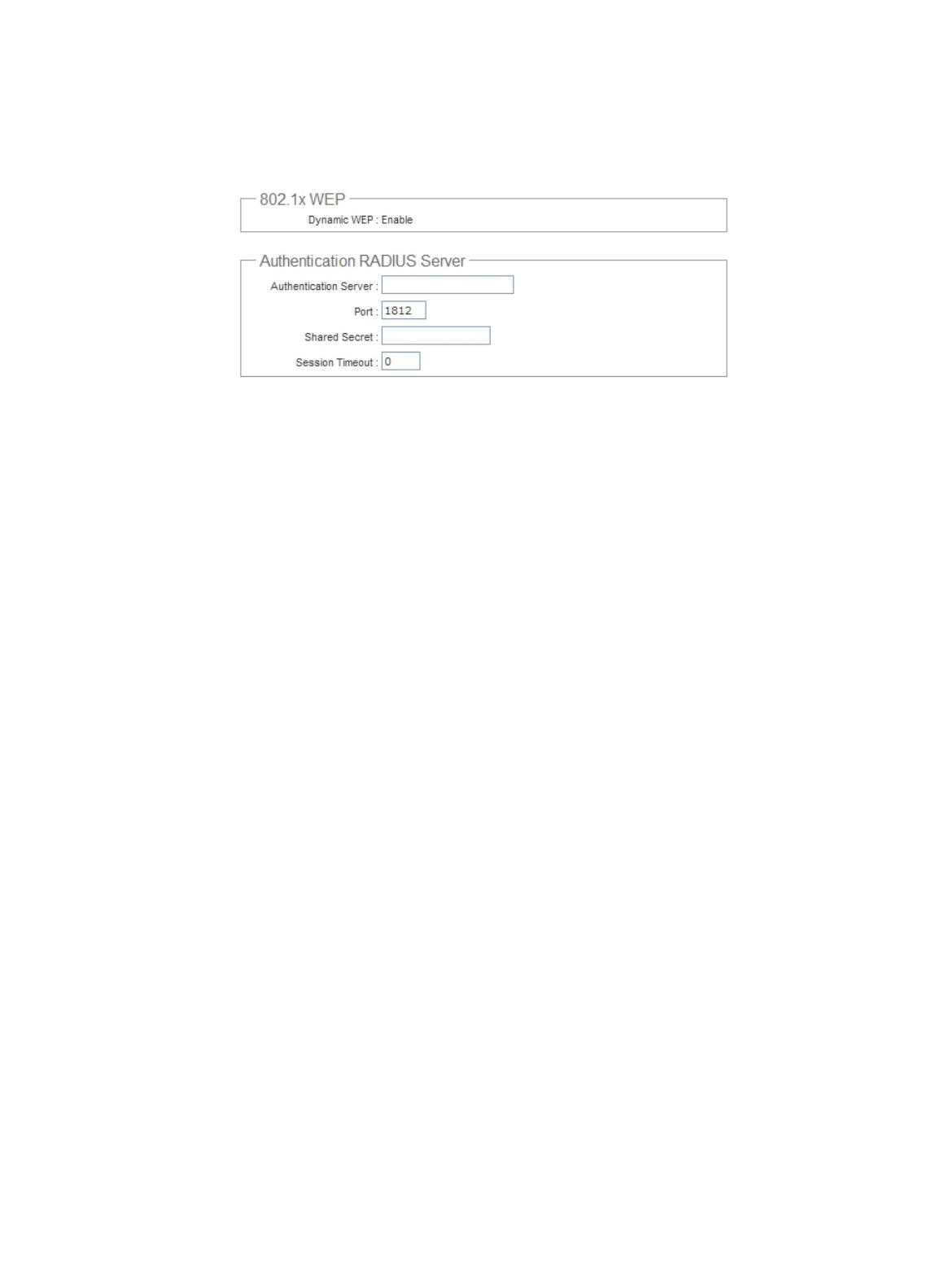
㻞㻡
ÎWEP 802.1X : When WEP 802.1x Authentication is enabled, please refer to the following Dynamic WEP and
RADIUS settings to complete configuration.
9Radius Server Settings :
xIP Address : Enter the IP address of the Authentication RADIUS server.
xPort : By default, it’s 1812. The port number used to communicate with RADIUS server.
xShared secret : A secret key used between system and RADIUS server. Supports 8to 64 characters.
xSession Timeout : The Session timeout is in the range of 0~60 seconds. The default is 0to disable
re-authenticate service.
Amount of time before a client will be required to re-authenticate.
Click Save button to save your changes. Click Reboot button to activate your changes
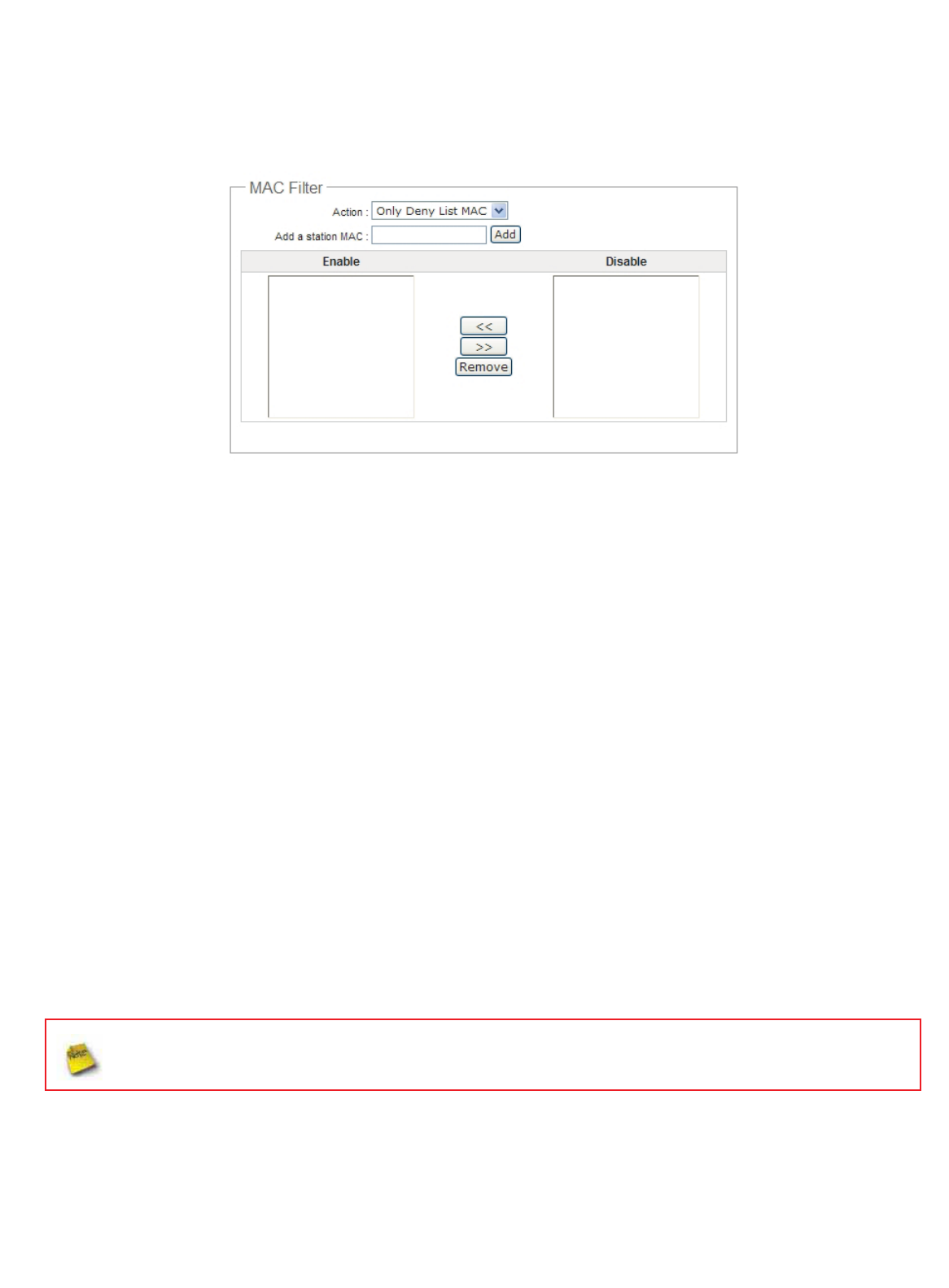
㻞㻢
Wireless MAC Filter Setup
Continue Virtual AP Setup section. For each Virtual AP setting, the administrator can allow or reject clients to access
each Virtual AP.
MAC Filter Setup : By default, it’s “Disable”. Options are Disable, Only Deny List MAC or Only Allow List MAC.
Two ways to set MAC filter rules :
ÎOnly Allow List MAC.
The wireless clients in the “Enable” list will be allowed to access the Access Point; All others or clients in the
“Disable” list will be denied.
ÎOnly Deny List MAC.
The wireless clients in the “Enable” list will be denied to access the Access Point; All others or clients in the
“Disable” list will be allowed.
Add a station MAC : Enter MAC address (e.g. aa:bb:cc:00:00:0a) and click “Add” button, then the MAC address
should display in the “Enable” List.
There are amaximumof20 clients allowed in this “Enable” List. The MAC addresses of the wireless clients can be added
and removed to the list using the Add and Remove buttons.
Click Reboot button to activate your changes
MAC Access Control is the weakest security approach. WPA and WPA2 security method is highly
recommended.
Wireless Network Expansion
The administrator could create WDS Links to expand wireless network. When WDS is enabled, access point functions as
a wireless bridge and is able to communicate with other access points via WDS links. A WDS link is bidirectional and
both side must support WDS. Access points know each other by MAC Address. In other words, each access
point needs to include MAC address of its peer. Ensure all access points are configured with the same channel
and own same security type settings.
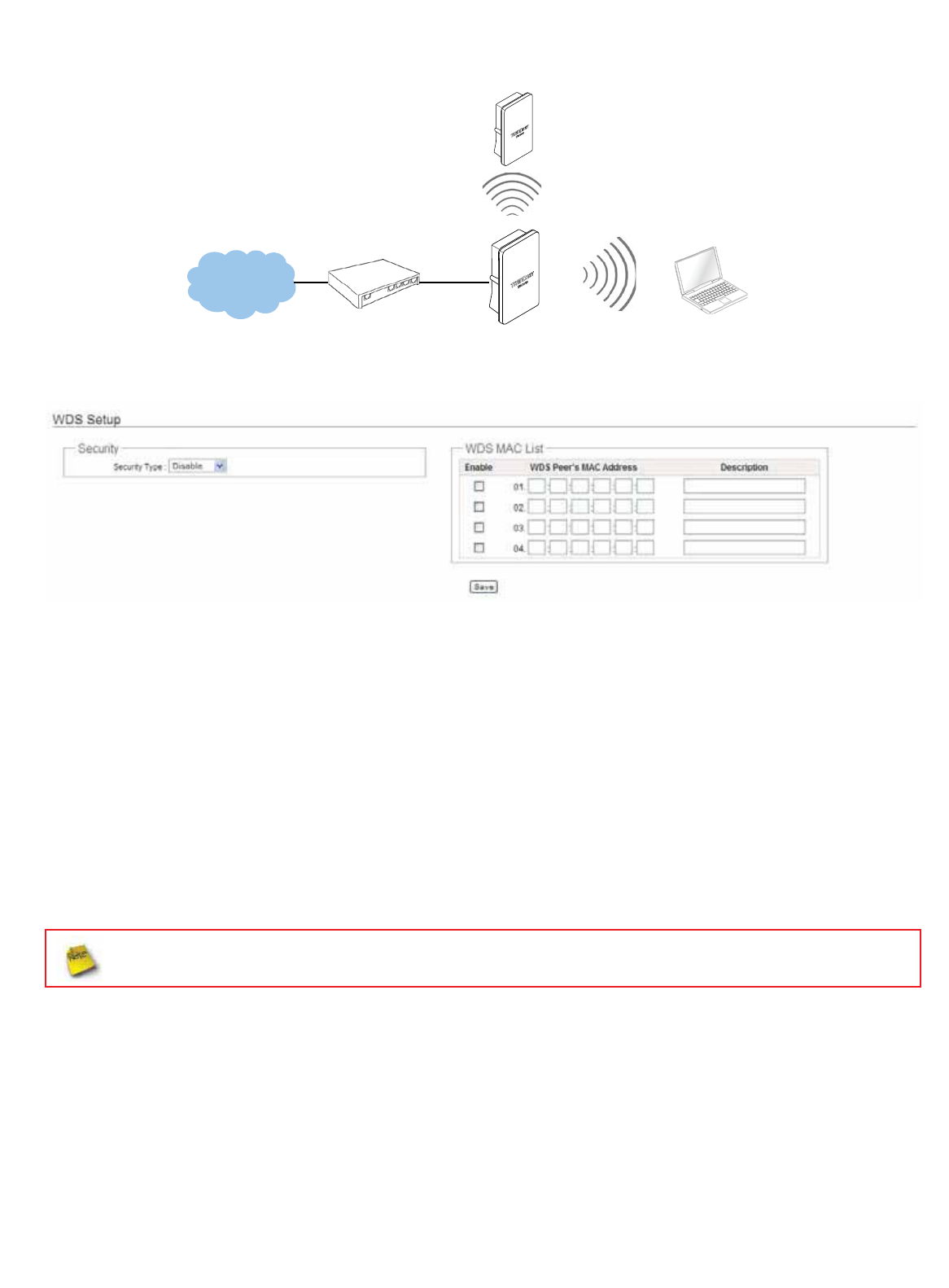
㻞㻣
Please click on Wireless -> WDS Setup and follow the below setting.
Security Type : Option is “Disable”, “WEP”, “TKIP”or “AES” from drop-down list. Needs the same type to build WDS
links. Security type takes effect when WDS is enabled.
ÎWEP Key : Enter 5 / 13 ASCII or 10 / 26 HEX format WEP key.
ÎTKIP Key : Enter 8to 63 ASCII or 64 HEX format TKIP key.
ÎAES Key : Enter 8to 63 ASCII or 64 HEX format AES key.
WDS MAC List
ÎEnable : Click Enable to create WDS link.
ÎWDS Peer's MAC Address : Enter the MAC address of WDS peer.
ÎDescription : Description of WDS link.
The WDS link needs to be set at same Channel and with same Security Type.
Click Save button to save your changes. Click Reboot button to activate your changes
Internet
192.168.2.10
192.168.2.254
WDS
Remote Bass Station
192.168.2.250
SSID: Main
_
AP
TEW-676APBO
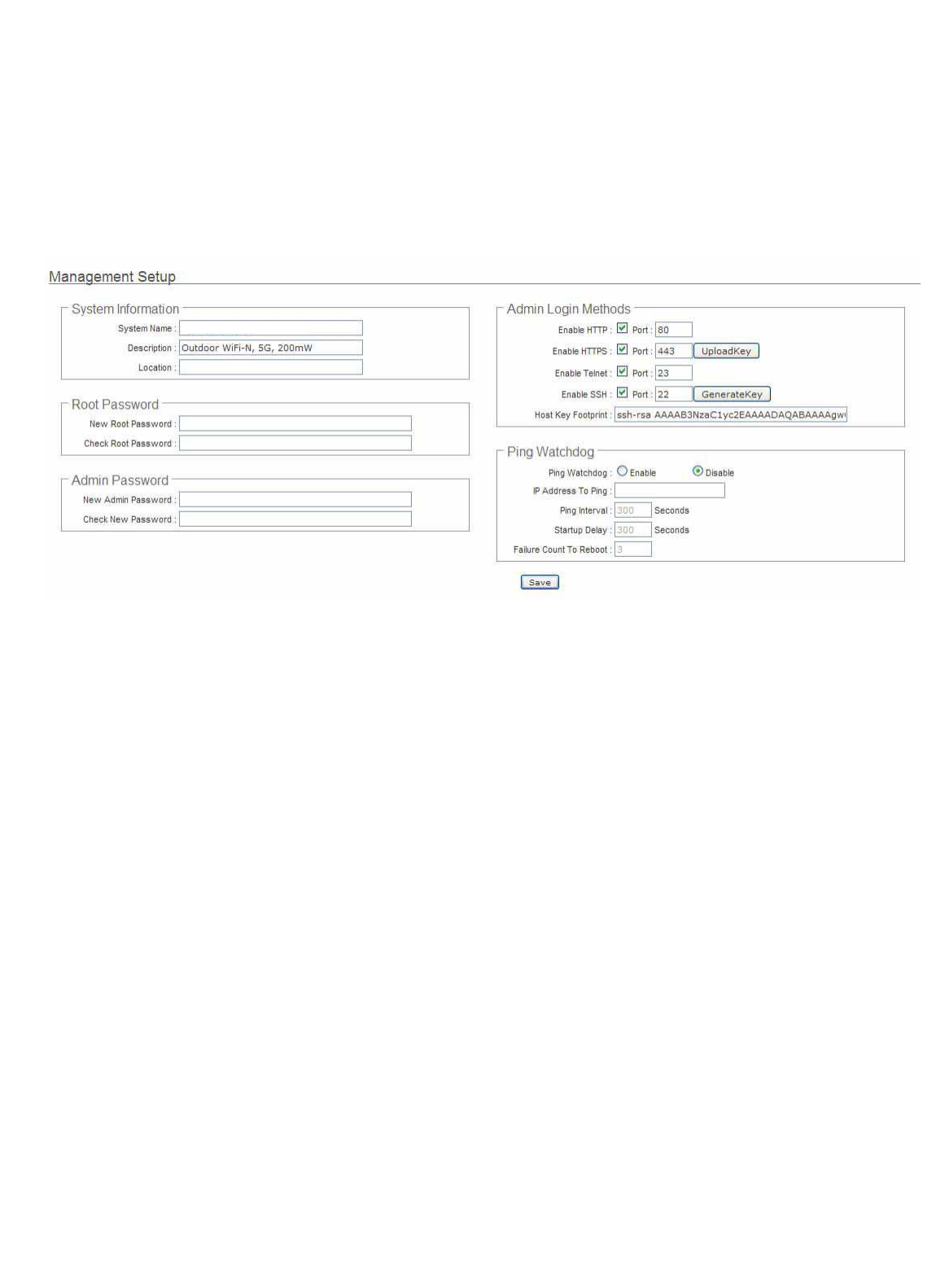
㻞㻤
SystemManagement
Configure Management
Administrator could specify geographical location of the system via instructions in this page. Administrator could also
enter new Root and Admin passwords and allow multiple login methods.
Please click System -> Management and follow the below settings.
System Information
ÎSystem Name : Enter a desired name or use the default one.
ÎDescription : Provide description of the system.
ÎLocation : Enter geographical location information of the system. It helps administrator to locate the system
easier.
The system supports two management accounts, root and admin. The network manager is assigned with full
administrative privileges, when logging in as root user, to manage the system in all aspects. While logging in as an
admin user, only subset of privileges is granted such as basic maintenance. For example, root user can change
passwords for both root and admin account, and admin user can only manage its own. For more information about
covered privileges for these two accounts, please refer to Appendix D. Network manager Privileges.
Root Password : Log in as a root user and is allowed to change its own, plus admin user’s password.
ÎNew Password : Enter a new password if desired
ÎCheck New Password : Enter the same new password again to check.
Admin Password : Log in as a admin user and is allowed to change its own,
ÎNew Password : Enter a new password if desired
ÎCheck New Password : Enter the same new password again to check.
/TEW-676APBO

㻞㻥
Admin Login Methods : Only root user can enable or disable system login methods and change services port.
ÎEnable HTTP : Check to select HTTP Service.
ÎHTTP Port : The default is 80 and the range is between 1 ~ 65535.
ÎEnable HTTPS : Check to select HTTPS Service
ÎHTTPS Port : The default is 443 and the range is between 1 ~ 65535.
If you already have an SSL Certificate, please click “UploadKey” button to select the file and upload it.
ÎEnable Telnet : Check to select Telnet Service
ÎTelnet Port : The default is 23 and the range is between 1 ~ 65535.
ÎEnable SSH : Check to select SSH Service
ÎSSH Port : Please The default is 22 and the range is between 1 ~ 65535.
Click “GenerateKey” button to generate RSA private key. The “host key footprint” gray blank will display
content of RSA key.
Ping Watchdog : The ping watchdog sets the TEW-676APBO Device to continuously ping a user defined IP address
(it can be the internet gateway for example). If it is unable to ping under the user defined constraints, the TEW-
676APBO device will automatically reboot. This option creates a kind of "fail-proof" mechanism.
Ping Watchdog is dedicated for continuous monitoring of the particular connection to remote host using the Ping tool.
The Ping works by sending ICMP “echo request” packets to the target host and listening for ICMP “echo response”
replies. If the defined number of replies is not received, the tool reboots the device.
ÎEnable Ping Watchdog : control will enable Ping Watchdog Tool.
ÎIP Address To Ping : specify an IP address of the target host which will be monitored by Ping Watchdog Tool.
ÎPing Interval : specify time interval (in seconds) between the ICMP “echo requests” are sent by the Ping
Watchdog Tool. Default is 300 seconds.
ÎStartup Delay : specify initial time delay (in seconds) until first ICMP “echo requests” are sent by the Ping
Watchdog Tool. The value of Startup Delay should be at least 60 seconds as the network interface and wireless
connection initialization takes considerable amount of time if the device is rebooted. Default is 300 seconds.
ÎFailure Count To Reboot : specify the number of ICMP “echo response” replies. If the specified number of
ICMP “echo response” packets is not received continuously, the Ping Watchdog Tool will reboot the device.
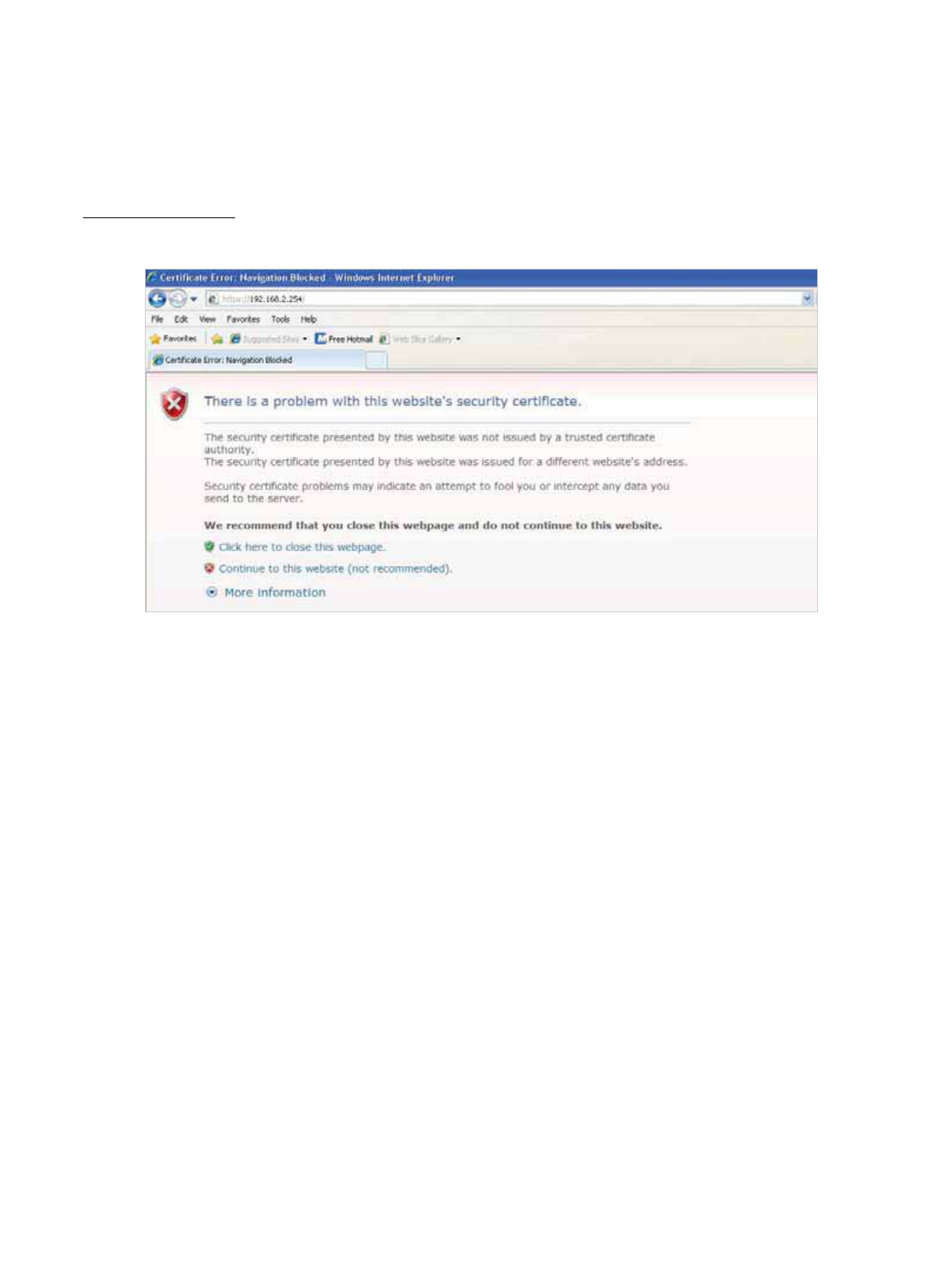
㻟㻜
Click Save button to save your changes. Click Reboot button to activate your changes
Without a valid certificate, users may encounter the following problem in IE7 when they try to access system's WMI
(https://192.168.2.254). There will be a “Certificate Error”, because the browser treats system as an illegal website.
Click “Continue to this website” to access the system's WMI. The system's Overview page will appear.
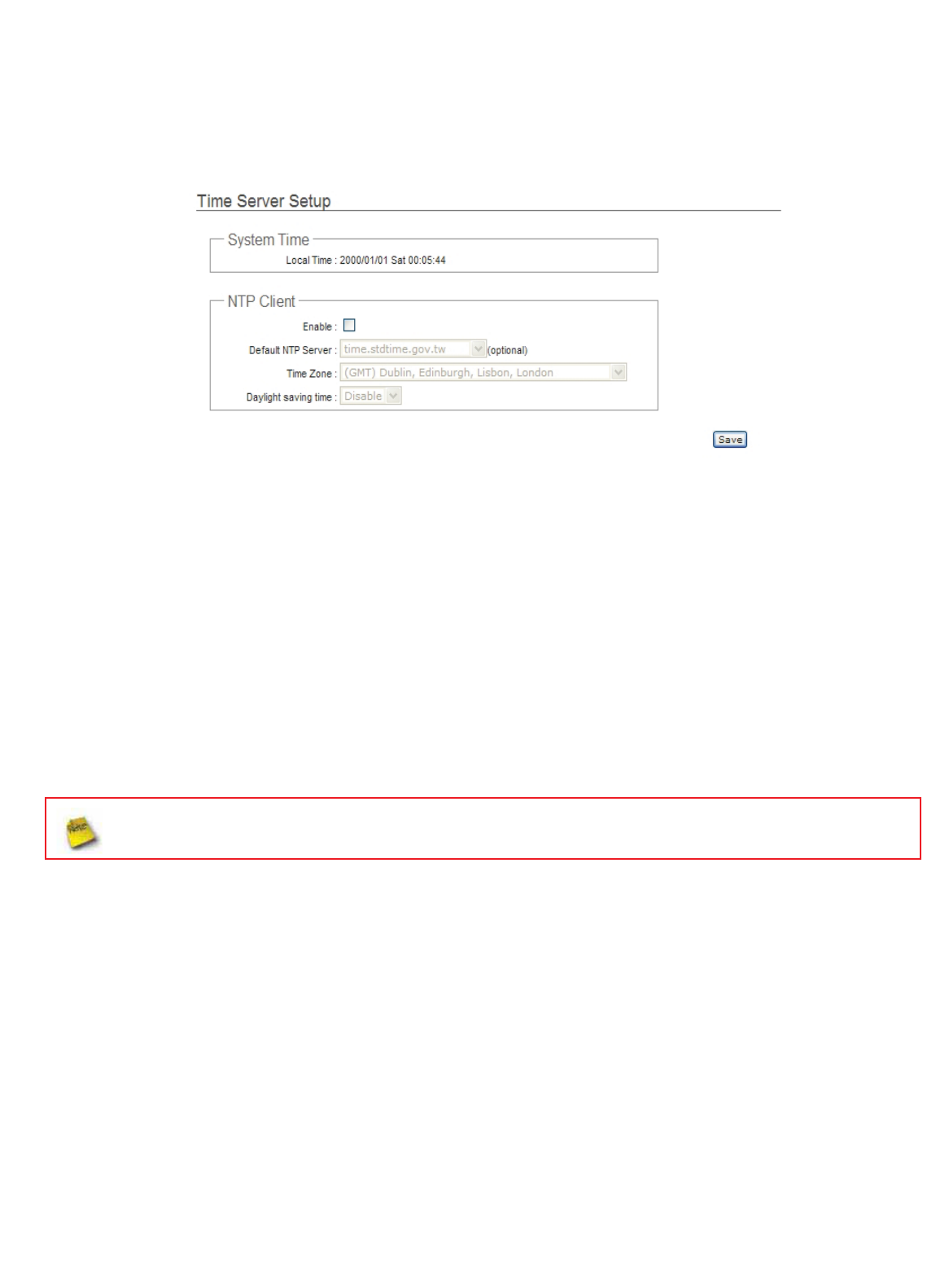
㻟㻝
Configure System Time
System time can be configured via this page, and manual setting or via a NTP server is supported.
Please click on System -> Time Server and follow the below setting.
Local Time : Display the current system time.
NTP Client : To synchronize the system time with NTP server.
ÎEnable : Check to select NTP client.
ÎDefault NTP Server : Select the NTP Server from the drop-down list.
ÎTime Zone : Select a desired time zone from the drop-down list.
ÎDaylight saving time : Enable or disable Daylight saving.
If the system time from NTP server seems incorrect, please verify your network settings, like default Gateway
and DNS settings
Click Save button to save your changes. Click Reboot button to activate your changes
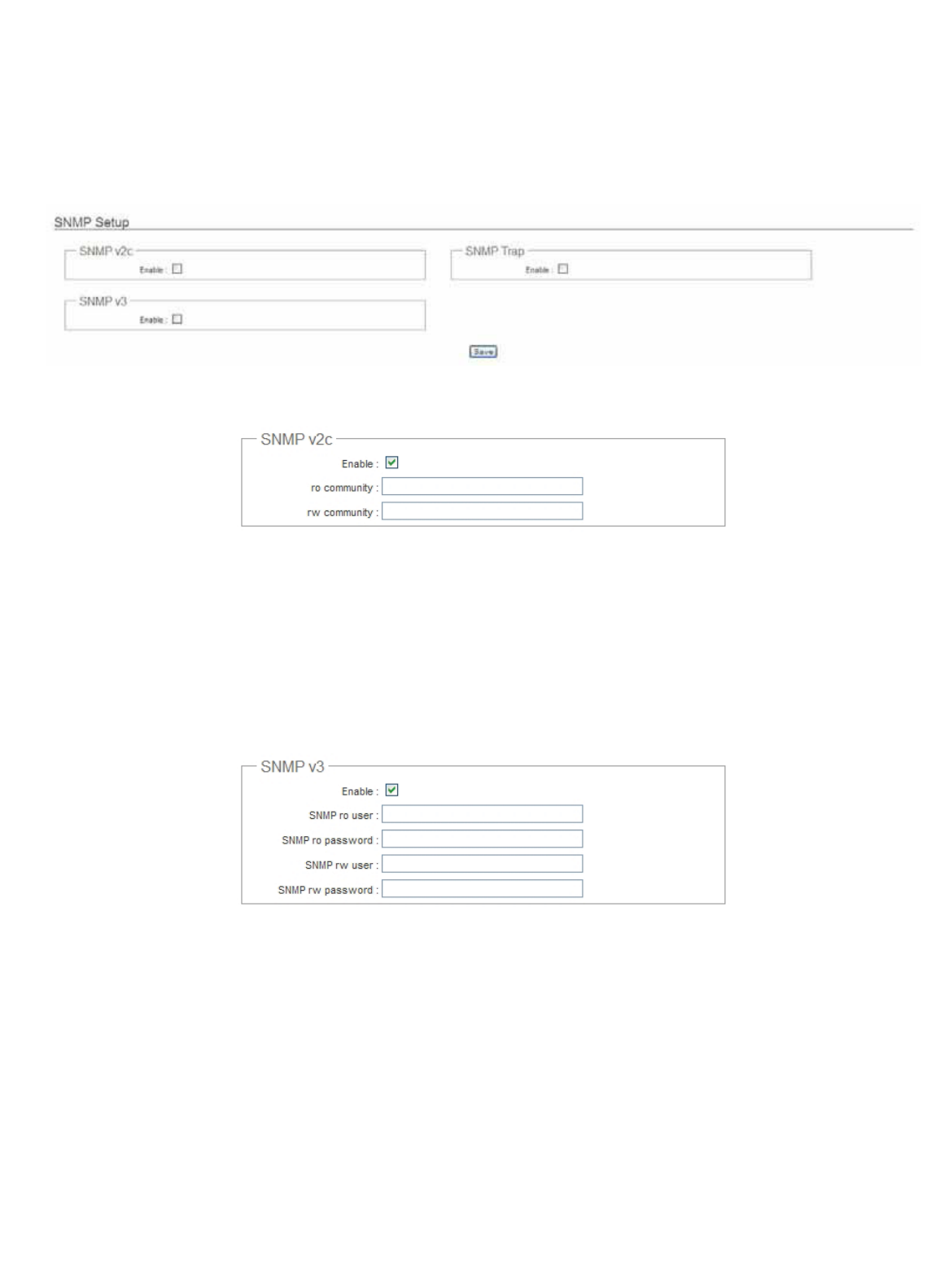
㻟㻞
Configure SNMP Setup
SNMP is an application-layer protocol that provides a message format for communication between SNMP manager and
agent. By enabling SNMP function, the administrator can obtain the system information remotely.
Please click on System -> SNMP Setup and follow the below setting.
SNMP v2c Enable: Check to enable SNMP v2c.
Îro community : Set a community string to authorize read-only access.
Îrw community : Set a community string to authorize read/write access.
SNMP v3 Enable: Check to enable SNMP v3.
SNMPv3 supports the highest level SNMP security.
ÎSNMP ro user : Set a community string to authorize read-only access.
ÎSNMP ro password : Set a password to authorize read-only access.
ÎSNMP rw user : Set a community string to authorize read/write access.
ÎSNMP rw password : Set a password to authorize read/write access.

㻟㻟
SNMP Trap : Events such as cold start, interface up & down, and association & disassociation will report to an
assigned server.
ÎCommunity : Set a community string required by the remote host computer that will receive trap messages or
notices send by the system.
ÎIP : Enter the IP addresses of the remote hosts to receive trap messages.
Click Save button to save changes and click Reboot button to activate.
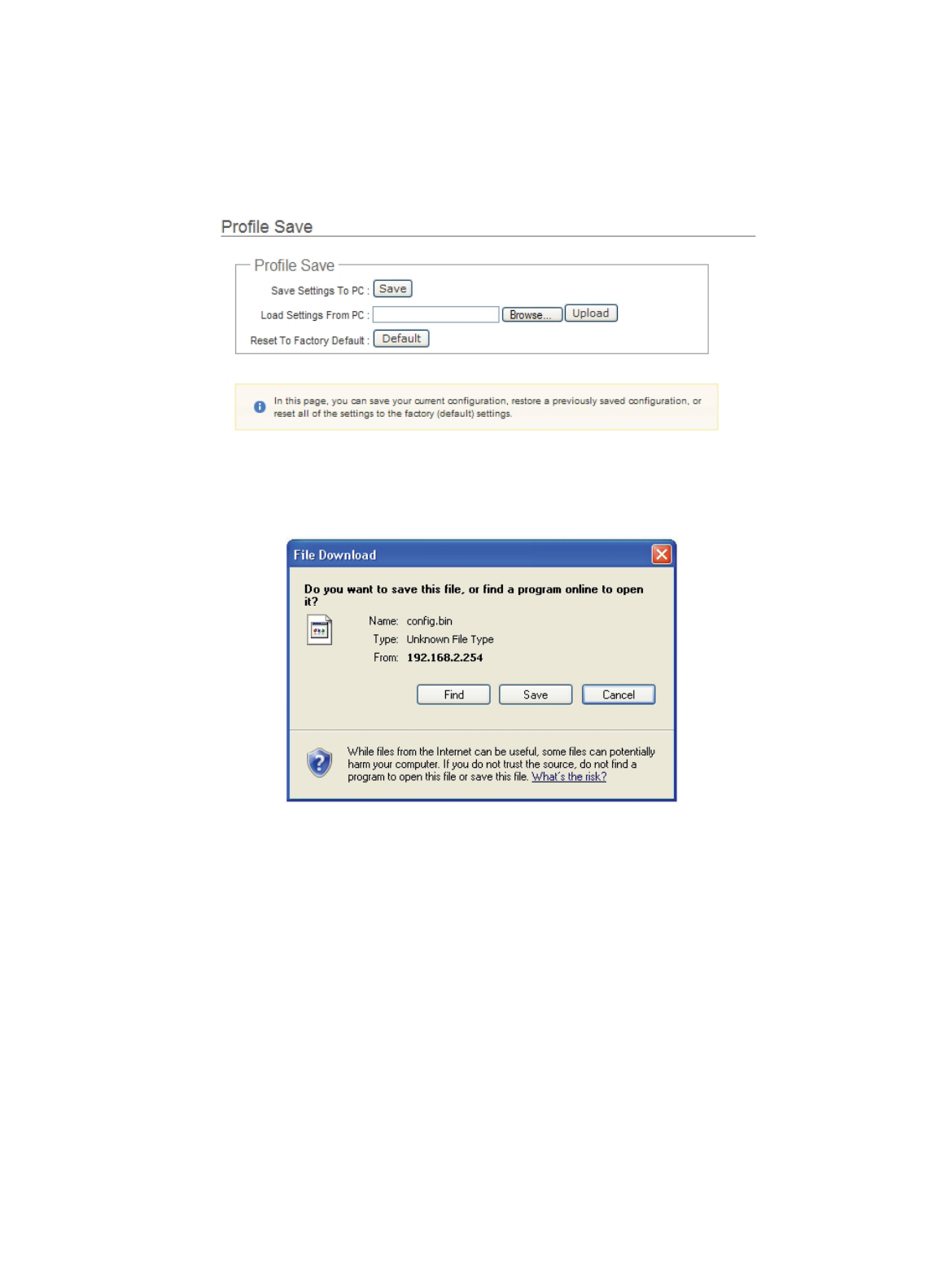
㻟㻠
Backup / Restore and Reset to Factory
Backup current configuration, restore prior configuration or reset back to factory default configuration can be executed via
this page.
Please click on Utilities -> Profile Setting and follow the below setting.
Save Settings To PC : Click Save button to save the current configuration to a local disk.
Load Settings from PC : Click Browse button to locate a configuration file to restore, and then click Upload button
to upload.
Reset To Factory Default : Click Default button to reset back to the factory default settings and expect Successful
loading message.Then, click Reboot button to activate.
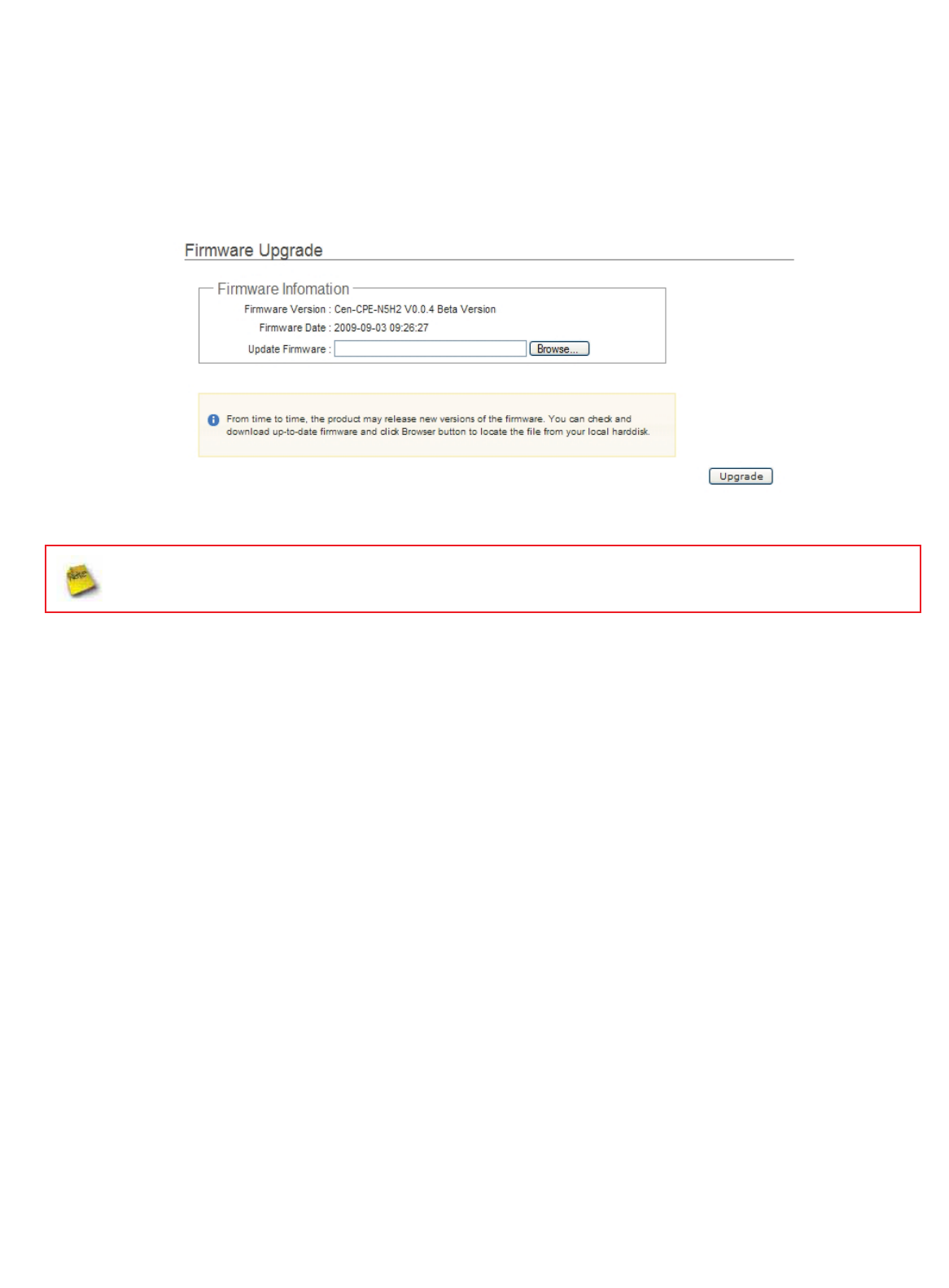
㻟㻡
Firmware Upgrade
Firmware is the main software image that system needs to respond to requests and to manage real time operations.
Firmware upgrades are sometimes required to include new features or bugs fix. It takes around 2minutes to upgrade
due to complexity of firmware. To upgrade system firmware, click Browse button to locate the new firmware, and then
click Upgrade button to upgrade.
1. To prevent data loss during firmware upgrade, please back up current settings before proceeding
2. Do not interrupt during firmware upgrade including power on/off as this may damage system.
3. Never perform firmware upgrade over wireless connection or via remote access connection.

㻟㻢
Network Utility
The administrator can diagnose network connectivity via the PING or TRACEROUTE utility.
Please click on Utilities -> Network Utility and follow the below setting.
Ping : This utility will help ping other devices on the network to verify connectivity. Ping utility, using ICMP packets,
detects connectivity and latency between two network nodes. As result of that, packet loss and latency time are
available in the Result field while running the PING test.
ÎDestination IP/Domain : Enter desired domain name, i.e. www.google.com,or IP address of the destination,
and click ping button to proceed. The ping result will be shown in the Result field.
ÎCount : By default, it’s 5 and the range is from 1 to 50. It indicates number of connectivity test.
Traceroute : Allows tracing the hops from the TEW-676APBO device to a selected outgoing IP address. It should be
used for the finding the route taken by ICMP packets across the network to the destination host. The test is started
using the Start button, click Stop button to stopped test
ÎDestination Host : Specifies the Destination Host for the finding the route taken by ICMP packets across the
network.
ÎMAX Hop : Specifies the maximum number of hops( max time-to-live value) traceroute will probe.
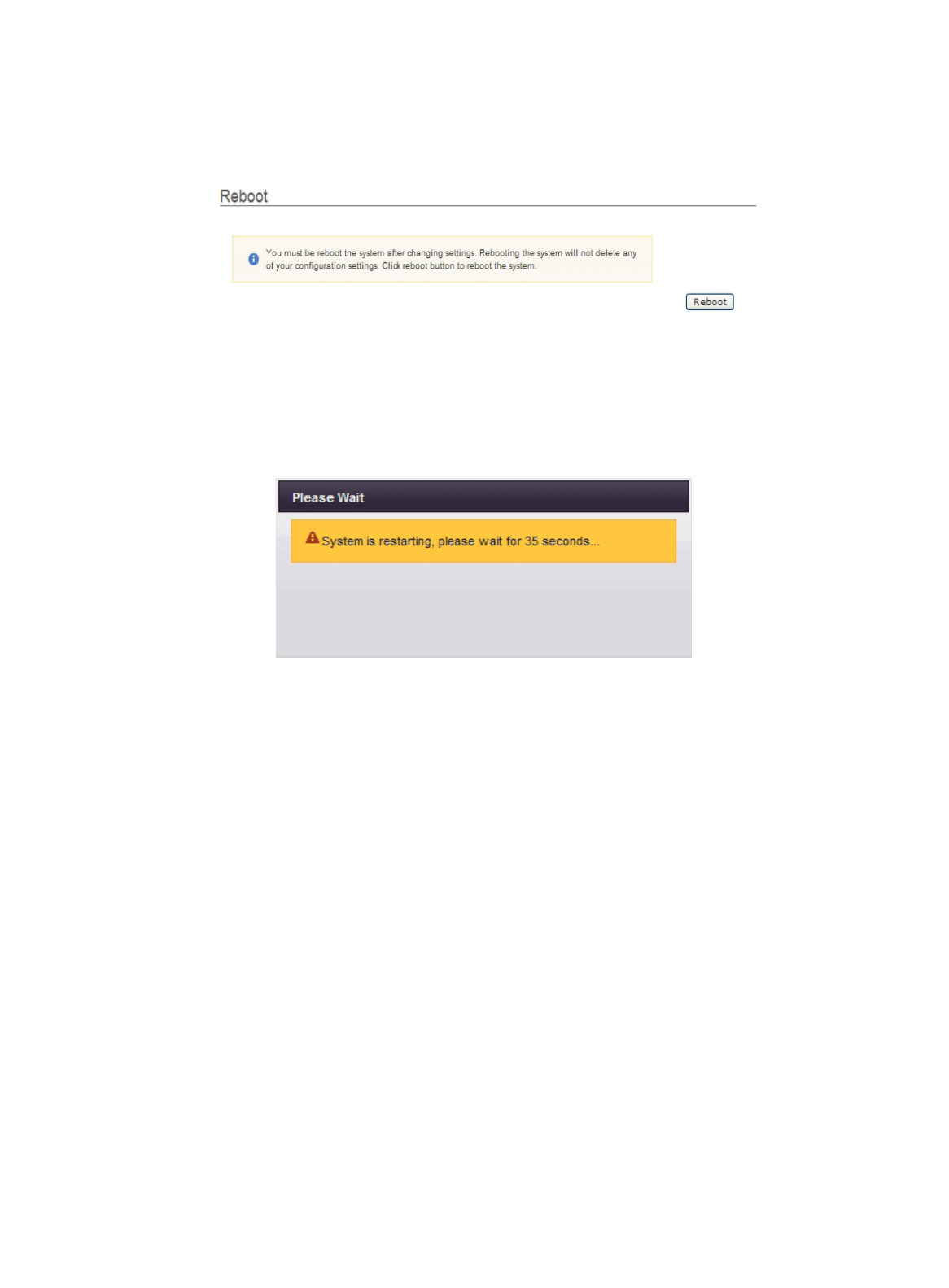
㻟㻣
Reboot
This function allows user to restart system with existing or most current settings when changes are made. Click Reboot
button to proceed and take around three minutes to complete.
A reminder will be available for remaining time to complete. If power cycle is necessary, please wait till completion of the
reboot process.
The System Overview page appears upon the completion of reboot.
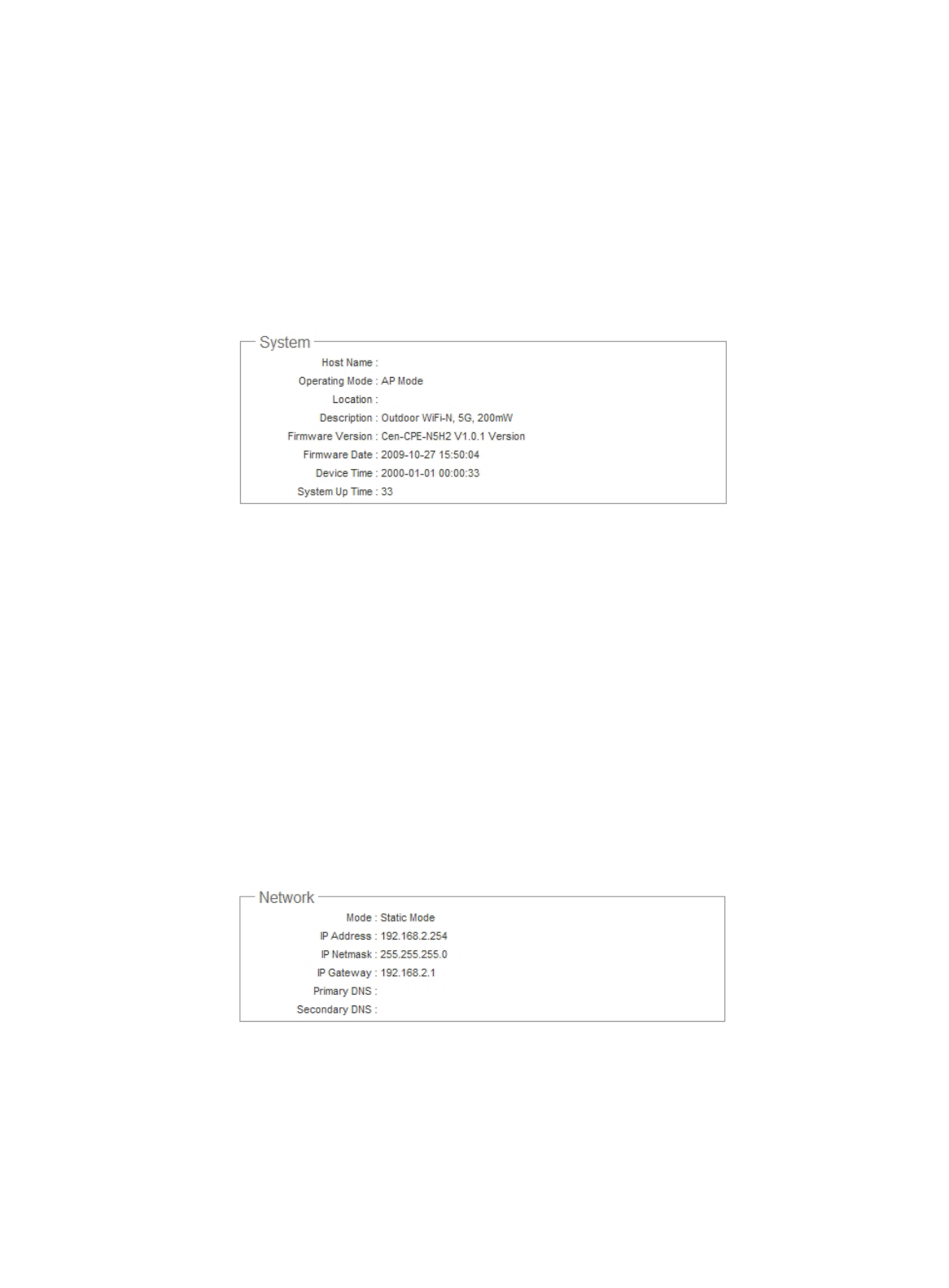
㻟㻤
System Status
This section breaks down into subsections of System Overview,Associated Clients Status,WDS Link Status,Extra
Information and Event Log.
System Overview
Display detailed information of System, Network, LAN and Wireless in the System Overview page.
System : Display the information of the system.
ÎSystem Name : The name of the system.
ÎOperating Mode : The mode currently in service.
ÎLocation : Deployed geographical location.
ÎDescription : A description of the system.
ÎFirmware Version : The current installed firmware version.
ÎFirmware Date : The build time of installed firmware.
ÎDevice Time : The current time of the system.
ÎSystem Up Time : The time period that system has been in service since last reboot.
Network Information : Supports Static or Dynamic modes on the LAN interface.
ÎIP Address : The management IP of system. By default, it’s 192.168.2.254.
ÎIP Netmask : The network mask. By default, it’s 255.255.255.0.
ÎIP Gateway : The gateway IP address and by default, it’s 192.168.2.1.
ÎPrimary DNS : The primary DNS server in service.
ÎSecondary DNS : The secondary DNS server in service.
TEW-676APBO
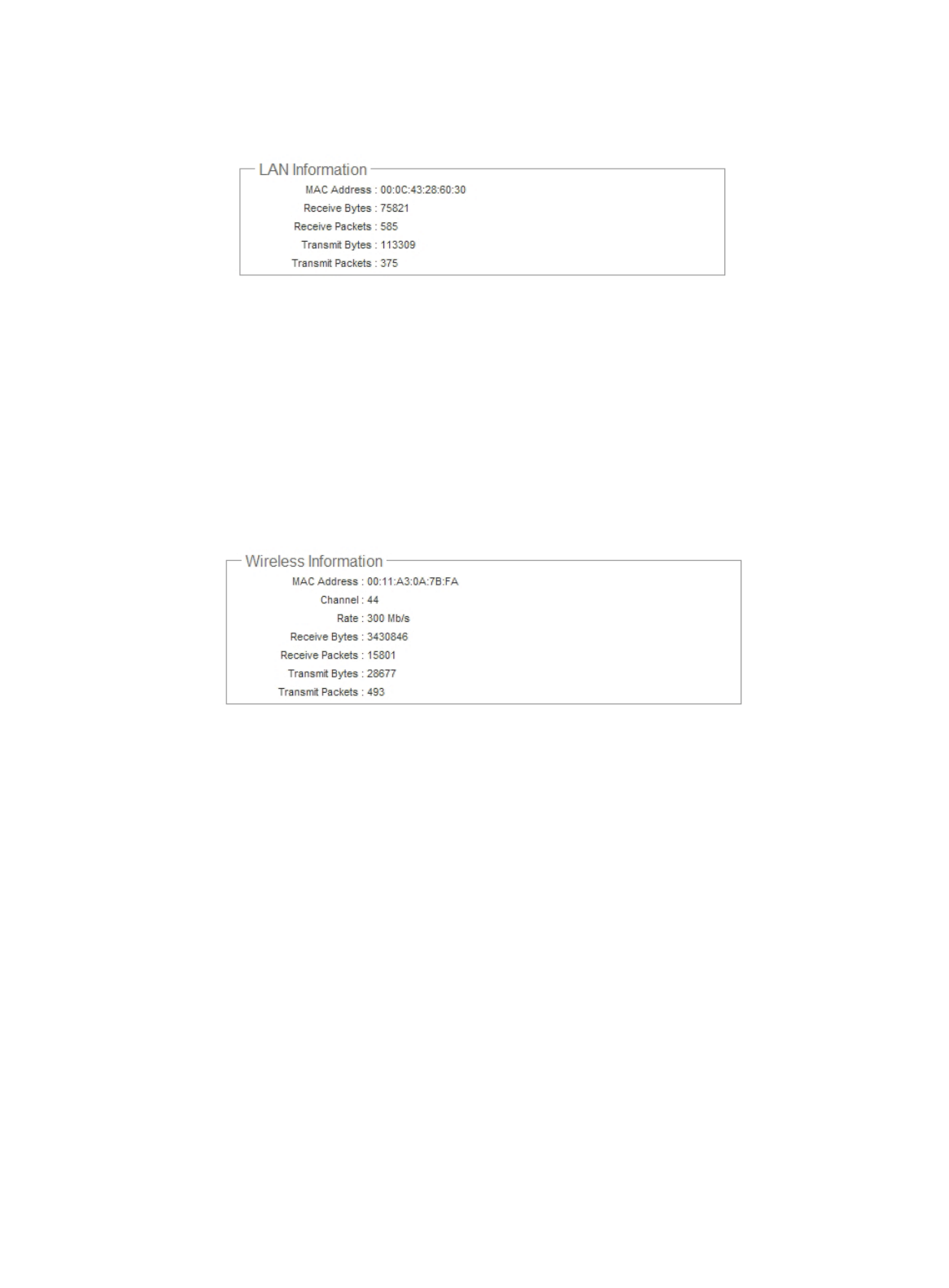
㻟㻥
LAN Information : Display total received and transmitted statistics on the LAN interface.
ÎMAC Address : The MAC address of the LAN port.
ÎReceive bytes : The total received packets in bytes on the LAN port.
ÎReceive packets : The total received packets of the LAN port.
ÎTransmit bytes : The total transmitted packets in bytes of the LAN port.
ÎTransmit packets : The total transmitted packets of the LAN port.
Wireless Information : Display total received and transmitted statistics on available Virtual AP.
ÎMAC Address : The MAC address of the Wireless port.
ÎChannel : The current channel on the Wireless port.
ÎRate : The current Bit Rate on the Wireless port.
ÎReceive bytes : The total received packets in bytes on the Wireless port.
ÎReceive packets : The total received packets on the Wireless port.
ÎTransmit bytes : The total transmitted packets in bytes on the Wireless port.
ÎTransmit packets : The total transmitted packets on the Wireless port.

㻠㻜
Associated Clients Status
It displays ESSID, on/off Status, Security Type, total number of wireless clients associated with all Virtual AP.
VAP Information : Highlights key VAP information.
ÎVAP : Available VAP from Primary AP to VAP6.
ÎESSID : Display name of ESSID for each VAP.
ÎMAC Address : Display MAC address for each VAP.
ÎStatus : On/Off
ÎSecurity Type : Display chosen security type; WEP, WPA/WPA2-PSK, WPA/WPA2-Enterprise.
ÎClients : Display total number of wireless connections for each VAP.
VAP Clients : Display all associated clients on each Virtual AP.
ÎMAC Address : MAC address of associated clients
ÎSignal Strength ANT0/ANT1 : Signal Strength of from associated clients.
ÎBandwidth : Channel bandwidth of from associated clients
ÎIdle Time : Last inactive time period in seconds for a wireless connection.
ÎConnect Time : Total connection time period in seconds for a wireless connection.
ÎDisconnect : Click “Delete” button to manually disconnect a wireless client in a Virtual AP.
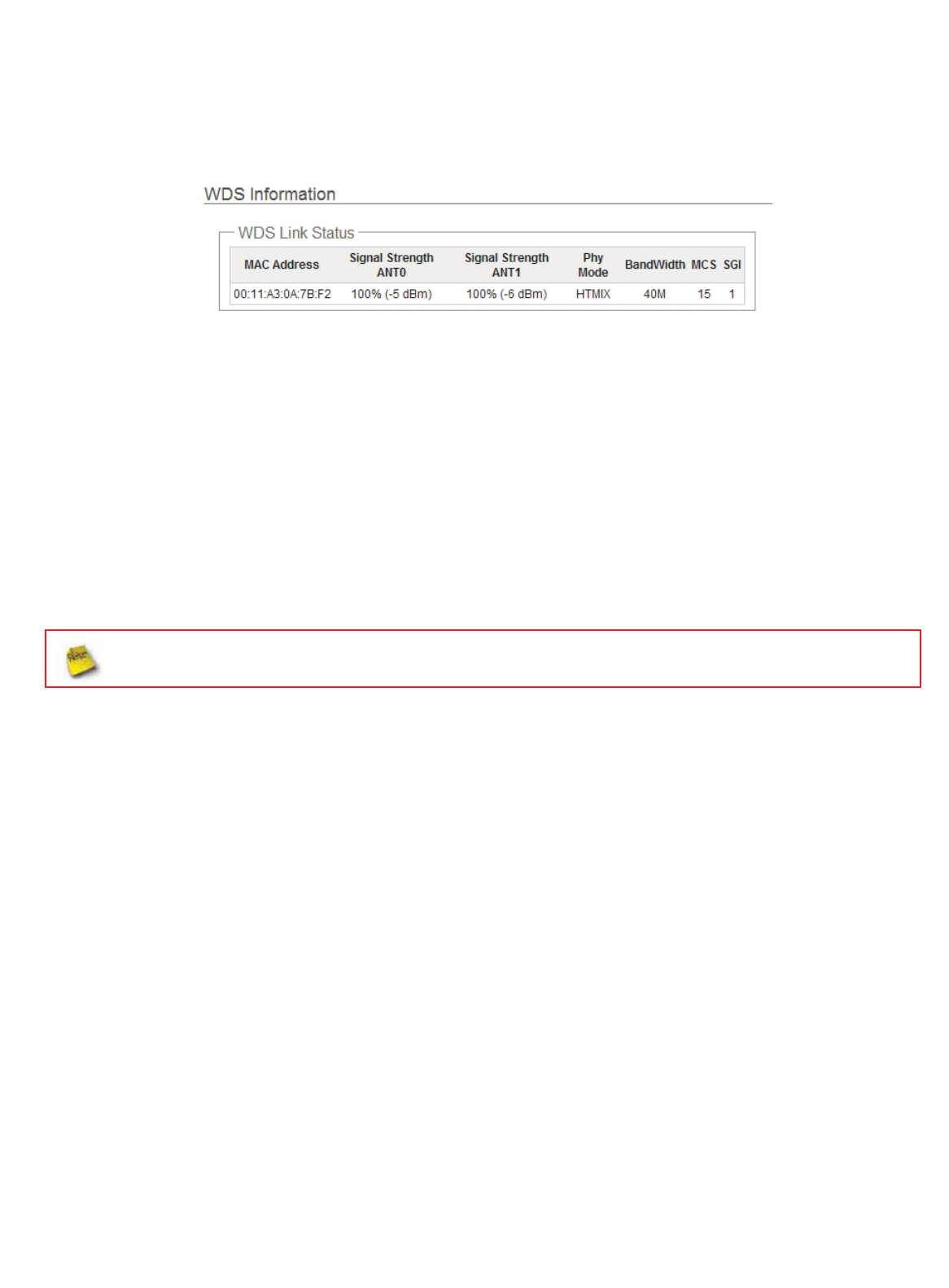
㻠㻝
Show WDS Link Status
Peers MAC Address, antenna 0/1 received signal strength, phy mode and channel bandwidth for each WDS are
available.
MAC Address : Display MAC address of WDS peer.
Signal Strength ANT0/ANT1 : Indicate the signal strength of the respective WDS links.
Phy Mode : Indicate the phy mode of the respective WDS linked.
BandWidth : Indicate the channel bandwidth of the respective WDS linked.
MCS : Indicate the MCS of the respective WDS linked.
SGI : Indicate the SGI (Short Guard Interval) of the respective WDS linked. “1” indicate the Short Guard Interval, “0”
indicate the Long Guard Interval.
If display “no signal” Signal Strength ANT0/ANT1, you need check WDS configuration. Things to verify are
MAC Address,Channel and Security type. Also,adjust antenna angle and Tx Power.
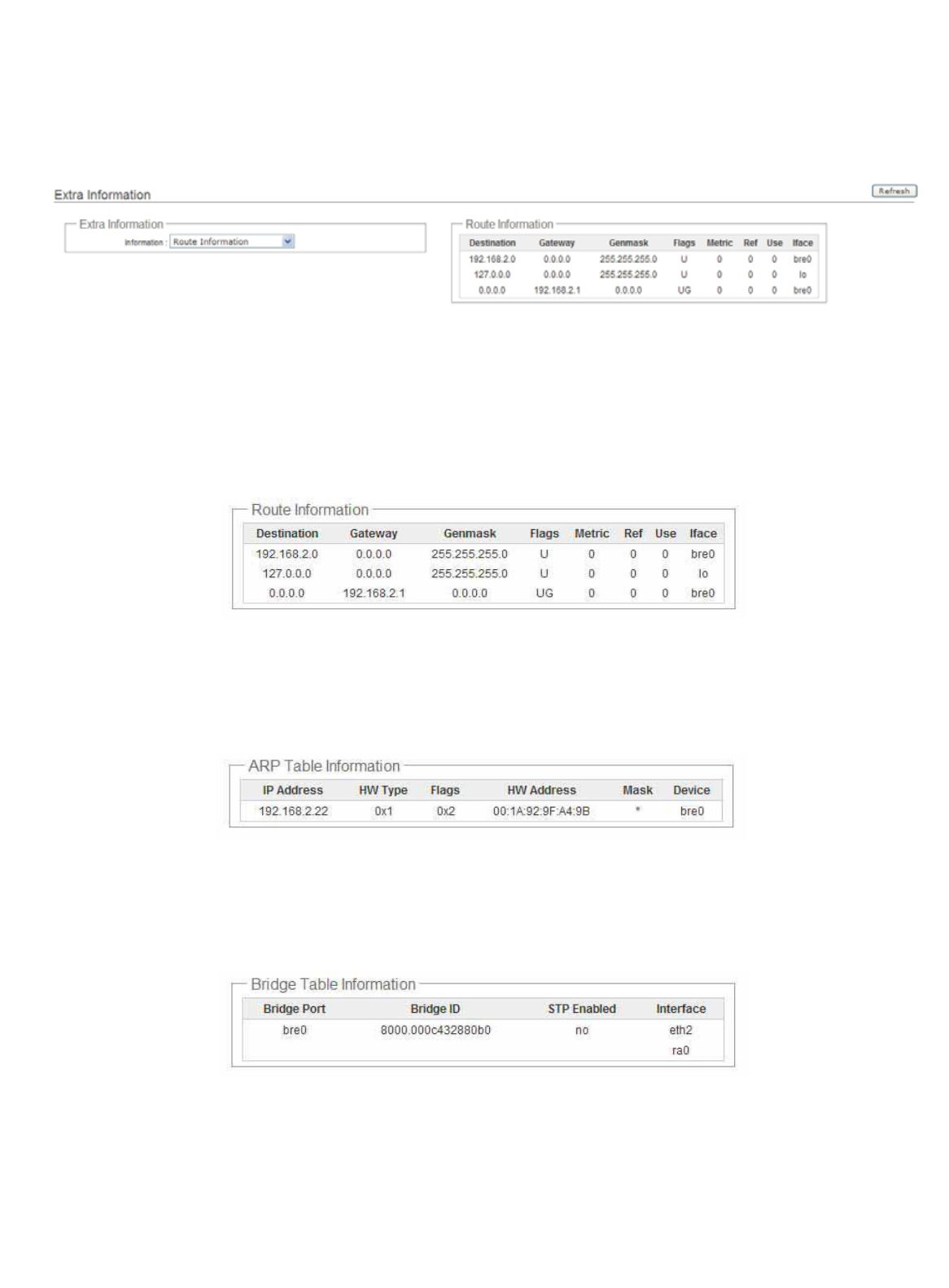
㻠㻞
Extra Information
Users could pull out information such as Route table, ARP table, MAC table, Bridge table or STP available in the drop-
down list from system. The “Refresh” button is used to retrieve latest table information.
Route table information : Select “Route table information” on the drop-down list to display route table.
TEW-676APBO could be used asa L2 or L3 device. It doesn’t support dynamic routing protocols such as RIP or
OSPF. Static routes to specific hosts, networks or default gateway are set up automatically according to the IP
configuration of system's interfaces. When used as a L2 device, it could switch packets and, as L3 device, it’s
capable of being a gateway to route packets inward and outward.
ARP table Information : Select “ARP Table Information” on the drop-down list to display ARP table.
ARP associates each IP address to a unique hardware address (MAC) of a device. It is important to have a unique IP
address as final destination to switch packets to.
Bridge table information : Select “Bridge Table information” on the drop-down list to display bridge table.
Bridge table will show Bridge ID and STP's Status on the each Ethernet bridge and its attached interfaces, the Bridge
Port should be attached to some interfaces (e.g. eth2, ra0~ra6 and wds0~wds3).
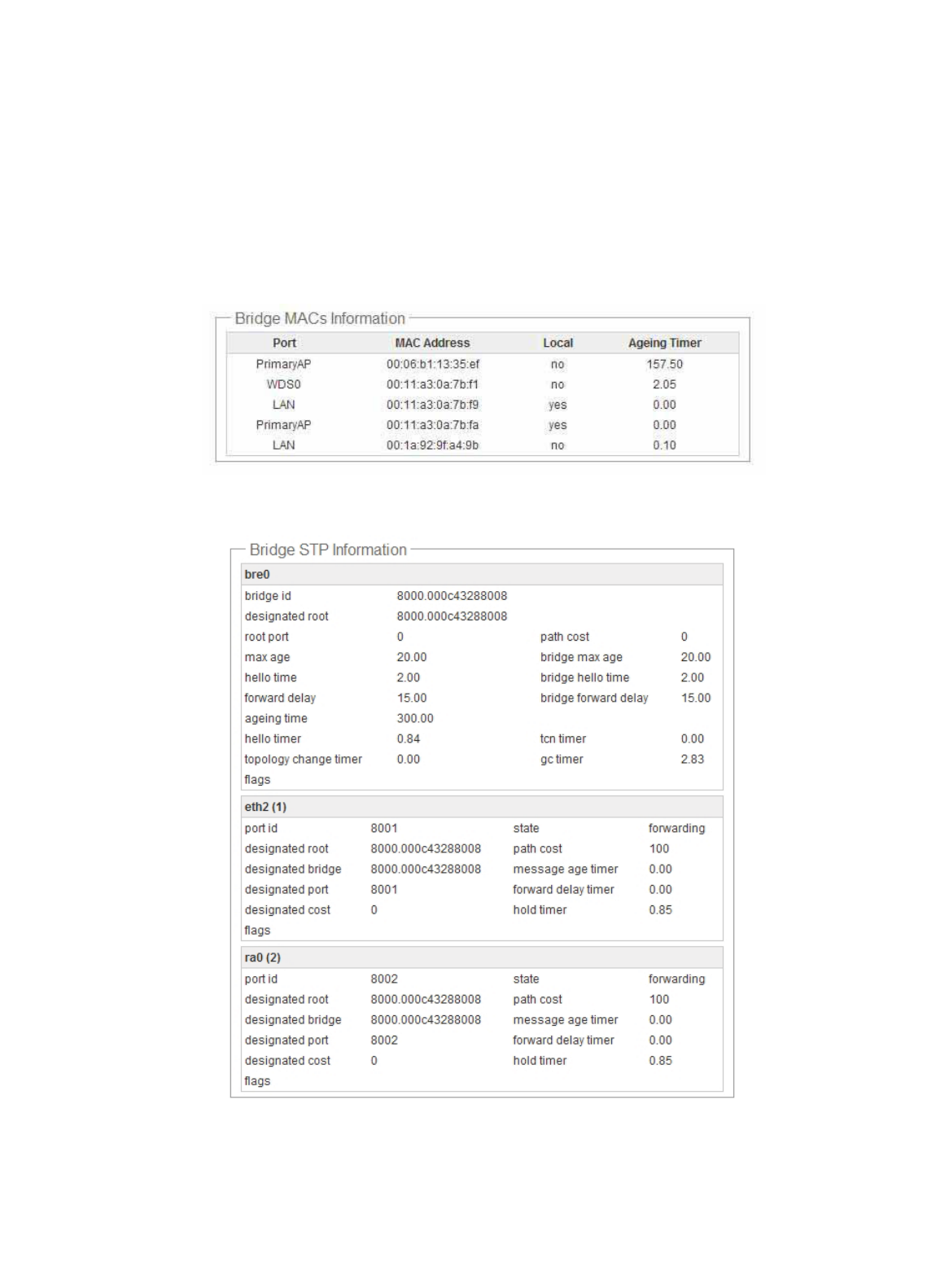
㻠㻟
Bridge MAC information : Select “Bridge MACs Information” on the drop-down list to display MAC table.
This table displays local MAC addresses associated with wired or wireless interfaces, but also remember non-local
MAC addresses learned from wired or wireless interfaces.
Ageing timers will be reset when existing MAC addresses in table are learned again or added when new MAC
addresses are seen from wired or wireless interfaces as well. When time runs out for a particular entry, it will be
pruned from the table. In that situation, switching packet to that particular MAC address will be dropped.
Bridge STP Information : Select “Bridge STP Information” on the drop-down list to display a list of bridge STP
information.
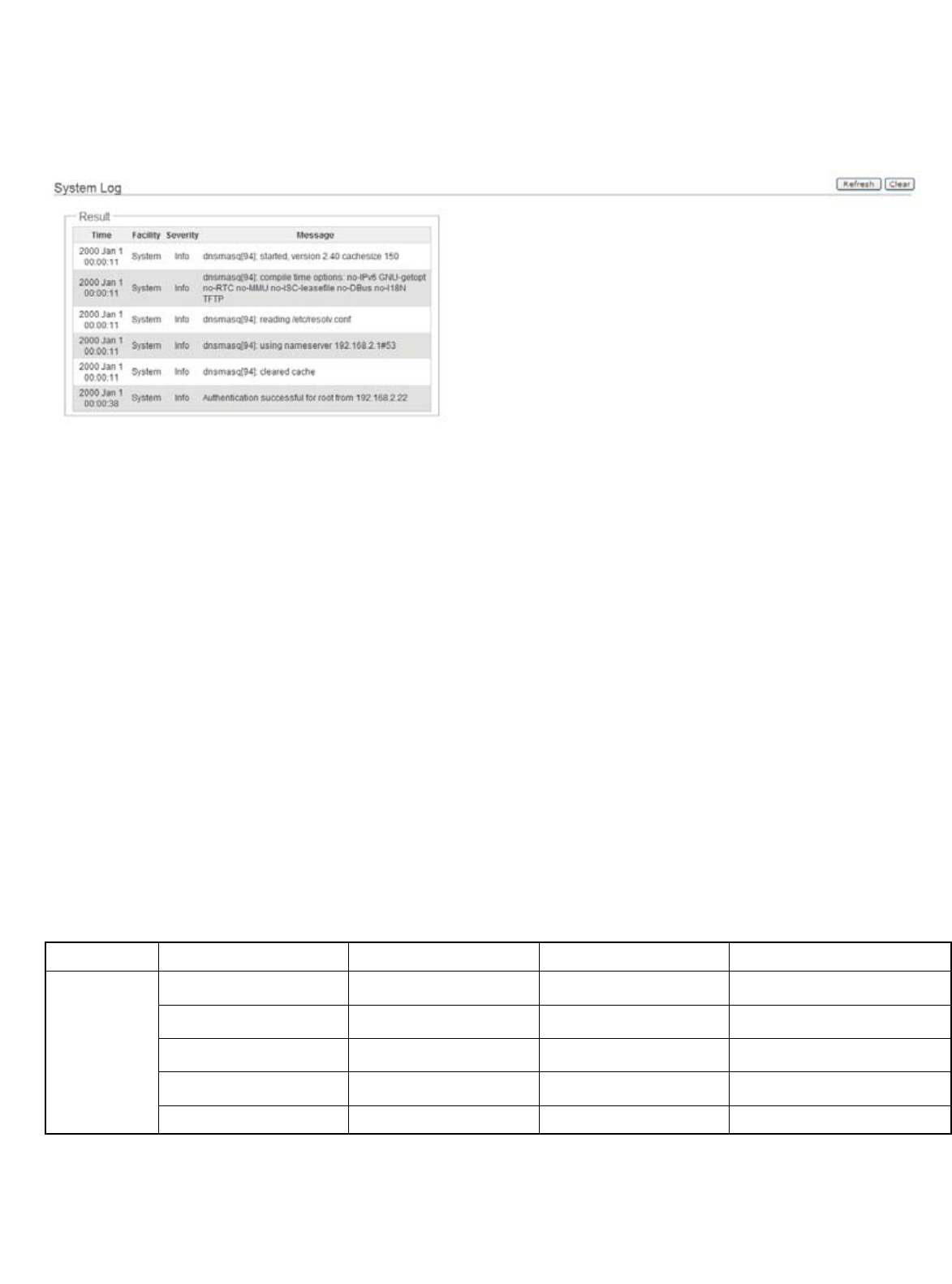
㻠㻠
Event Log
The Event log displays system events when system is up and running. Also, it becomes very useful as a troubleshooting
tool when issues are experienced in system.
Time : The date and time when the event occurred.
Facility : It helps users to identify source of events such “System” or “User”
Severity : Severity level that a specific event is associated such as “info”, “error”, “warning”, etc.
Message : Description of the event.
Click Refresh button to renew the log, or click Clear button to clear all the record.
WDS Mode Configuration
Please refer to illustrations of the section 1.3 for possible applications in the WDS mode. This section provides detailed
explanation for users to configure in the WDS mode with help of illustrations. In the WDS mode, functions listed in the
table below are also available from the Web-based GUI interface.
Option SystemWireless Utilities Status
Functions
Operating Mode General Setup Profiles SettingsSystem Overview
LAN Advanced Setup Firmware Upgrade WDS Status
Management WDS Setup Network Utility Extra Info
Time Server Reboot Event Log
SNMP
WDS Mode Functions

㻠㻡
External Network Connection
Network Requirement
You could expand your Ethernet network via WDS link. In this mode, the TEW-676APBO connects directly to a wired
LAN, and wirelessly bridges to a remote access point via a WDS link as shown in Figure 4-1. In the mode, it can’t
associate with any wireless clients.
Point to Point network Configuration
Internet
192.168.2.254
WDS
Remote Bass Station
192.168.2.250
TEW-676APBO
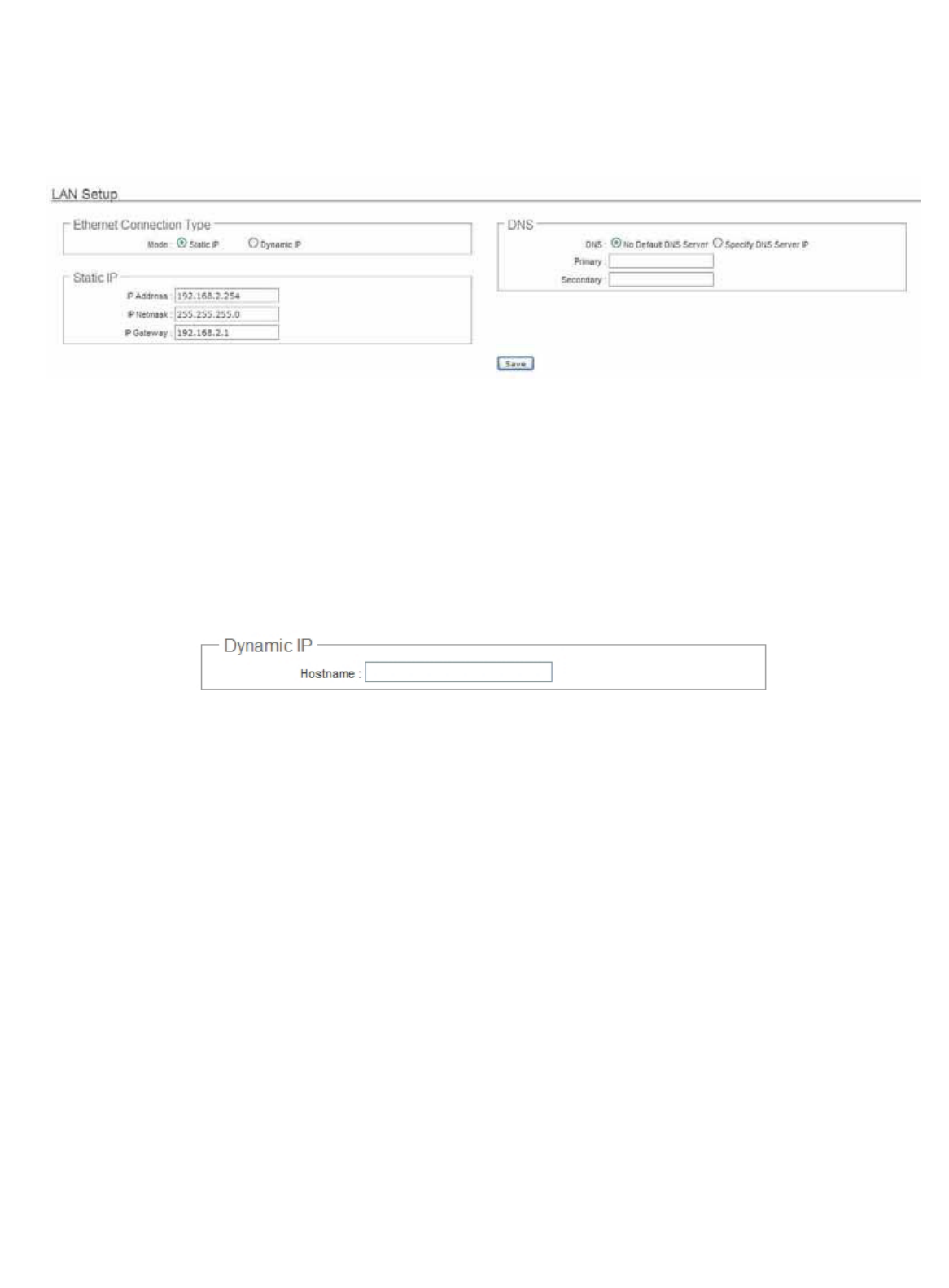
㻠㻢
Configure LAN IP
Here are the instructions for how to setup the local IP Address and Netmask.
Please click on System -> LAN and follow the below setting.
Mode : Check either “Static IP” or “Dynamic IP” button as desired to set up the system IP of LAN port .
ÎStatic IP : The administrator can manually setup the LAN IP address when static IP is available/ preferred.
9IP Address : The IP address of the LAN port; default IP address is 192.168.2.254
9IP Netmask : The Subnet mask of the LAN port; default Netmask is 255.255.255.0
9IP Gateway : The default gateway of the LAN port; default Gateway is 192.168.2.1
ÎDynamic IP : This configuration type is applicable when the WCB1200H2PX is connected to a network with the
presence of a DHCP server; all related IP information will be provided by the DHCP server automatically.
9Hostname : The Hostname of the LAN port
DNS : Check either “No Default DNS Server” or “Specify DNS Server IP” button as desired to set up the system
DNS.
ÎPrimary : The IP address of the primary DNS server.
ÎSecondary : The IP address of the secondary DNS server.
Click Save button to save your changes. Click Reboot button to activate your changes
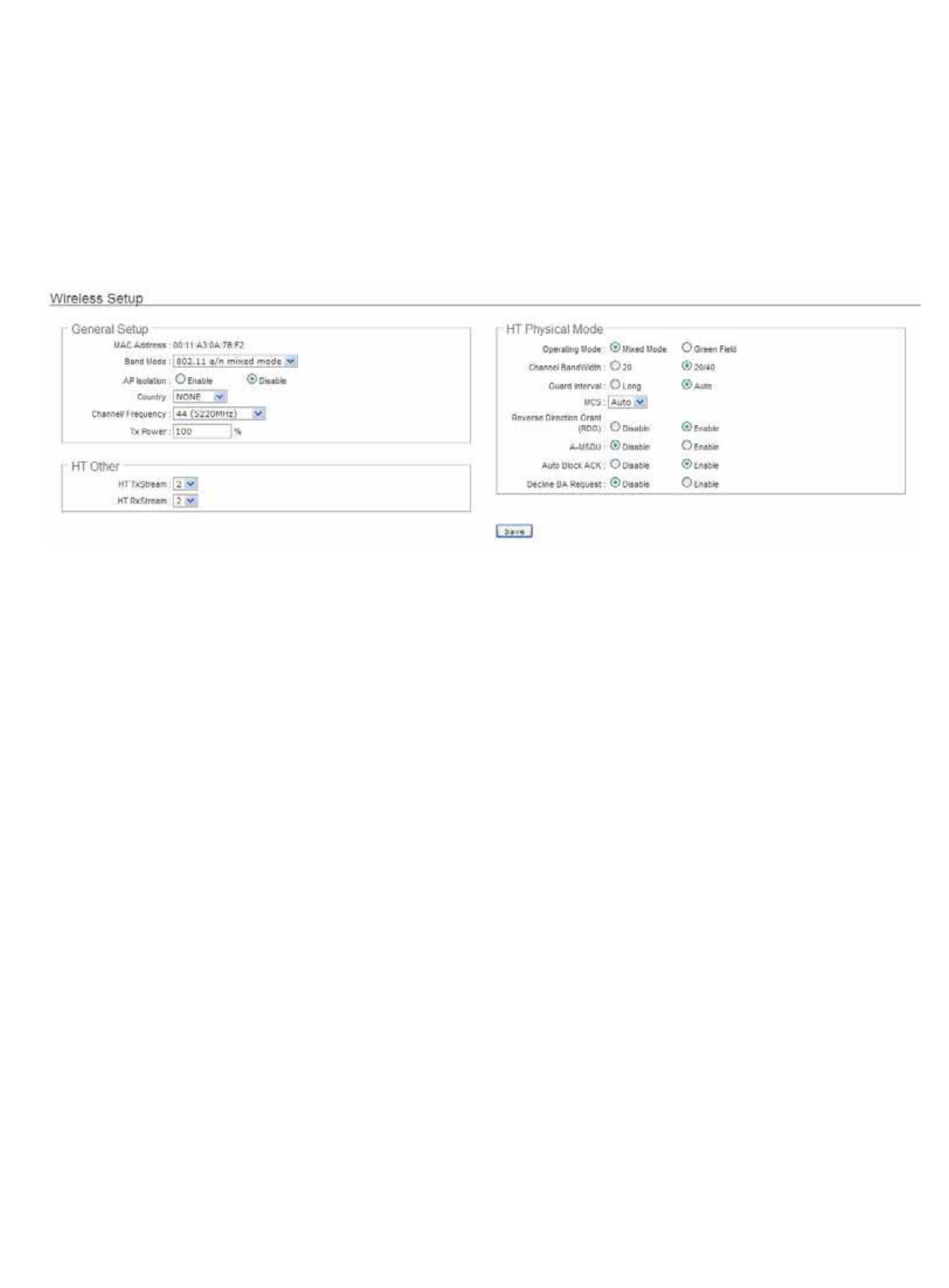
㻠㻣
Wireless Network Expansion
The network manager can configure related wireless settings, General Settings, Advanced Settings and WDS
Settings.
General Setup
The administrator can change the data transmission, channel and output power settings for the system. Please click on
Wireless -> General Setup and follow the below setting.
MAC Address : The MAC address of the Wireless interface is displayed here.
Band Mode : Select an appropriate wireless band; bands available are 801.11aor 802.11a/n mixed mode.
Transmit Rate Control : Select the desired rate from the drop-down list; the options are auto or ranging from 6to
54Mbps only for 802.11amode.
Country : Select the desired country code from the drop-down list; the options are US,ETSI,JP and NONE.
Channel/Frequency : The channel range will be changed by selecting different country code. Below depicts the
channel range for different Country. When “Band Mode” selected in “802.11a/n”, the Channel 140 and 165 does not
shown-up on list.
Country Channel
US36, 40, 44, 48, 52, 56, 60, 64, 149, 153, 157, 161, 165
ETSI 36, 40, 44, 48, 52, 56, 60, 64, 100, 104, 108, 112, 116, 120, 124, 128, 132, 136, 140
JP 36, 40, 44, 48
NONE 36, 40, 44, 48, 52, 56, 60, 64, 100, 104, 108, 112, 116, 120, 124, 128, 132, 136, 140, 149, 153, 157, 161, 165
Tx Power : You can adjust the output power of the system to get the appropriate coverage for your wireless network.
Specify digit number between 1to 100 (the unit is %) for your environment. If you are not sure which setting to
choose, then keep the default setting, 100%.
When Band Mode select in 802.11a only mode, the HT(High Throughput) settings should be hidden immediately.

㻠㻤
HT TxStream/RxStream : By default, it's 2.
Operating Mode : By default, it's Mixed mode
ÎMixed Mode : In this mode packets are transmitted with a preamble compatible with the legacy 802.11a/g, the
rest of the packet has a new format. In this mode the receiver shall be able to decode both the Mixed Mode
packets and legacy packets.
ÎGreen Field : In this mode high throughput packets are transmitted without a legacy compatible part.
Channel Bandwidth : The "20/40” MHz option is usually best. The other option is available for special
circumstances.
Guard Interval : Using “Auto” option can increase throughput. However, it can also increase error rate in some
installations, due to increased sensitivity to radio-frequency reflections. Select the option that works best for your
installation.
MCS : This parameter represents transmission rate. By default (Auto) the fastest possible transmission rate will be
selected. You have the option of selecting the speed if necessary. (Refer to Appendix C. MCS Data Rate)
Reverse Direction Grant(RDG) : Disable or enable reserve direction grant. Default is enabled.
A-MSDU : Aggregated Mac Service Data Unit . Select Enable to allow aggregation for multiple MSDUs in one MPDU
Default is disabled.
Auto Block ACK : Disable or enable auto block ACK. Default is enabled.
Decline BA Request : Disable or enable decline BA request. Default is disabled.
Change these settings as described here and click Save button to save your changes. Click Reboot button to activate
your changes. The items in this page are for AP's RF general settings and will be applied to all WDS Links.
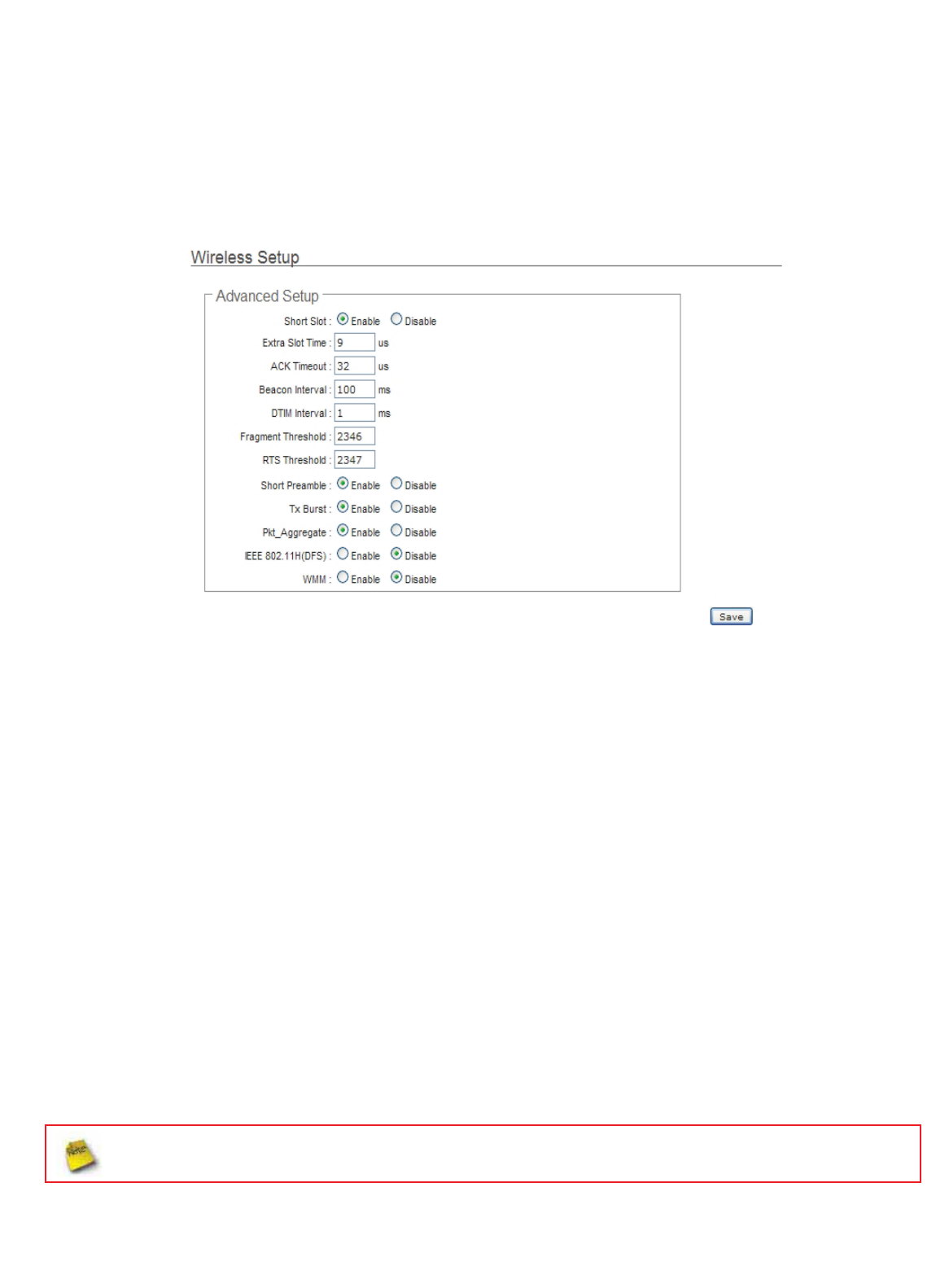
㻠㻥
Wireless Advanced Setup
To achieve optimal wireless performance, it is necessary to tweak advance setting per requirements properly, not
necessary higher the better or lower.
The administrator can change the RTS threshold and fragmentation threshold settings for the system. Please click on
Wireless -> Advanced Setup and follow the below setting.
Short Slot : By default, it’s “Enable”for educing the slot time from the standard 20 microseconds to the 9
microsecond short slot time
Slot time is the amount oftime a device waits after a collision before retransmitting a packet. Reducing the slot time
decreases the overall back-off, which increases throughput. Back-off, which is a multiple of the slot time, is the
random length of time a station waits before sending a packet on the LAN. For a sender and receiver own right of the
channel the shorter slot time help manage shorter wait time to re-transmit from collision because of hidden wireless
clients or other causes. When collision sources can be removed sooner and other senders attempting to send are
listening the channel(CSMA/CA) the owner of the channel should continue ownership and finish their transmission
and release the channel. Then, following ownership of the channel will be sooner for the new pair due to shorter slot
time. However, when long duration of existing collision sources and shorter slot time exist the owners might
experience subsequent collisions. When adjustment to longer slot time can’t improve performance then RTS/CTS
could supplement and help improve performance.
Extra Slot Time : Slot time is in the range of 1~255 and set in unit of microsecond. The default value is 9
microsecond.
When you enable Short Slot and set Extra Slot time to “10”, the actual Slot Time=9+10 us.
When you disable Short Slot and set Extra Slot time to “10”, the actual Slot Time=20+10 us.

㻡㻜
ACK Timeout : ACK timeout is in the range of 1~255 and set in unit of microsecond. The default value is 32
microsecond.
All data transmission in 802.11b/g request an “Acknowledgement” (ACK) send by receiving radio. The transmitter will
resend the original packet if correspondent ACK failed to arrive within specific time interval, also refer to as “ACK
Timeout”.
ACK Timeout is adjustable due to the fact that distance between two radio links may vary in different deployment.
ACK Timeout makes significant influence in performance of long distance radio link. If ACK Timeout is set too short,
transmitter will start to “Resend” packet before ACK is received, and throughputs become low due to excessively high
re-transmission.
ACK Timeout is best determined by distance between the radios, data rate of average environment. The Timeout
value is calculated based on round-trip time of packet with a little tolerance, So, if experiencing re-transmissions or
poor performance the ACK Timeout could be made longer to accommodate.
Slot Time and ACK Timeout settings are for long distance links. It is important to tweak settings to achieve the
optimal result based on requirement.
Beacon Interval : Beacon Interval is in the range of 20~1024 and set in unit of millisecond. The default value is 100
msec.
Access Point (AP) in IEEE 802.11 will send out a special approximated 50-byte frame, called “Beacon”. Beacon is
broadcast to all the stations, provides the basic information of AP such as SSID, channel, encryption keys, signal
strength, time stamp, support data rate.
All the radio stations received beacon recognizes the existence of such AP, and may proceed next actions if the
information from AP matches the requirement. Beacon is sent on a periodic basis, the time interval can be adjusted.
By increasing the beacon interval, you can reduce the number of beacons and associated overhead, but that will
likely delay the association and roaming process because stations scanning for available access points may miss the
beacons. You can decrease the beacon interval, which increases the rate of beacons. This will make the association
and roaming process very responsive; however, the network will incur additional overhead and throughput will go
down.
DTIM Interval : The DTIM interval is in the range of 1~255. The default is 1.
DTIM is defined as Delivery Traffic Indication Message. It is used to notify the wireless stations, which support power
saving mode, when to wake up to receive multicast frame. DTIM is necessary and critical in wireless environment as
a mechanism to fulfill power-saving synchronization.
A DTIM interval is a count of the number of beacon frames that must occur before the access point sends the
buffered multicast frames. For instance, if DTIM Interval is set to 3, then the Wi-Fi clients will expect to receive a
multicast frame after receiving three Beacon frame. The higher DTIM interval will help power saving and possibly
decrease wireless throughput in multicast applications.

㻡㻝
Fragment Threshold : The Fragment Threshold is in the range of 256~2346 byte. The default is 2346 byte.
Each Wi-Fi packet can be divided into smaller packets, marked with a sequential fragment number and re-assemble
in the receiving ends. The purpose is to make a short frame, instead of long frame, transmitting by radio in a heavy
noisy environment. Because of sending smaller frames, corruptions are much less likely to occur. The pros is
obvious, the cons is the overhead for transmission. So, in a clean environment, higher fragment threshold can be an
option to increase throughput.
Fragmentation will be triggered by setting the Fragment Threshold, usually in Byte-length. Only when the frame size
is over the Threshold, fragmentation will take place automatically.
RTS Threshold : TRTS Threshold is in the range of 1~2347 byte. The default is 2347 byte.
The main purpose of enabling RTS by changing RTS threshold is to reduce possible collisions due to hidden wireless
clients. RTSin AP will be enabled automatically if the packet size is larger than the Threshold value. By default, RTS
is disabled in a normal environment supports non-jumbo frames.
Short Preamble : By default, it’s “Enable”. To Disable is to use Long 128-bit Preamble Synchronization field.
The preamble is used to signal "here is a train of data coming" to the receiver. The short preamble provides 72-bit
Synchronization field to improve WLAN transmission efficiency with less overhead.
Tx Burst : By default, it’s “Enable”. To Disable is to deactivate Tx Burst.
With TX burst enabled, AP will send many packets in a burst, without collision detection and RTS/CTS for each packet. TX
Burst have better throughput but cause interference with other APs in channel.
Pkt_Aggregate : By default, it's “Enable”
Increase efficiency by aggregating multiple packets of application data into a single transmission frame. In this way,
802.11n networks can send multiple data packets with the fixed overhead cost of just a single frame.
IEEE802.11H (DFS) : By default, it's “Disable”. To Enable is to use IEEE802.11H(DFS)
With DFS(Dynamic Frequency Selection) enabled, radio is operating on one of the following channels, the wireless
device uses DFS to monitor the operating frequency and switch to another frequency or reduce power as necessary:
DFS Channels 52, 56, 60, 64, 100, 104, 108, 112, 116, 120, 124, 128, 136, 140
The maximum legal transmit power is greater for some 5 GHz channels than for others. When the wireless device
randomly selects a 5 GHz channel on which power is restricted, the wireless device automatically reduces transmit
power to comply with power limits for that channel in that regulatory domain.
The Channel 52-140 is DFS channel. If tuen on IEEE802.11H, AP Will have 60 sec to do
channel available check, and will not send beacon and can not be connect. When
WCB1200H2PX detect radar(5GHz) signal, the AP will switch channel and stop beacon
trasmit between 15 sec.
WMM : By default, it's “Disable”. To Enable is to use WMM and the WMM parameters should appears.
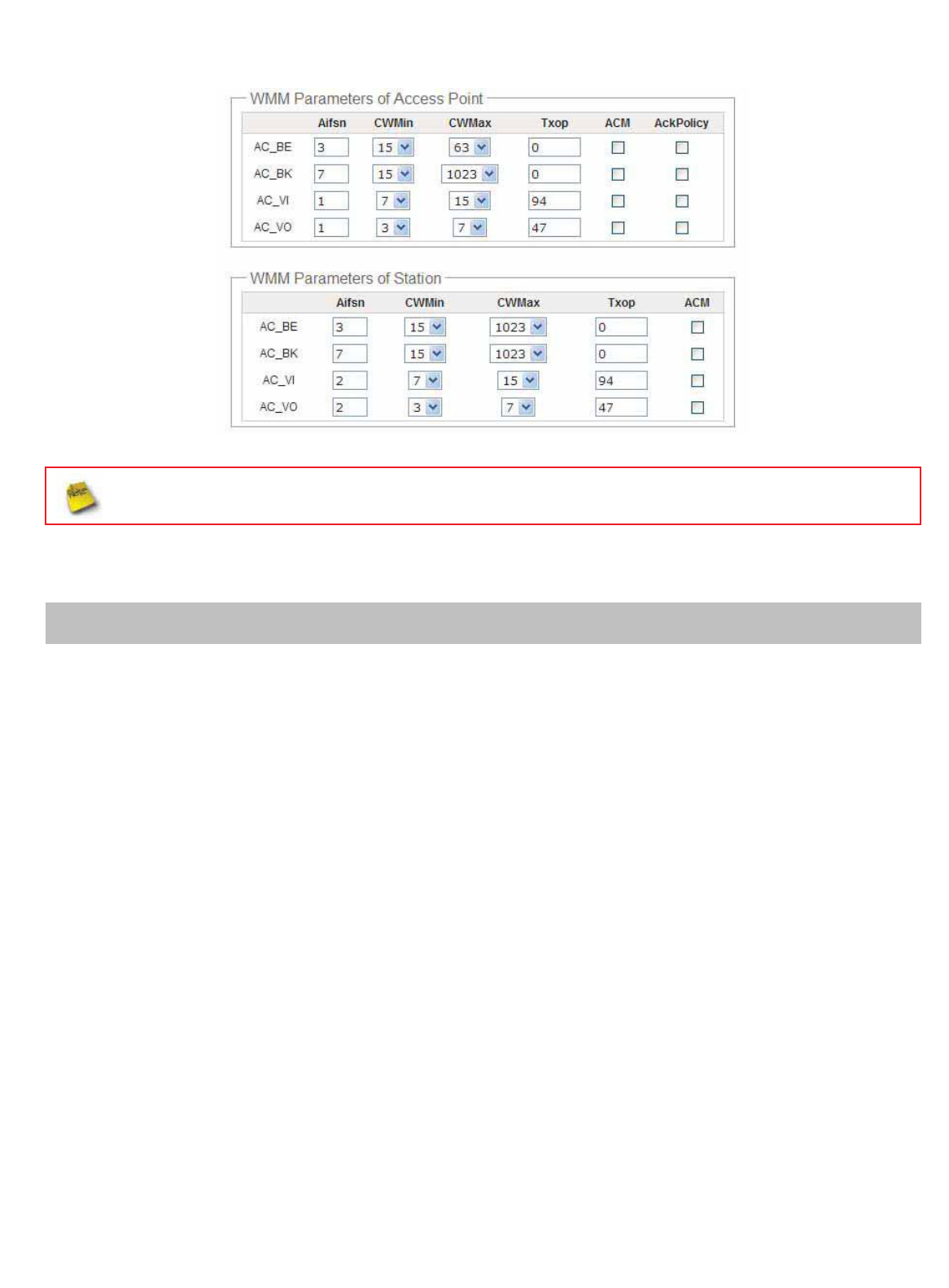
㻡㻞
When you enable WMM, the “Tx Burst” will be Disabled automatically by system.
ÎWMM Parameters of Access Point : This affects traffic flowing from the access point to the client station
Queue Data Transmitted
AP to Clients Priority Description
AC_BK Background. LowHigh throughput. Bulk data that requires maximum throughput and is not time-
sensitive is sent to this queue (FTP data, for example).
AC_BE Best Effort MediumMedium throughput and delay. Most traditional IP data is sent to this queue
AC_VIVideo High Minimum delay. Time-sensitive video data is automatically sent to this queue
AC_VOVoice HighTime-sensitive data like VoIP and streaming media are automatically sent to this
queue
Configuring QoS options consists of setting parameters on existing queues for different types of wireless traffic.
You can configure different minimum and maximum wait times for the transmission of packets in each queue
based on the requirements of the media being sent. Queues automatically provide minimum transmission delay
for Voice, Video, multimedia, and mission critical applications, and rely on best-effort parameters for traditional IP
data.
As an Example, time-sensitive Voice & Video, and multimedia are given effectively higher priority for transmission
(lower wait times for channel access), while other applications and traditional IP data which are less time-
sensitive but often more data-intensive are expected to tolerate longer wait times.

㻡㻟
9Aifsn : The Arbitration Inter-Frame Spacing Number specifies a wait time (in milliseconds) for data frames
9CWmin : Minimum Contention Window. This parameter is input to the algorithm that determines the initial
random backoff wait time ("window") for retry of a transmission. The value specified here in the Minimum
Contention Window is the upper limit (in milliseconds) of a range from which the initial random backoff wait
time is determined.
9CWmax: Maximum Contention Window. The value specified here in the Maximum Contention Window is
the upper limit (in milliseconds) for the doubling of the random backoff value. This doubling continues until
either the data frame is sent or the Maximum Contention Window size is reached. Once the Maximum
Contention Window size is reached, retries will continue until a maximum number of retries allowed is
reached. Valid values for the "cwmax" are 1, 3, 7, 15, 31, 63, 127, 255, 511, or 1024. The value for "cwmax"
must be higher than the value for "cwmin".
9Txop : Transmission Opportunity is an interval of time when a WME AP has the right to initiate
transmissions onto the wireless medium (WM). This value specifies (in milliseconds) the Transmission
Opportunity (TXOP) for AP; that is, the interval of time when the WMM AP has the right to initiate
transmissions on the wireless network.
9ACM : Admission Control Mandatory, ACM only takes effect on AC_VI and AC_VO. When you do not click
Checkbox, it means that the ACM is controlled by the connecting AP. If you click Checkbox, it means that the
Client is in charge.
9AckPolicy : Acknowledgment Policy, WMM defines two ACK policies: Normal ACK and No ACK. Click
“Checkbox” indicates “No ACK”
When the no acknowledgment (No ACK) policy is used, the recipient does not acknowledge received
packets during wireless packet exchange. This policy is suitable in the environment where communication
quality is fine and interference is weak. While the No ACK policy helps improve transmission efficiency, it
can cause increased packet loss when communication quality deteriorates. This is because when this policy
is used, a sender does not retransmit packets that have not been received by the recipient.
When the Normal ACK policy is used, the recipient acknowledges each received unicast packet.
ÎWMM Parameters of Station : This affects traffic flowing from the client station to the access point.
Queue Data Transmitted
Clients to AP Priority Description
AC_BK Background. LowHigh throughput. Bulk data that requires maximum throughput and is not time-
sensitive is sent to this queue (FTP data, for example).
AC_BE Best Effort MediumMedium throughput and delay. Most traditional IP data is sent to this queue
AC_VIVideo High Minimum delay. Time-sensitive video data is automatically sent to this queue
AC_VOVoice HighTime-sensitive data like VoIP and streaming media are automatically sent to this
queue
9Aifsn : The Arbitration Inter-Frame Spacing Number specifies a wait time (in milliseconds) for data frames
9CWmin : Minimum Contention Window. This parameter is input to the algorithm that determines the initial
random backoff wait time ("window") for retry of a transmission. The value specified here in the Minimum
Contention Window is the upper limit (in milliseconds) of a range from which the initial random backoff wait
time is determined.

㻡㻠
9CWmax: Maximum Contention Window. The value specified here in the Maximum Contention Window is
the upper limit (in milliseconds) for the doubling of the random backoff value. This doubling continues until
either the data frame is sent or the Maximum Contention Window size is reached. Once the Maximum
Contention Window size is reached, retries will continue until a maximum number of retries allowed is
reached. Valid values for the "cwmax" are 1, 3, 7, 15, 31, 63, 127, 255, 511, or 1024. The value for "cwmax"
must be higher than the value for "cwmin".
9Txop : Transmission Opportunity is an interval of time when a WME AP has the right to initiate
transmissions onto the wireless medium (WM). This value specifies (in milliseconds) the Transmission
Opportunity (Txop) for AP; that is, the interval of time when the WMM AP has the right to initiate
transmissions on the wireless network.
9ACM : Admission Control Mandatory, ACM only takes effect on AC_VI and AC_VO. When you do not click
Checkbox, it means that the ACM is controlled by the connecting AP. If you click Checkbox, it means that the
Client is in charge.
Change these settings as described here and click Save button to save your changes. Click Reboot button to activate
your changes. The items in this page are for AP's RF advanced settings and will be applied to all WDS Links.
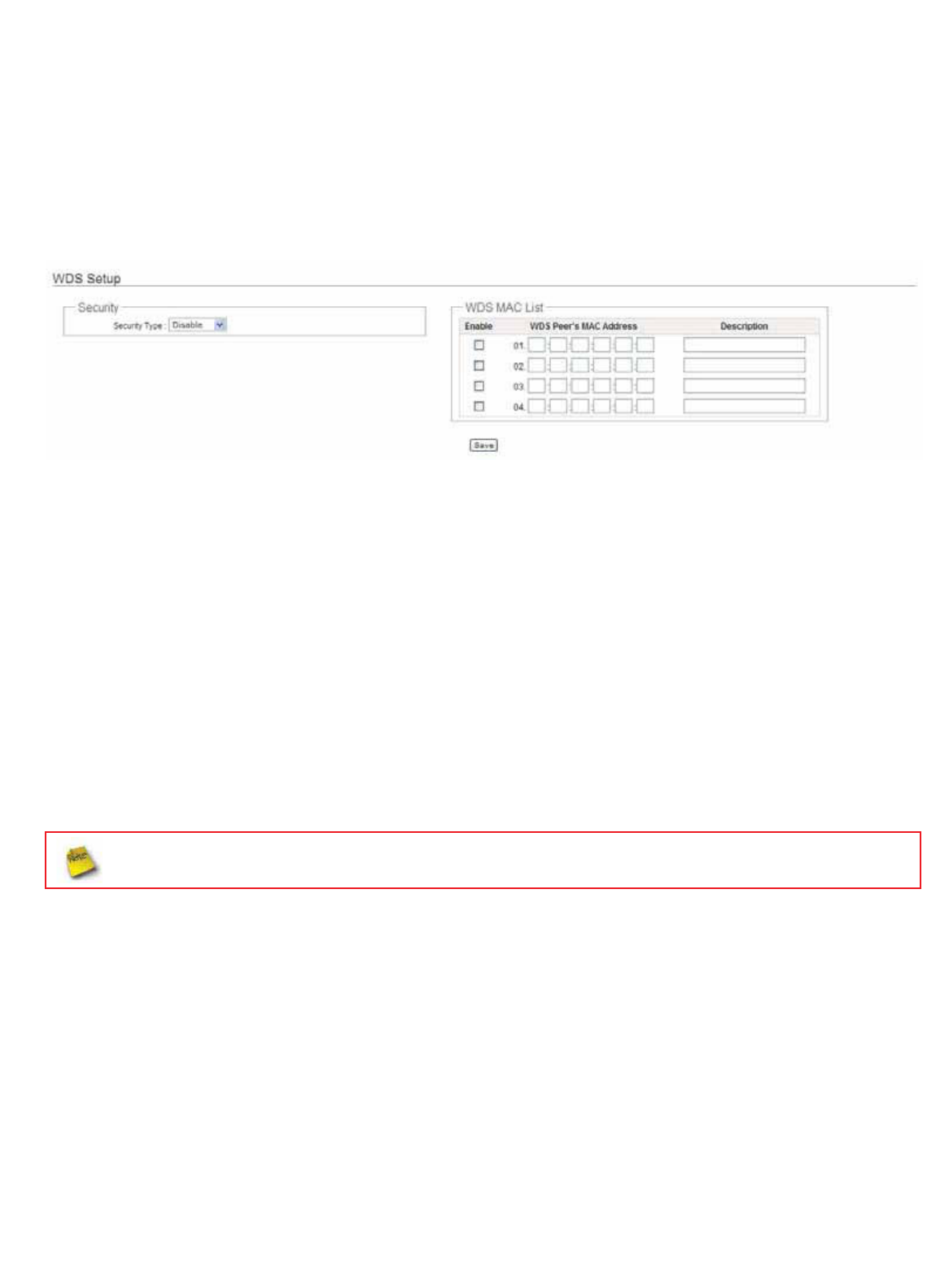
㻡㻡
WDS Setup
The administrator could create WDS Links to expand wireless network. When WDS is enabled, access point functions as
a wireless bridge and is able to communicate with other access points via WDS links. A WDS link is bidirectional and
both side must support WDS. Access points know each other by MAC Address. In other words, each access
point needs to include MAC address of its peer. Ensure all access points are configured with the same channel
and own same security type settings.
Security Type : Option is “Disable”, “WEP”, “TKIP” or “AES” from drop-down list. Needs the same type to build
WDS links. Security type takes effect when WDS is enabled.
ÎWEP Key : Enter 5 / 13 ASCII or 10 / 26 HEX format WEP key.
ÎTKIP Key : Enter 8to 63 ASCII or 64 HEX format TKIP key.
ÎAES Key : Enter 8to 63 ASCII or 64 HEX format AES key.
WDS MAC List
ÎEnable : Click Enable to create WDS link.
ÎWDS Peer's MAC Address : Enter the MAC address of WDS peer.
ÎDescription : Description of WDS link.
The WDS link needs to be set at same Channel and Security Type between WDS link.
Click Save button to save your changes. Click Reboot button to activate your changes
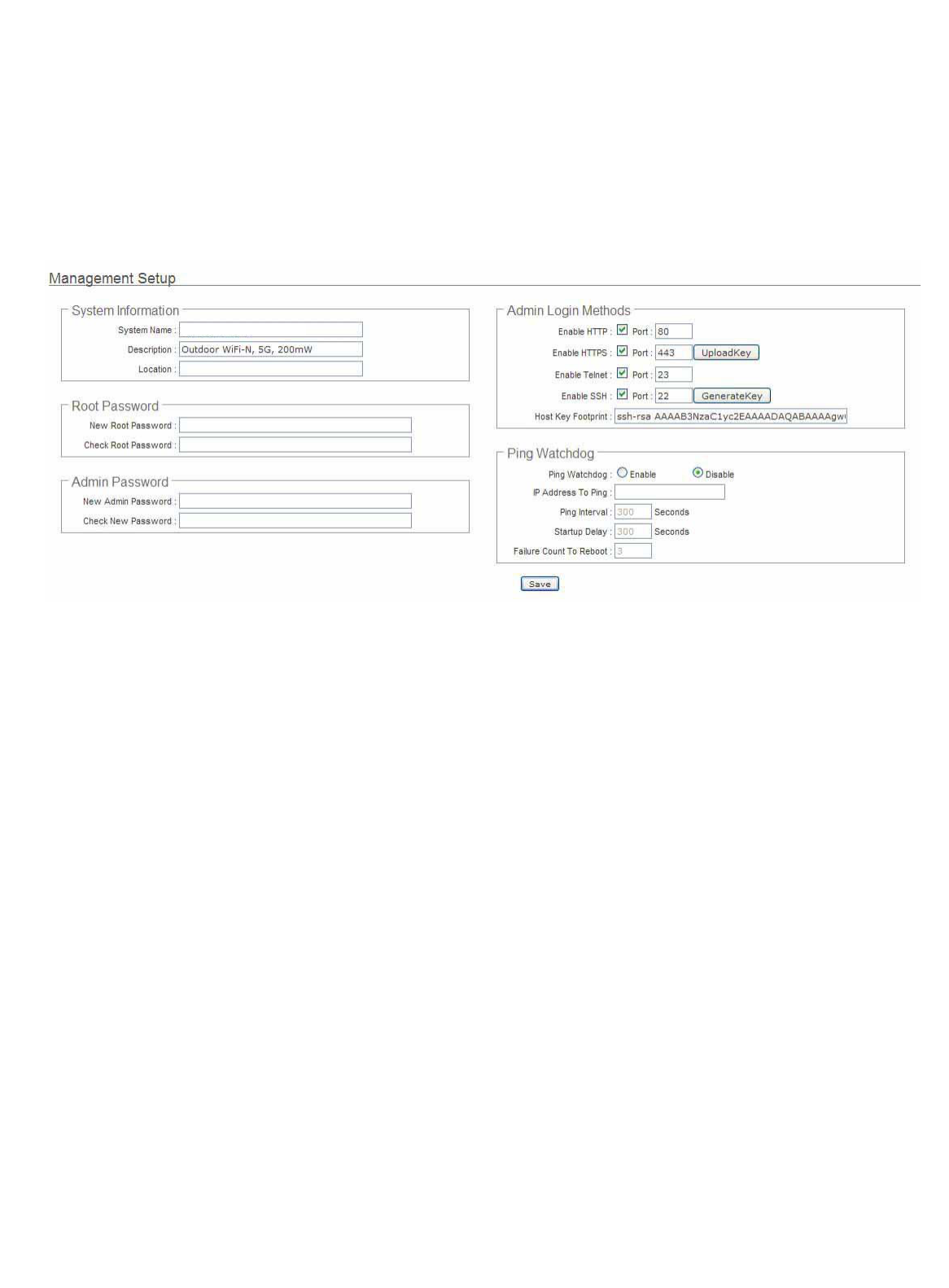
㻡㻢
SystemManagement
Configure Management
Administrator could specify geographical location of the system via instructions in this page. Administrator could also
enter new Root and Admin passwords and allow multiple login methods.
Please click System -> Management and follow the below settings.
System Information
ÎSystem Name : Enter a desired name or use the default one.
ÎDescription : Provide description of the system.
ÎLocation : Enter geographical location information of the system. It helps administrator to locate the system
easier.
The system supports two management accounts, root and admin. The network manager is assigned with full
administrative privileges, when logging in as root user, to manage the system in all aspects. While logging in as an
admin user, only subset of privileges is granted such as basic maintenance. For example, root user can change
passwords for both root and admin account, and admin user can only manage its own. For more information about
covered privileges for these two accounts, please refer to Appendix D. Network manager Privileges.
Root Password : Log in as a root user and is allowed to change its own, plus admin user’s password.
ÎNew Password : Enter a new password if desired
ÎCheck New Password : Enter the same new password again to check.
Admin Password : Log in as a admin user and is allowed to change its own,
ÎNew Password : Enter a new password if desired
ÎCheck New Password : Enter the same new password again to check.
Admin Login Methods : Only root user can enable or disable system login methods and change services port.
TEW-676APBO

㻡㻣
ÎEnable HTTP : Check to select HTTP Service.
ÎHTTP Port : The default is 80 and the range is between 1 ~ 65535.
ÎEnable HTTPS : Check to select HTTPS Service
ÎHTTPS Port : The default is 443 and the range is between 1 ~ 65535.
If you already have an SSL Certificate, please click “UploadKey” button to select the file and upload it.
ÎEnable Telnet : Check to select Telnet Service
ÎTelnet Port : The default is 23 and the range is between 1 ~ 65535.
ÎEnable SSH : Check to select SSH Service
ÎSSH Port : Please The default is 22 and the range is between 1 ~ 65535.
Click “GenerateKey” button to generate RSA private key. The “host key footprint” gray blank will display
content of RSA key.
Ping Watchdog : The ping watchdog sets the TEW-676APBO Device to continuously ping a user defined IP address
(it can be the internet gateway for example). If it is unable to ping under the user defined constraints, the TEW-
676APBO device will automatically reboot. This option creates a kind of "fail-proof" mechanism.
Ping Watchdog is dedicated for continuous monitoring of the particular connection to remote host using the Ping tool.
The Ping works by sending ICMP “echo request” packets to the target host and listening for ICMP “echo response”
replies. If the defined number of replies is not received, the tool reboots the device.
ÎEnable Ping Watchdog : control will enable Ping Watchdog Tool.
ÎIP Address To Ping : specify an IP address of the target host which will be monitored by Ping Watchdog Tool.
ÎPing Interval : specify time interval (in seconds) between the ICMP “echo requests” are sent by the Ping
Watchdog Tool. Default is 300 seconds.
ÎStartup Delay : specify initial time delay (in seconds) until first ICMP “echo requests” are sent by the Ping
Watchdog Tool. The value of Startup Delay should be at least 60 seconds as the network interface and wireless
connection initialization takes considerable amount of time if the device is rebooted. Default is 300 seconds.
ÎFailure Count To Reboot : specify the number of ICMP “echo response” replies. If the specified number of
ICMP “echo response” packets is not received continuously, the Ping Watchdog Tool will reboot the device.
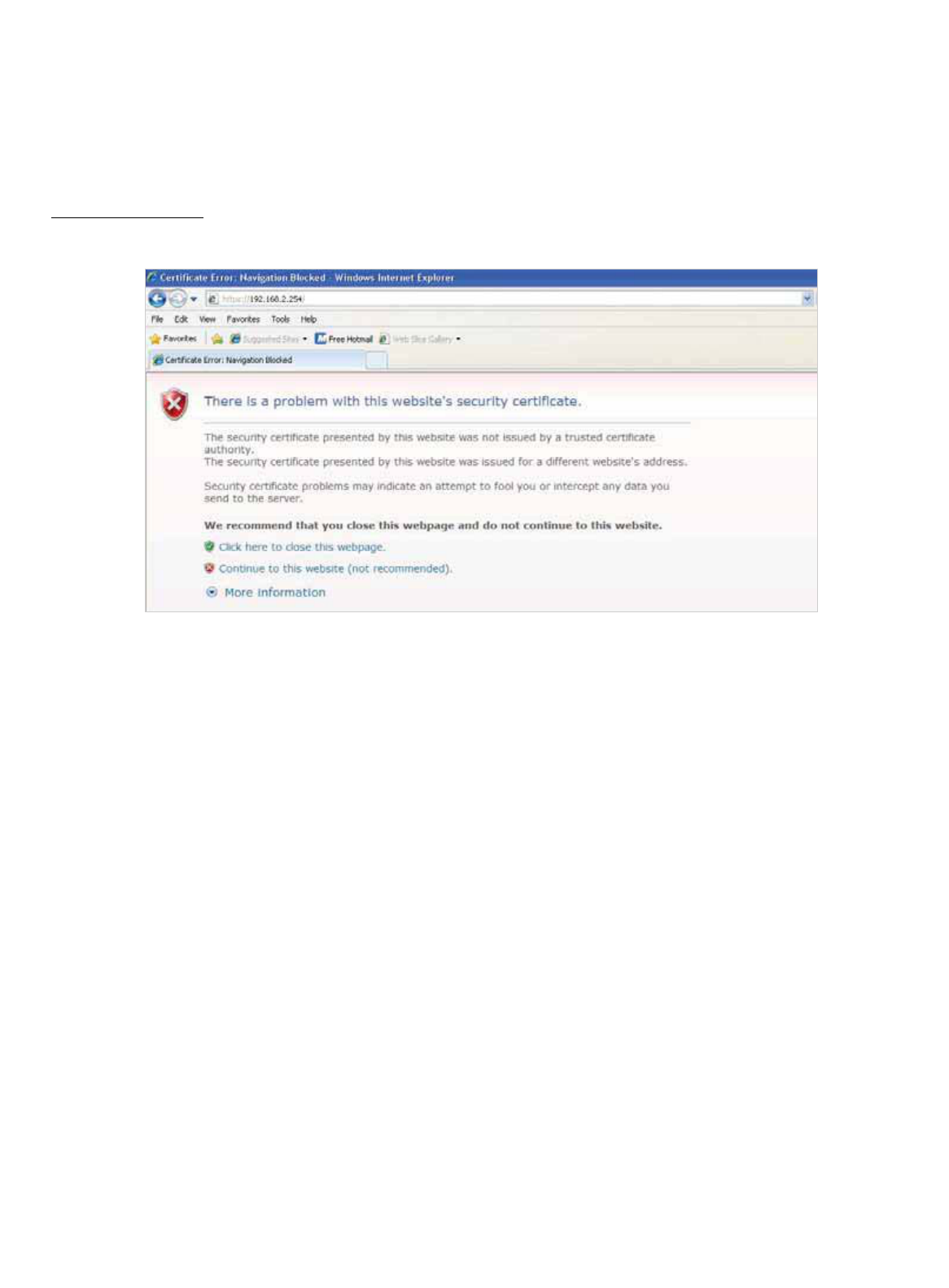
㻡㻤
Click Save button to save your changes. Click Reboot button to activate your changes
Without a valid certificate, users may encounter the following problem in IE7 when they try to access system's WMI
(https://192.168.2.254). There will be a “Certificate Error”, because the browser treats system as an illegal website.
Click “Continue to this website” to access the system's WMI. The system's Overview page will appear.
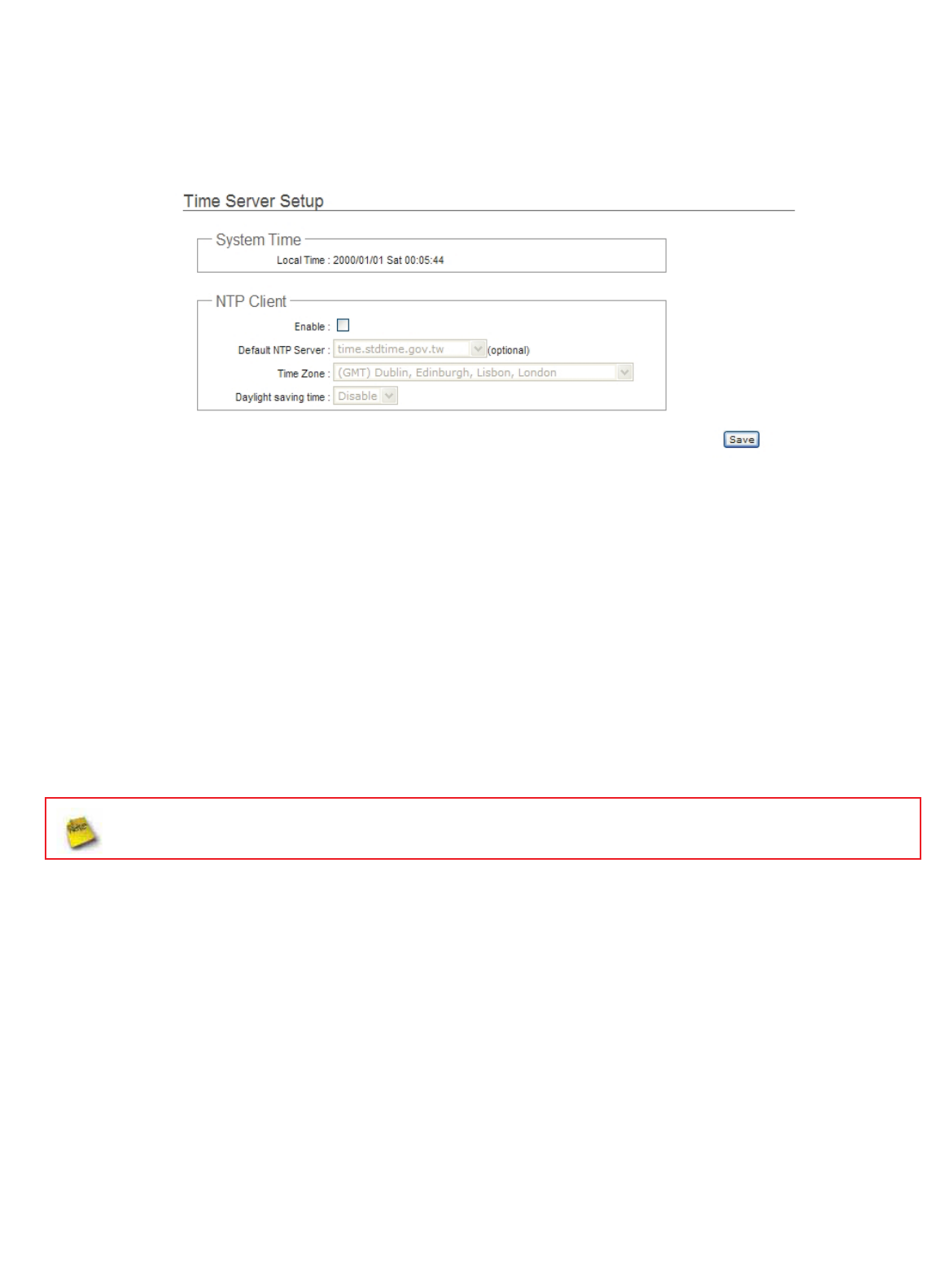
㻡㻥
Configure System Time
System time can be configured via this page, and manual setting or via a NTP server is supported.
Please click on System -> Time Server and follow the below setting.
Local Time : Display the current system time.
NTP Client : To synchronize the system time with NTP server.
ÎEnable : Check to select NTP client.
ÎDefault NTP Server : Select the NTP Server from the drop-down list.
ÎTime Zone : Select a desired time zone from the drop-down list.
ÎDaylight saving time : Enable or disable Daylight saving.
If the system time from NTP server seems incorrect, please verify your network settings, like default Gateway
and DNS settings
Click Save button to save your changes. Click Reboot button to activate your changes
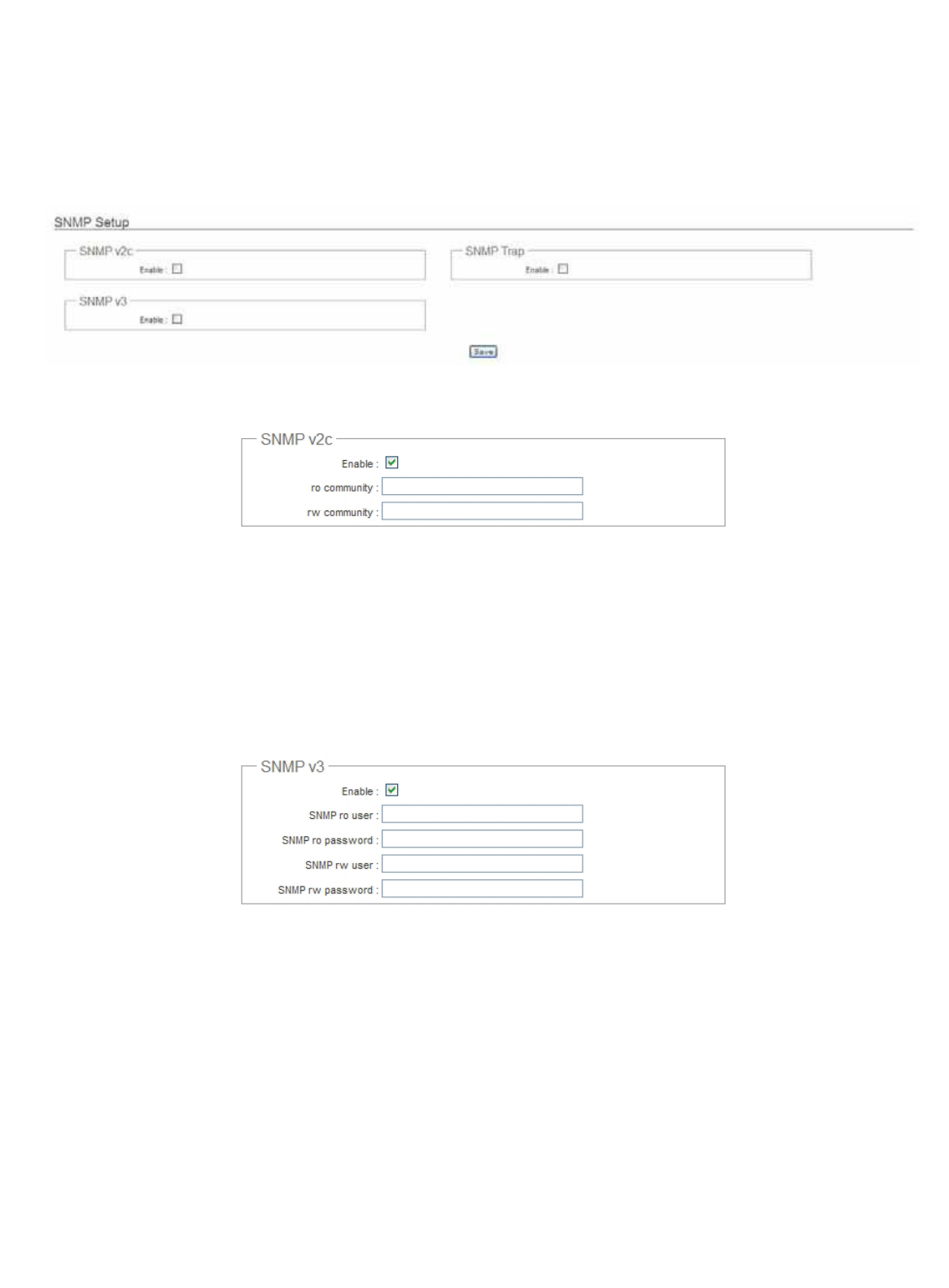
㻢㻜
Configure SNMP Setup
SNMP is an application-layer protocol that provides a message format for communication between SNMP managers and
agents. By enabling SNMP function, the administrator can obtain the system information remotely.
Please click on System -> SNMP Setup and follow the below setting.
SNMP v2c Enable : Check to enable SNMP v2c.
Îro community : Set a community string to authorize read-only access.
Îrw community : Set a community string to authorize read/write access.
SNMP v3 Enable: Check to enable SNMP v3.
SNMPv3 supports the highest level SNMP security.
ÎSNMP ro user : Set a community string to authorize read-only access.
ÎSNMP ro password : Set a password to authorize read-only access.
ÎSNMP rw user : Set a community string to authorize read/write access.
ÎSNMP rw password : Set a password to authorize read/write access.

㻢㻝
SNMP Trap : Events such as cold start, interface up & down, and association & disassociation will report to an
assigned server.
ÎCommunity : Set a community string required by the remote host computer that will receive trap messages or
notices send by the system.
ÎIP : Enter the IP addresses of the remote hosts to receive trap messages.
Click Save button to save changes and click Reboot button to activate.
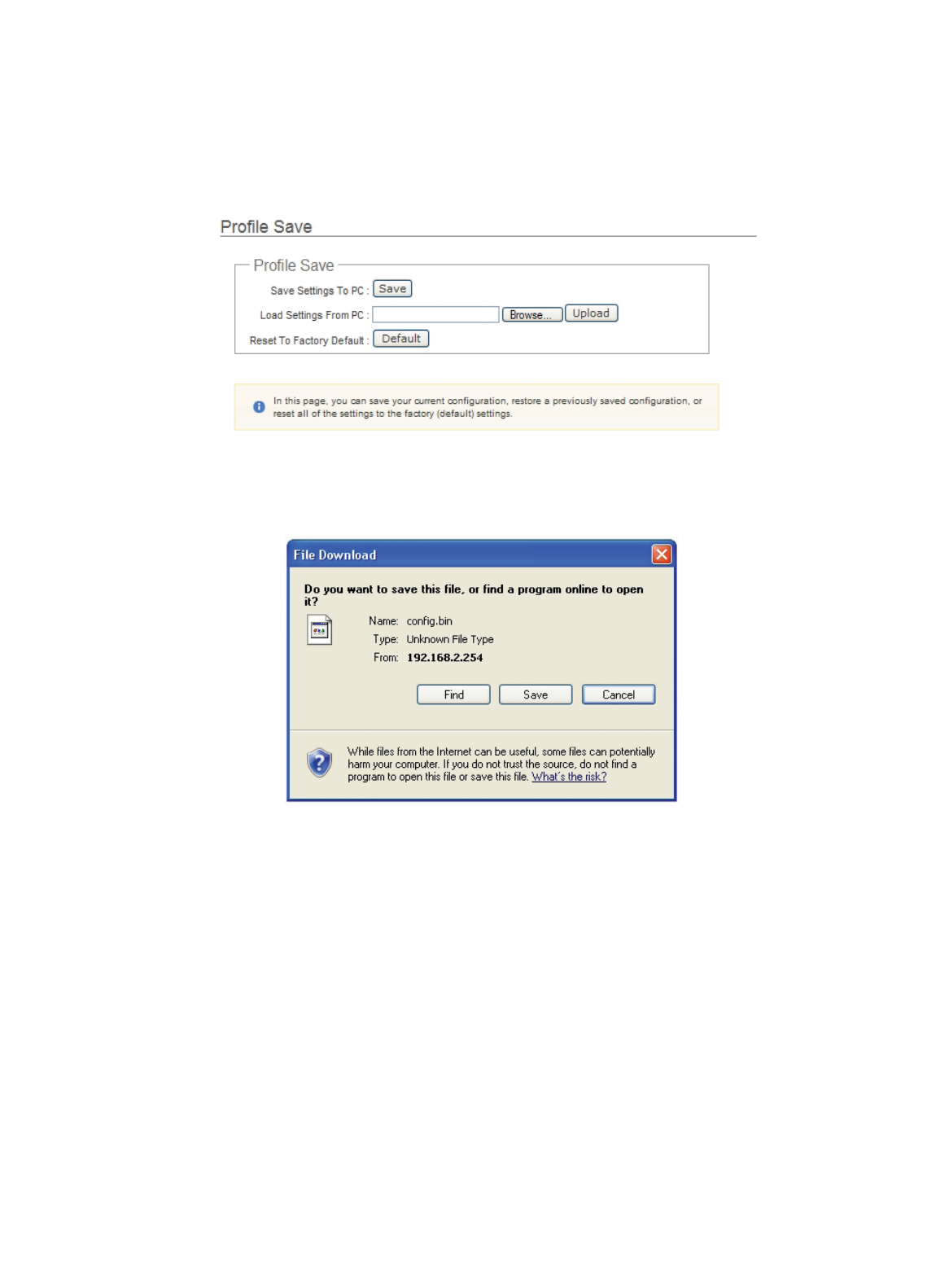
㻢㻞
Backup / Restore and Reset to Factory
Backup current configuration, restore prior configuration or reset back to factory default configuration can be executed via
this page.
Please click on Utilities -> Profile Setting and follow the below setting.
Save Settings to PC : Click Save button to save the current configuration to a local disk.
Load Settings from PC : Click Browse button to locate a configuration file to restore, and then click Upload button
to upload.
Reset To Factory Default : Click Default button to reset back to the factory default settings and expect Successful
loading message.Then, click Reboot button to activate.
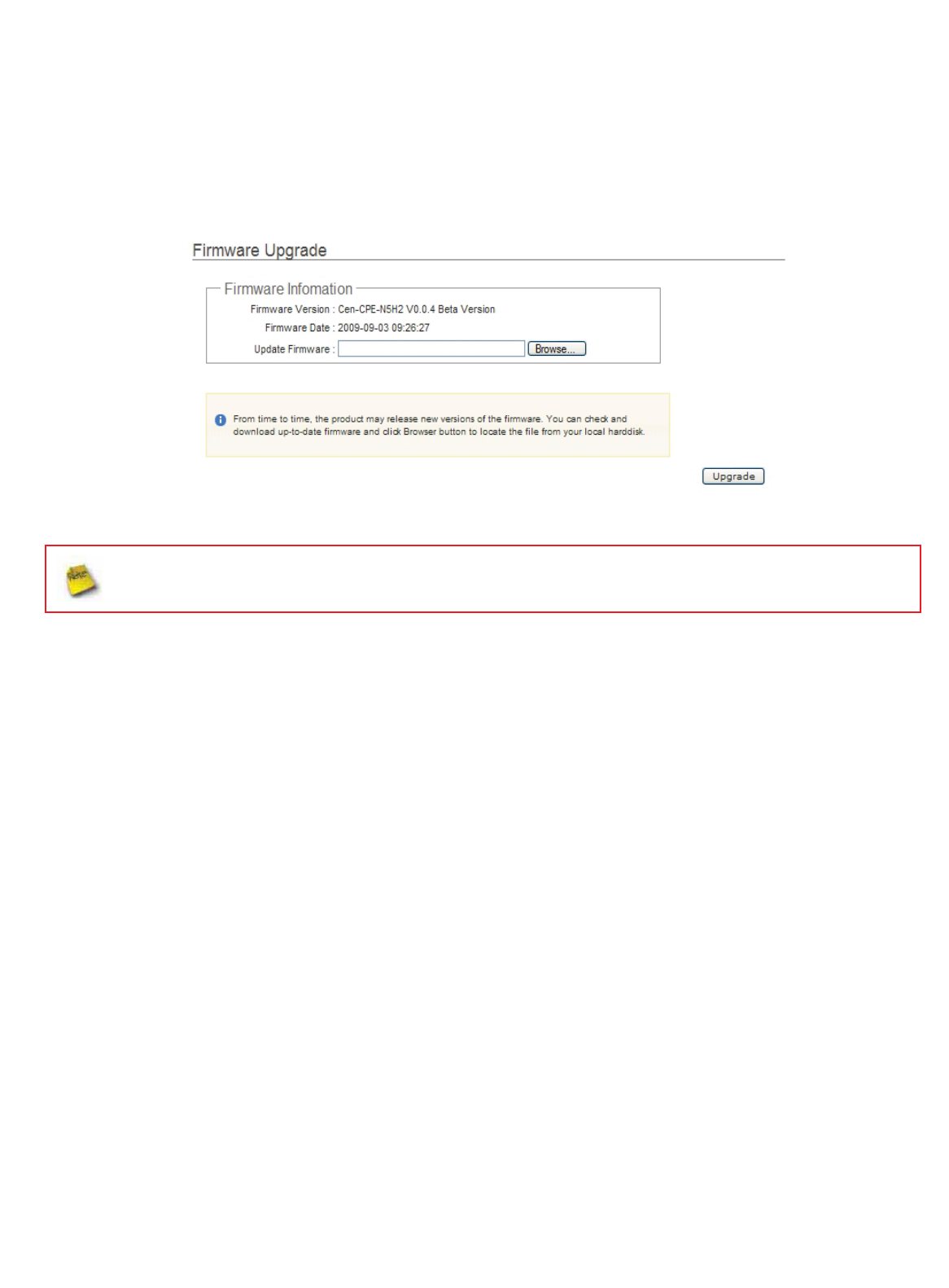
㻢㻟
Firmware Upgrade
Firmware is the main software image that system needs to respond to requests and to manage real time operations.
Firmware upgrades are sometimes required to include new features or bugs fix. It takes around 2minutes to upgrade
due to complexity of firmware. To upgrade system firmware, click Browse button to locate the new firmware, and then
click Upgrade button to upgrade.
1. To prevent data loss during firmware upgrade, please back up current settings before proceeding.
2. Do not interrupt during firmware upgrade including power on/off as this may damage system.
3. Never perform firmware upgrade over wireless connection or via remote access connection.

㻢㻠
Network Utility
The administrator can diagnose network connectivity via the PING and TRACEROUTE utility.
Please click on Utilities -> Network Utility and follow the below setting.
Ping : This utility will help ping other devices on the network to verify connectivity. Ping utility, using ICMP packets,
detects connectivity and latency between two network nodes. As result of that, packet loss and latency time are
available in the Result field while running the PING test.
ÎDestination IP/Domain : Enter desired domain name, i.e. www.google.com,or IP address of the destination,
and click ping button to proceed. The ping result will be shown in the Result field.
ÎCount : By default, it’s 5 and the range is from 1 to 50. It indicates number of connectivity test.
Traceroute : Allows tracing the hops from the TEW-676APBO device to a selected outgoing IP address. It should be
used for the finding the route taken by ICMP packets across the network to the destination host. The test is started
using the Start button, click Stop button to stopped test
ÎDestination Host : Specifies the Destination Host for the finding the route taken by ICMP packets across the
network.
ÎMAX Hop : Specifies the maximum number of hops( max time-to-live value) traceroute will probe.
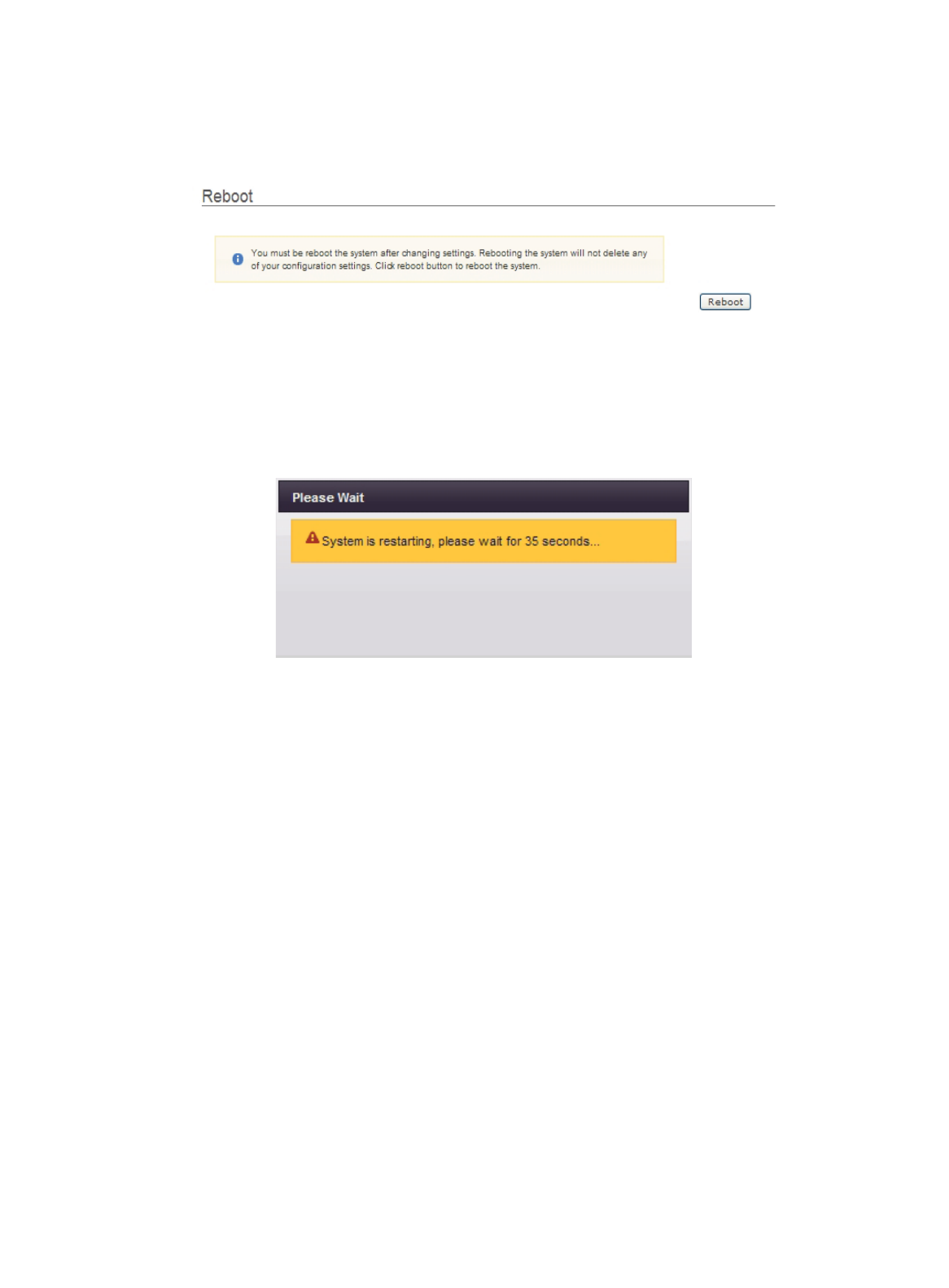
㻢㻡
Reboot
This function allows user to restart system with existing or most current settings when changes are made. Click Reboot
button to proceed and take around three minutes to complete.
A reminder will be available for remaining time to complete. If power cycle is necessary, please wait till completion of the
reboot process.
The System Overview page appears upon the completion of reboot.
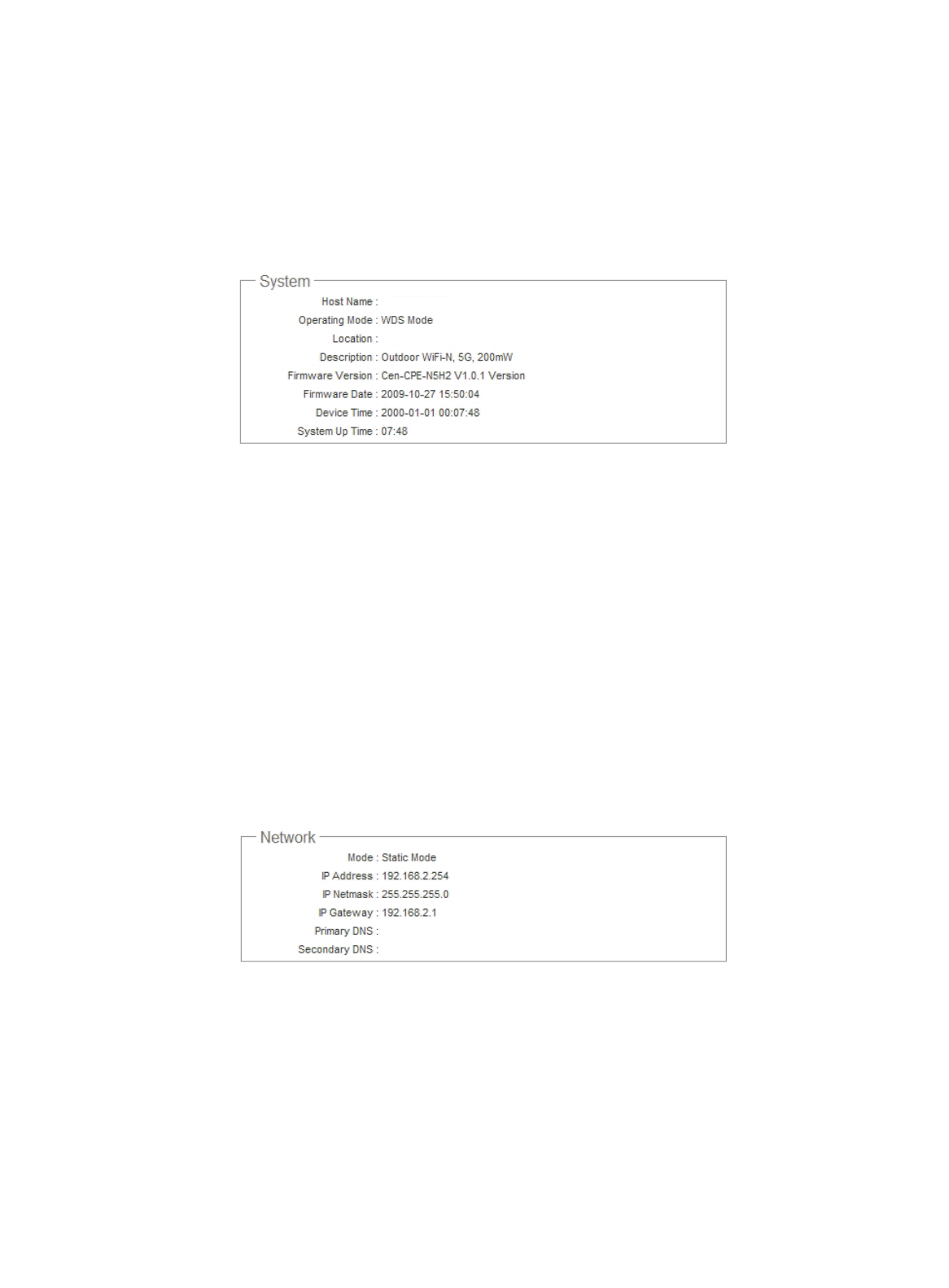
㻢㻢
System Status
This section breaks down into subsections of System Overview,WDS Link Status,Extra Information and Event Log.
System Overview
Detailed information on System,Network,LAN Information and Wireless Information can be reviewed via this page.
System : Display the information of the system.
ÎSystem Name : The name of the system.
ÎOperating Mode : The mode currently in service.
ÎLocation : The reminding note on the geographical location of the system.
ÎDescription : The reminding note of the system.
ÎFirmware Version : The current firmware version installed.
ÎFirmware Date : The build time of the firmware installed.
ÎDevice Time : The current time of the system.
ÎSystem Up Time : The time period that system has been in service since last reboot.
Network Information : Display the information of the Network.
ÎMode : Supports Static or Dynamic modes on the LAN interface.
ÎIP Address : The management IP of system. By default, it’s 192.168.2.254.
ÎIP Netmask : The network mask. By default, it’s 255.255.255.0.
ÎIP Gateway : The gateway IP address and by default, it’s 192.168.2.1.
ÎPrimary DNS : The primary DNS server in service.
ÎSecondary DNS : The secondary DNS server in service.
/TEW-676APBO
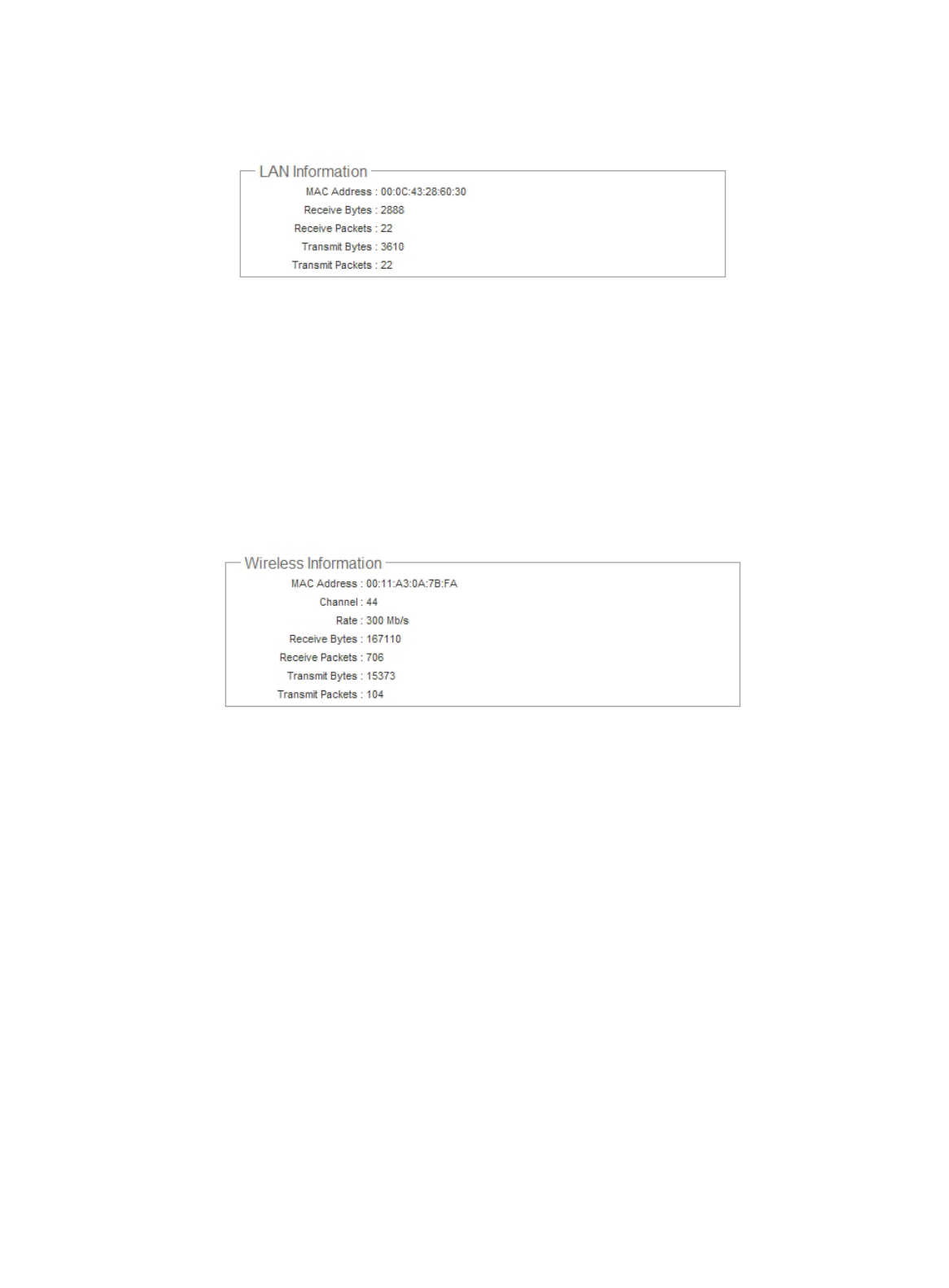
㻢㻣
LAN Information : Display total received and transmitted statistics on the LAN interface.
ÎMAC Address : The MAC address of the LAN port.
ÎReceive bytes : The total received packets in bytes on the LAN port.
ÎReceive packets : The total received packets of the LAN port.
ÎTransmit bytes : The total transmitted packets in bytes of the LAN port.
ÎTransmit packets : The total transmitted packets of the LAN port.
Wireless Information : Display the detailed receive and transmit statistics of Wireless interface.
ÎMAC Address : The MAC address of the Wireless port.
ÎChannel : The current channel on the Wireless port.
ÎRate : The current Bit Rate on the Wireless port.
ÎReceive bytes : The total received packets in bytes on the Wireless port.
ÎReceive packets : The total received packets of the Wireless port.
ÎTransmit bytes : The total transmitted packets in bytes of the Wireless port.
ÎTransmit packets : The total transmitted packets of the Wireless port.
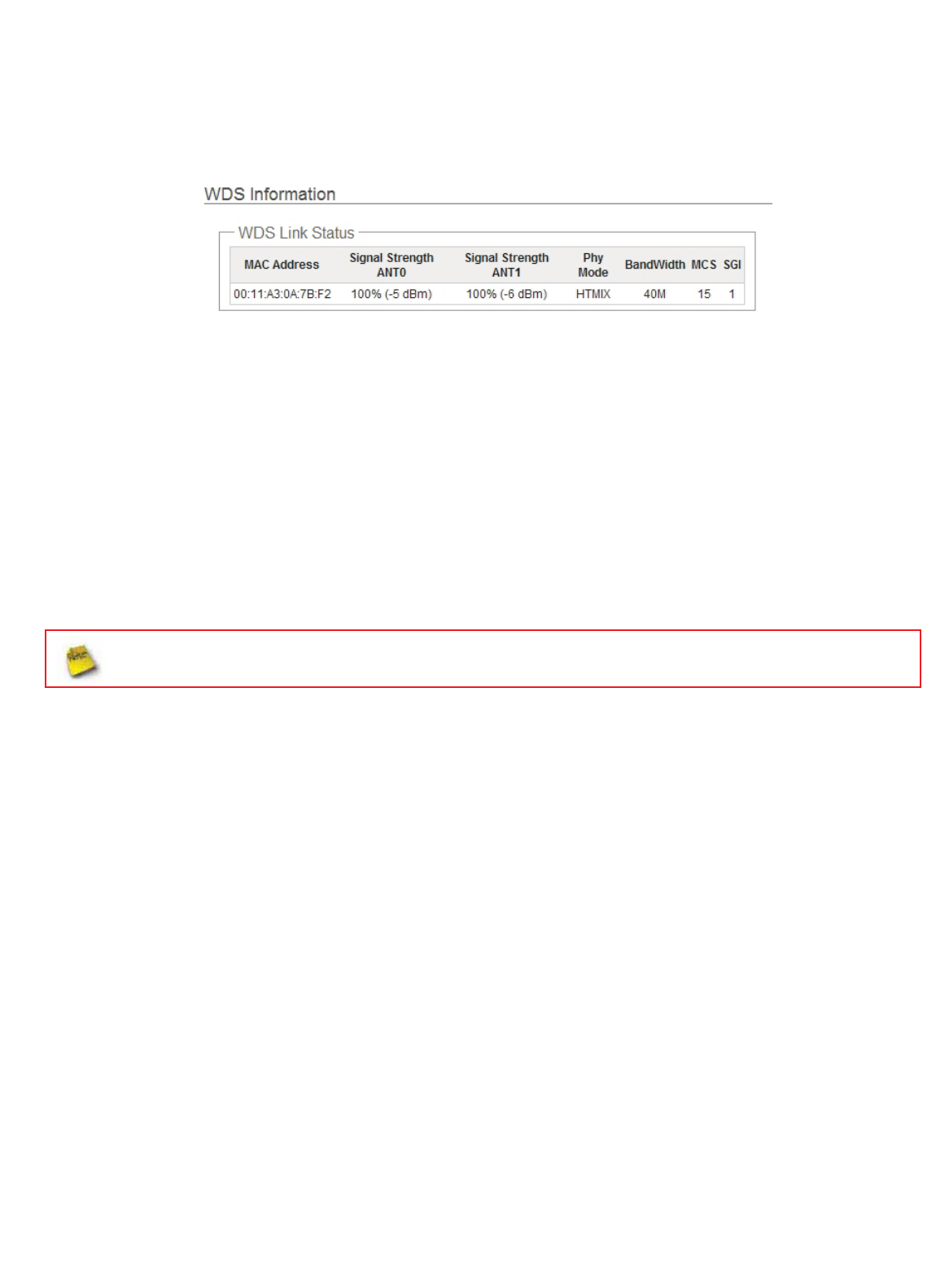
㻢㻤
WDS List
Peers MAC Address, antenna 0/1 received signal strength, phy mode and channel bandwidth for each WDS are
available.
MAC Address : Display MAC address of WDS peer.
Signal Strength ANT0/ANT1 : Indicate the signal strength of the respective WDS links.
Phy Mode : Indicate the phy mode of the respective WDS linked.
BandWidth : Indicate the channel bandwidth of the respective WDS linked.
MCS : Indicate the MCS of the respective WDS linked.
SGI : Indicate the SGI (Short Guard Interval) of the respective WDS linked. “1” indicate the Short Guard Interval, “0”
indicate the Long Guard Interval.
If display “no signal” Signal Strength ANT0/ANT1, you need check WDS configuration. Things to verify are
MAC Address,Channel and Security type. Also,adjust antenna angle and Tx Power.
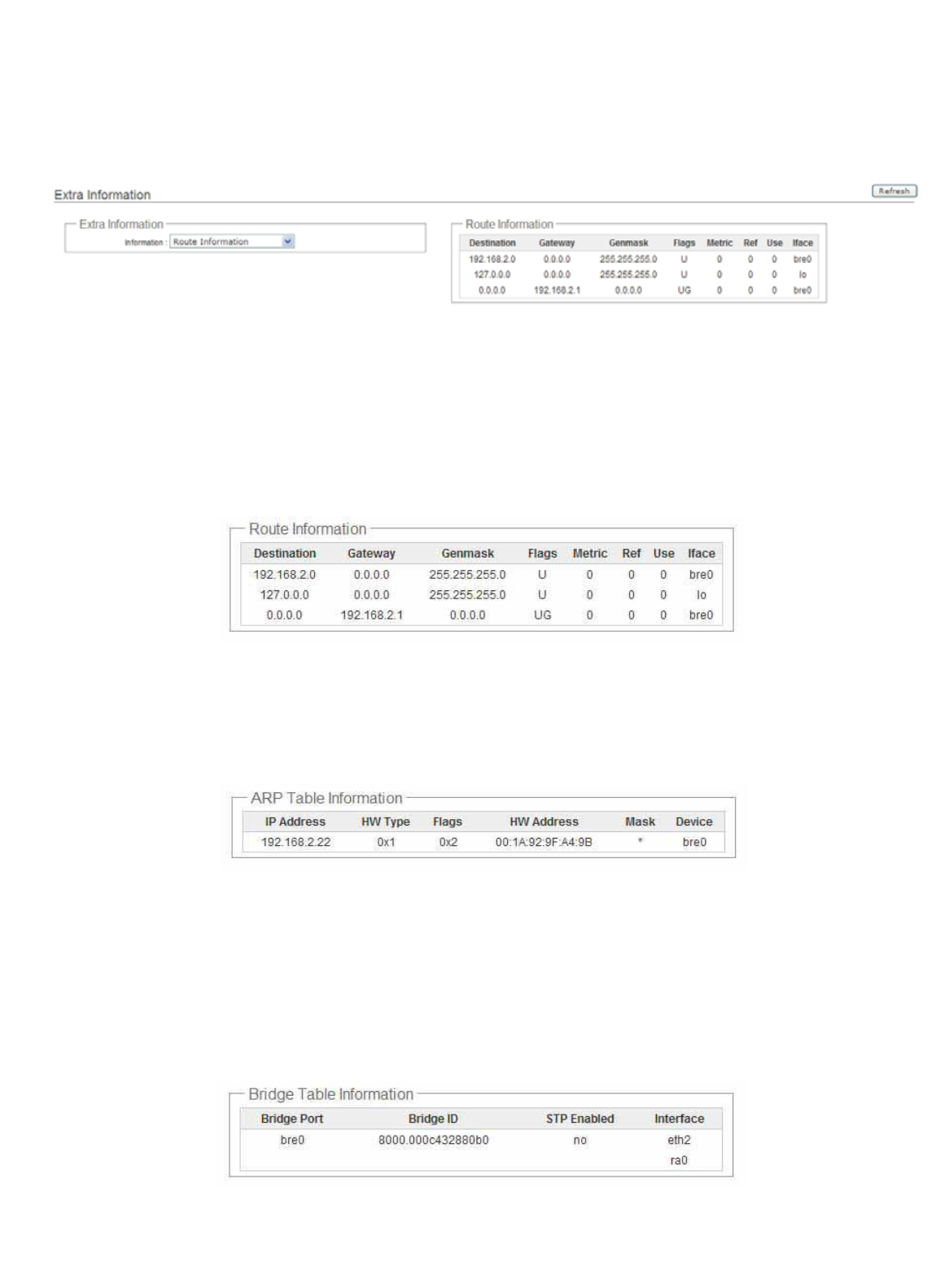
㻢㻥
Extra Information
Users could pull out information such as Route table, ARP table, MAC table, Bridge table or STP available in the drop-
down list from system. The “Refresh” button is used to retrieve latest table information.
Route table information : Select “Route table information” on the drop-down list to display route table.
WCB1200H2PX could be used as a L2 or L3 device. It doesn’t support dynamic routing protocols such as RIP or
OSPF. Static routes to specific hosts, networks or default gateway are set up automatically according to the IP
configuration of system's interfaces. When used as a L2 device, it could switch packets and, as L3 device, it’s
capable of being a gateway to route packets inward and outward.
ARP table Information : Select “ARP Table Information” on the drop-down list to display ARP table.
ARP associates each IP address to a unique hardware address (MAC) of a device. It is important to have a unique IP
address as final
destination to switch
packets to.
Bridge table information : Select “Bridge Table information” on the drop-down list to display bridge table.
Bridge table will show Bridge ID and STP's Status on the each Ethernet bridge and its attached interfaces, the Bridge
Port should be attached to some interfaces (e.g. eth2, ra0 and wds0~wds3).
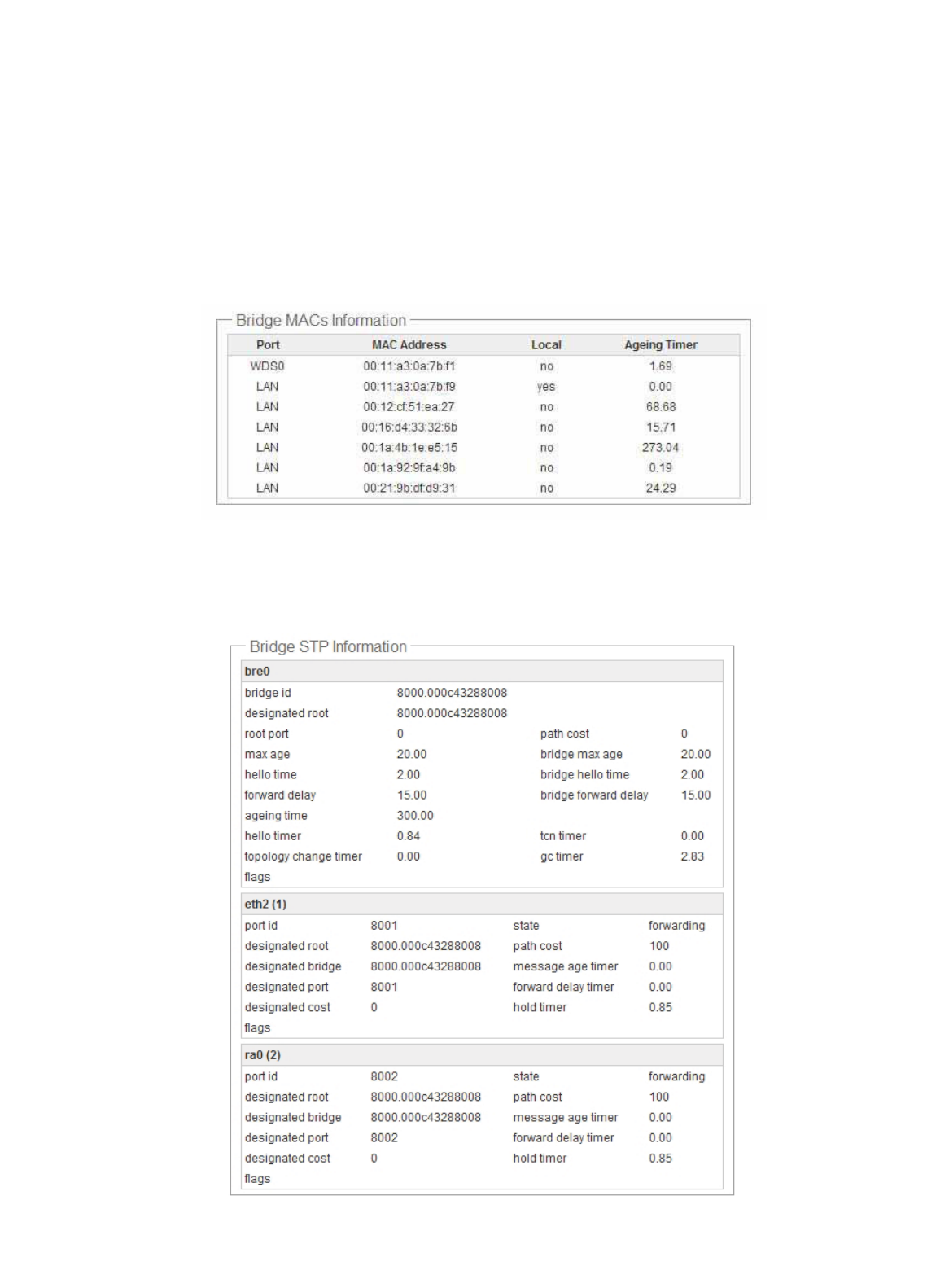
㻣㻜
Bridge MAC information : Select “Bridge MACs Information” on the drop-down list to display MAC table.
This table displays local MAC addresses associated with wired or wireless interfaces, but also remember non-local
MAC addresses learned from wired or wireless interfaces.
Ageing timers will be reset when existing MAC addresses in table are learned again or added when new MAC
addresses are seen from wired or wireless interfaces as well. When time runs out for a particular entry, it will be
pruned from the table. In that situation, switching packet to that particular MAC address will be discontinued.
Bridge STP Information : Select “Bridge STP Information” on the drop-down list to display a list of bridge STP
information.

㻣㻝
Event Log
The Event log displays system events when system is up and running. Also, it becomes very useful as a troubleshooting
tool when issues are experienced in system.
Time : The date and time when the event occurred.
Facility : It helps users to identify source of events such “System” or “User”
Severity : Severity level that a specific event is associated such as “info”, “error”, “warning”, etc.
Message : Description of the event.
Click Refresh button to renew the log, or click Clear button to clear all the record.
CPE Mode Configuration
When CPE mode is chosen, the system can be configured as a Customer Premises Equipment(CPE). This section
provides detailed explanation for users to configure in the CPE mode with help of illustrations. In the CPE mode, functions
listed in the table below are also available from the Web-based GUI interface.
OPTION SystemWireless Advance Utilities Status
Functions
Operating Mode General Setup DMZ Profiles SettingsSystem Overview
WAN Wireless Profile IP Filter Firmware Upgrade Station Statistics
LAN Site Survey MAC Filter Network Utility Extra Info
DDNSVirtual Server Reboot QoS Plot
Management Parental Control Event Log
Time Server QoS
UPNP
SNMP
CPE Mode Functions

㻣㻞
External Network Connection
Network Requirement
It can be used as an Outdoor Customer Premises Equipment (CPE) to receive wireless signal over last mile application,
helping WISPs deliver wireless broadband Internet service to residents and business customers. In the CPE mode, TEW-
676APBO is a gateway enabled with NAT and DHCP Server functions. The wired clients connected to TEW-676APBO
are in different subnet from those connected to Main Base Station, and, in CPE mode, it does not accept wireless
association from wireless clients.
Figure 5-1 CPE mode network configuration
SSID: Main
_
AP
192.168.2.x
Internet
WIFI WAN
192.168.1.254
Main Base Station
192.168.1.150 LAN
192.168.2.254
NAT
TEW-676APBO
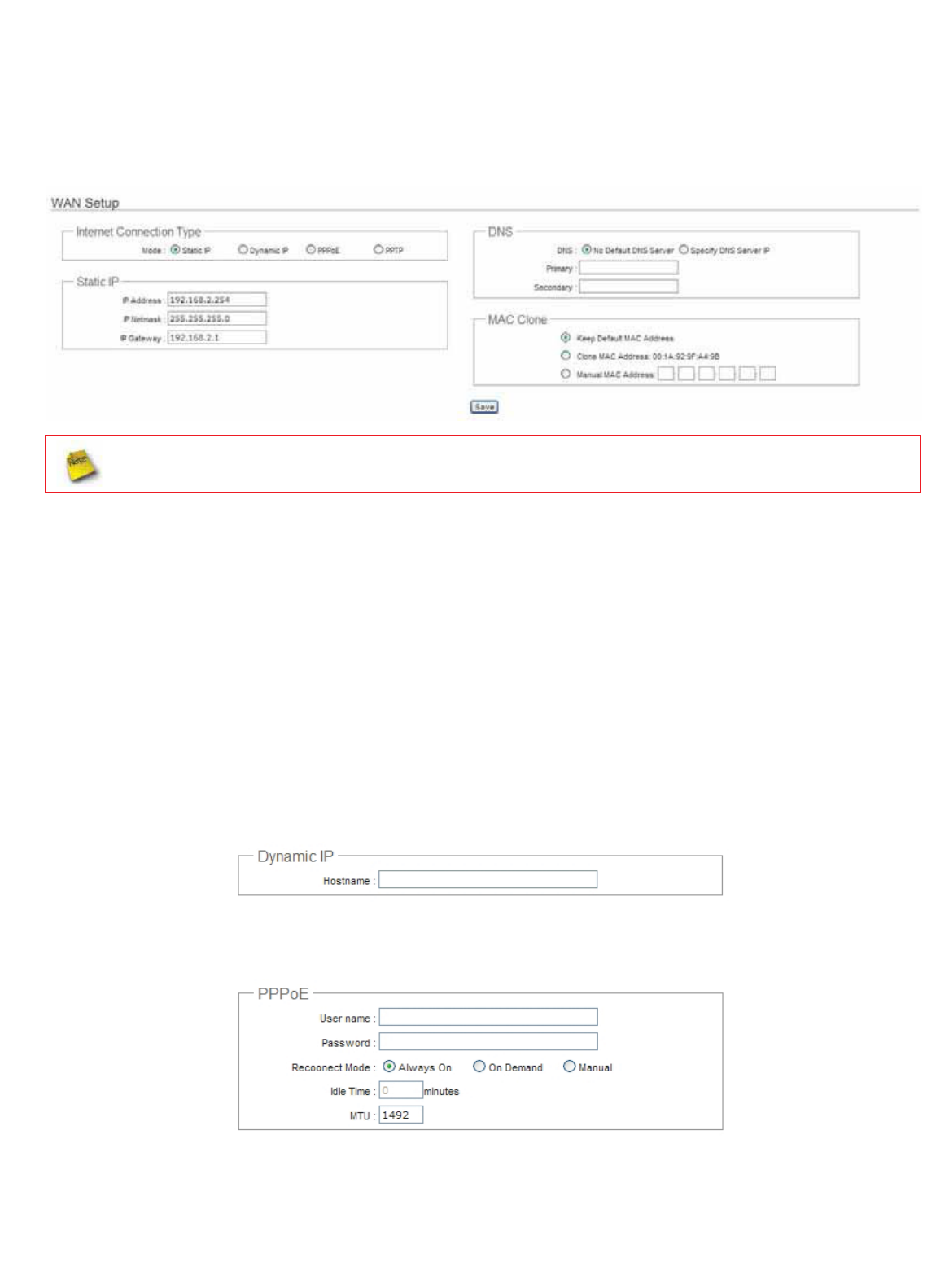
㻣㻟
Configure WAN Setup
There are three connection types for the WAN port : Static IP,Dynamic IP,PPPoE and PPTP.
Please click on System -> WAN and follow the below setting.
In CPE mode, the WAN Port is the Wireless interface.
Mode : By default, it’s “Static IP”. Check “Static IP”, “Dynamic IP”, “PPPoE” or “PPTP”to set up system WAN IP.
ÎStatic IP : Users can manually setup the WAN IP address with a static IP provided by WISP.
9IP Address : The IP address of the WAN port; default IP address is 192.168.1.254
9IP Netmask : The Subnet mask of the WAN port; default Netmask is 255.255.255.0
9IP Gateway : The default gateway of the WAN port; default Gateway is 192.168.1.1
ÎDynamic IP : Please consult with WISP for correct wireless settings to associate with WISP AP before a
dynamic IP, along with related IP settings including DNS can be available from DHCP server. If IP Address is not
assigned, please double check with your wireless settings and ensure successful association. Also, you may
go to “WAN Information” in the Overview page to click Release button to release IP address and click Renew
button to renew IP address again.
9Hostname : The Hostname of the WAN port
ÎPPPoE : To create wireless PPPoE WAN connection to a PPPoE server in network.

㻣㻠
9User Name : Enter User Name for PPPoE connection
9Password : Enter Password for PPPoE connection
9Reconnect Mode :
xAlways on – A connection to Internet is always maintained.
xOn Demand – A connection to Internet is made as needed.
When Time Server is enabled at the “On Demand” mode, the “Reconnect Mode” will turn out “Always on”.
xManual – Click the “Connect” button on “WAN Information” in the Overview page to connect to the
Internet.
9Idle Time : Time to last before disconnecting PPPoE session when it is idle. Enter preferred Idle Time in
minutes. Default is “0”, indicates disabled. When Idle time is disabled, the “Reconnect Mode” will turn out
“Always on”
9MTU : By default, it’s 1492 bytes. MTU stands for Maximum Transmission Unit. Consult with WISP for a
correct MTU setting.
ÎPPTP : The Point-to-Point Tunneling Protocol (PPTP) mode enables the implementation of secure multi-protocol Virtual
Private Networks (VPNs) through public networks.
9IP Address : The IP address of the WAN port
9IP Netmask : The Subnet mask of the WAN port
9PPTP Server IP Address : The IP address of the PPTP server
9User Name : Enter User Name for PPTP connection
9Password : Enter Password for PPTP connection
9Reconnect Mode :
xAlways on – A connection to Internet is always maintained.
xOn Demand – A connection to Internet is made as needed.
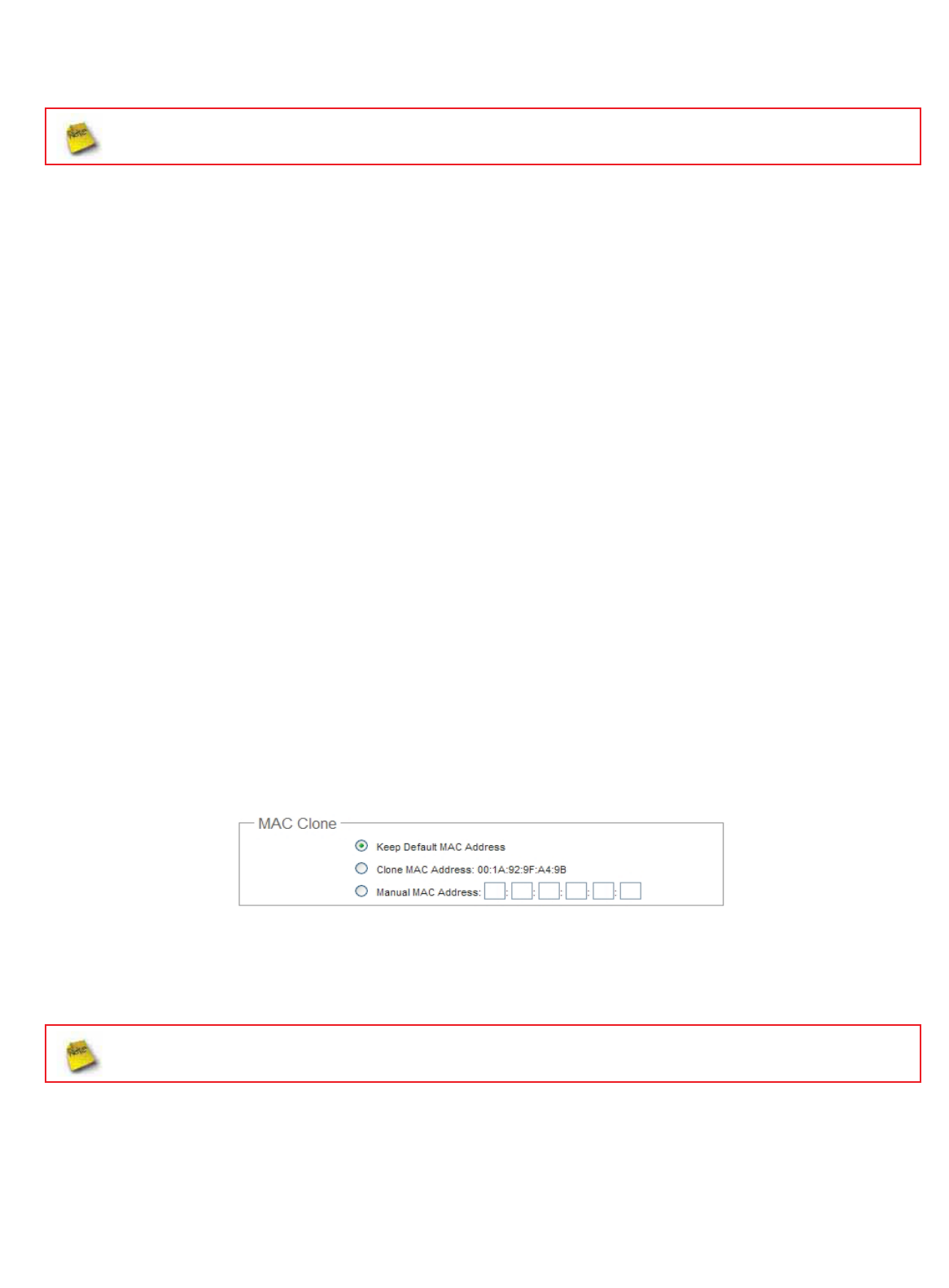
㻣㻡
When Time Server is enabled at the “On Demand” mode, the “Reconnect Mode” will turn out “Always on”.
xManual – Click the “Connect” button on “WAN Information” in the Overview page to connect to the
Internet.
9Idle Time : Time to last before disconnecting PPPoE session when it is idle. Enter preferred Idle Time in
minutes. Default is “0”, indicates disabled. When Idle time is disabled, the “Reconnect Mode” will turn out
“Always on”
9MTU : By default, it’s 1460 bytes. MTU stands for Maximum Transmission Unit. Consult with WISP for a
correct MTU setting.
9MPPE Encryption : Microsoft Point-to-Point Encryption (MPPE) encrypts data in Point-to-Point
Protocol(PPP)-based dial-up connections or Point-to-Point Tunneling Protocol (PPTP) virtual private
network (VPN) connections. 128-bit key (strong) and 40-bit key (standard) MPPE encryption schemes are
supported. MPPE provides data security for the PPTP connection that is between the VPN client and the
VPN server.
DNS : Check “No Default DNS Server” or “Specify DNS Server IP” radial button as desired to set up system DNS.
ÎPrimary : The IP address of the primary DNS server.
ÎSecondary : The IP address of the secondary DNS server.
MAC Clone : The MAC address is a 12-digit HEX code uniquely assigned to hardware as identification. Some ISPs
require you to register a MAC address in order to access to Internet. If not, you could use default MAC or clone MAC
from a PC. (CPE+AP Mode does not support MAC Clone function)
ÎKeep Default MAC Address : Keep the default MAC address of WAN port on the system.
ÎClone MAC Address : If you want to clone the MAC address of the PC, then click the Clone MAC Address
button. The system will automatically detect your PC's MAC address.
The Clone MAC Address field will display MAC address of the PC connected to system. Click “Save” button
can make clone MAC effective.
ÎManual MAC Address : Enter the MAC address registered with your ISP.
Click Save button to save your changes. Click Reboot button to activate your changes

㻣㻢
Configure DDNS Setup
Dynamic DNS allows you to map domain name to dynamic IP address.
Please click on System -> DDNS Setup and follow the below setting.
Enabled: By default, it’s “Disable”.The mapping domain name won’t change when dynamic IP changes. The beauty
of it is no need to remember the dynamic WAP IP while accessing to it.
Service Provider: Select the preferred Service Provider from the drop-down list including dyndns,dhs,ods and tzo
Hostname: Host Name that you register to Dynamic-DNS service and export.
User Name & Password: User Name and Password are used to login DDNS service.
Click Save button to save your changes. Click Reboot button to activate your changes
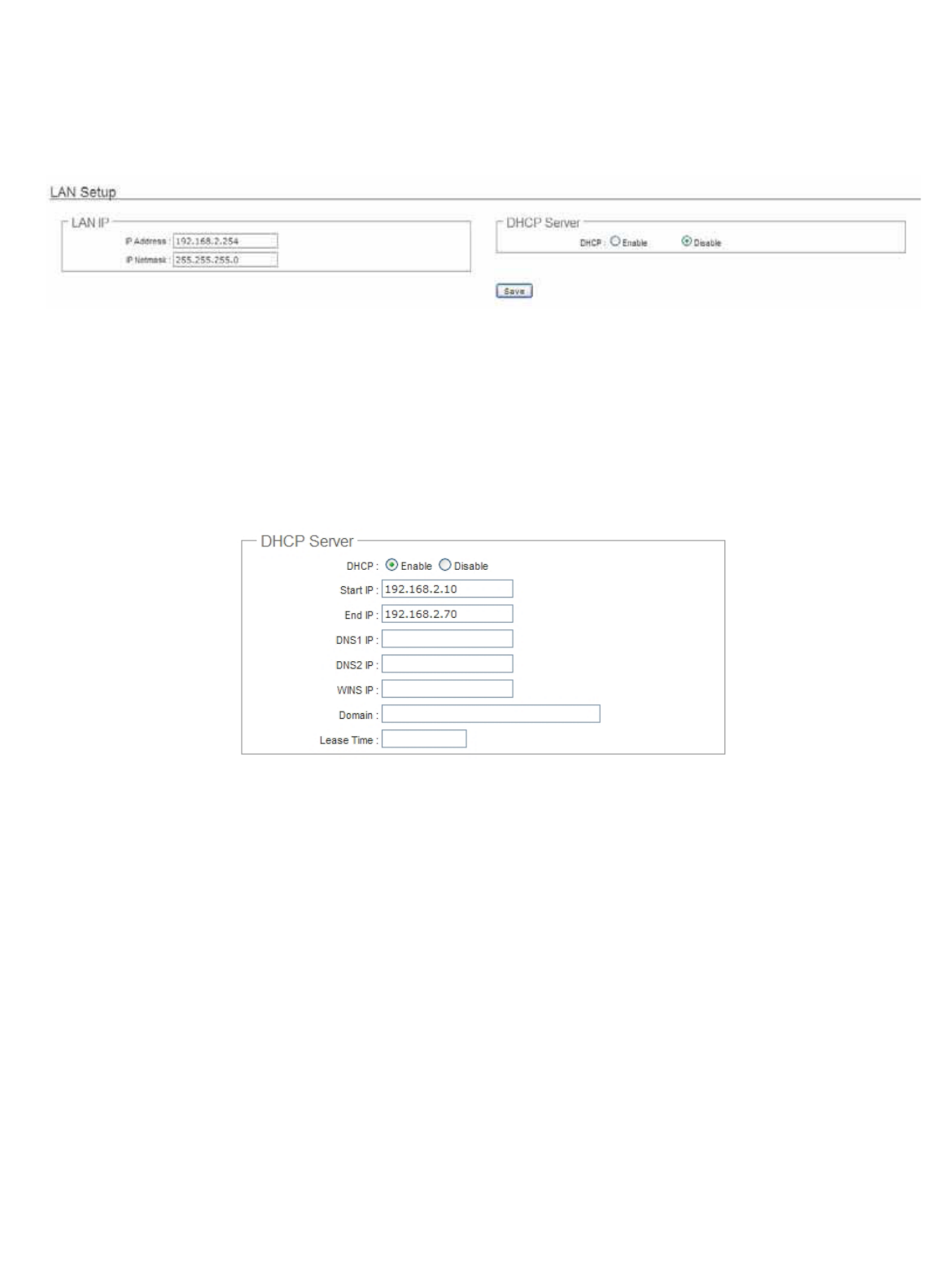
㻣㻣
Configure LAN Setup
Here are the instructions for how to setup the local IP Address and Netmask.
Please click on System -> LAN and follow the below setting.
LAN IP : The administrator can manually setup the LAN IP address.
ÎIP Address : The IP address of the LAN port; default IP address is 192.168.2.254
ÎIP Netmask : The Subnet mask of the LAN port; default Netmask is 255.255.255.0
DHCP Setup : Devices connected to the system can obtain an IP address automatically when this service is
enabled.
ÎDHCP : Check Enable button to activate this function or Disable to deactivate this service.
ÎStart IP / End IP: Specify the range of IP addresses to be used by the DHCP server when assigning IP address
to clients. The default range IP address is 192.168.2.10 to 192.168.2.70, the netmask is 255.255.255.0
ÎDNS1 IP : Enter IP address of the first DNS server; this field is required.
ÎDNS2 IP : Enter IP address of the second DNS server; this is optional.
ÎWINS IP : Enter IP address of the Windows Internet Name Service (WINS) server; this is optional.
ÎDomain : Enter the domain name for this network.
ÎLease Time : The IP addresses given out by the DHCP server will only be valid for the duration specified by
the lease time. Increasing the time ensure client operation without interruptions, but could introduce potential
conflicts. Lowering the lease time will avoid potential address conflicts, but might cause more interruptions to the
client while it will acquire new IP addresses from the DHCP server. Default is 86400 seconds
Click Save button to save your changes. Click Reboot button to activate your changes
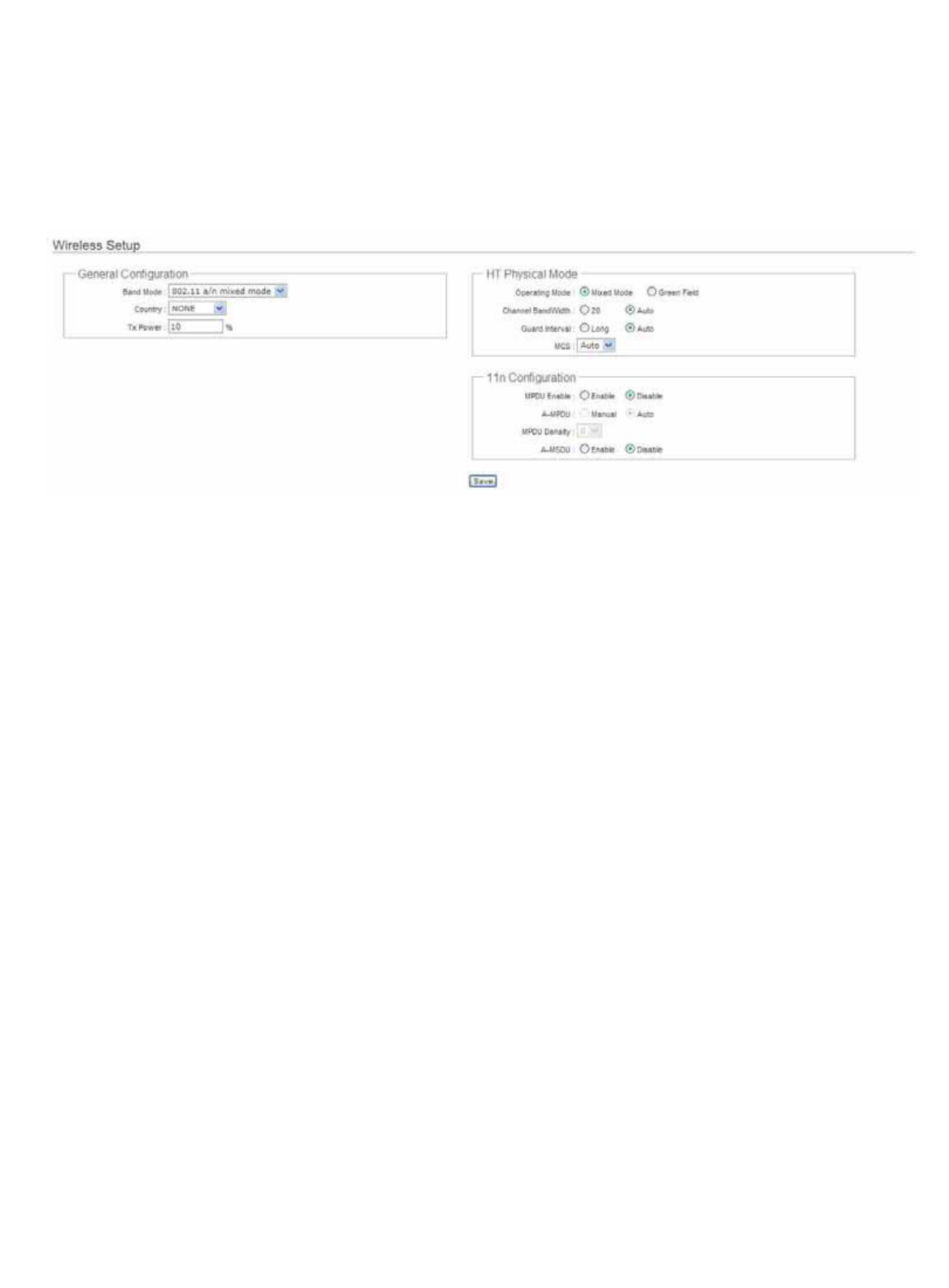
㻣㻤
Access Point Association
Configure Wireless General Setting
The administrator can change the data transmission, channel and output power settings for the system. Please click on
Wireless -> General Setup and follow the below setting.
Band Mode : Select an appropriate wireless band; bands available are 801.11a or 802.11a/n mixed mode.
Country : Select the desired country code from the drop-down list; the options are US,ETSI,JP and NONE.
Tx Power : You can adjust the output power of the system to get the appropriate coverage for your wireless network.
Specify digit number between 1to 100 (the unit is %) for your environment. If you are not sure of which setting to
choose, then keep the default setting, 100%.
When Band Mode select in 802.11a only mode, the HT(High Throughput) Physical Mode and 11n Configuration
settings should be hidden immediately.
Operating Mode : By default, it's Mixed Mode.
ÎMixed Mode : In this mode packets are transmitted with a preamble compatible with the legacy 802.11a/g, the
rest of the packet has a new format. In this mode the receiver shall be able to decode both the Mixed Mode
packets and legacy packets.
ÎGreen Field : In this mode high throughput packets are transmitted without a legacy compatible part.
Channel Bandwidth : The "Auto” MHz option is usually best. The other option is available for special circumstances.
Guard Interval : Using“Auto” option can increase throughput. However, it can also increase error rate in some
installations, due to increased sensitivity to radio-frequency reflections. Select the option that works best for your
installation.

㻣㻥
MCS : This parameter represents transmission rate. By default (Auto) the fastest possible transmission rate will be
selected. You have the option of selecting the speed if necessary. (Refer to Appendix C. MCS Data Rate)
MPDU Enable : Check Enable button to activate this function, and Disable to deactivate.
A-MPDU : A-MPDU (Aggregated Mac Protocol Data Unit) allows the transmissions of multiple Ethernet frames to a
single location as burst of up to 64kbytes This is performed on the hardware itself. Select “Manual” to set “MPDU
Density”
MPDU Density : Minimum separation of MPDUs in an A-MPDU.
01234567
No Restriction ¼ μs ½ μs 1 μs 2 μs 4 μs 8 μs 16 μs
A-MSDU : Aggregated Mac Service Data Unit, A-MSDU. Select Enable to allows aggregation for multiple MSDUs in
one MPDU. Default is disabled.
Click Save button to save your changes. Click Reboot button to activate your changes.
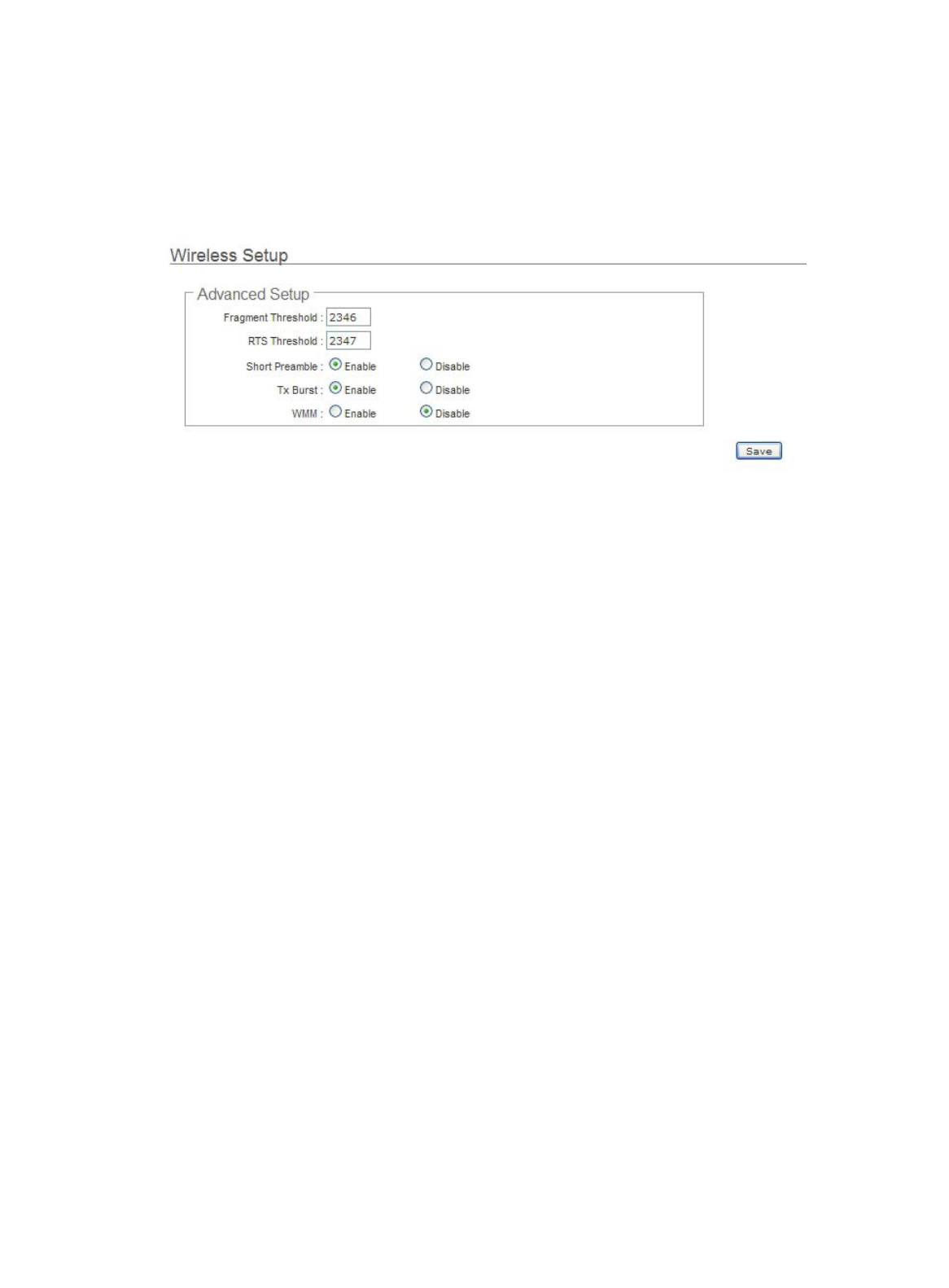
㻤㻜
Configure Wireless Advanced Setting
To achieve optimal wireless performance, it is necessary to tweak advance setting per requirements properly, not
necessary higher the better or lower.
The administrator can change the RTS threshold and fragmentation threshold settings for the system. Please click on
Wireless -> Advanced Setup and follow the below setting.
Fragment Threshold : The Fragment Threshold is in the range of 256~2346 byte. The default is 2346 byte.
Each Wi-Fi packet can be divided into smaller packets, marked with a sequential fragment number and re-assemble
in the receiving ends. The purpose is to make a short frame, instead of long frame, transmitting by radio in a heavy
noisy environment. Because of sending smaller frames, corruptions are much less likely to occur. The pros is
obvious, the cons is the overhead for transmission. So, in a clean environment, higher fragment threshold can be an
option to increase throughput.
Fragmentation will be triggered by setting the Fragment Threshold, usually in Byte-length. Only when the frame size
is over the Threshold, fragmentation will take place automatically.
RTS Threshold : RTS Threshold is in the range of 1~2347 byte. The default is 2347 byte.
The main purpose of enabling RTS by changing RTS threshold is to reduce possible collisions due to hidden wireless
clients. RTS in AP will be enabled automatically if the packet size is larger than the Threshold value. By default, RTS
is disabled in a normal environment supports non-jumbo frames.
Short Preamble : By default, it’s “Auto”. To Disable is to use Long 128-bit Preamble Synchronization field.
The preamble is used to signal "here is a train of data coming" to the receiver. The short preamble provides 72-bit
Synchronization field to improve WLAN transmission efficiency with less overhead.
Tx Burst : By default, it’s “Enable”. To Disable is to deactivate Tx Burst.
With TX burst enabled, AP will send many packets in a burst, without collision detection and RTS/CTS for each packet. TX
Burst have better throughput but cause interference with other APs in channel.
WMM : By default, it's “Disable”. Select Enable, the packets with QoS WMM will have higher priority.
Click Save button to save your changes. Click Reboot button to activate your changes.
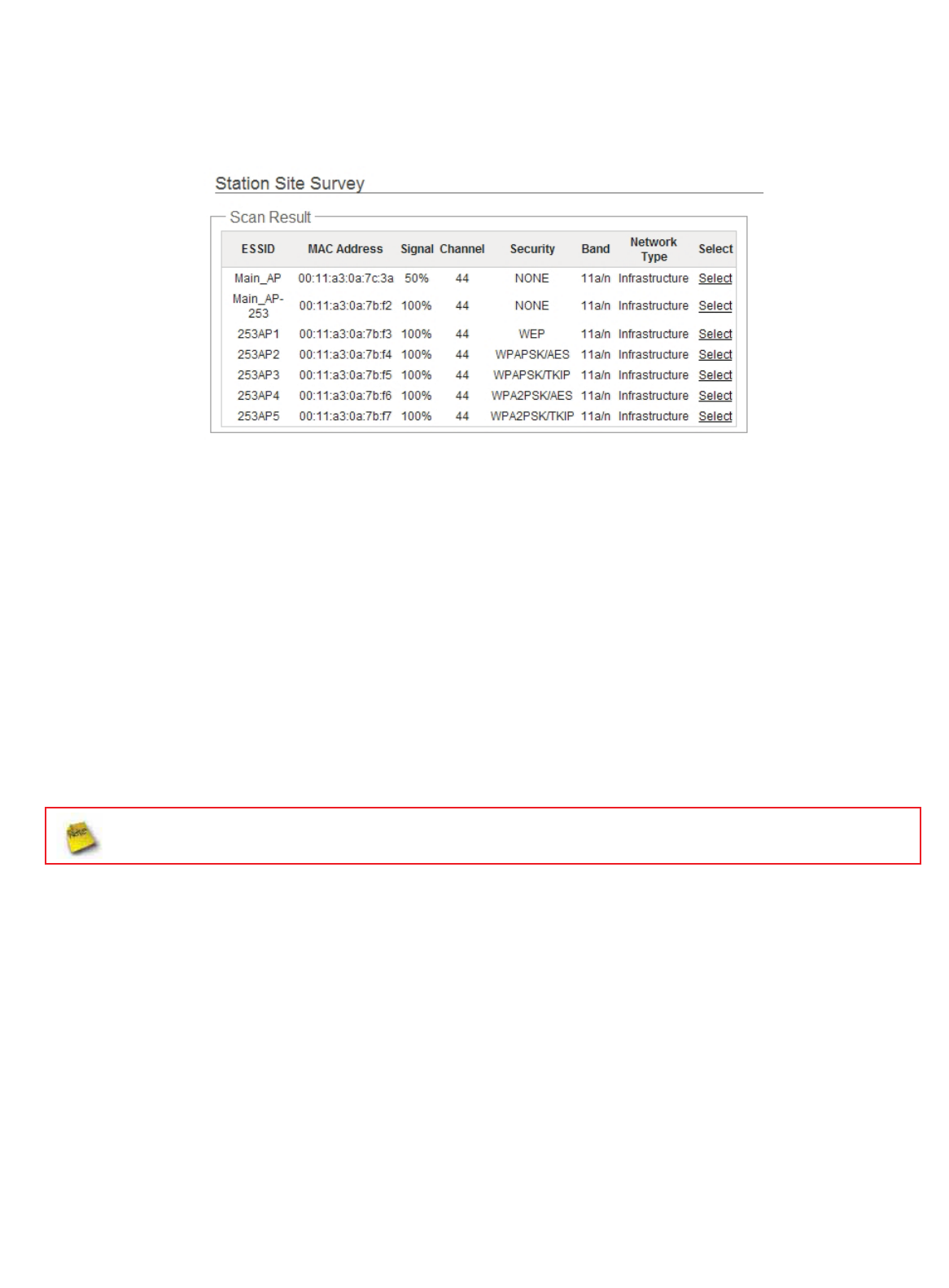
㻤㻝
Site Survey
Use this tool to scan and locate WISP Access Points and select one to associate with.
Please click on Wireless -> Site Survey. Below depicts an example for site survey.
ESSID : Available Extend Service Set ID of surrounding Access Points.
MAC Address : MAC addresses of surrounding Access Points.
Signal : Received signal strength of all found Access Points.
Channel : Channel numbers used by all found Access Points.
Security : Security type by all found Access Points.
Band : Wireless band used by all found Access Points.
Network Type : Network type used by all found Access Points.
Select : Click “Select” to configure settings and associate with chosen AP.
While clicking “Select” button in the Site Survey Table, the “ESSID” and “Security Type” will apply in the
Wireless Profile Setup. However, more settings are needed including Security Key.
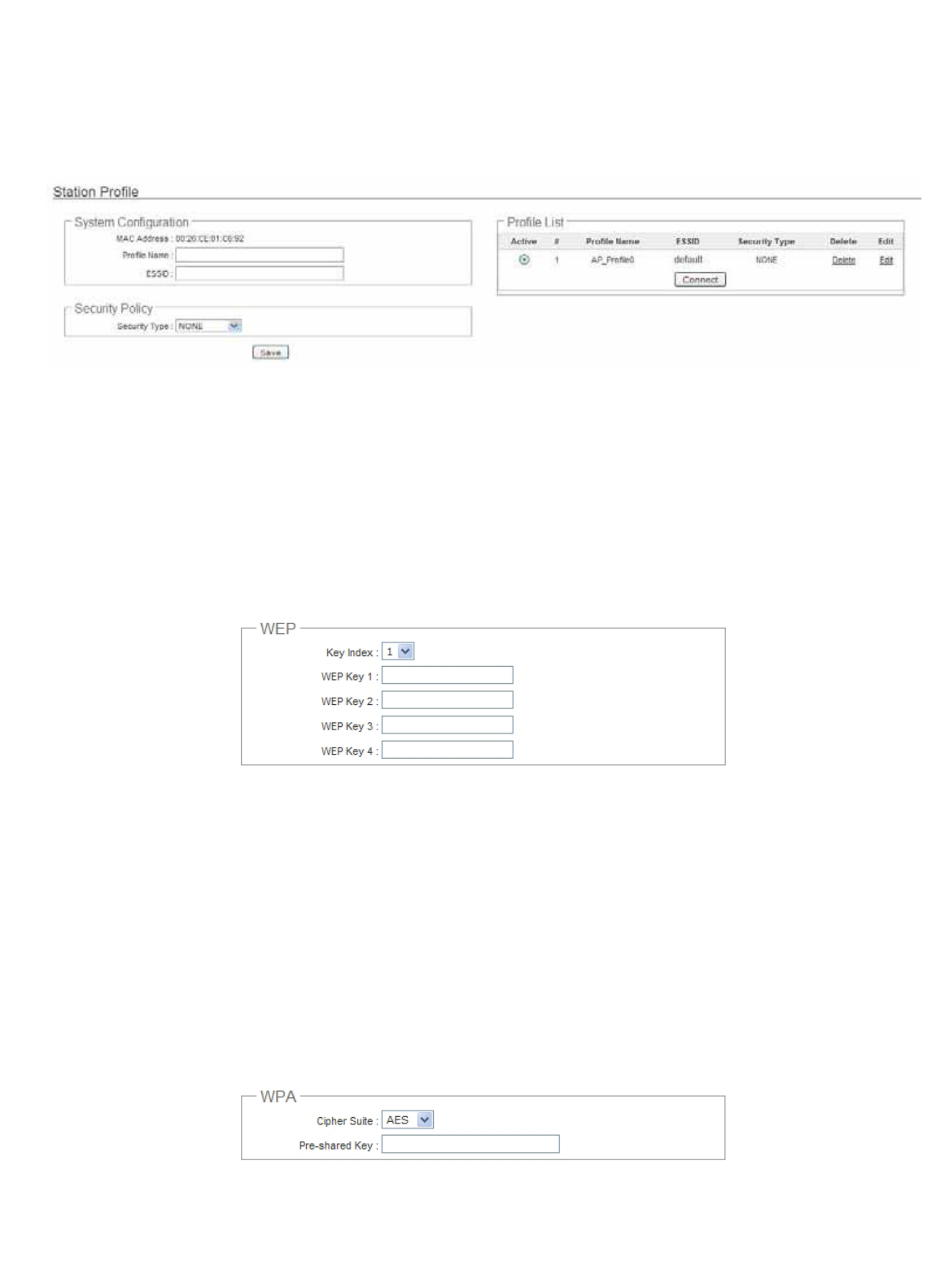
㻤㻞
Create Wireless Profile
The administrator can configure station profiles via this page.
Please click on Wireless -> Wireless Profile and follow the below setting.
MAC Address : The MAC address of the Wireless Station is displayed here.
Profile Name : Set different profiles for quick connection uses.
ESSID : AssignService Set ID for the wireless system.
Security Type : Select an appropriate security type for association, the Security Type can be selected in “NONE”,
“OPEN”, “SHARED”, “WPA-PSK”, or “WPA2-PSK” from drop-down list; the type needs to be the sameas that
associated access point.
ÎOPEN / SHARED : OPEN and SHARED require the user to set a WEP key to exchange data.
9Key Index : key index is used to designate the WEP key during data transmission. 4 different WEP keys
can be entered at the same time, but only one is chosen.
9WEP Key # : Enter HEX or ASCII format WEP key value; the system supports up to 4 sets of WEP keys.
Key Length Hex ASCII
64-bit 10 characters 5 characters
128-bit 26 characters 13 characters
ÎWPA-PSK (or WPA2-PSK) : WPA (or WPA2) Algorithms, allows the system accessing the network by using the
WPA-PSK protected access.
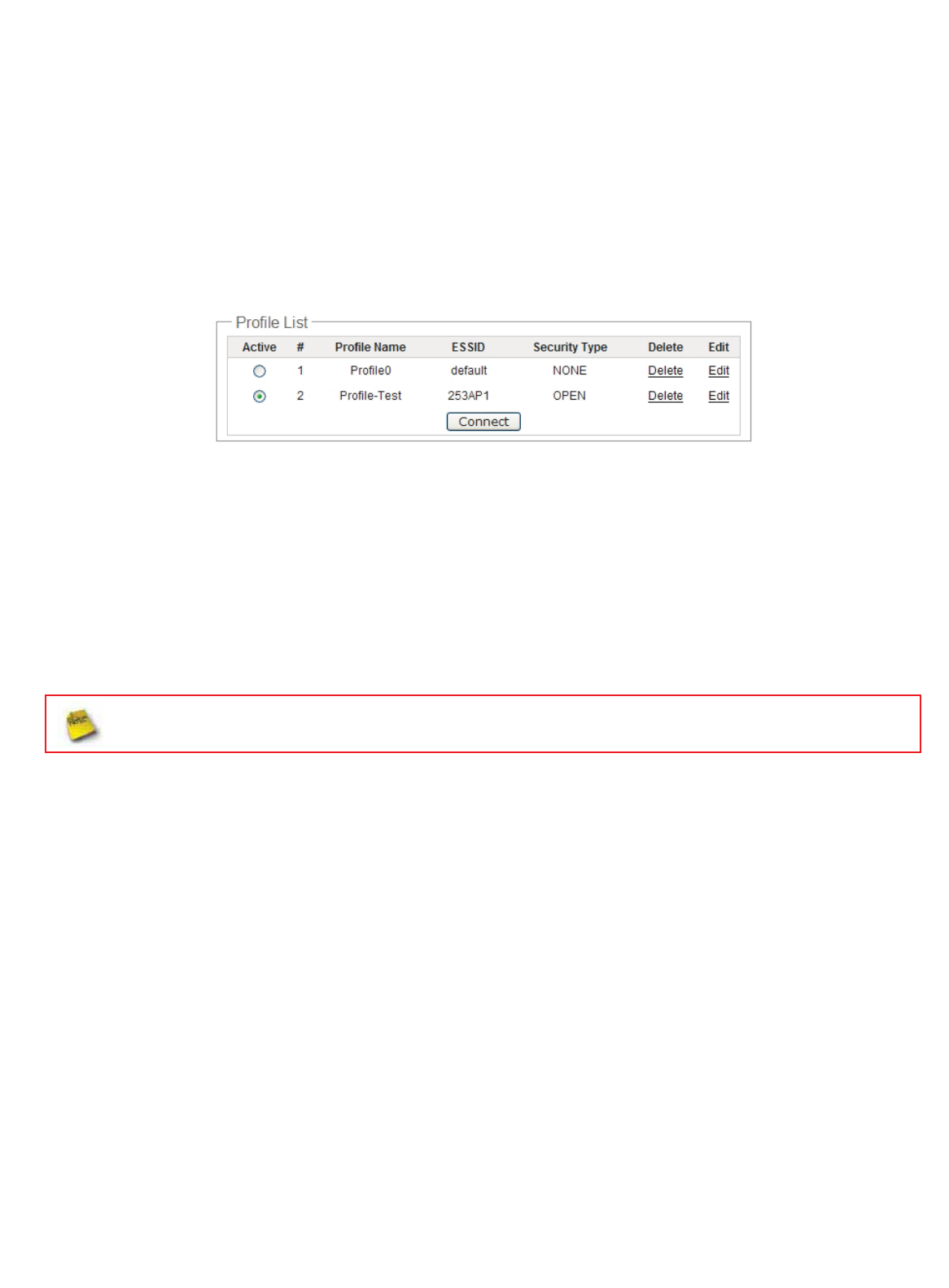
㻤㻟
9Cipher Suite : Select the desired cipher suite from the drop-down list; the options are AES and TKIP
9Pre-shared Key : Enter the information for pre-shared key; the key can be either entered as a 256-bit
secret in 64 HEX digits format, or 8 to 63 ASCII characters.
Profile List : The user can manage the created profiles for home, work or public areas. Below depict an example for
Profile List
ÎClick ”Edit” an exist profile on the Profile List. The field of System Configuration and Security Policy will display
profile's content. Edit profile's content and then click “Save” button to save the profile.
ÎClick “Delete” to remove profile.
ÎClick and Select a profile from list, then click the “Connect” button to connecting to the wireless network with the
profile setting. After clicking “Connect” button, the system should be jump to Station Statistic Page, you can
verify connecting status on Station Statistic Page.
When you click “Save” button on this page, the system will connect to specify AP and jump
to Station Statistic Page
Click Save button to save your changes. Click Reboot button to activate your changes
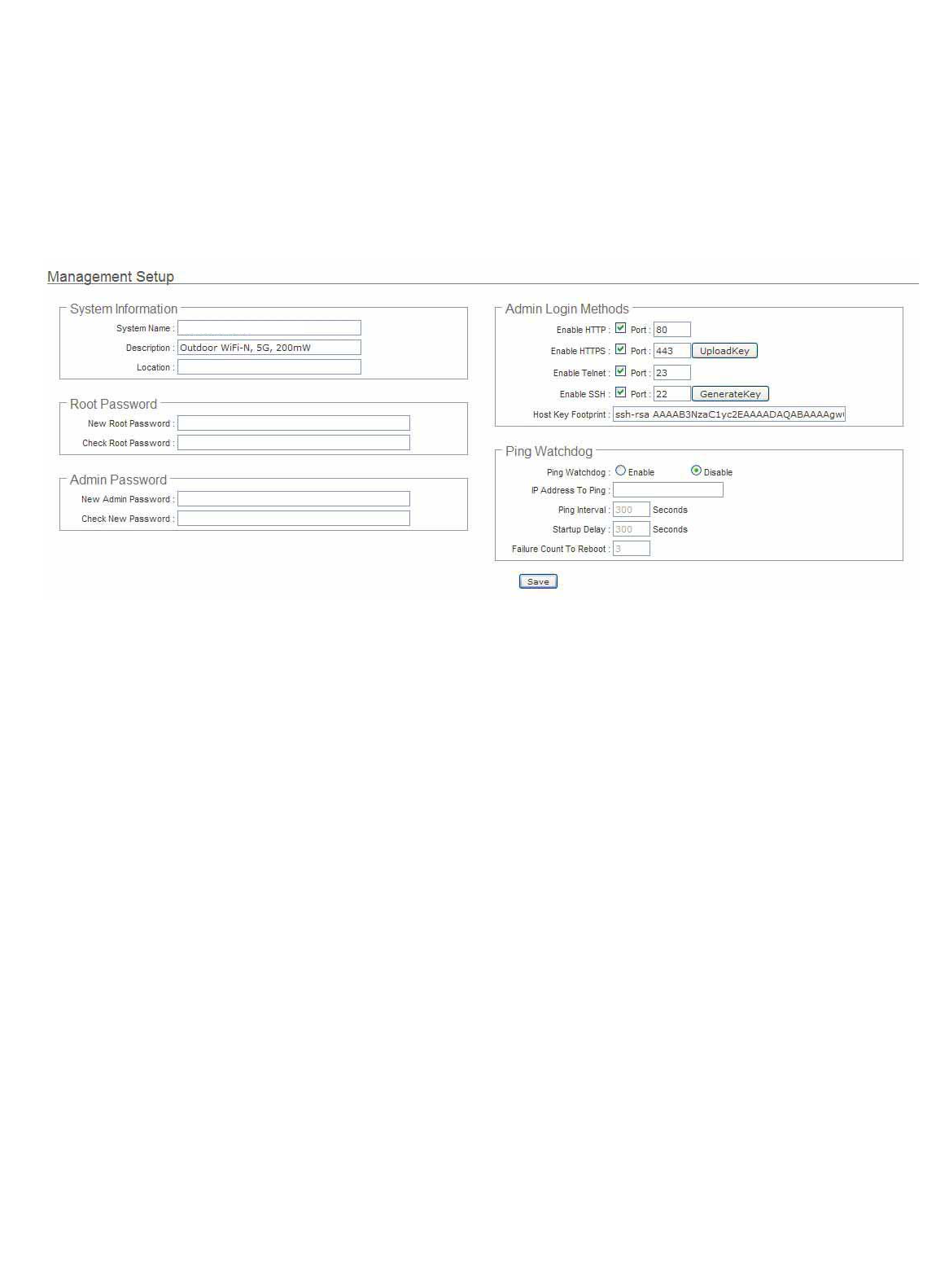
㻤㻠
SystemManagement
Configure Management
Administrator could specify geographical location of the system via instructions in this page. Administrator could also
enter new Root and Admin passwords and allow multiple login methods.
Please click System -> Management and follow the below settings.
System Information
ÎSystem Name : Enter a desired name or use the default one.
ÎDescription : Provide description of the system.
ÎLocation : Enter geographical location information of the system. It helps administrator to locate the system
easier.
The system supports two management accounts, root and admin. The network manager is assigned with full
administrative privileges, when logging in as root user, to manage the system in all aspects. While logging in as an
admin user, only subset of privileges is granted such as basic maintenance. For example, root user can change
passwords for both root and admin account, and admin user can only manage its own. For more information about
covered privileges for these two accounts, please refer to Appendix D. Network manager Privileges.
Root Password : Log in as a root user and is allowed to change its own, plus admin user’s password.
ÎNew Password : Enter a new password if desired
ÎCheck New Password : Enter the same new password again to check.
Admin Password : Log in as a admin user and is allowed to change its own,
ÎNew Password : Enter a new password if desired
ÎCheck New Password : Enter the same new password again to check.
Admin Login Methods : Only root user can enable or disable system login methods and change services port.
/TEW-676APBO

㻤㻡
ÎEnable HTTP : Check to select HTTP Service.
ÎHTTP Port : The default is 80 and the range is between 1 ~ 65535.
ÎEnable HTTPS : Check to select HTTPS Service
ÎHTTPS Port : The default is 443 and the range is between 1 ~ 65535.
If you already have an SSL Certificate, please click “UploadKey” button to select the file and upload it.
ÎEnable Telnet : Check to select Telnet Service
ÎTelnet Port : The default is 23 and the range is between 1 ~ 65535.
ÎEnable SSH : Check to select SSH Service
ÎSSH Port : Please The default is 22 and the range is between 1 ~ 65535.
Click “GenerateKey” button to generate RSA private key. The “host key footprint” gray blank will display
content of RSA key.
Ping Watchdog : The ping watchdog sets the TEW-676APBO Device to continuously ping a user defined IP address
(it can be the internet gateway for example). If it is unable to ping under the user defined constraints, the
TEW-676APBO device will automatically reboot. This option creates a kind of "fail-proof" mechanism.
Ping Watchdog is dedicated for continuous monitoring of the particular connection to remote host using the Ping tool.
The Ping works by sending ICMP “echo request” packets to the target host and listening for ICMP “echo response”
replies. If the defined number of replies is not received, the tool reboots the device.
ÎEnable Ping Watchdog : control will enable Ping Watchdog Tool.
ÎIP Address To Ping : specify an IP address of the target host which will be monitored by Ping Watchdog Tool.
ÎPing Interval : specify time interval (in seconds) between the ICMP “echo requests” are sent by the Ping
Watchdog Tool. Default is 300 seconds.
ÎStartup Delay : specify initial time delay (in seconds) until first ICMP “echo requests” are sent by the Ping
WatchdogTool. The value of Startup Delay should be at least 60 seconds as the network interface and wireless
connection initialization takes considerable amount of time if the device is rebooted. Default is 300 seconds.
ÎFailure Count To Reboot : specify the number of ICMP “echo response” replies. If the specified number of
ICMP “echo response” packets is not received continuously, the Ping Watchdog Tool will reboot the device.
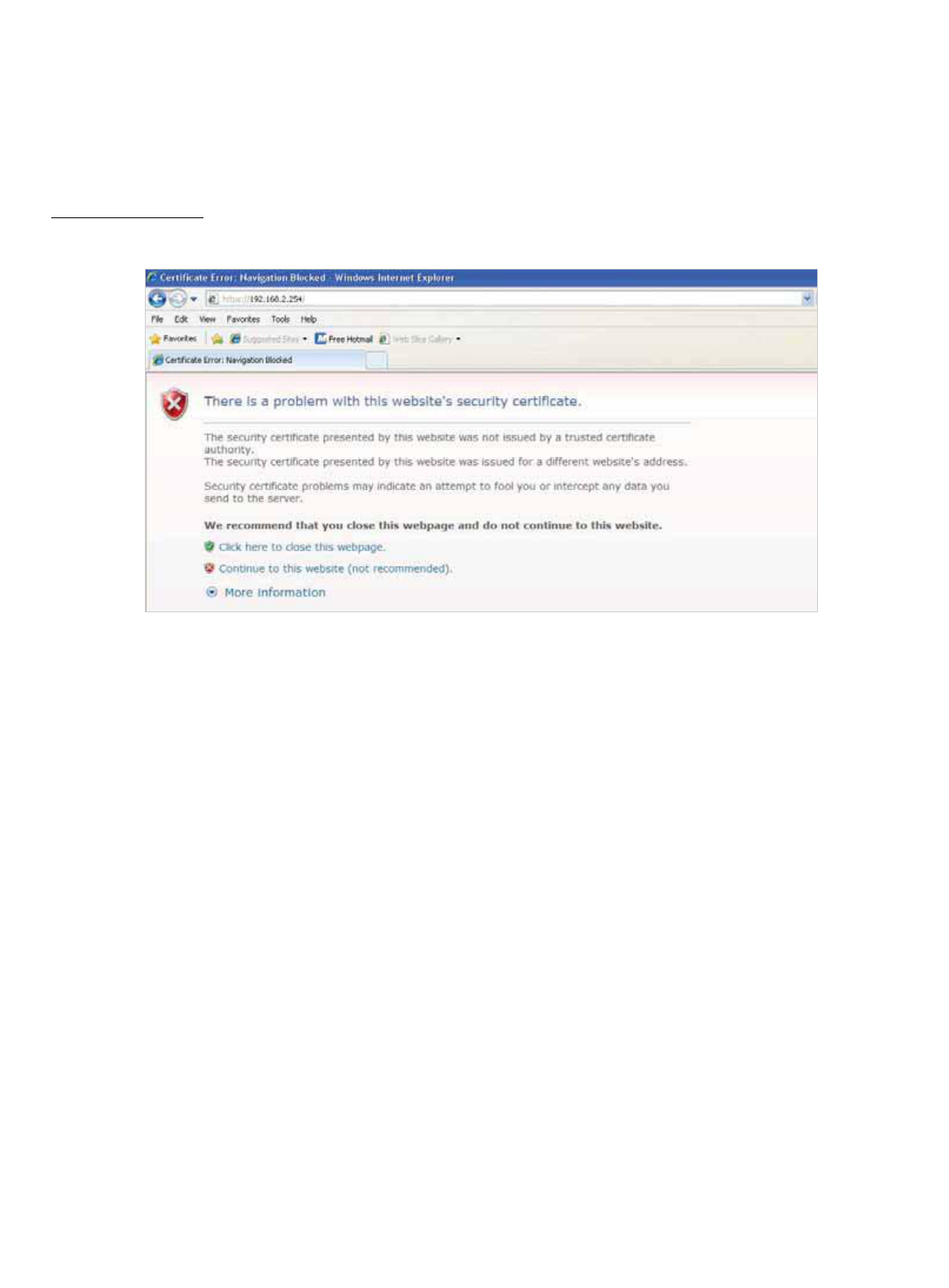
㻤㻢
Click Save button to save your changes. Click Reboot button to activate your changes
Without a valid certificate, users may encounter the following problem in IE7 when they try to access system's WMI
(https://192.168.2.254). There will be a “Certificate Error”, because the browser treats system as an illegal website.
Click
“Continue to this website” to access the system's WMI. The system's Overview page will appear.

㻤㻣
Configure System Time
System time can be configured via this page, and manual setting or via a NTP server is supported.
Please click on System -> Time Server and follow the below setting.
Local Time : Display the current system time.
NTP Client : To synchronize the system time with NTP server.
ÎEnable : Check to select NTP client.
ÎDefault NTP Server : Select the NTP Server from the drop-down list.
ÎTime Zone : Select a desired time zone from the drop-down list.
ÎDaylight saving time : Enable or disable Daylight saving.
If the system time from NTP server seems incorrect, please verify your network settings, like default Gateway
and DNS settings
Click Save button to save your changes. Click Reboot button to activate your changes
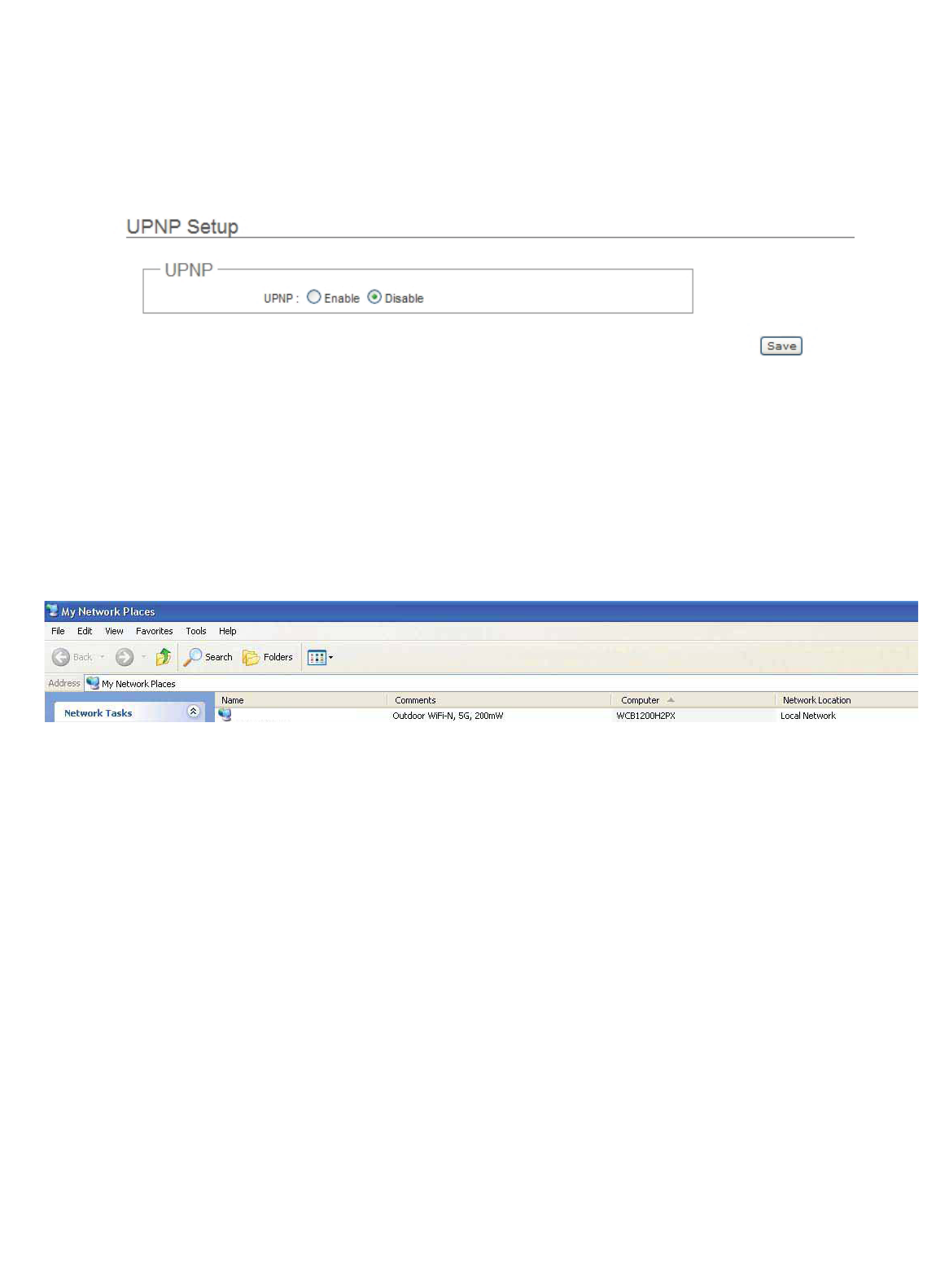
㻤㻤
Configure UPnP
Universal Plug and Play(UPnP) is an architecture to enable pervasive peer-to-peer network connectivity between PCs,
intelligent devices and appliances when UPnP is supported. UPnP works on TCP/IP network to enable UPnP devices to
connect and access to each other, very well adopted in home networking environment.
UPnP : By default, it’s “Disable”. Select “Enable” or “Disable” ofUPnP Service.
Click Save button to save changes and click Reboot button to activate changes
For UPnP to work in Windows XP, the “TEW-676APBO” must be available in “My Network Places”, as shown here: (your
specific model may vary)
If these devices are not available, you should verify that the correct components and services are loaded in Windows XP.
Please refer to Appendix E. Using UPnP on Windows XP
TEW-675APBO/TEW-676APBO
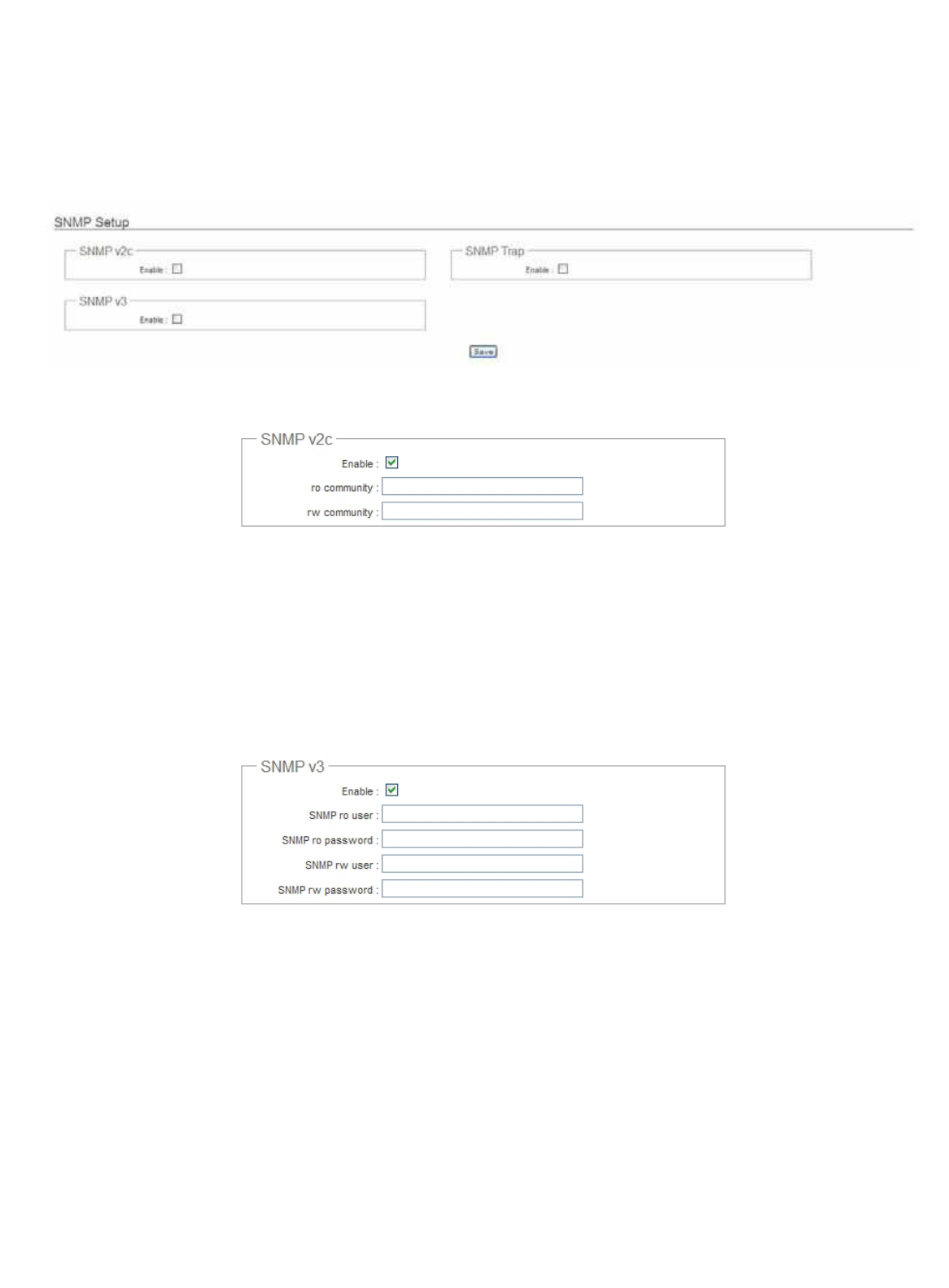
㻤㻥
Configure SNMP Setup
SNMP is an application-layer protocol that provides a message format for communication between SNMP managers and
agents. By enabling SNMP function, the administrator can obtain the system information remotely.
Please click on System -> SNMP Setup and follow the below setting.
SNMP v2c Enable: Check to enable SNMP v2c.
Îro community : Set a community string to authorize read-only access.
Îrw community : Set a community string to authorize read/write access.
SNMP v3 Enable: Check to enable SNMP v3.
SNMPv3 supports the highest level SNMP security.
ÎSNMP ro user : Set a community string to authorize read-only access.
ÎSNMP ro password : Set a password to authorize read-only access.
ÎSNMP rw user : Set a community string to authorize read/write access.
ÎSNMP rw password : Set a password to authorize read/write access.
SNMP Trap : Events such as cold start, interface up & down, and association & disassociation will report to an
assigned server.

㻥㻜
ÎCommunity : Set a community string required by the remote host computer that will receive trap messages or
notices send by the system.
ÎIP : Enter the IP addresses of the remote hosts to receive trap messages.
Click Save button to save changes and click Reboot button to activate.
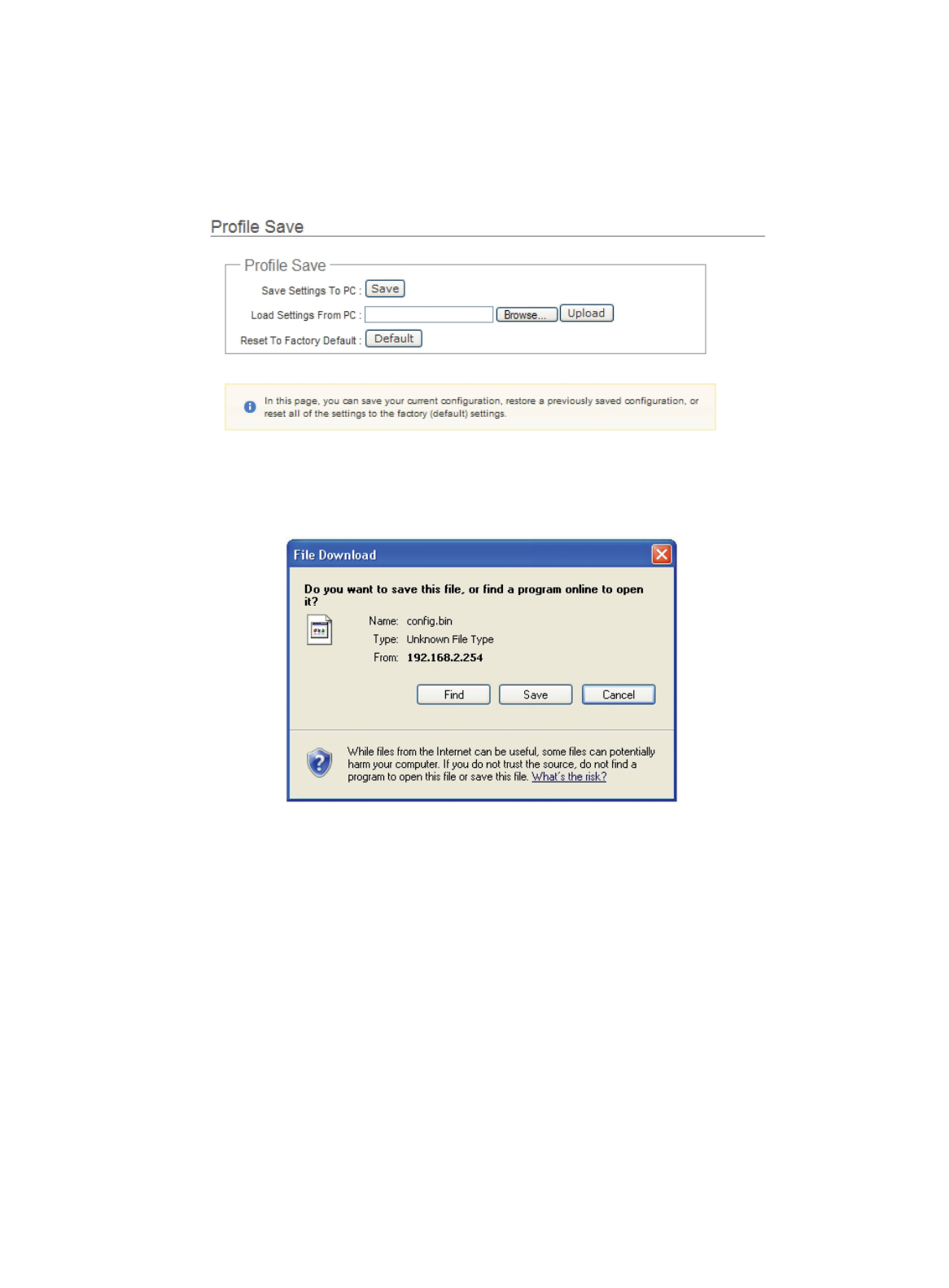
㻥㻝
Backup / Restore and Reset to Factory
Backup current configuration, restore prior configuration or reset back to factory default configuration can be executed via
this page.
Please click on Utilities -> Profile Setting and follow the below setting.
Save Settings to PC : Click Save button to save the current configuration to a local disk.
Load Settings from PC : Click Browse button to locate a configuration file to restore, and then click Upload button
to upload.
Reset To Factory Default : Click Default button to reset back to the factory default settings and expect Successful
loading message.Then, click Reboot button to activate.
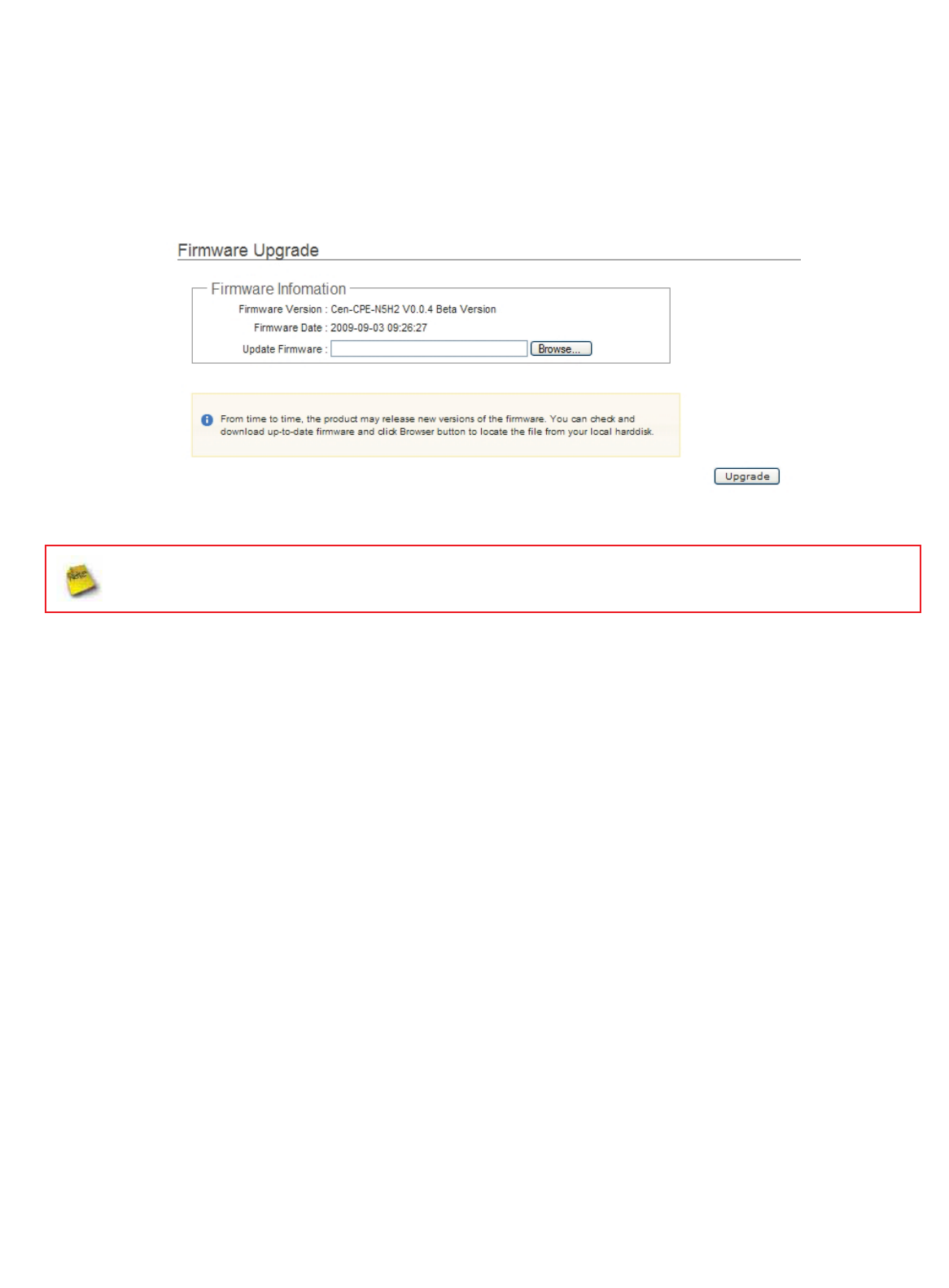
㻥㻞
Firmware Upgrade
Firmware is the main software image that system needs to respond to requests and to manage real time operations.
Firmware upgrades are sometimes required to include new features or bugs fix. It takes around 2minutes to upgrade
due to complexity of firmware. To upgrade system firmware, click Browse button to locate the new firmware, and then
click Upgrade button to upgrade.
1. To prevent data loss during firmware upgrade, please back up current settings before proceeding.
2. Do not interrupt during firmware upgrade including power on/off as this may damage system.
3. Never perform firmware upgrade over wireless connection or via remote access connection.

㻥㻟
Network Utility
The administrator can diagnose network connectivity via the PING and TRACEROUTE utility.
Please click on Utilities -> Network Utility and follow the below setting
Ping : This utility will help ping other devices on the network to verify connectivity. Ping utility, using ICMP packets,
detects connectivity and latency between two network nodes. As result of that, packet loss and latency time are
available in the Result field while running the PING test.
ÎDestination IP/Domain : Enter desired domain name, i.e. www.google.com,or IP address of the destination,
and click ping button to proceed. The ping result will be shown in the Result field.
ÎCount : By default, it’s 5 and the range is from 1 to 50. It indicates number of connectivity test.
Traceroute : Allows tracing the hops from the TEW-676APBO device to a selected outgoing IP
address. It should be used for the finding the route taken by ICMP packets across the network to the destination host.
The test is started using the Start button, click Stop button to stopped test
ÎDestination Host : Specifies the Destination Host for the finding the route taken by ICMP packets across the
network.
ÎMAX Hop : Specifies the maximum number of hops( max time-to-live value) traceroute will probe.
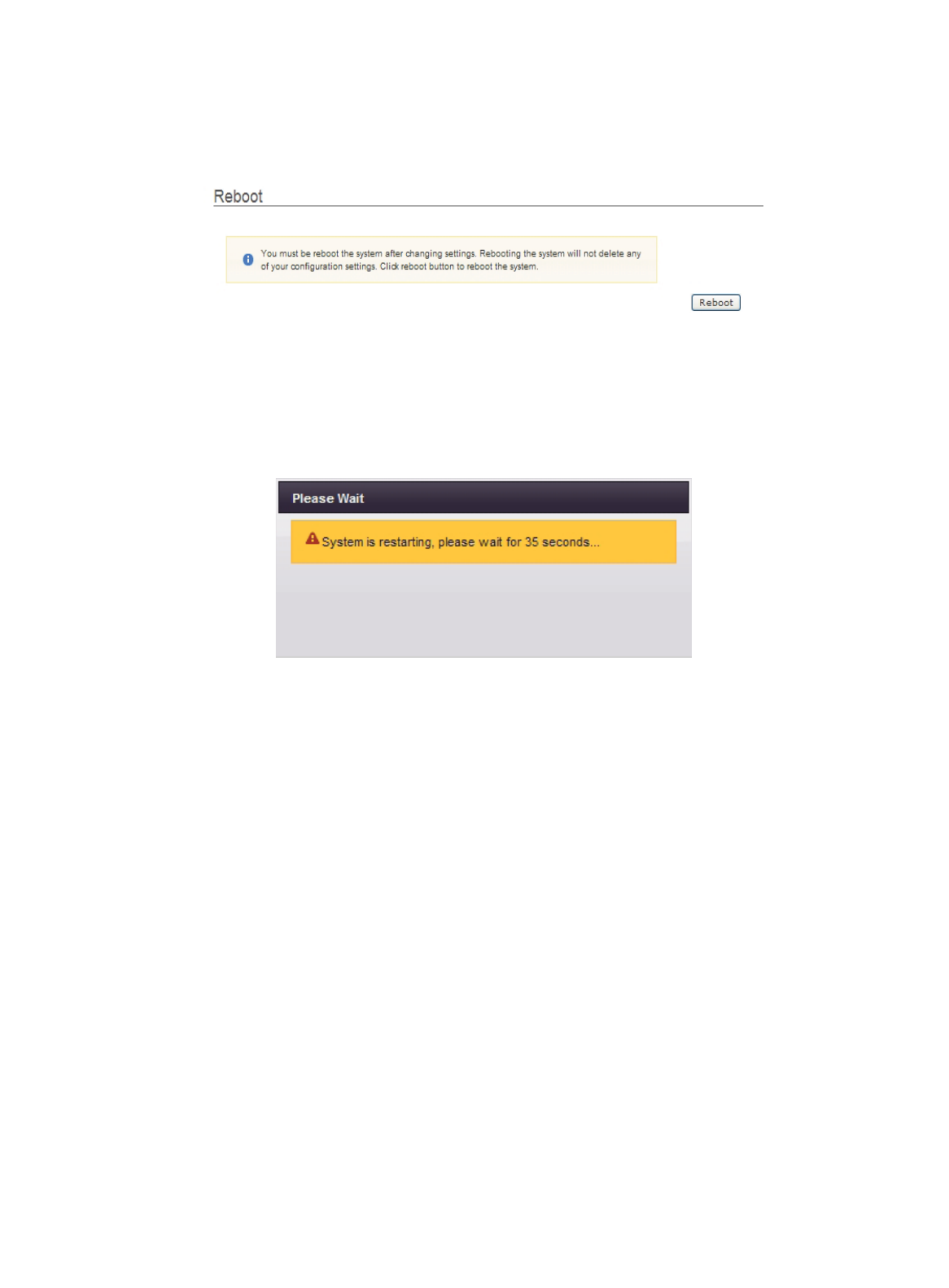
㻥㻠
Reboot
This function allows user to restart system with existing or most current settings when changes are made. Click Reboot
button to proceed and take around three minutes to complete.
A reminder will be available for remaining time to complete. If power cycle is necessary, please wait till completion of the
reboot process.
The System Overview page appears upon the completion of reboot.
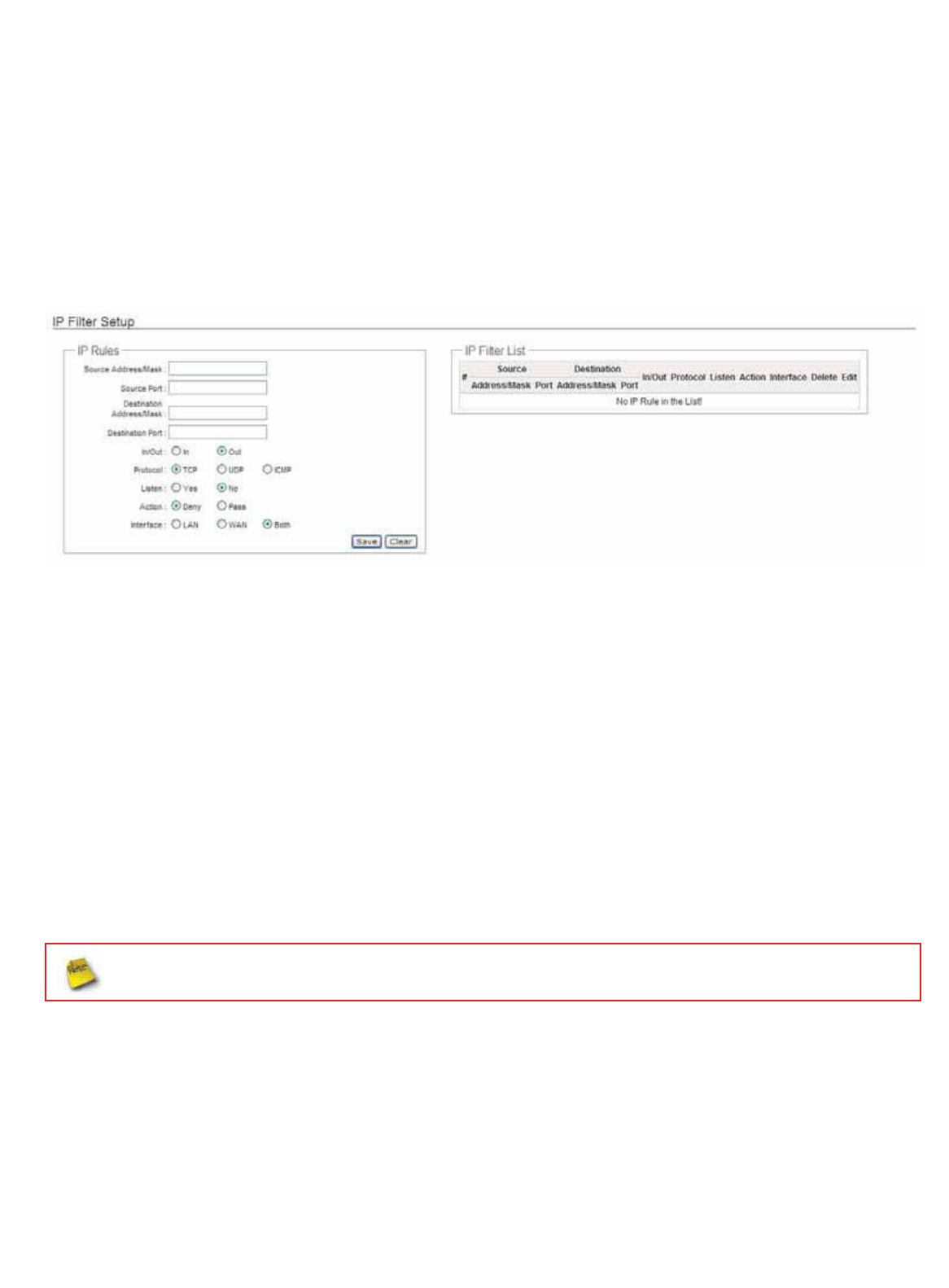
㻥㻡
Access Control List
IP Filter Setup
Allows to create deny or allow rules to filter ingress or egress packets from specific source and/or to destination IP
address on wired (LAN) or Wireless (WAN) ports. Filter rules could be used to filter unicast or multicast packets on
different protocols as shown in the IP Filter Setup. Important to note that IP filter rules has precedence over Virtual server
rules.
Please click on Advance -> IP Filter Setup and follow the below setting.
Source Address/Mask : Enter desired source IP address and netmask; i.e. 192.168.2.10/32.
Source Port : Enter a port or a range of ports as start:end; i.e. port 20:80
Destination Address/Mask : Enter desired destination IP address and netmask; i.e. 192.168.1.10/32
Destination Port : Enter a port or a range of ports as start:end; i.e. port 20:80
In/Out : Applies to Ingress or egress packets
Protocol : Supports TCP,UDP or ICMP.
Listen : Click Yes radial button to match TCP packets only with the SYN flag.
Active : Deny to drop and Pass to allow per filter rules
Interface : The interface that a filter rule applies
All packets are allowed by default. Deny rules could be added to the filter list to filter out unwanted packets and
leave remaining allowed.
Click “Save” button to add IP filter rule. Total of 20 rules maximum allowed in the IP Filter List. All rules can be edited or
removed from the List. Click Reboot button to activate your changes.
When you create rules in the IP Filter List, the prior rules maintain higher priority. To allow limited access from a subnet to
a destination network manager needs to create allow rules first and followed by deny rules. So, if you just want one IP
address to access the system via telnet fromyour subnet, not others, the Example 1 demonstrates it, not rules in the
Example 2.

㻥㻢
ÎExample 1 : Create a higher priority rule to allow IP address 192.168.2.2 Telnet access from LAN port first, and
deny Telnet access from remaining IP addresses in the same subnet.
Rule
Source Destination
In/Out Protocol Listen Action Side
IP/Mask Port IP/Mask Port
1192.168.2.2/32192.168.2.254/3222 In TCP n Pass LAN
2192.168.2.0/24192.168.2.254/3222 In TCP n Deny LAN
ÎExample 2 : All Telnet access to the system from the IP addresses of subnet 192.168.2.x works with the rule 1
of Example 2. The rule 2 won’t make any difference.
Rule
Source Destination
In/Out Protocol Listen Action Side
IP/Mask Port IP/Mask Port
1192.168.2.0/24192.168.2.254/3222 In TCP n Deny LAN
2192.168.2.2/32192.168.2.254/3222 In TCP n pass LAN

㻥㻣
MAC Filter Setup
Allows to create MAC filter rules to allow or deny unicast or multicast packets from limited number of MAC addresses.
Important to note that MAC filter rules have precedence over IP Filter rules.
Please click on Advance -> MAC Filter Setup and follow the below setting.
MAC Filter Rule : By default, it’s “Disable”. Options are Disabled,Only Deny List MAC or Only Allow List MAC.
Click Save button to save your change.
Two ways to set the MAC Filter List:
ÎOnly Allow List MAC.
The wireless clients in the MAC Filter List will be allowed to access to Access Point; All others will be denied.
ÎOnly Deny List MAC.
The wireless clients in the MAC Filter List will be denied to access to Access Point; All others will be allowed.
If there does not have any MAC address in MAC Filter List, the MAC filter function deactivated
MAC Address : Enter MAC address (e.g. aa:bb:cc:00:00:0a) and click “Add” button, then the MAC address should
display in the MAC Filter List.
There are amaximumof20 clients allowed in this MAC Filter List. The MAC addresses of the wireless clients can be
added and removed to the list using the Add and Delete buttons.
Click Reboot button to activate your changes
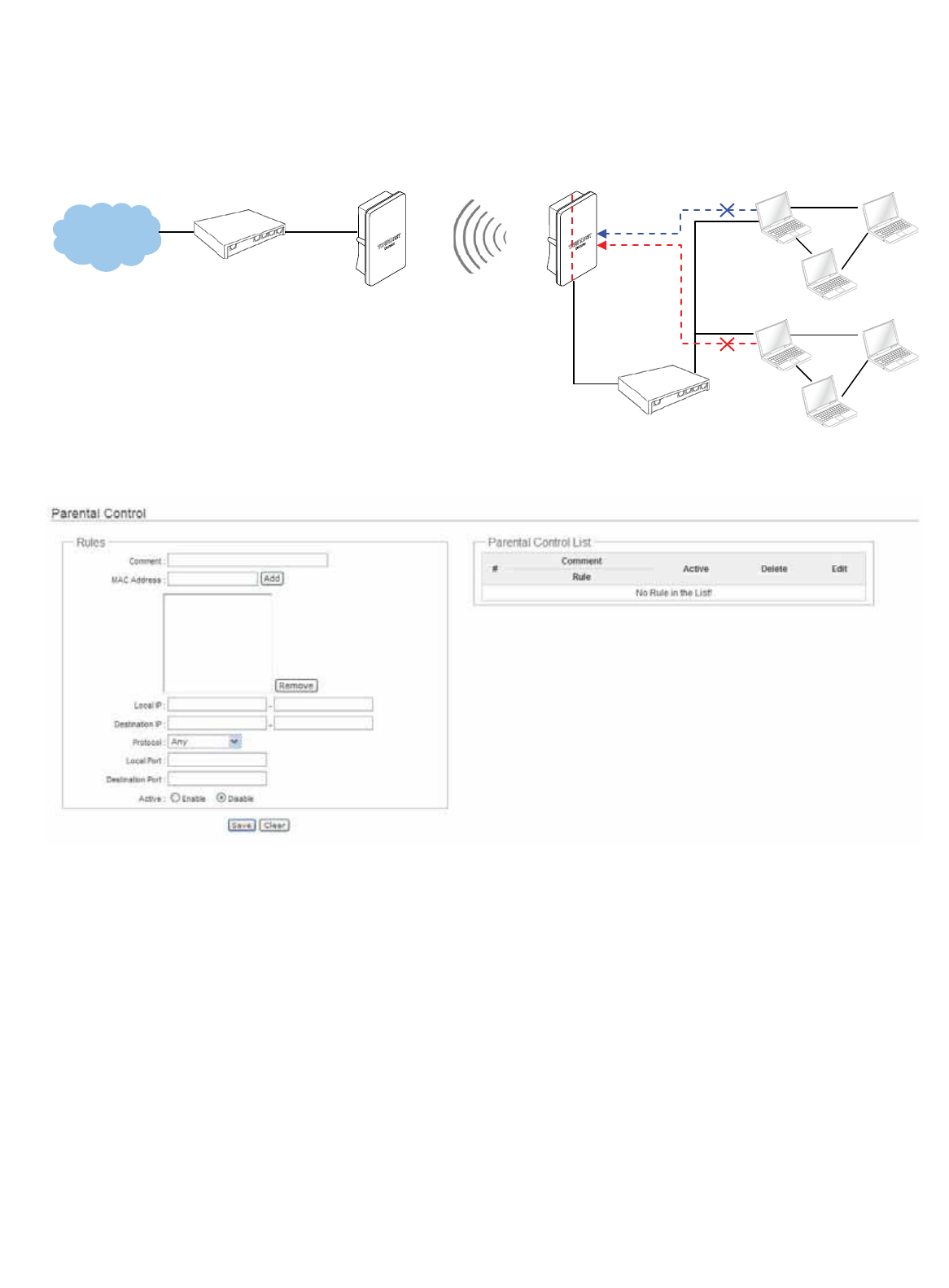
㻥㻤
Parental Control Setup
Parental Control allows you to block or allow specific kinds of Internet usage and traffic, such as Internet access,
designated services, and websites.
Please click on Advance -> Parental Control and follow the below setting.
Rules : control can be managed by a rule. Use the settings on this screen to establish an access policy.
ÎComment : Enter a descriptive name for this rule for identifying purposes.
ÎMAC Address : Enter MAC address in valid MAC address format(xx:xx:xx:xx:xx:xx) and click “Add” button to
add in the MAC group of each rule. Click “Remove” button can remove MAC address in the group of each rule.
There are 10 MAC address maximum allowed in each rule.
ÎLocal / Destination IP : Specify local(LAN)/ destination IP addresses range required for this rule. If you specify
local IP addresses range from 192.168.1.1 to 192.168.2.254. The matches a range oflocal IP addresses
include every single IP address from the first to the last, so the example above includes everything from
192.168.1.1 to 192.168.2.254.
ÎProtocol : Select Any or specify protocol(TCP,UDP,ICMP,URL Blocking and Application) from drop-down
list. When you select ICMP or Layer 7 Application , the Local(LAN)/ Destination Port can not used.
SSID: Main
_
AP
192.168.2.x
Internet
WIFI WAN
192.168.1.254
Main Base Station
192.168.1.150
LAN
192.168.2.254
NAT
192.168.2.x
B
A
MSN
Facebook
TEW-676APBO

㻥㻥
If you want to block websites with specific URL address or using specific keywords, enter each URL or keyworks
in the “URL Blocking” field and click “Add” button to add in the URL Blocking list of each rule. Click
“Remove” button can remove URL or keywords.
ÎLocal Port : Specify local port(LAN port) range required for this rule
ÎDestination Port : Specify destination port range required for this rule
ÎActive : Check Enable button to activate this rule, and Disable to deactivate.
Click “Add” button to add control rule to List. There are 10 rules maximum allowed in this Control List. All rules can be
removed or edited on the List. Click Reboot button to activate your changes.
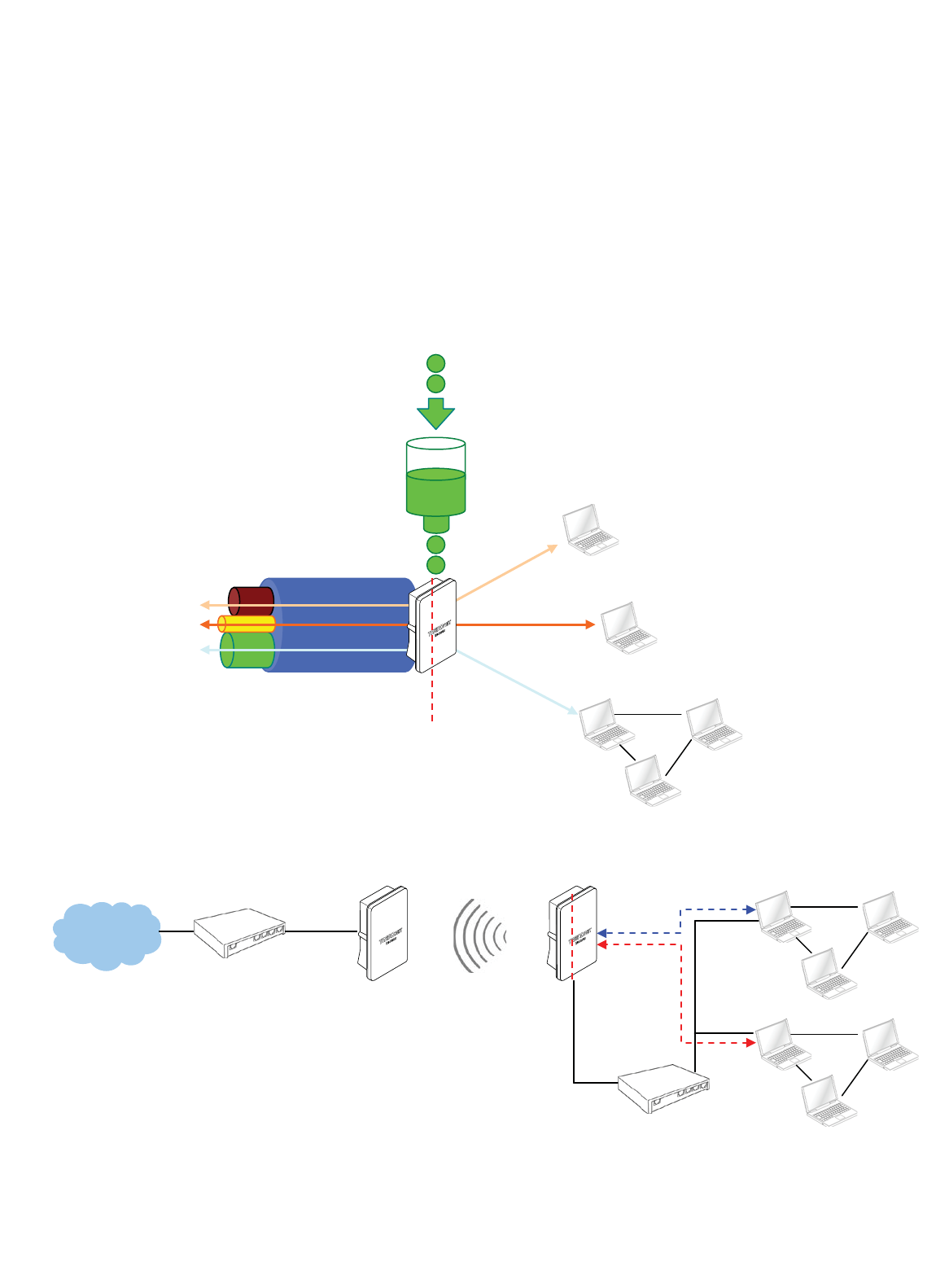
㻝㻜㻜
QoS Setup
Quality of Service (QoS) refers to both a network's ability to deliver data with minimum delay, and the networking
methods used to control the use of bandwidth. Without QoS, all traffic data is equally likely to be dropped when the
network is congested. This can cause a reduction in network performance and make the network inadequate for time-
critical application such as video-on-demand.
A classifier groups traffic into data flows according to specific criteria such as the source address, destination address,
source port number, destination port number or incoming port number. For example, you can configure a classifier to
select traffic from the same protocol port (such as FTP) to form a flow.
Please click on Advance -> QoS and follow the below setting.
192.168.2.x
WAN
192.168.1.254
LAN
192.168.2.254
NAT
Download: 2048K
U
p
load: 1024K
Download: 512K
U
p
load: 256K
192.168.2.51
MAC-00:0B:6B:AA:BB:02
192.168.2.50
MAC-00:0B:6B:AA:BB:01
Download: 1024K
U
p
load: 256K
Sha
p
in
g
TEW-676APBO
SSID: Main
_
AP
192.168.2.x
Internet
WIFI WAN
192.168.1.254
Main Base Station
192.168.1.150 LAN
192.168.2.254
NAT
192.168.2.x
B
A
Down: 2048Kbps
Up: 1024Kbps
Down: 1024Kbps
Up: 512Kbps
TEW-676APBO
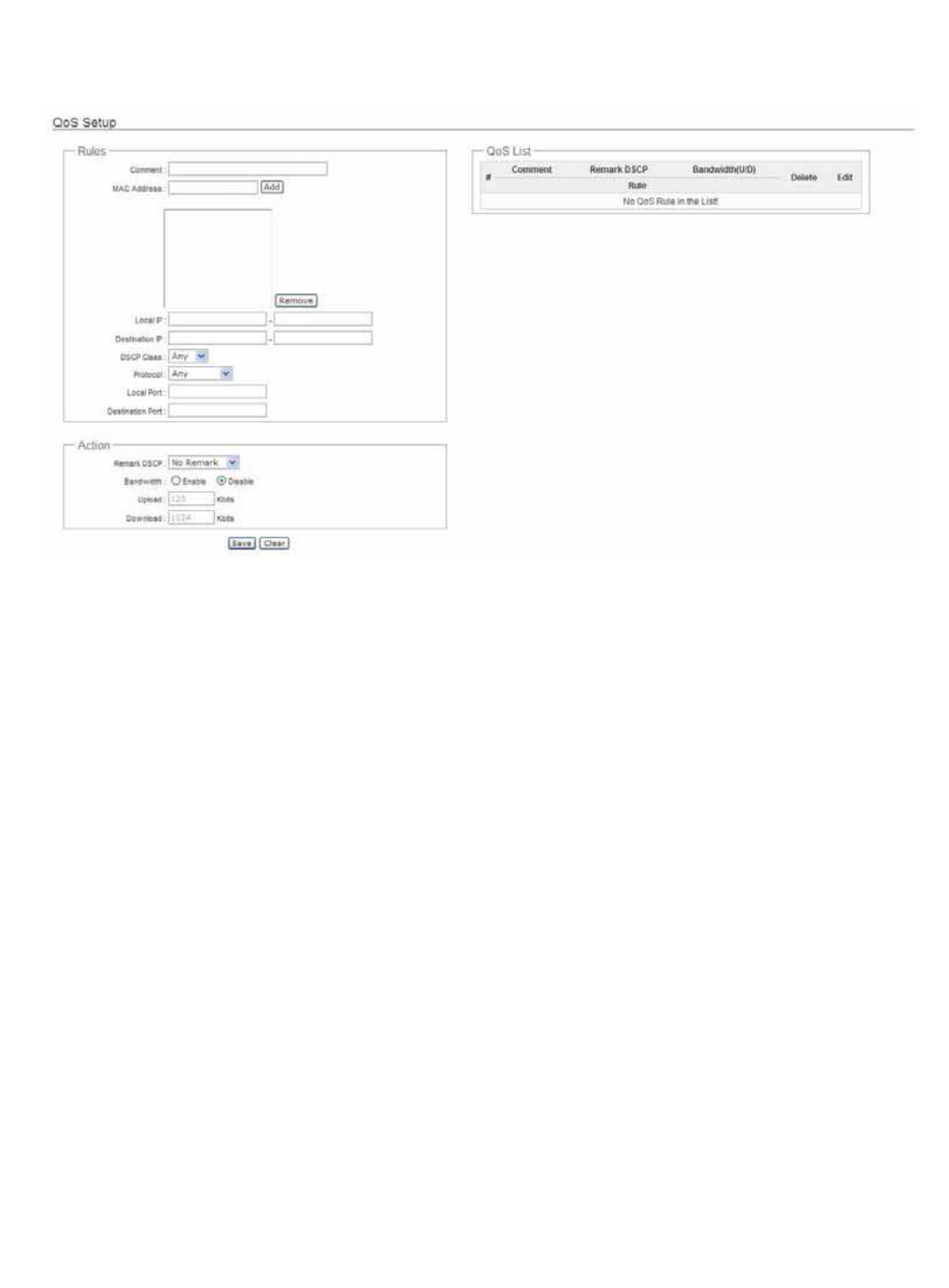
㻝㻜㻝
Rules : Use the rules to define the classifiers. After you define the rules, you can specify action to act upon the traffic
that matches the rules
ÎComment : Enter a descriptive name for this rule for identifying purposes.
ÎMAC Address : Enter MAC address in valid MAC address format(xx:xx:xx:xx:xx:xx) and click “Add” button to
add in the MAC group of each rule. Click “Remove” button can remove MAC address in the group of each rule.
There are 10 MAC address maximum allowed in each rule.
ÎLocal / Destination IP : Specify local(LAN)/ destination IP addresses range required for this rule. If you specify
local IP addresses range from 192.168.1.1 to 192.168.2.254. The matches a range of local IP addresses
include every single IP address from the first to the last, so the example above includes everything from
192.168.1.1 to 192.168.2.254.
ÎDSCP Class : Differentiated services code point, DSCP. Select Any or specify classify traffic from drop-down list.
The Per-Hop Behavior (PHB) is indicated by encoding a 6-bit value—called the Differentiated Services Code
Point (DSCP)—into the 8-bit Differentiated Services (DS) field of the IP packet header. Below depicts class for
DSCP.
9BE : Default PHB, which is typically best-effort traffic
9EF : Expedited Forwarding PHB, dedicated to low-loss, low-latency traffic
9AF : Assured Forwarding PHB, which gives assurance of delivery under conditions. The AF behavior group
defines four separate AF classes. Within each class, packets are given a drop precedence (high, medium or
low). The combination of classes and drop precedence yields twelve separate DSCP encodings from AF11
through AF43 (see table)

㻝㻜㻞
DROP Precedence Class 1 Class 2 Class 3 Class 4
Low Drop AF11 AF21 AF31 AF41
Medium Drop AF12AF22 AF32AF42
High Drop AF13 AF23 AF33 AF43
ÎProtocol : Select Any or specify protocol(TCP,UDP,ICMP,Application) from drop-down list. When you select
ICMP or Layer 7 Application , the Local/ Destination Port can not used.
ÎLocal Port : Specify local port(LAN port) range required for this rule
ÎDestination Port : Specify destination port range required for this rule
Action : After configuring rule, a policy rule ensures that a traffic flow gets the requested treatment in the network.
ÎRemark DSCP : Specify a new DSCP class, if you want to replace or remark the DSCP
ÎBandwidth : Click “Enable” to activate function, and click “Disable” to deactivate function
ÎUpload / Download : Specify the bandwidth in kilobit per second (Kbps). Enter a number between 8to 8192,
default upload is 128 Kbps, download is 1024 Kbps.
Click “Add” button to add QoS rule to List. There are 10 rules maximum allowed in this QoS List. All rules can be removed
or edited on the List. Click Reboot button to activate your changes.
When you create rules on the QoS List, the previous rules have higher priority. . Below depict the examples for explaining
priority of QoS setup.
¾Example 1 : On this setting, the FTP has 1024 Kbps upload and 8196 Kbps download on 192.168.2.10. The
remaining IP address and other remaining protocol of IP address 192.168.2.10 only can use total bandwidth 512
Kbps bandwidth. Because rule 1's priority is higher than rule 2
Rule Source IP Destination IP DSCP Protocol Remark DSCP Bandwidth (Up/Down)
1192.168.2.10 ANYFTP NO 1024/8196
2ANYANYNO 512/512
¾Example 2 : On this setting, the FTP has 512 Kbps upload and 512 Kbps download on 192.168.2.10 Because
rule 1's priority is higher than rule 2
Rule Source IP Destination IP DSCP Protocol Remark DSCP Bandwidth (Up/Down)
1ANYANYNO 512/512
2192.168.2.10 ANYFTP NO 1024/8196
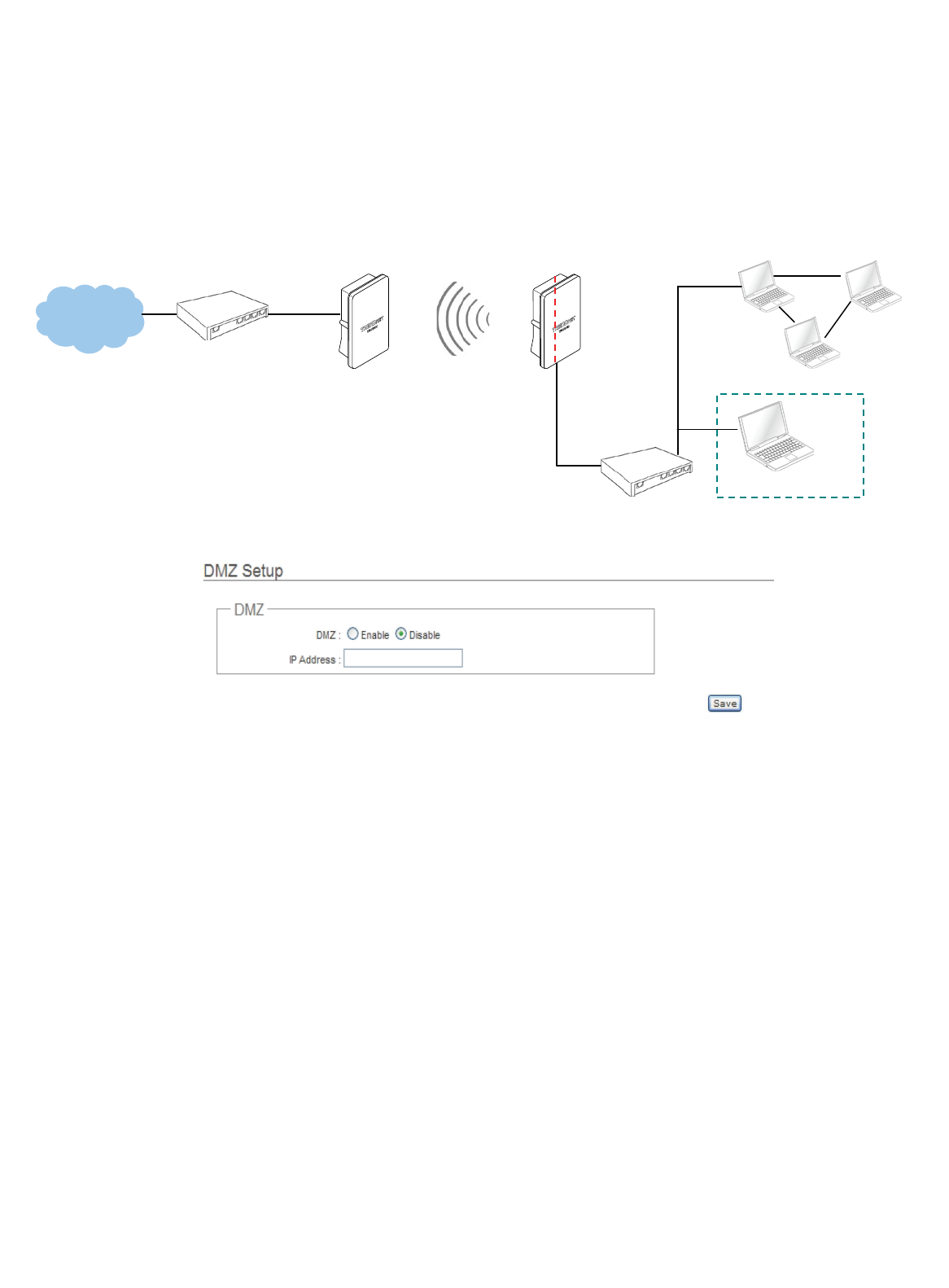
㻝㻜㻟
Resource Sharing
DMZ
DMZ is commonly work with the NAT functionality as an alternative of Virtual Server(Port Forwarding)while wanting all
ports of DMZ host visible to Internet users. Virtual Server rules have precedence over the DMZ rule. In order to use a
range of ports available to access to different internal hosts Virtual Server rules are needed.
Please click on Advance -> DMZ and follow the below setting.
DMZ : By default, it’s “Disable”. Check Enable radial button to enable DMZ.
IP Address : Enter IP address of DMZ host and only one DMZ host is supported.
Click Save button to save your changes. Click Reboot button to activate your changes.
SSID: Main
_
AP
192.168.2.IJı
Internet
WIFI WAN
192.168.1.254
Main Base Station
192.168.1.150
LAN
192.168.2.254
NAT
192.168.2.x
DMZ
TEW-676APBO
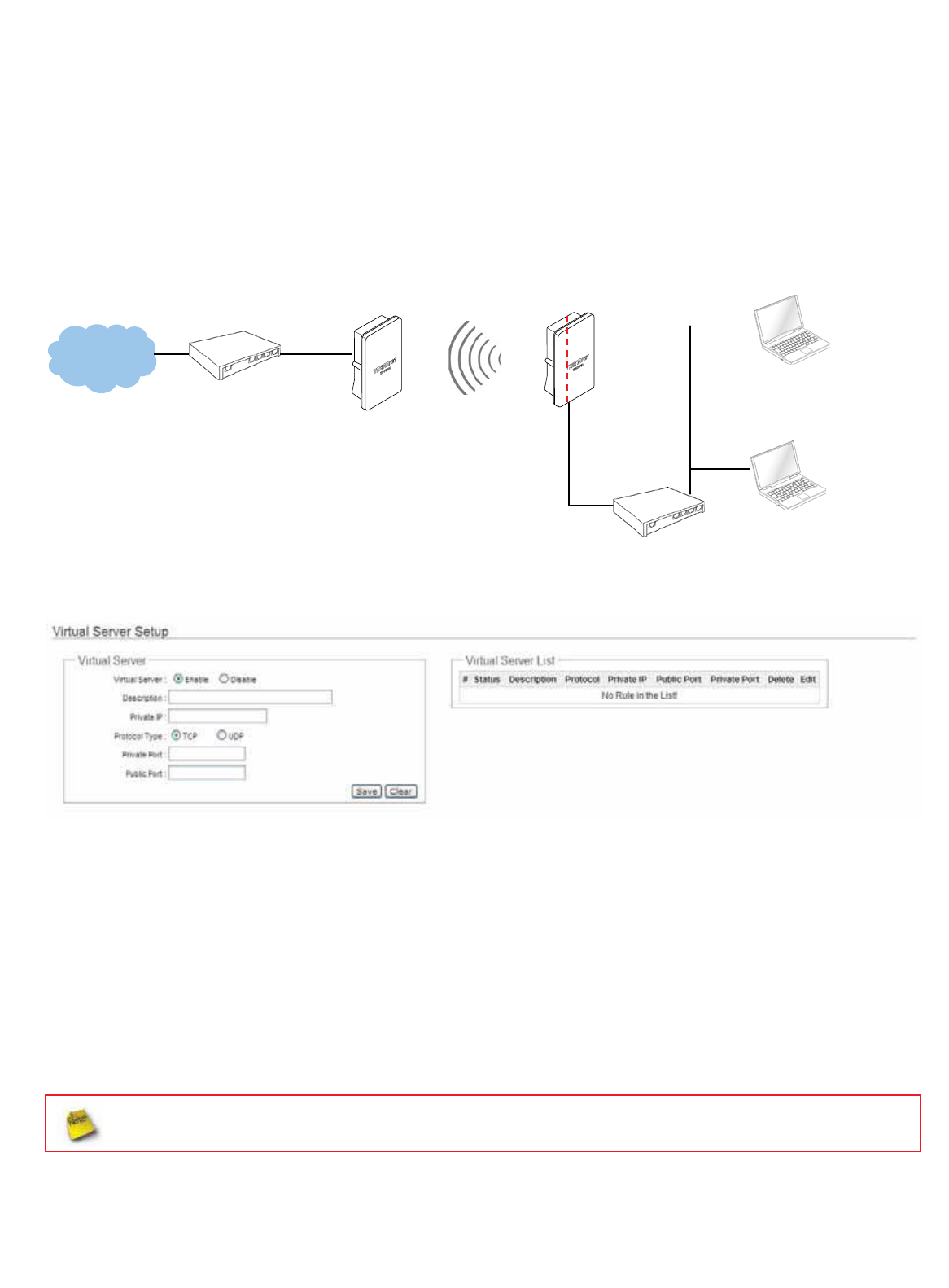
㻝㻜㻠
Virtual Server (Port Forwarding)
“Virtual Server” can also referred to as “Port Forward” as well and used interchangeably. Resources in the network can be
exposed to the Internet users in a controlled manner including on-line gaming, video conferencing or others via Virtual
Server setup. Don’t repeat ports’ usage to avoid confusion.
Suppose you want to assign ports 21-25 to one FTP, Telnet and SMTP server (A in the example), and port 80 to another
(B in the example). You assign the LAN IP addresses and the ISP assigns the WAN IP address. The NAT network
appears as a single host on the Internet.
Please click on Advance -> Virtual Server and follow the below setting.
Virtual Server : By Default, It’s “Disable”.Check Enable radial button to enable Virtual Server.
Description : Enter appropriate message for resource sharing via Virtual Server.
Private IP : Enter corresponding IP address of internal resource to share.
Protocol Type : Select appropriate sessions, TCP or UDP, from shared host via multiple private ports.
Private Port : A port or a range of ports may be specified as start:end; i.e. port 20:80
Public Port : A port or a range of ports may be specified as start:end; i.e. port 20:80
.
The Private Port and Public Port can be different. However, total number of ports need to be the same.
Example : Public Port is 11 to 20 and the Private Port can be a 10 ports range.
Click “Add” button to add Virtual Server rule to List. Total of maximum20 rules are allowed in this List. All rules can be
edited or removed from the List. Click Reboot button to activate your changes.
SSID: Main
_
AP
192.168.2.11
Port: 80
Internet
WIFI WAN
192.168.1.254
Main Base Station
192.168.1.150
LAN
192.168.2.254
NAT
B
192.168.2.10
Port: 21-25
A
TEW-676APBO

㻝㻜㻡
While creating multiple Virtual Server rules, the prior rules have higher priority. The Virtual server rules have precedence
over the DMZ one while both rules exist. Example 1 and 2 demonstrate proper usage of DMZ and Virtual Server rules.
Example 1 : All connections should be redirected to 192.168.2.12 while DMZ is enabled. Since Virtual Server rules
have precedence over the DMZ rule all connections to TCP port 22 will be directed to TCP port 22 of 192.168.2.10
and remaining connections to port TCP 20~80 will be redirected to port TCP 20~80 of 192.168.2.11
DMZ Enabled : 192.168.2.12
Rule Protocol Private IP Private Port Public Port
1 TCP 192.168.2.10 22 22
2TCP 192.168.2.11 20:80 20:80
Example 2 : All connections should be redirected to 192.168.2.12 while DMZ is enabled. Since Virtual Server rules
have precedence over the DMZ rule all other connections to TCP port 20~80 will be redirected to port 20~80 of
192.168.2.11. The rule 2 won’t take effect.
DMZ Enabled : 192.168.2.12
Rule Protocol Private IP Private Port Public Port
1 TCP 192.168.2.11 20:80 20:80
2TCP 192.168.2.10 22 22
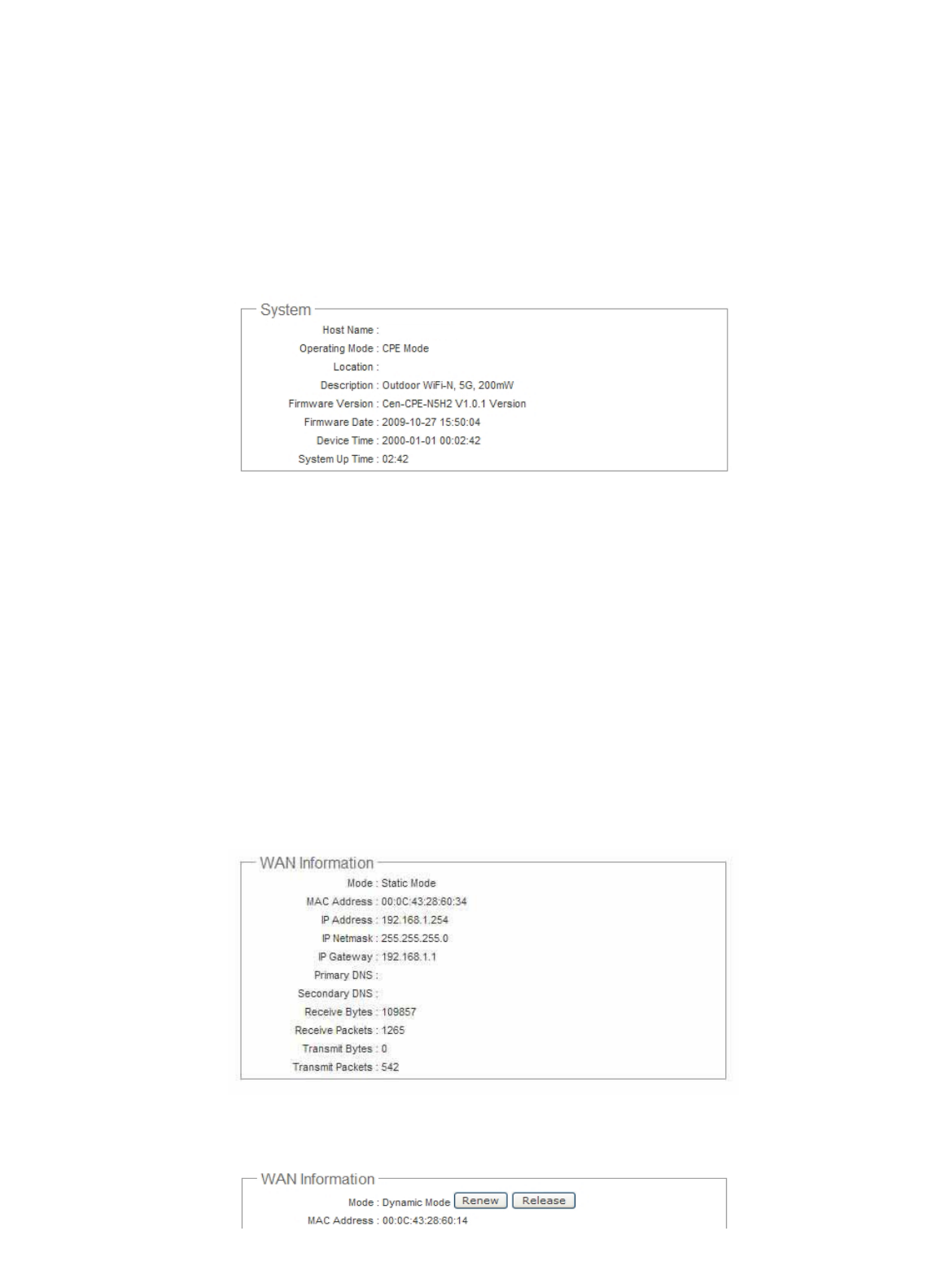
㻝㻜㻢
System Status
This section breaks down into subsections of System Overview,Station Statistics,Extra Information and Event Log.
Overview
Detailed information on System,WAN Information,LAN Information and DHCP Server Status can be reviewed via this
page.
System : Display the information of the system.
ÎSystem Name : The name of the system.
ÎOperating Mode : The mode currently in service.
ÎLocation : The reminding note on the geographical location of the system.
ÎDescription : The reminding note of the system.
ÎFirmware Version : The current firmware version installed.
ÎFirmware Date : The build time of the firmware installed.
ÎDevice Time : The current time of the system.
ÎSystem Up Time : The time period that system has been in service since last reboot.
WAN Information : Display the information of the WAN interface.
The WAN port specified Dynamic IP, the Release and Renew button will be show-up, click Release button to
release IP address of WAN port, Renew button to renew IP address through DHCP server.
/TEW-676APBO
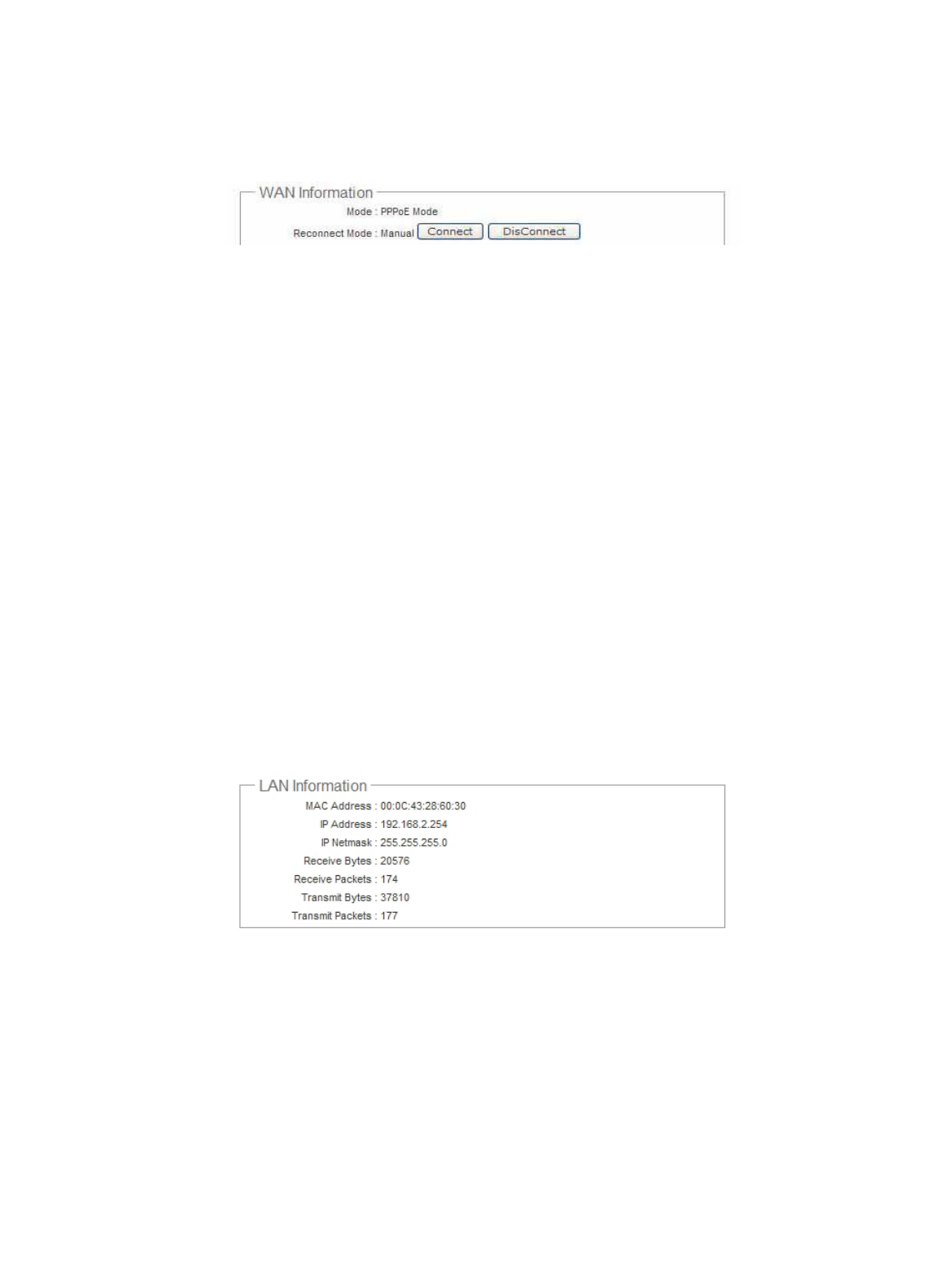
㻝㻜㻣
The WAN port specified PPPoE or PPTP, and the Connect and DisConnect button will be show up. Click “Connect”
button to assigned IP address from PPPoE or PPTP server, “DisConnect” button to release IP address of WAN port.
ÎMode : Supports Static, Dynamic, PPPoE and PPTP modes.
ÎReconnect Mode : The current reconnect mode of the PPPoE or PPTP.
ÎMAC Address : The MAC address of the WAN port.
ÎIP Address : The IP address of the WAN port.
ÎIP Netmask : The IP netmask of the WAN port.
ÎIP Gateway : The gateway IP address of the WAN port.
ÎPrimary DNS : The primary DNS server in service.
ÎSecondary DNS : The secondary DNS server in service.
ÎReceive bytes : The total received packets in bytes on the WAN port.
ÎReceive packets : The total received packets of the WAN port.
ÎTransmit bytes : The total transmitted packets in bytes of the WAN port.
ÎTransmit packets : The total transmitted packets of the WAN port.
LAN Information : Display total received and transmitted statistics on the LAN interface.
ÎMAC Address : The MAC address of the LAN port.
ÎIP Address : The IP address of the LAN port.
ÎIP Netmask : The IP netmask of the LAN port.
ÎReceive bytes : The total received packets in bytes on the LAN port.
ÎReceive packets : The total received packets of the LAN port.
ÎTransmit bytes : The total transmitted packets in bytes of the LAN port.
ÎTransmit packets : The total transmitted packets of the LAN port.
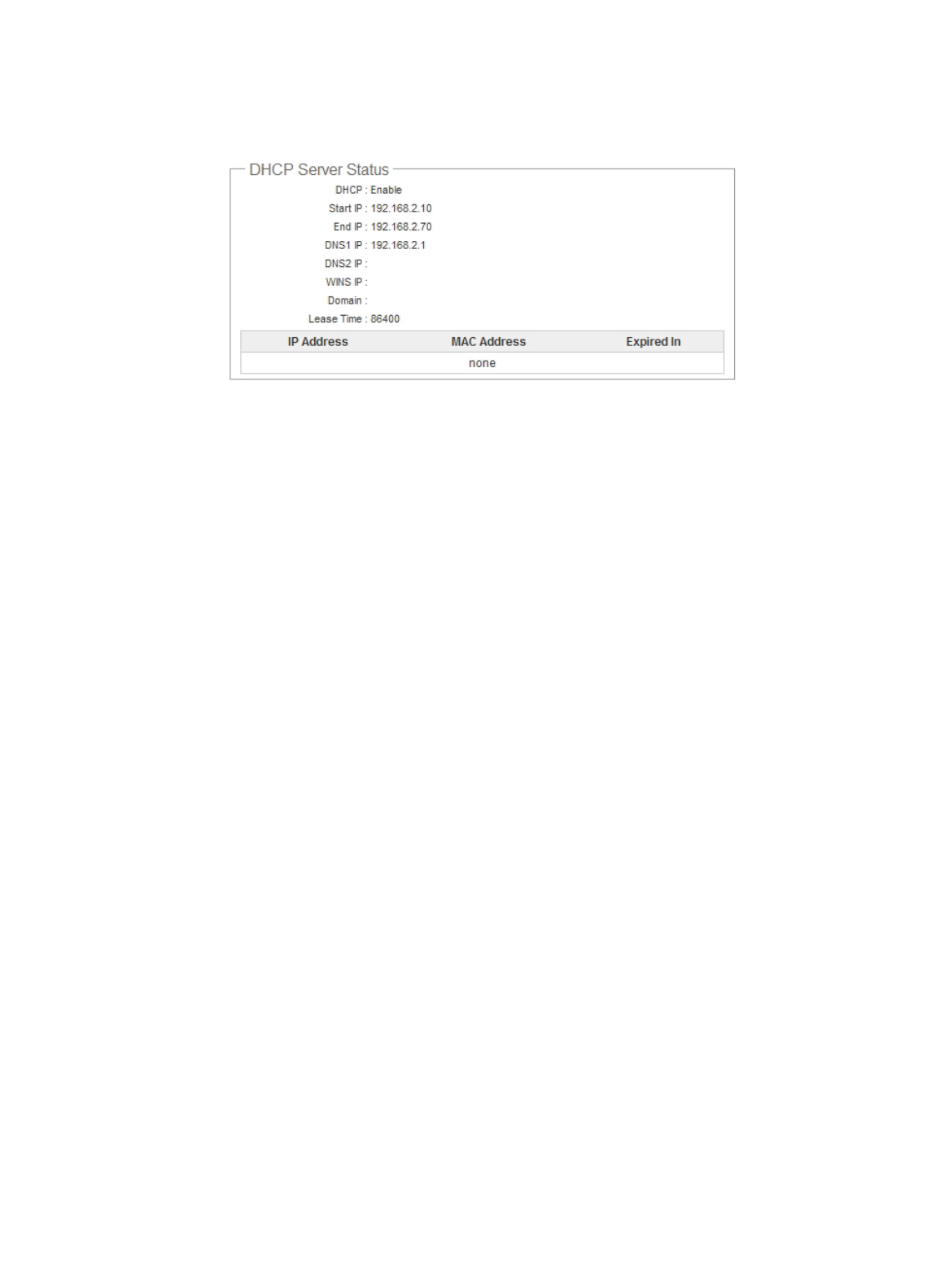
㻝㻜㻤
DHCP Server Status : Users could retrieve DHCP server and DHCP clients’ IP/MAC address via this field.
ÎIP Address : IP addresses to LAN devices by DHCP server.
ÎMAC Address : MAC addresses of LAN devices.
ÎExpired In : Shows how long the leased IP address will expire.
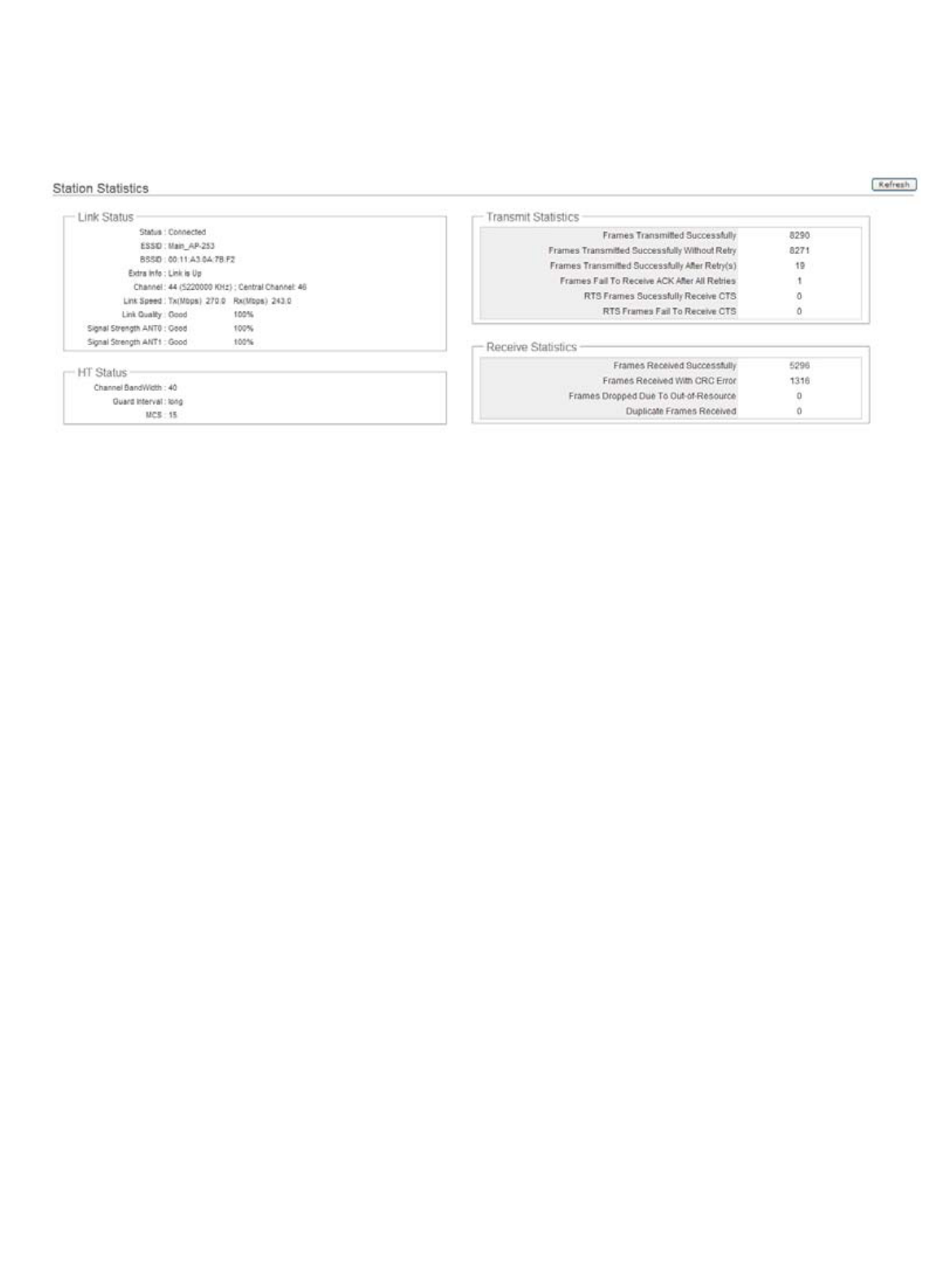
㻝㻜㻥
Station Statistics
Link information, Transmit and Receive Statistics for the connection with AP, Below depicts an example for Station
Statistics.
Link Status :
ÎStatus : Shows the current link status. It should be “Connected” or “Disconnected”.
ÎESSID : Shows the current SSID, which must be the same on the wireless client and AP in order for
communication to be established.
ÎBSSID : Shows the associated BSSID, which can be used to identify the wireless access point.
ÎExtra Info : Shows the current link status of extra information. It should be “Link is Up” or “Link is Down”,
ÎChannel : Shows current channel and central channel, its corresponding frequency.
ÎLink Speed(Mbps) : The data transfer speed adopted by this network. (measured in Mbits per second)
ÎLink Quality : Shows the link quality of the system with an access point.
ÎSignal Strength ANT0/ANT1 : Shows the wireless signal strength of the connection between system and an
access point.
HT Status :
ÎChannel BandWidth : Shows the current channel bandwidth used for communication. It should be “20” or “40”
ÎGuard Interval : Shows the current GI used for communication. It should be “short” or “long”.
ÎMCS : Shows the current GI used for communication. It should be between 0to 15 or 32.
Transmit Statistics
ÎFrames Transmitted Successfully: The number of successfully transmitted frames.
ÎFrames Transmitted Successfully Without Retry: The number of successfully transmitted frames without any
retry.
ÎFrames Transmitted Successfully After Retry(s): The number of successfully transmitted frames with one or
more retries.

㻝㻝㻜
ÎFrames Fail To Receive ACK After All Retries: The number of unsuccessfully transmitted frame with many
retries.
ÎRTS Frames Successfully Receive CTS: The number of successful received CTS (Clear To Send) response
after this TEW-676APBO sends out the RTS (Request To Send) message.
ÎRTS Frames Fail To Receive CTS: The number of unsuccessful received CTS response after this TEW-
676APBO sends out the RTS message.
Receive Statistics
ÎFrames Received Successfully: The number of successful received frames.
ÎFrames Received With CRC Error: The number of received frames with CRC (Cyclical Redundancy Checking)
error.
ÎFrames Dropped Due To Out-of-Resource: The number of dropped frames.
ÎDuplicate Frames Received: The number of duplicate frames.
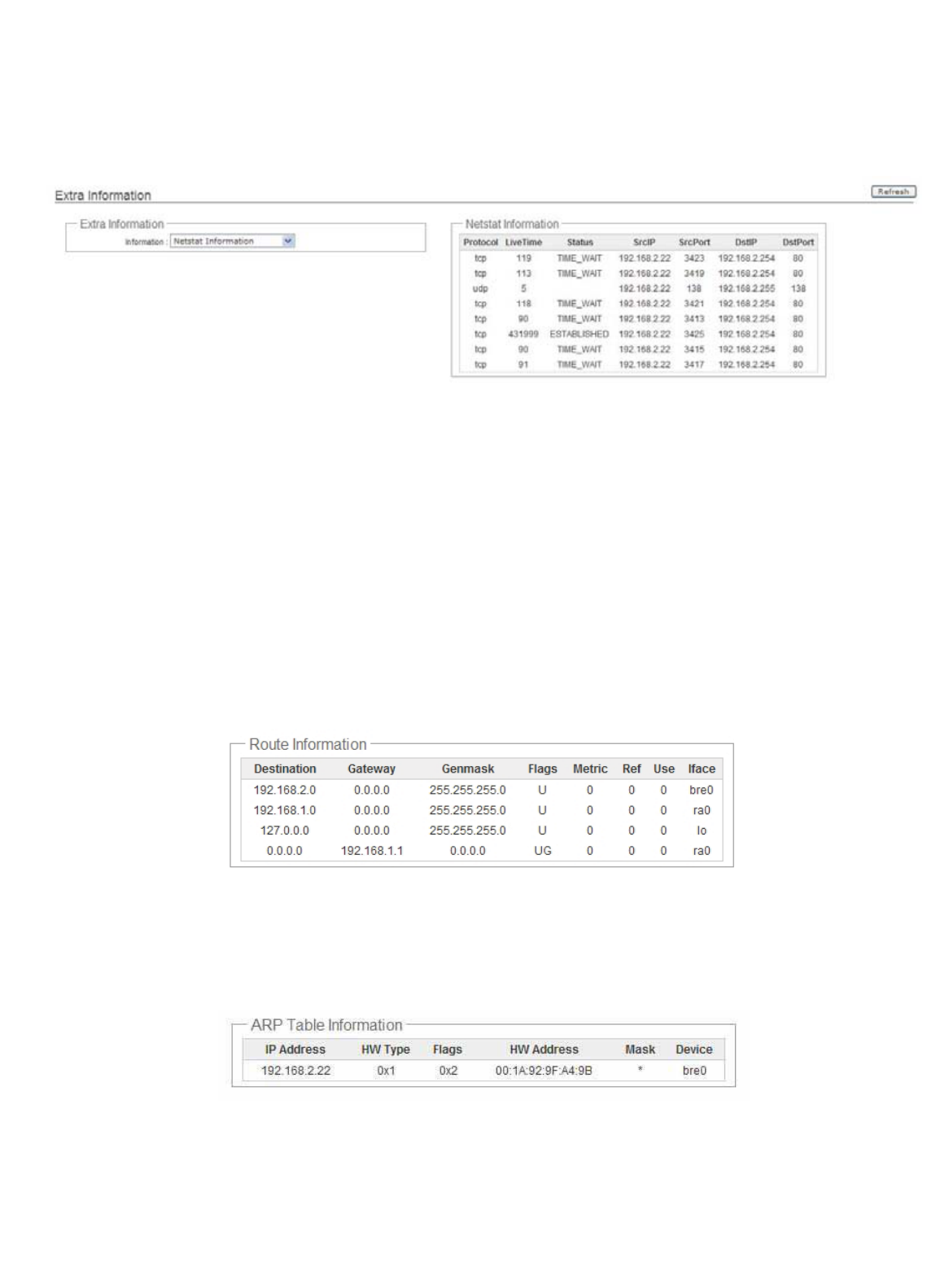
㻝㻝㻝
Extra Info
Users could pull out information such as Route table, ARP table, MAC table, Bridge table or STP available in the drop-
down list from system. The “Refresh” button is used to retrieve latest table information.
Netstat Information : Select “NetStatus Information” on the drop-down list, the connection track list should
NetStatus will show all connection track on the system, the information include Protocol,Live Time,Status ,
Source/Destination IP address and Port.
Route table information : Select “Route table information” on the drop-down list to display route table.
TEW-676APBO could be used as a L2 or L3 device. It doesn’t support dynamic routing protocols such as RIP or
OSPF. Static routes to specific hosts, networks or default gateway are set up automatically according to the IP
configuration of system's interfaces. When used as a L2 device, it could switch packets and, as L3 device, it’s
capable of being a gateway to route packets inward and outward.
ARP table Information : Select “ARP Table Information” on the drop-down list to display ARP table.
ARP associates each IP address to a unique hardware address (MAC) of a device. It is important to have a unique IP
address as final destination to switch packets to.
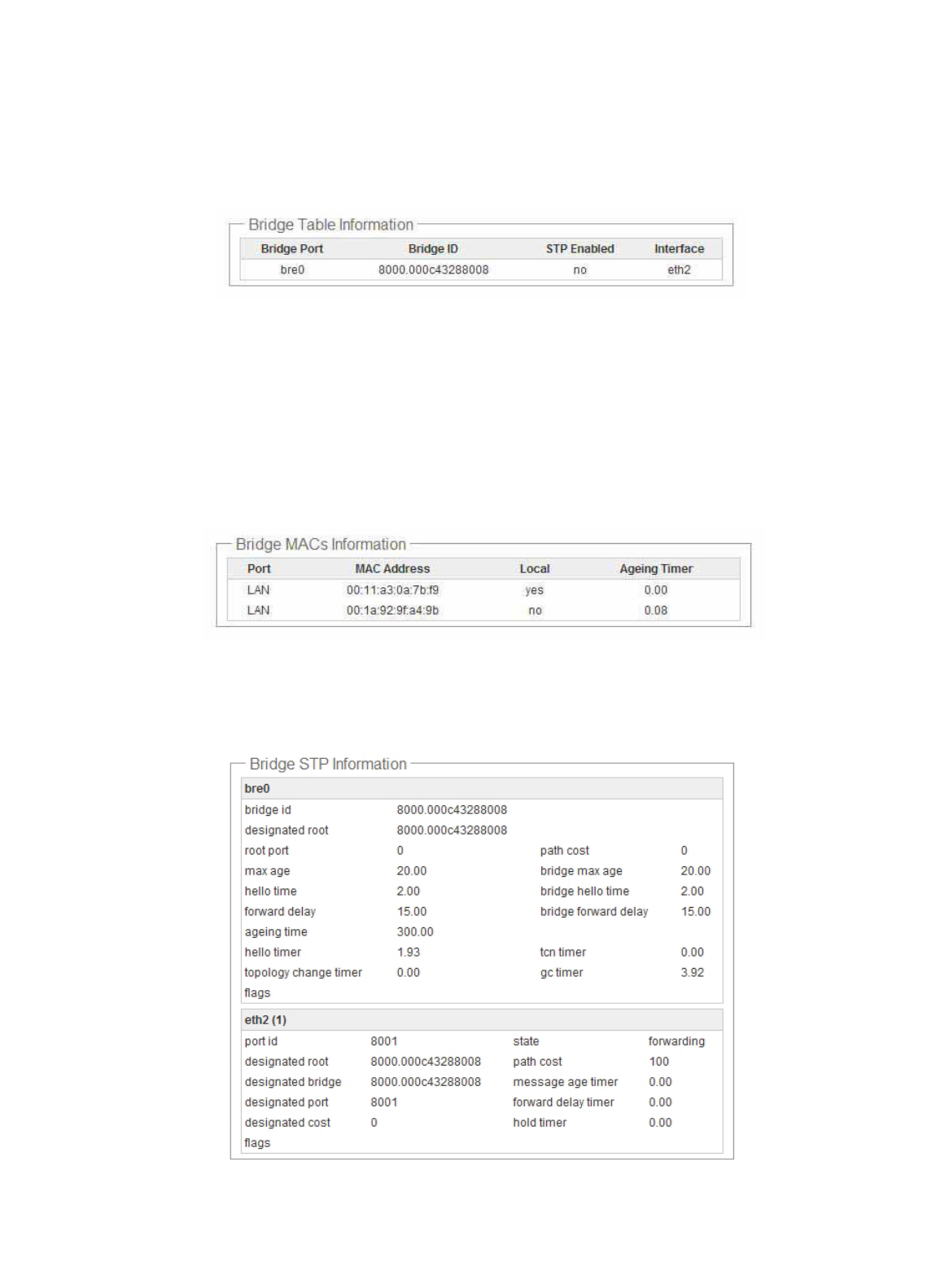
㻝㻝㻞
Bridge table information : Select “Bridge Table information” on the drop-down list to display bridge table.
Bridge table will show Bridge ID and STP's Status on the each Ethernet bridge and its attached interfaces, the Bridge
Port should be attached to some interfaces.
Bridge MAC information : Select “Bridge MACs Information” on the drop-down list to display MAC table.
This table displays local MAC addresses associated with wired or wireless interfaces, but also remember non-local
MAC addresses learned from wired or wireless interfaces.
Ageing timers will be reset when existing MAC addresses in table are learned again or added when new MAC
addresses are seen from wired or wireless interfaces as well. When time runs out for a particular entry, it will be
pruned from the table. In that situation, switching packet to that particular MAC address will be discontinued.
Bridge STP Information : Select “Bridge STP Information” on the drop-down list to display a list of bridge STP
information.
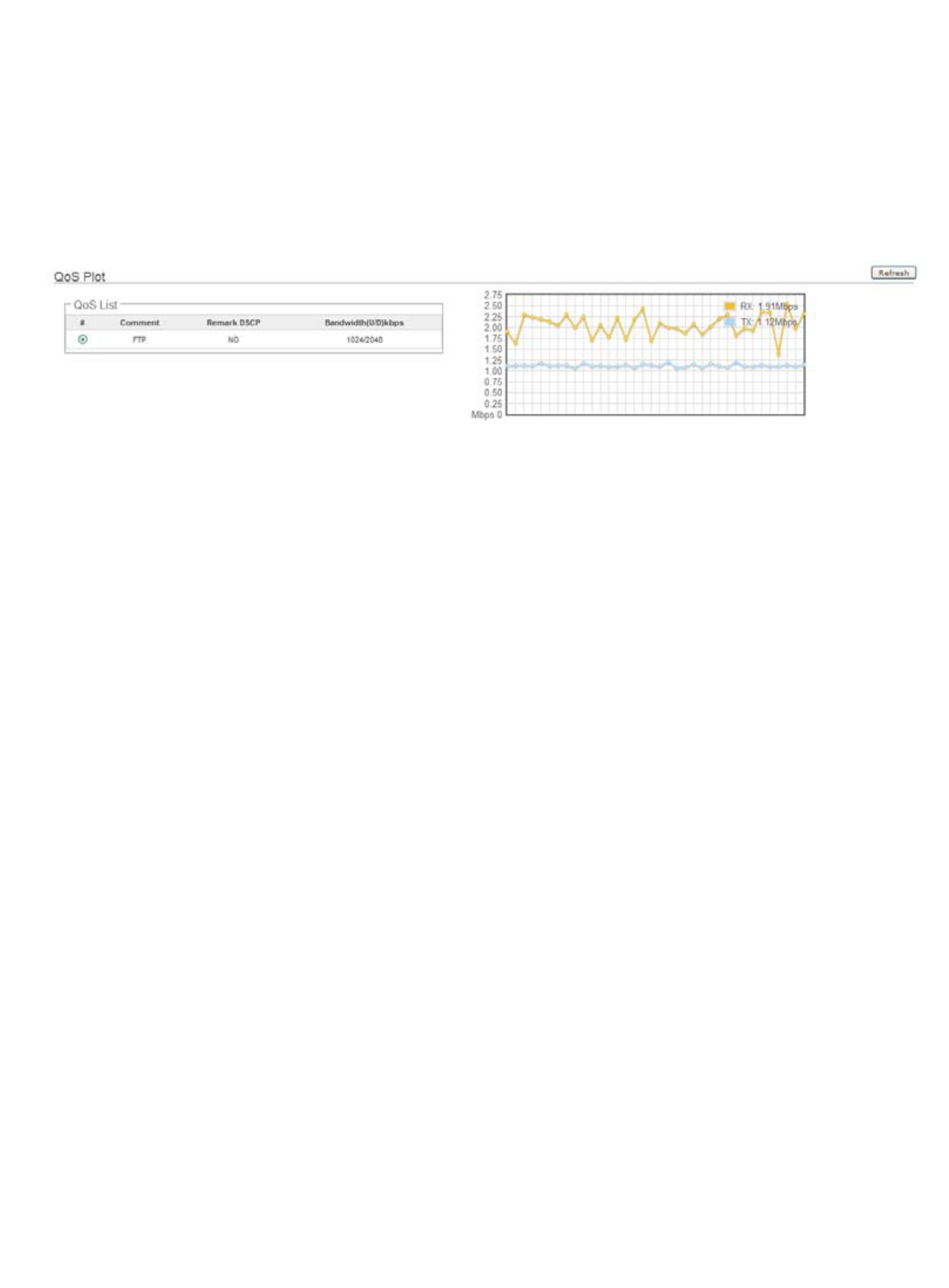
㻝㻝㻟
QoS Plot
The QoS Plot show graphs which continuously represents the current data traffic on each QoS rule. The chart scale and
throughput dimension (bps, Kbps, Mbps) changes dynamically according to the mean throughput value. The statistics is
updated automatically every 5seconds. The throughput statistics of QoS can be updated manually using the Refresh
button.

㻝㻝㻠
Event Log
The Event log displays system events when system is up and running. Also, it becomes very useful as a troubleshooting
tool when issues are experienced in system.
Time : The date and time when the event occurred.
Facility : It helps users to identify source of events such “System” or “User”
Severity : Severity level that a specific event is associated such as “info”, “error”, “warning”, etc.
Message : Description of the event.
Click Refresh button to renew the log, or click Clear button to clear all the record.
CPE + AP Mode Configuration
When CPE+AP mode is chosen, the system can be configured as a Customer Premises Equipment(CPE). This section
provides detailed explanation for users to configure in the CPE+AP mode with help of illustrations. In the CPE+AP mode,
functions listed in the table below are also available from the Web-based GUI interface.
OPTION SystemWireless Advance Utilities Status
Functions
Operating Mode General Setup DMZ Profiles SettingsSystem Overview
WAN Advanced Setup IP Filter Firmware Upgrade Station Statistics
LAN Repeater AP Setup MAC Filter Network Utility Extra Info
DDNSWireless Profile Virtual Server Reboot QoS Plot
Management Site Survey Parental Control Event Log
Time Server QoS
UPNP
SNMP
Table 6-1: CPE+AP Mode Functions

㻝㻝㻡
External Network Connection
Network Requirement
It can be used as an Outdoor Customer Premises Equipment (CPE) to receive and repeat wireless signal over last mile
application, helping WISPs deliver wireless broadband Internet service to residents and business customers. In the
CPE+AP mode, TEW-676APBO is a gateway enabled with NAT and DHCP Server functions. The wired and wireless
clients connected to TEW-676APBO are in different subnet from those connected to Main Base Station, and, in CPE+AP
mode, it accepts wireless connections from wireless client devices.
Figure 6-1 CPE+AP mode network configuration
When the TEW-676APBO configured as an Access Point and Client Station simultaneously, the Wireless
General and Advanced Setup also used simultaneously. But the Security Type can be different. In the other
word, the channel or other settings will be the same between TEW-676APBO to Main Base Station and
wireless client to TEW-676APBO, but security type can be different.
Internet
Main Base Station
192.168.2.250
192.168.2.x
192.168.2.254
SSID: Main
_
AP SSID: Re
p
eater
_
Main
_
AP
TEW-676APBO
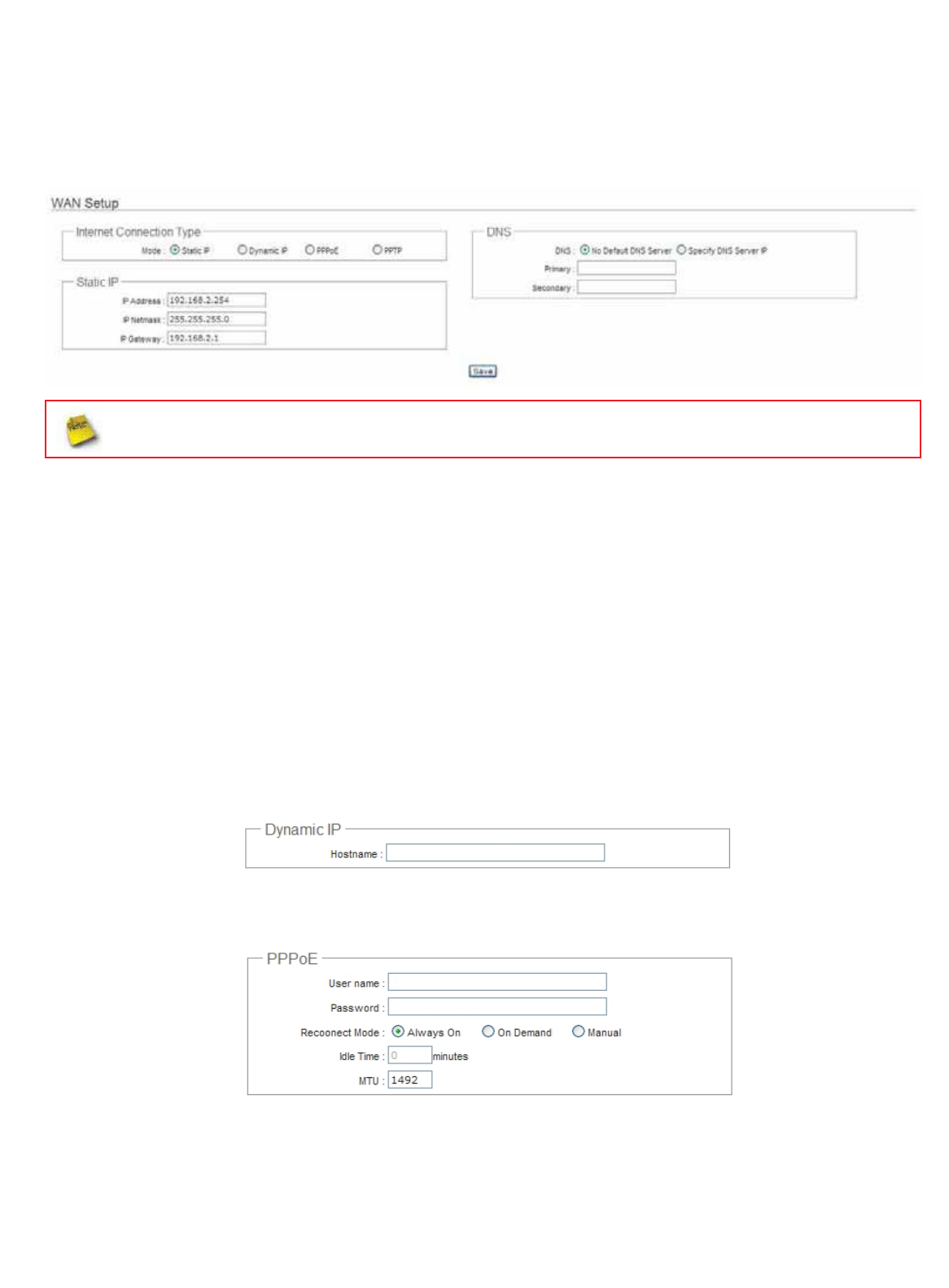
㻝㻝㻢
Configure WAN Setup
There are three connection types for the WAN port : Static IP,Dynamic IP,PPPoE and PPTP,
Please click on System -> WAN and follow the below setting.
In CPE+AP mode, the WAN Port is the Wireless Station interface.
Mode : By default, it’s “Static IP”. Check “Static IP”, “Dynamic IP”, “PPPoE” or “PPTP”to set up system WAN IP.
ÎStatic IP : Users can manually setup the WAN IP address with a static IP provided by WISP.
9IP Address : The IP address of the WAN port; default IP address is 192.168.1.254
9IP Netmask : The Subnet mask of the WAN port; default Netmask is 255.255.255.0
9IP Gateway : The default gateway of the WAN port; default Gateway is 192.168.1.1
ÎDynamic IP : Please consult with WISP for correct wireless settings to associate with WISP AP before a
dynamic IP, along with related IP settings including DNS can be available from DHCP server. If IP Address is not
assigned, please double check with your wireless settings and ensure successful association. Also, you may
go to “WAN Information” in the Overview page to click Release button to release IP address and click Renew
button to renew IP address again.
9Hostname : The Hostname of the WAN port
ÎPPPoE : To create wireless PPPoE WAN connection to a PPPoE server in network.

㻝㻝㻣
9User Name : Enter User Name for PPPoE connection
9Password : Enter Password for PPPoE connection
9Reconnect Mode :
xAlways on – A connection to Internet is always maintained.
xOn Demand – A connection to Internet is made as needed.
When Time Server is enabled at the “On Demand” mode, the “Reconnect Mode” will turn out “Always on”.
xManual – Click the “Connect” button on “WAN Information” in the Overview page to connect to the
Internet.
9Idle Time : Time to last before disconnecting PPPoE session when it is idle. Enter preferred Idle Time in
minutes. Default is “0”, indicates disabled. When Idle time is disabled, the “Reconnect Mode” will turn out
“Always on”
9MTU : By default, it’s 1492 bytes. MTU stands for Maximum Transmission Unit. Consult with WISP for a
correct MTU setting.
ÎPPTP : The Point-to-Point Tunneling Protocol (PPTP) mode enables the implementation of secure multi-protocol Virtual
Private Networks (VPNs) through public networks.
9IP Address : The IP address of the WAN port
9IP Netmask : The Subnet mask of the WAN port
9PPTP Server IP Address : The IP address of the PPTP server
9User Name : Enter User Name for PPTP connection
9Password : Enter Password for PPTP connection
9Reconnect Mode :
xAlways on – A connection to Internet is always maintained.
xOn Demand – A connection to Internet is made as needed.

㻝㻝㻤
When Time Server is enabled at the “On Demand” mode, the “Reconnect Mode” will turn out “Always on”.
xManual – Click the “Connect” button on “WAN Information” in the Overview page to connect to the
Internet.
9Idle Time : Time to last before disconnecting PPPoE session when it is idle. Enter preferred Idle Time in
minutes. Default is “0”, indicates disabled. When Idle time is disabled, the “Reconnect Mode” will turn out
“Always on”
9MTU : By default, it’s 1460 bytes. MTU stands for Maximum Transmission Unit. Consult with WISP for a
correct MTU setting.
9MPPE Encryption : Microsoft Point-to-Point Encryption (MPPE) encrypts data in Point-to-Point
Protocol(PPP)-based dial-up connections or Point-to-Point Tunneling Protocol (PPTP) virtual private
network (VPN) connections. 128-bit key (strong) and 40-bit key (standard) MPPE encryption schemes are
supported. MPPE provides data security for the PPTP connection that is between the VPN client and the
VPN server.
DNS : Check “No Default DNS Server” or “Specify DNS Server IP” radial button as desired to set up system DNS.
ÎPrimary : The IP address of the primary DNS server.
ÎSecondary : The IP address of the secondary DNS server.
In this mode, the system does not support MAC Clone function.
Click Save button to save your changes. Click Reboot button to activate your changes
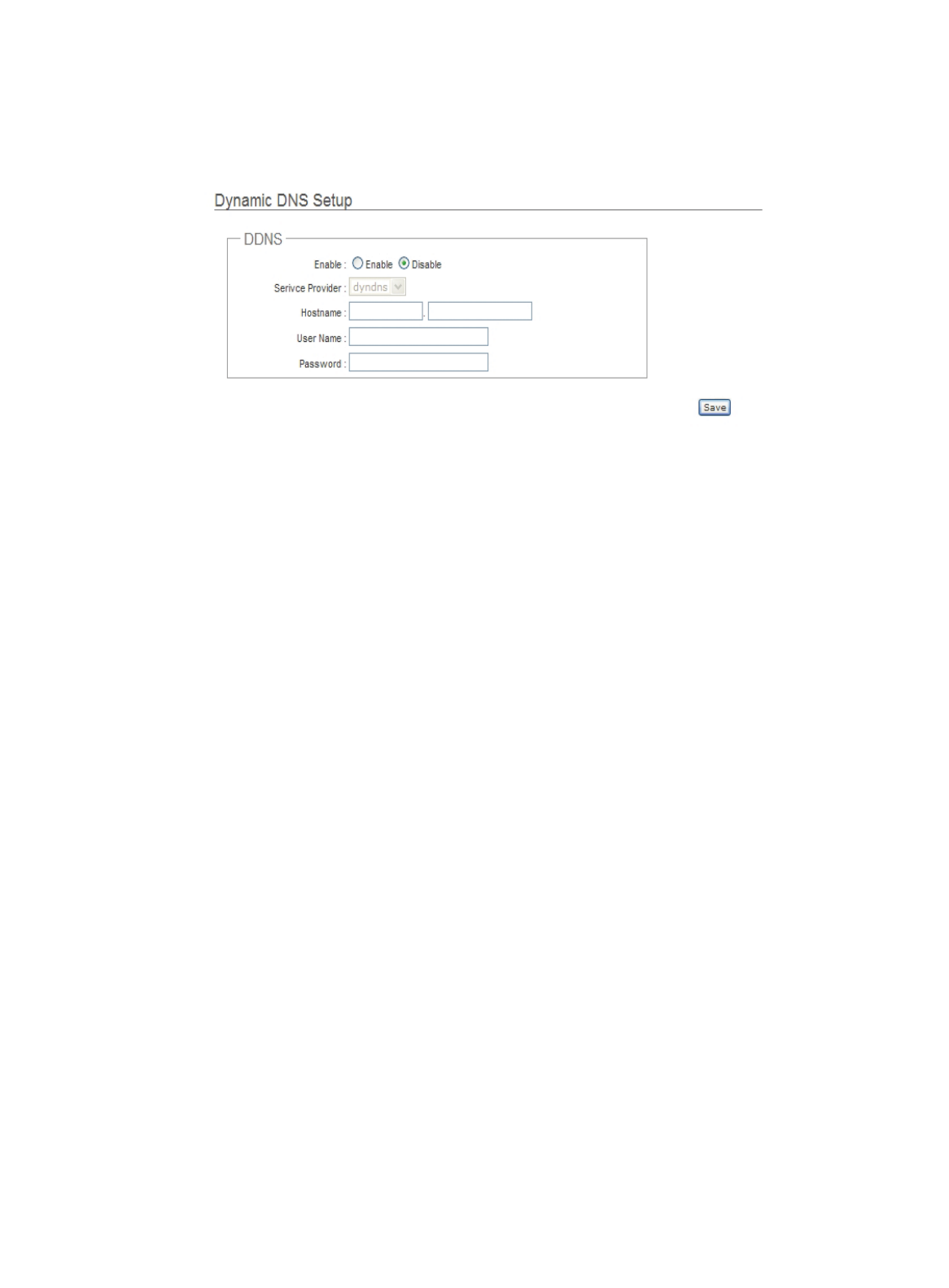
㻝㻝㻥
Configure DDNS Setup
Dynamic DNS allows you to map domain name to dynamic IP address.
Please click on System -> DDNS Setup and follow the below setting.
Enabled: By default, it’s “Disable”.The mapping domain name won’t change when dynamic IP changes. The beauty
of it is no need to remember the dynamic WAP IP while accessing to it.
Service Provider: Select the preferred Service Provider from the drop-down list including dyndns,dhs,ods and tzo
Hostname: Host Name that you register to Dynamic-DNS service and export.
User Name & Password: User Name and Password are used to login DDNS service.
Click Save button to save your changes. Click Reboot button to activate your changes
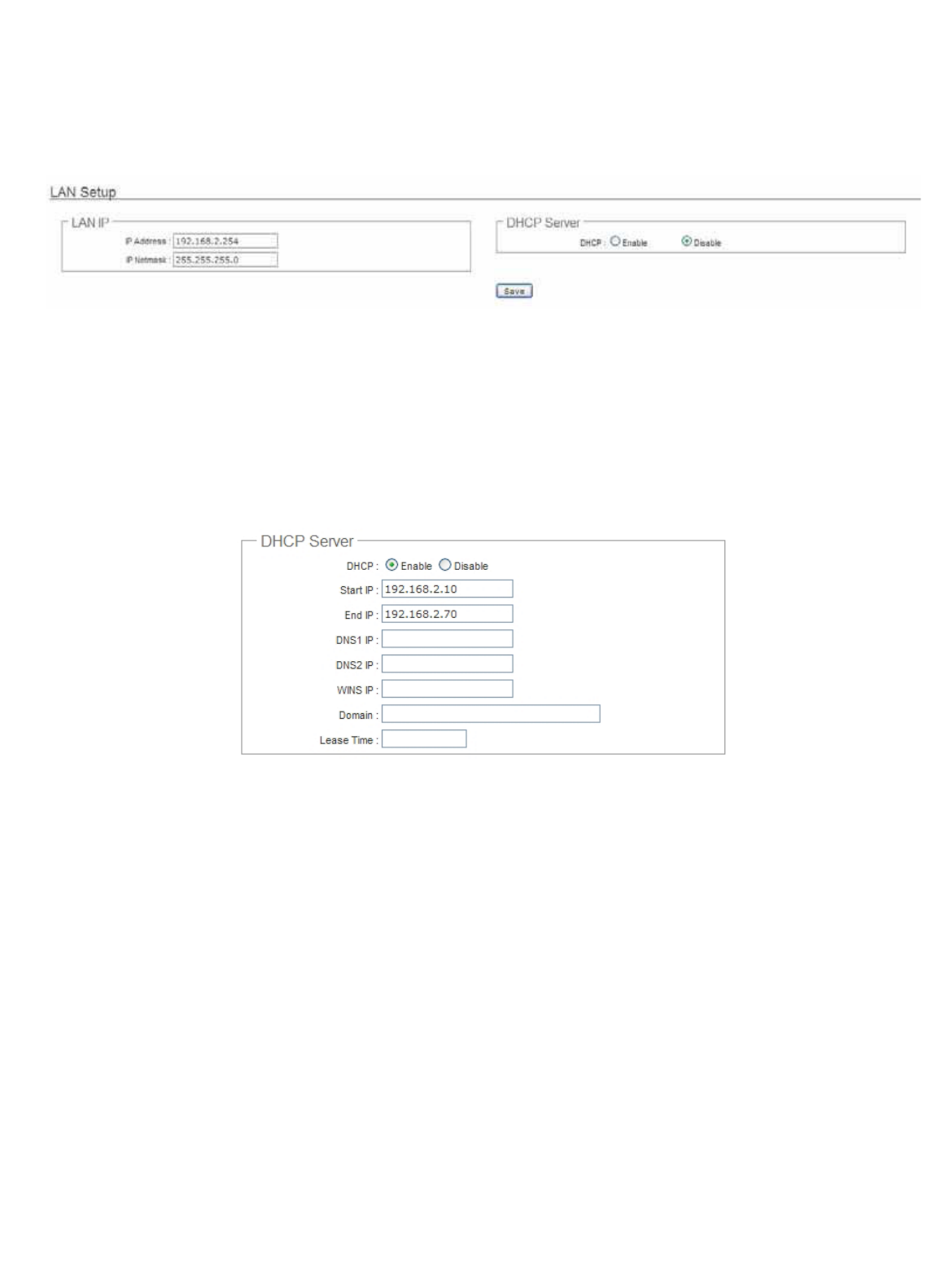
㻝㻞㻜
Configure LAN Setup
Here are the instructions for how to setup the local IP Address and Netmask.
Please click on System -> LAN and follow the below setting.
LAN IP : The administrator can manually setup the LAN IP address.
ÎIP Address : The IP address of the LAN port; default IP address is 192.168.2.254
ÎIP Netmask : The Subnet mask of the LAN port; default Netmask is 255.255.255.0
DHCP Setup : Devices connected to the system can obtain an IP address automatically when this service is
enabled.
ÎDHCP : Check Enable button to activate this function or Disable to deactivate this service.
ÎStart IP / End IP: Specify the range of IP addresses to be used by the DHCP server when assigning IP address
to clients. The default range IP address is 192.168.2.10 to 192.168.2.70, the netmask is 255.255.255.0
ÎDNS1 IP : Enter IP address of the first DNS server; this field is required.
ÎDNS2 IP : Enter IP address of the second DNS server; this is optional.
ÎWINS IP : Enter IP address of the Windows Internet Name Service (WINS) server; this is optional.
ÎDomain : Enter the domain name for this network.
ÎLease Time : The IP addresses given out by the DHCP server will only be valid for the duration specified by
the lease time. Increasing the time ensure client operation without interruptions, but could introduce potential
conflicts. Lowering the lease time will avoid potential address conflicts, but might cause more interruptions to the
client while it will acquire new IP addresses from the DHCP server. Default is 86400 seconds
Click Save button to save your changes. Click Reboot button to activate your changes
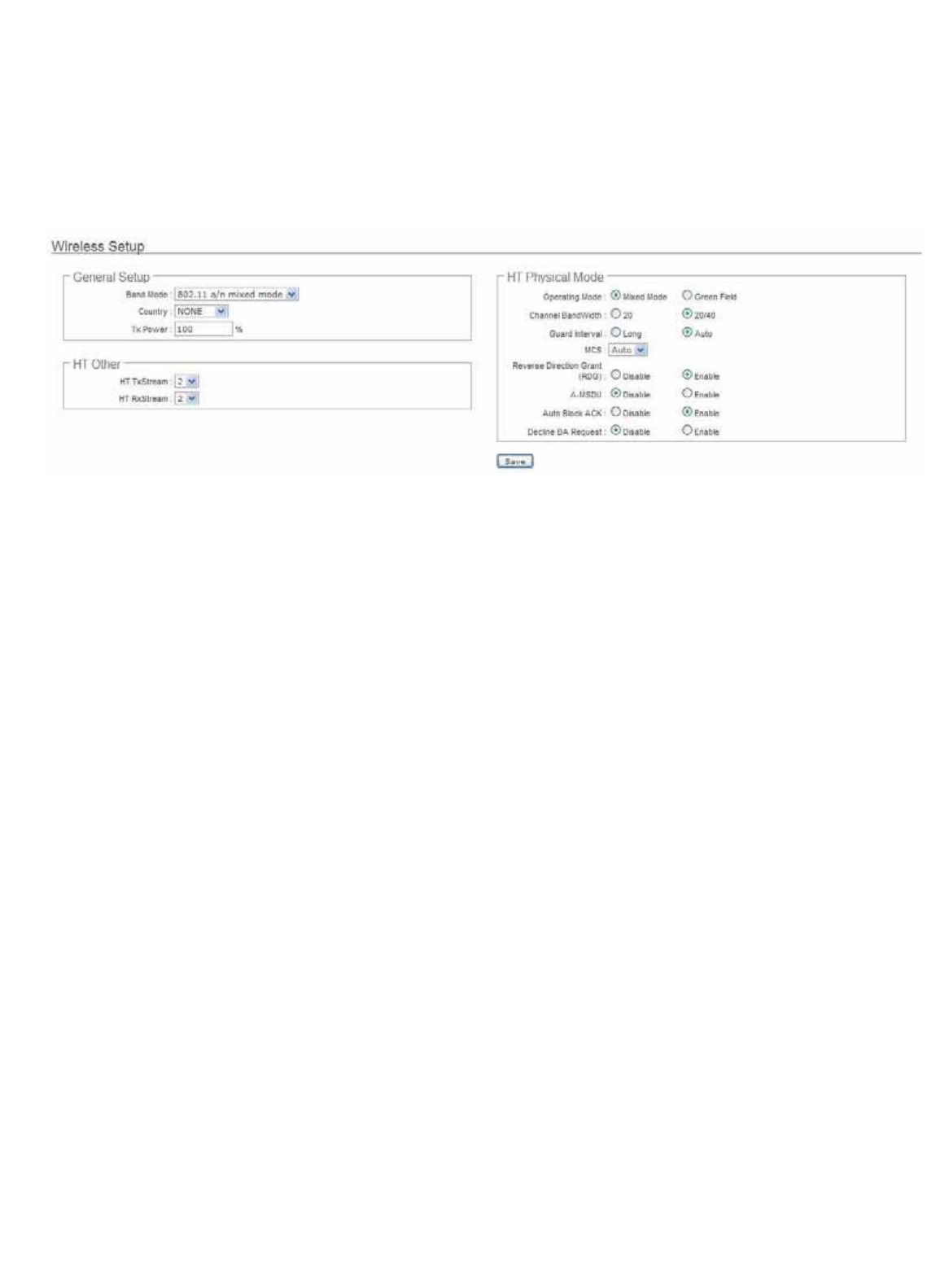
㻝㻞㻝
Access Point Association
Configure Wireless General Setting
The administrator can change the data transmission, channel and output power settings for the system. Please click on
Wireless -> General Setup and follow the below setting.
Band Mode : Select an appropriate wireless band; bands available are 801.11aor 802.11a/n mixed mode.
Transmit Rate Control : Select the desired rate from the drop-down list; the options are auto or ranging from 6to 54
Mbps for 802.11a
Country : Select the desired country code from the drop-down list; the options are US,ETSI,JP and NONE.
Tx Power : You can adjust the output power of the system to get the appropriate coverage for your wireless network.
Specify digit number between 1to 100 (the unit is %) for your environment. If you are not sure of which setting to
choose, then keep the default setting, 100%.
When Band Mode select in 802.11a only mode, the HT(High Throughput) Physical Mode and 11n Configuration
settings should be hidden immediately.
Operating Mode : By default, it's Mixed Mode.
ÎMixed Mode : In this mode packets are transmitted with a preamble compatible with the legacy 802.11a/g, the
rest of the packet has a new format. In this mode the receiver shall be able to decode both the Mixed Mode
packets and legacy packets.
ÎGreen Field : In this mode high throughput packets are transmitted without a legacy compatible part.
Channel Bandwidth : The "Auto” MHz option is usually best. The other option is available for special circumstances.
Guard Interval : Using “Auto” option can increase throughput. However, it can also increase error rate in some
installations, due to increased sensitivity to radio-frequency reflections. Select the option that works best for your
installation.

㻝㻞㻞
MCS : This parameter represents transmission rate. By default (Auto) the fastest possible transmission rate will be
selected. You have the option of selecting the speed if necessary. (Refer to Appendix C. MCS Data Rate)
MPDU Enable : Check Enable button to activate this function, and Disable to deactivate.
A-MPDU : A-MPDU (Aggregated Mac Protocol Data Unit) allows the transmissions of multiple Ethernet frames to a
single location as burst of up to 64kbytes This is performed on the hardware itself. Select “Manual” to set “MPDU
Density”
MPDU Density : Minimum separation of MPDUs in an A-MPDU.
01234567
No Restriction ¼ μs ½ μs 1 μs 2 μs 4 μs 8 μs 16 μs
A-MSDU : Aggregated Mac Service Data Unit, A-MSDU. Select Enable to allows aggregation for multiple MSDUs in
one MPDU. Default is disabled.
Click Save button to save your changes. Click Reboot button to activate your changes.
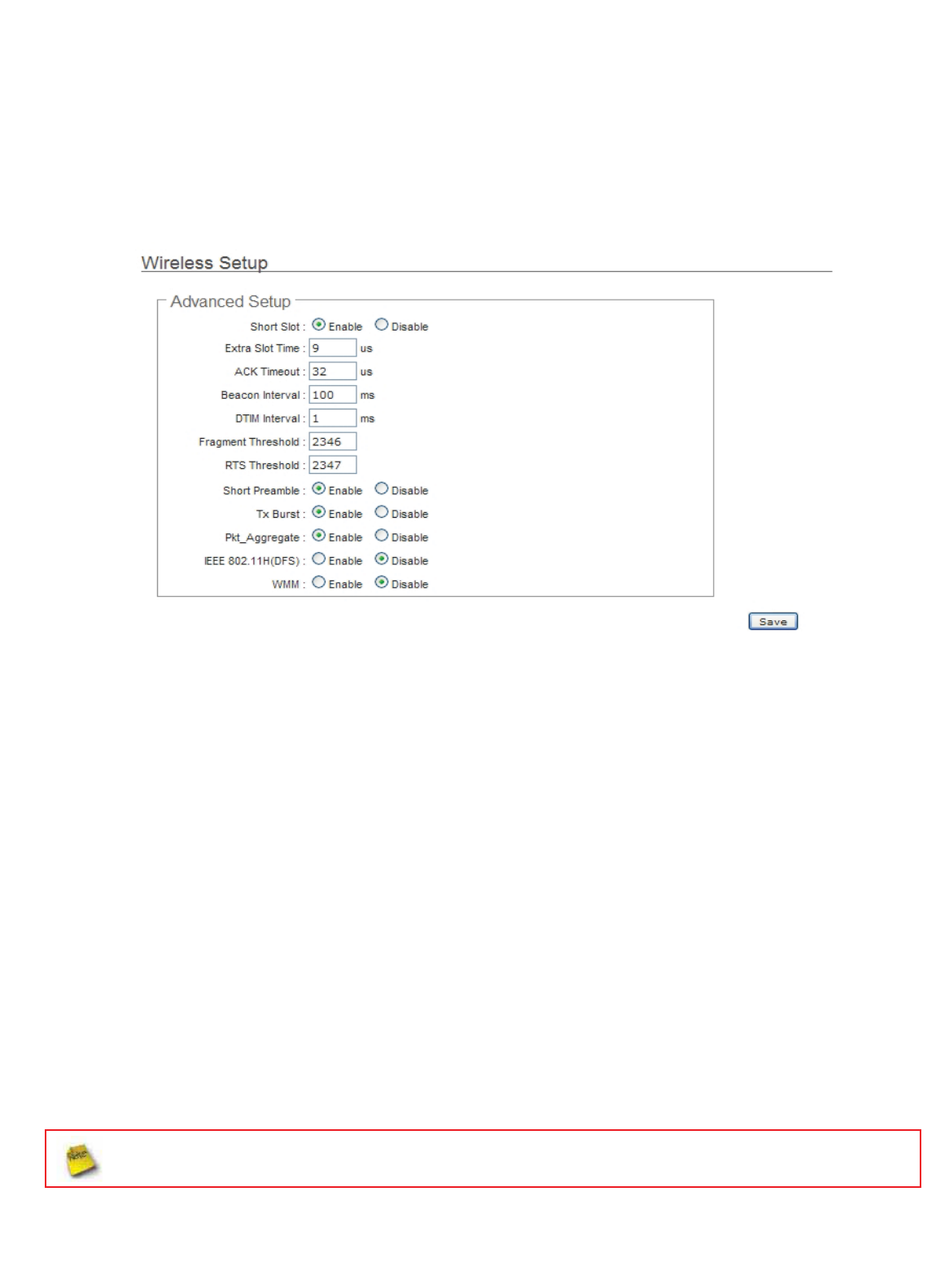
㻝㻞㻟
Wireless Advanced Setup
To achieve optimal wireless performance, it is necessary to tweak advance setting per requirements properly, not
necessary higher the better or lower.
The administrator can change the RTS threshold and fragmentation threshold settings for the system. Please click on
Wireless -> Advanced Setup and follow the below setting.
Short Slot : By default, it’s “Enable”for educing the slot time from the standard 20 microseconds to the 9
microsecond short slot time
Slot time is the amount of time a device waits after acollision before retransmitting a packet. Reducing the slot time
decreases the overall back-off, which increases throughput. Back-off, which is a multiple of the slot time, is the
random length of time a station waits before sending a packet on the LAN. For a sender and receiver own right of the
channel the shorter slot time help manage shorter wait time to re-transmit from collision because of hidden wireless
clients or other causes. When collision sources can be removed sooner and other senders attempting to send are
listening the channel(CSMA/CA) the owner of the channel should continue ownership and finish their transmission
and release the channel. Then, following ownership of the channel will be sooner for the new pair due to shorter slot
time. However, when long duration of existing collision sources and shorter slot time exist the owners might
experience subsequent collisions. When adjustment to longer slot time can’t improve performance then RTS/CTS
could supplement and help improve performance.
Extra Slot Time : Slot time is in the range of 1~255 and set in unit of microsecond. The default value is 9
microsecond.
When you enable Short Slot and set Extra Slot time to “10”, the actual Slot Time=9+10 us.
When you disable Short Slot and set Extra Slot time to “10”, the actual Slot Time=20+10 us.